

Copenhagen red light district: Where is it, and is it safe?

The Complete Guide to Danish Maximalism: Bold Décor

Studying in Norway: A Simple Guide for International Students

How to Become a Citizen of Norway: Options for Norwegian Citizenship

How to Choose Between a Trip to Denmark and Finland

Norway vs Denmark: How to choose between Denmark and Norway
Today, we’re going to be tackling the Norway vs Denmark debate head-on, with some insights into factors which might affect your choice, depending on whether you’re visiting or relocating. So, if you’re ready, let’s get started…
Trying to decide between Denmark and Norway is a difficult choice. After all, the countries in the Scandinavian region are similar in many ways, but they all have their unique benefits to explore.
Scandinavian languages are also very similar , and many of the regions share common myths and legends too, but if you really want to see incredible fjords, you’re going to need to head to Norway.
If—on the other hand—you’re looking for history and culture, then you might fare better in Denmark.
Whether you’re trying to choose where to visit between Norway and Denmark, or you’re considering settling down in the Nordic region indefinitely, you’ll have your work cut out for you.
Hopefully, the following will help you choose between Denmark and Norway…
Norway vs Denmark: The initial differences
Norway and Denmark are both regions of Scandinavia, known for their amazing scenery, their wonderful people, and Viking history .
Denmark is a country of beautiful, colorful towns and cities, stunning docks, and fishing areas, as well as countless places to settle down and enjoy some lunch with friends.
If you’re keen to check out one of the happiest places in the world, and you love seafood, then you’re going to be right at home at Denmark. The region spreads over the Jutland Peninsula, covering about 17,000 miles.
With about 5.6 million people living in Denmark, the location has plenty of opportunities to socialize, but it’s not overly crowded either.
Norway is best-known for its beautiful fjords and the amazing scenery all over the country. Although the temperatures aren’t always high here, Norway is one of the most dramatically beautiful places on earth. The region is also home to several world records .
Norway has slightly fewer people living in it than Denmark, at around 5.4 million. The location is also very scarcely populated, as many regions are uninhabitable due to the severe cold.
Don’t let this scare you away though — Norway has plenty of amazing winter sports and activities to make up for it. Plus, it’s a great place to go searching for the Northern Lights .

Norway or Denmark: What to expect from Norway
When you’re deciding whether to visit Norway or Denmark, you’ll quickly discover the two locations are very different in what they can offer.
While both counties have a lot of Viking heritage and history to offer, Norway is definitely the place to go if you’re looking for beautiful outdoor experiences.
The stunning fjords aren’t always ice and snow either. You can also visit the UNESCO World Heritage site , Geirangerfjord, where you’ll often find more lush greenery, beautiful waterfalls, and even a place where you can take a dip.
Norway is a top destination for hikers, with locations like Pulpit Rock, Priekstolen, to visit. You can even climb all the way to the top of the beautiful Preacher’s Pulpit, where you can look over the edge of a cliff to the water below.
Norway’s incredible sights make it one of the most picture-friendly destinations in the world, but this country is more than just a perfect location for snapshots. If you love driving, you can drive through an almost endless coastline of winding roads, and potentially spot a few whales along the way.
Norway is also one of the most eco-friendly destinations in the world too.

Visit Denmark or Norway? What to do in Norway
If you decide you’re going to visit Norway when making your decision between Norway and Denmark, you’re sure to find plenty of great things to do. We recommend starting your trip with a visit to Norway’s capital city of Oslo .
This wonderful location is surprisingly forward-thinking, with everything from heated roads to modern buildings and bars.
Oslo is where nature and urban elements come together to create something entirely new. You’ll see beautiful green hills and mountains on the horizon, while checking out local stores. For a touch of history, visit the Viking Ship or Munch museum.
If your decision to visit Norway came from a passion for exploration, then head to the second largest city of Bergen for a day or two. This incredible location is home to a wide range of historical and cultural attractions for visitors, as well as a range of natural wonders.
Bergen is known as the gateway to the fjords , and it’s ideal for anyone who loves the outdoors.
If you’re tired of Bergen (as odd as it might sound), you can also discover more natural beauty at the Lofoten islands. This is an archipelago within the Artic circle offering things like fishing villages, waterways, and coastal lines, and so much more.
You can even take a Norwegian coastal voyage around this region and do a spot of bird watching.
For those looking for something a little cosier, visit the small town of Flam in Norway, where you can take a break around the western fjords. There’s a ton of natural beauty here once again, and you can take a trip on one of the most famous railways in the world.

Denmark or Norway: What to expect from Denmark
So, if Norway is the place to go for truly dramatic scenery and outdoor beauty, what makes Denmark a great visitor’s location? If you’re planning on visiting Denmark, one of the first things you’ll notice is all the water.
If you like fishing, or seafood, you’re going to find plenty of ways to spend your time here. You can even check out some beautiful boats along the docks and learn about the Vikings while you’re in the country.
Denmark is also famous for the sheer sense of happiness enjoyed by its citizens. This is one of the happiest places in the world, thanks in part to things like better work/life balance, safer streets, and welcoming people.
You can discover hygge in the heart of Denmark with a delicious pastry and a warm drink, and take a little of the happiness back home with you.
Denmark is also a great place for educational purposes. You can learn about famous people like Hans Christian Andersen, and check out the Little Mermaid statue when you’re visiting Copenhagen.
Plus, there are plenty of great museums around Denmark to visit too, where you can learn about Vikings, Nordic culture, and companies like Lego.
Denmark is also a place famous for its healthy living. You’ll have no problem finding somewhere to stop for a healthy snack, and there are plenty of outdoor activities to take part in if you want to get active.
Plus, everything you want to see is reachable by bike, giving you the perfect opportunity to put your cycling skills to the test.

Visit Norway or Denmark? What to do in Denmark
Like Norway, Denmark has plenty of things you can do if you’re looking for a fun way to spend a few hours on your trip. The great thing about Denmark is a lot of great sights and destinations are located pretty close together. This makes it easier to explore more of the country in one go.
You can even cycle around many of the biggest tourist attractions.
If you want to start with an authentic taste of Denmark, make sure you plan a trip to the capital city of Copenhagen . This is a must-visit destination for most travellers, and it’s where you’ll find everything from ski-slopes to stunning stores.
If you’re a fan of beautiful architecture and art, plan a trip to the ARoS art museum, where you can take a walk around a 360-degree rainbow made of glass, to see Aarhus from a whole new angle.
Alternatively, show your appreciation for Denmark’s contributions to the world of toys by visiting the Leo house. The Lego house features a host of color-themed zones to keep the whole family entertained, and there’s a guide to lego history too.
Speaking of architecture, it’s always worth visiting Nyhavn when you’re in Denmark, to get a view of the beautiful 17 th century canal, complete with old wooden ships. The region is also packed full of wonderful colorful houses which make for a great photo opportunity.
Alternatively, head over to Roskilde for a look at the amazing Roskilde Cathedral .
If you’re feeling particularly daring, there are activities in Denmark for thrill seekers too. 50 minutes outside of Copenhagen is the Camp Adventure treetop experience, where you can climb to the top of a tower to see for miles around.
On the other hand, you can go bridge walking over Little Belt Bridge.
If you’re visiting Denmark at a specific time of year, be sure to check if there are any ongoing festivals happening. The country is home to some amazing outdoor events.

Should you live in Denmark or Norway?
Making the decision to live in Norway or Denmark is a lot tougher than figuring out whether you should visit one country over the other. You can even visit Norway and Denmark if you like, as the two locations are quite close together.
When it comes to life in these two Scandinavian countries, it’s crucial to ensure you understand your options.
The first thing to know is all of Scandinavia represents a beautiful and opportunity-rich place to live. The Nordic countries, such as Norway, Finland, Denmark, and Sweden, all offer a great experience for expats.
Finland and Norway are in the top ten in many categories for quality of life, in fact.
Norway is among the top five countries in the world for health and wellbeing, and Denmark frequently ranks among the happiest locations in the world.
Although you will need to learn a new language, regardless of whether you choose Norway or Denmark , you should find it simple enough to adapt to a new way of life. Both Denmark and Norway are likely to be top options if you’re a fan of environmental protection.
These two countries support renewable energy efforts to address things like climate change.
Norway is 1 st in the world for environmental friendliness , and Denmark ranks among the top 10 countries too. Norway also ranks among the top countries in the world for security and safety, while
Denmark is well-known around the world for the sense of security locals feel. You’ll frequently sere people leaving their belongings unattended here.
For quality of life, both Denmark and Norway promise a clean, safe, and environmentally conscious home. Political stability is also another factor worth noting for local peace of mind. The two countries perform very well, and citizens have generally good feelings about their government.
Is Denmark the same as Norway?
When you’re trying to choose whether to live in Norway or Denmark, you’ll notice many aspects of the two countries are very similar. Even the languages of Scandinavia have a lot of similarities .
Both Denmark and Norway have excellent quality of life to offer, particularly when it comes to work/life balance. The countries are among the top ten in the world for working experience.

The survival guide to Copenhell Festival for 2022
Norway tends to have a lot of job options in the fields of healthcare, manufacturing, and engineering. Denmark can make it a little tougher to find a role initially, but you’ll have no problem getting good pay.
Once you find a career in Denmark, you won’t have to worry about things like high taxes, as you should also have money for things like food, expenses, and savings, provided you’re working full time.
The biggest issue is finding suitable employment isn’t always easy in Denmark and Norway. Remember, both countries have plenty of access to Scandinavian talent.
In terms of some of the major differences between Denmark and Norway, let’s look at some basic facts.
For instance, if you lived in Norway instead of Denmark you would:
- Live up to 0.9 years longer, as the life expectancy for men and women is higher.
- Make up to 43.9% more money, due to a massive GDP per capita in Norway.
- Pay a 31% lower rate for the highest tax category.
- Be 26.3% more likely to get a job in the field you want to explore.
If you found a home in Denmark rather than Norway, you would:
- Live in a more diverse climate with nice summers.
- Be 17.3% less likely to be obese, due to healthier living.
- Have access to excellent work/life balance and quality of life.
- Be able to travel to various sights and locations a little easier.

Is Denmark or Norway more expensive?
When it comes to visiting Norway vs Denmark, you may find the two locations have similar pricing structures for flights, accommodation, and entertainment. Usually, you can plan a comprehensive trip to Scandinavia to suit virtually any budget.
However, it is worth noting life in Norway or Denmark can be very expensive in the long-term.
The cost of living in Scandinavian regions can be quite a shock to external visitors and expats. This is because Denmark and Norway rank towards the top of the most expensive places to live in the world.
Norway is more expensive than Denmark by a small percentage. The average cost of living is around $1922 in Norway, and approximately $1753 per month in Denmark.
Despite a wonderful quality of life in both Denmark and Norway, both represent expensive options if you’re planning on starting fresh. The after-tax salary you can expect from Norway and Denmark is quite good, but there are a lot of taxes to consider.
On average, average-tax salary in Denmark will cover about 2 months of expenses, compared to only 1.6 months in Norway.
Aside from rent, housing, and food expenses, you’ll also need to consider things like getting around in Norway and Denmark. Denmark can be a little less expensive from a public transportation perspective.
You can generally visit most locations with a bike, or travel by foot to keep costs low.
On the plus side, more than four out of five expats from Denmark say they end up with more than enough income after taxes and expenses to cover their daily cost of living.
Household incomes are generally quite high in Scandinavian countries, ensuring local citizens have plenty of opportunity to enjoy a higher quality of life, despite the expenses of taxes.

Choosing between Norway vs Denmark
Scandinavia and the Nordic region stand out as one of the most beautiful and compelling places in the world. If you’re looking for somewhere to visit to refresh and revitalize your mind, both Norway and Denmark are great choices.
You could even make your trip a full tour of Scandinavia and visit both Norway and Denmark at the same time, along with trips to Sweden and Finland.
Getting around in Scandinavia is quite simple, so it’s easy enough to jump between locations if you want to absorb as many sights and experiences as possible. Alternatively, if you only want to visit one destination, the guidance above should help.
Denmark is a small, easy-to-traverse country with tons of heritage and history.
Norway is likely to be the choice for you if you’re searching for awe-inspiring sights and plenty of outdoor activities.
If you’re thinking of moving to Norway and Denmark, then both locations offer a fantastic quality of life and various employment options.
However, you might find it’s more difficult to live in Norway, because life can be a little more expensive. Although it may be easier to find a job in Norway initially because of its larger size.
Remember to do your research in depth if you’re thinking of moving to Denmark or Norway. Check out the other articles on this website and speak to locals if you have to chance for a deeper insight into what life can really be like.
Scandification: Discovering Scandinavia.
Now read these: — The pros and cons of living in Iceland — The pros and cons of living in Denmark — The pros and cons of living in Sweden — The pros and cons of living in Finland — The pros and cons of living in Norway — Norway vs Sweden, the key differences — Sweden vs Demark, how to decide — Iceland and Greenland, how they differ — What is Denmark famous for ?

Scandification explores and celebrates the magic of Scandinavia. Stay tuned and we’ll bring the essence of Scandinavia to you.
Advertising enquiries
Scandification explores and celebrates the magic of Scandinavia. To advertise your brand to a global audience, contact our advertising team below.
[email protected]
Subscribe Now
I consent to the privacy policy and terms and conditions .

- Philippines
- New Zealand
- Netherlands
- United Kingdom

Denmark and Norway may be two utterly stunning Scandinavian countries that are pretty similar but that’s probably why their differences stand out so much. From their many traditions and customs to their attractions, wildlife, and landscape. Choosing between Denmark and Norway can often be tricky.
Denmark is a country full of beautiful, colorful towns and cities, glorious docks and fishing areas, as well as countless places to explore with friends, family, and loved ones. It’s also one of the happiest places on the planet and when you visit you’ll understand why. Norway , on the other hand, is known for stunning fjords and jaw-dropping scenery. Many think of Norway as a cold country and while that may be true it does see some hot days for a short period throughout the year.
Each country has its perks, so we’ve put together this guide to help you choose between the two. We’ve looked at how much you’ll need to budget for a seven-day trip to each place, what kinds of accommodation you can book, and the hidden beaches you never knew existed. Our guide will give you a broad overview and by the end, you should have made up your mind as to which to visit first.
Table of Contents
Accommodation
Whether you are traveling to Denmark or Norway, you’ll need to find a place to stay for your vacation. Denmark has a lot to offer visitors from romantic getaways in a 20th-century Moorish-inspired palace to a unique Copenhagen city-style break onboard a converted barge, Denmark has every type of accommodation you can think of to match your reasons for your vacation.
Find A Travel Buddy!
Just like the locals a trip to Denmark will have you fall in love with its way of life, and living like a local by staying in AirBnB’s, you’ll surround yourself entirely with the goodness Denmark brings. But other options include sleeping in a beer can, up in the trees in your very own treehouse, and even camping in the Scandinavian wildlife park. Prices for accommodation vary greatly depending on what you are looking for.
Norway isn’t much different in terms of variety. From villas and self-catering apartments to luxury lodges, five-star hotels, and romantic ‘birdhouses’ surrounded by nature, you can truly enjoy your surroundings. However, if you prefer being at one with nature, then you’ll be happy to know that there are over 1000 campsites across Norway. Some of these campsites are rather unique and allow you to sleep on the bank of a river.
When backpacking, it can often be more appealing to wild camp. Norway’s right to roam means you have free access to the countryside and as long as you are respectful you can camp and stay pretty much anywhere. So sleeping under the stars and the northern lights has never been more accessible.
Winner: Norway. Not only is it cheaper than Denmark, but you can also sleep under the stars and the northern lights absolutely free.
Before deciding between two destinations for your vacation, you’ll want to look into how much things cost. From accommodation, food, and drinks to sightseeing, transport, and flights. We’ve looked at the average costs of three key components of any vacation; accommodation, food, and sightseeing activities. All our figures are what you’ll need to budget daily for each part and they do not include flights or additional transport.
A seven-day trip to Copenhagen in Denmark will cost a solo traveler on average around $1,379. For a couple, it will cost on average around $1,967 and for a family of four, you’d be looking to pay around $3,731 for just 7 days. You may find that hotels work out a little more expensive per night than booking a holiday home and vice versa. You can also save a bit of money by looking for free activities or by cooking some meals yourself instead of eating out every night.
When comparing these same components for a vacation in Norway you’re looking at things being a little cheaper. The average cost of a seven-day trip to Norway for a solo traveler will cost you around $500 dollars cheaper than in Denmark. For a couple, the average cost is roughly $300 dollars cheaper than in Denmark, which works out at $1,673.00.
And for a family of four, you’d be expecting to pay around $800 less than you would for a seven-day trip to Denmark. This is an incredible saving if you’re looking for a cheap destination.
Just like Denmark you can also visit Norway on a budget if you opt for free attractions, hostels over up-market hotels, or book into a self-catering apartment so you can cook your own meals on some days.
Winner: Norway. Everything is a little cheaper from accommodation to food and sightseeing.
You may not realize this but Denmark is home to some of the most beautiful beaches in Europe. It has over 7,400 kilometers of coastline, an incredible 174 Blue Flag beaches, and 18 blue flag marinas. Breathtaking sandy beaches stretch along the east and west coast of Denmark, so no matter what you’re searching for, whether that’s a child-friendly beach with shallow waters or a remote coast where you can perfect your water sports skills, Denmark has you covered.
Some of the best beaches in Denmark include Lonstrup Beach, Sondervig Beach, Nordstranden, and Palm Beach. Norway on the other is filled with underrated beaches that not many people know about. From golden strips of sand that are great for surfing to small bays overlooking glorious mountains and striking coastline, Norway has plenty to offer the discerning traveler no matter what time of year your visit.
Some of Norway’s best beaches include Godalen Beach, Paradisbukta, Haukland Beach, and Uttakleiv. Norway’s beaches don’t just offer great views of the mountains, from some of them you’ll even be treated to an unspoiled view of the Northern Lights in all their grandeur. Some of Denmark’s beaches on the other hand offer some rather spectacular photo-worthy sunsets. So beach walks in the evening are just as romantic in person as they are in the movies.
Winner: Denmark. It only just pips Norway to the win here, simply because of the incredible amount of award-winning beaches you can find.
Traditional Danish cuisine centers heavily around meats and fish, but it’s also known for its rye bread and fruit and cream desserts. A lot of Danish food is based on foods that can be easily farmed or gathered during the country’s short summer. Norwegian cuisine is very similar with a heavy focus for most dishes being on meats and fish, however, it’s less about robust, powerful flavors and more about the quality and subtleties of the foods in front of you.
While you will Smorrebrod (open-faced sandwiches) in both Denmark and Norway, you’ll also find that Denmark has some of its own traditional dishes, just as Norway has its own. Caramelized potatoes or kartofler are often served as a side dish at Christmas in Denmark whereas in Norway you’ll find that it’s a Christmas tradition to have Lutefisk .
The national dish of Denmark is called Stegt flæsk med persillesovs which is essentially a combination of crispy pork, potatoes, and parsley sauce. The national dish of Norway however is called fårikål which is a mutton and cabbage stew.
Here are 3 traditional Danish foods you need to try:
- Frikadeller – Savory pork meatball served with brown sauce, potatoes, and cabbage.
- Koldskål – ‘Cold bowl’ is a traditional summer dish made from cold buttermilk soup, biscuits, and fruit.
- Pølser – the ultimate street food. Known as a gourmet hot dog it’s normally made using red sausages, bread, and a range of toppings.
Here are 3 traditional Norwegian foods you need to try:
- Fiskegratin – known as the ultimate comfort food, fiskegratin is essentially fish macaroni cheese.
- Reindeer Steak – no trip to Norway would be complete without trying reindeer meat. It’s normally served with mashed potatoes and cranberry sauce.
- Skoleboller – ‘School buns’ are essentially like donuts and have a custard filling, with grated coconut sprinkled on the top.
Winner: Both. Whether you’re in Denmark or Norway, tasting their regional traditional foods is a must, and both offer something a little different.
Denmark may be known widely for its historic architecture and idyllic landscapes, but there’s a little side to Denmark not many people may be aware of. Its nightlife, especially in Copenhagen, is on a whole new level compared to Norway. One of Copenhagen’s most well-known clubs is Culture Box. The club itself is divided into four different areas and bars, with each differing in ambiance and theme.
Another well-known club is Rust which blasts out varied music from indie-pop to hip-hop and electronic music. It’s one of the best places for a party. If you’re looking for something a little different you’ll want to try Vega where you’ll be treated to jazz, rock, and disco music to dance the night away too. However, there are plenty of other bars, nightclubs, and pubs to choose from for a good night out.
Norway may be known as an otherwise cold country but its nightlife is anything but cold. In fact, it can be rather electrifying, especially in Oslo. But it’s not only Oslo that has a rocking nightlife scene, Bergen, Tromso, and Stavanger are also places in Norway where the nightlife is off the charts. If you’re looking for the whole package of ample spaces for your dance moves, good vibes, and great food then you’ll want to spend at least one night of your vacation in Oslo at Kulturhuset.
Other great clubs in Norway include Stratos, No Stress, Bardus Bar, and Bar Bache. When comparing the price of drinks, you’ll realize that Norway works out a lot less expensive than Denmark. Although both have a lot of great clubs where you’ll be able to have fun and drink to your heart’s content, you’re wallet with certainly be happier with a nightout in Norway. But remember you’ll need to budget for this, especially if you’re on a booze-filled hen or stag party.
Winner: Norway. There are loads of bars, clubs, and nightclubs you can go to, plus alcoholic drinks are a lot cheaper.
Attractions
The kingdom of Denmark is a sovereign state littered with palaces and castles across its landscape. Arguably, however, many of Denmarks top attractions happen in the great outdoors. After all, it is home to some of the most stunning natural sights on earth, such as floating sand dunes, majestic cliffs, and vast pine forests. Depending on your interests, you can discover Thy National Park, take a trip to Copenhagen Zoo, or revel in the magnificent Egeskov Castle.
But that’s not all, Denmark is filled with history, religion, and fun in the form of Viking burial grounds, churches, and amusement parks. Norway however, seamlessly blends the old with the new. It’s one of the most affluent countries in Europe so you can expect to find a range of high-quality experiences wherever you go. Norway has some fantastic rail routes all across the city so it would be a shame to miss the opportunity to use them. They offer some truly extraordinary views of the country.
For the hikers and walkers, you’ll love exploring the 399-meter summit of Mount Floyen where you’ll have views overlooking Bergen city. You also won’t want to forget or miss out on the numerous Fjords that cover the country, the most well-known UNESCO World Heritage Site of Geirangerfjord. But Norway also offers you a chance to visit the Arctic Circle, Ski the Lyngen Alps, and marvel at the Arctic Cathedral.
Winner: Both. Whether you visit Denmark or Norway you will have plenty to fill your days no matter your interests.
Destinations
- North America
- South America
- Group Tours
- Cookie Policy
- Privacy Policy
- Terms & Conditions
© 2022 Journeying The Globe. All Rights Reserved.
Got a Travel Question?
Ask questions, get inspired, and plan your next adventure with us! Join our free Facebook group for travelers and connect with a global network of passionate explorers.
JOIN FOR FREE

- Denmark , Norway
Denmark vs. Norway
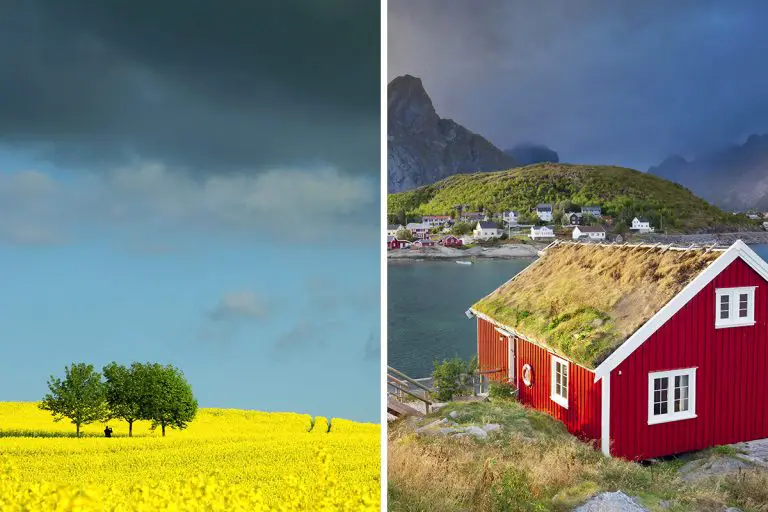
Table of Contents
Denmark and Norway, two jewels of Scandinavia, have something for every traveler. With their captivating cultures, breathtaking natural beauty, and the allure of adventure, your journey is bound to be unforgettable. Ready to discover what these Scandinavian paradises have in store for you? Read on and let your Nordic journey begin.
History & Culture
Have you ever wondered about the past and traditions of Denmark and Norway? They are like two books filled with interesting tales. Let’s turn their pages!
In Denmark, your journey back in time starts with the Vikings. Yes, those brave seafarers came from here! They left their mark with stunning artifacts and tales of daring adventures. Fast forward to the Renaissance, and you find Denmark thriving as a naval power. The Danes have a thing for fairy tales too. Ever heard of Hans Christian Andersen? That’s their pride!
Norway, on the other hand, shares the Viking heritage. But its history takes a twist with a stronger focus on farming and fishing communities. It also had its share of naval prowess, especially during the Age of Vikings. Norway’s cultural identity is tied up in its love for nature. They have a deep respect for the land, which is seen in their folklore and traditions.
Danes are known for their love of ‘hygge’, a concept that’s all about coziness and comfort. They value simplicity and contentment. You’ll notice this in their lifestyle and social interactions. It’s a big part of why Denmark often ranks as one of the happiest countries in the world!
Norwegians also cherish simplicity, but in a different way. They call it ‘koselig’. It’s a bit like ‘hygge’, but with more emphasis on enjoying the outdoors, even in cold weather. You’ll see this love for nature reflected in their traditions and everyday life.
So, in the culture and history contest between Denmark and Norway, it’s not about who wins. It’s about the unique flavor each country brings. Will it be Denmark’s seafaring past and ‘hygge’ lifestyle or Norway’s nature-loving culture and ‘koselig’ concept that appeals to you more?
Attractions & Activities
Denmark and Norway are both full of things to see and do. Let’s take a look at what these two Scandinavian gems have to offer!
In Denmark, you can’t miss visiting Copenhagen, the capital city. The iconic Little Mermaid statue and the colorful buildings of Nyhavn are must-sees. For history buffs, the National Museum of Denmark is a treasure trove. Love castles? Then, you’ll be thrilled by the Renaissance-era Kronborg Castle.
Norway, on the other hand, offers breathtaking natural attractions. The famous fjords, like Geirangerfjord and Nærøyfjord, are truly awe-inspiring. If you’re up for a thrill, try hiking to Pulpit Rock for a view you’ll never forget. Oslo, the capital city, is home to the Viking Ship Museum, a nod to Norway’s rich history.
Copenhagen also offers a lot of green spaces. You can relax in the beautiful King’s Garden or visit the Copenhagen Zoo. For a unique experience, try a canal tour around the city.
Norway’s activities are more focused on nature. You can go on a fjord cruise or try cross-country skiing. For a touch of culture, visit the outdoor Norsk Folkemuseum in Oslo.
In summary, if you love cityscapes and history, Denmark might be your go-to place. But if you prefer nature and outdoor activities, Norway could be your perfect fit. So, which one tickles your fancy, the historical charm of Denmark or the natural beauty of Norway?
The beaches of Denmark and Norway? Ah, each one is a little slice of heaven. Let’s dive into the sandy shores and crisp waters of these Scandinavian gems.
Denmark is flat and surrounded by seas, so it has plenty of beaches. One favorite is Skagen’s Sønderstrand. It’s in the north, where two seas meet. You can literally stand with one foot in each sea! The beach is long, about 60 miles (around 96.5 kilometers), and is known for its soft sand and light.
Amager Beach in Copenhagen is another Danish gem. It’s a man-made island stretching about 2 miles (around 3.2 kilometers). Perfect for a city break, right? You’ll find white sands and a view of the Øresund Bridge, linking Denmark and Sweden.
Norway, famous for its fjords, isn’t known for beaches, but it has some hidden gems. Huk Beach, near Oslo, is small but beautiful. It’s about 0.6 miles (roughly 1 kilometer) long, and it offers lovely views of the fjord.
Kvalvika Beach in the Lofoten Islands is another Norwegian beauty. It’s hidden between mountains and can only be reached by a 1.2-mile (around 2 kilometers) hike. The effort is worth it, trust me! The view of the turquoise sea against the rugged mountains is just breathtaking.
In conclusion, Denmark’s beaches are easily accessible and family-friendly, while Norway’s are more secluded and adventurous. Are you looking for convenience and city views, or are you up for a little adventure with stunning nature?
Eating, Drinking & Nightlife
Now, let’s talk about the fun stuff: food, drinks, and nightlife in Denmark and Norway. Are you ready for a culinary and entertainment journey?
Danish cuisine is all about simplicity and freshness. Smørrebrød, an open-faced sandwich, is a must-try. For a sweet treat, try Danish pastries. They’re flaky, buttery, and absolutely delicious.
When it comes to drinks in Denmark, Carlsberg beer is quite popular. If you’re brave, try snaps, a strong Danish liquor often enjoyed with meals. It’s definitely an experience!
Copenhagen is known for its vibrant nightlife. There are jazz clubs, dance clubs, and cozy pubs. If you’re into live music, check out VEGA, one of the city’s top concert venues.
Now, let’s head over to Norway. Norwegian cuisine is heavily influenced by its coastline. Fresh seafood is a must. Try Rakfisk, a traditional dish of fermented fish, if you’re feeling adventurous!
Norwegians love their coffee. They’re one of the top coffee-consuming countries in the world. So, grab a cup and enjoy. For something stronger, try Aquavit, a spiced spirit that’s a favorite in Norway.
Nightlife in Norway is diverse. Oslo has everything from high-end clubs to local pubs. If you’re in the mood for a show, check out the National Theatre in Oslo.
In summary, Denmark offers classic dishes, strong drinks, and a lively music scene, while Norway brings fresh seafood, unique coffee culture, and a diverse nightlife to the table. So, are you leaning towards Danish comfort food and lively clubs, or does Norwegian seafood and a cup of rich coffee sound more appealing?
Denmark and Norway are both shopping heavens, each in their own unique way. Ready to fill up your shopping bags?
In Denmark, Copenhagen’s Strøget is a must-visit. It’s one of the longest pedestrian streets in Europe, full of shops. You can find big brands and Danish designers all in one place.
For a more local experience, Torvehallerne in Copenhagen is a treat. It’s a market where you can buy fresh food, flowers, and Danish delicacies. If you’re a book lover, check out the charming secondhand bookshops around the city.
Norway also offers a wonderful shopping experience. Oslo’s Karl Johans Gate is the main shopping street. It’s lined with shops, from high-end brands to local Norwegian designs.
In Bergen, you’ll find the famous Fish Market. Besides fresh seafood, it also sells crafts and souvenirs. If you’re into vintage stuff, Oslo’s Grunerløkka district has cool secondhand shops and indie boutiques.
In a nutshell, Denmark offers a blend of modern and traditional shopping, while Norway provides a mix of high-end and local shopping experiences. So, are you excited to shop for Danish designs or would you rather explore Norwegian boutiques?
Accommodation
Finding a place to stay in Denmark and Norway is easy, with lots of options to suit your style. Let’s find the perfect one for you!
In Denmark, Copenhagen offers luxury hotels with stunning views of the city. You can also find budget-friendly hostels that are cozy and clean.
For a unique Danish experience, try staying in a holiday cottage. They’re popular in coastal towns and offer a home-like comfort.
In Norway, Oslo has a range of hotels from luxury to budget. Many are located near popular attractions, making sightseeing a breeze.
You can also try cabin stays in Norway. They’re especially popular in the countryside and offer stunning views of the natural landscape.
To sum it up, Denmark offers everything from luxury hotels to cozy cottages, while Norway has a range of hotels and unique cabin stays. So, are you dreaming of a luxury hotel in Denmark’s capital or a cozy cabin in the Norwegian countryside?
Family-Friendliness & Children’s Activities
Traveling with kids? Both Denmark and Norway roll out the red carpet for families. Let’s see what they offer!
In Denmark, Tivoli Gardens in Copenhagen is a hit with kids. It’s an amusement park right in the city center. It has fun rides, games, and even live performances.
Another great Danish spot is the National Aquarium, also known as Den Blå Planet. It’s Northern Europe’s largest aquarium, full of fascinating sea creatures.
Norway is also family-friendly. The Norwegian Museum of Science and Technology in Oslo is fun and educational. Kids can learn about science and technology through interactive exhibits.
Another Norwegian highlight is the Kristiansand Zoo and Amusement Park. It’s the most visited attraction for families with children in Norway. It offers a zoo, a water park, and even a pirate village!
In short, Denmark offers city-based family attractions, while Norway provides a mix of educational and outdoor fun. So, are you thinking about a thrilling amusement park ride in Denmark or an educational adventure in Norway?
Getting There & Getting Around
Wondering how to reach and navigate Denmark and Norway? Both countries offer convenient options, making your journey smooth and enjoyable.
To reach Denmark, Copenhagen Airport is the main international gateway. It’s about 5 miles (8 kilometers) from the city center. Many airlines operate flights to Copenhagen from major cities around the world.
Once in Denmark, getting around is easy. The country has an efficient public transportation system. Trains and buses connect cities and towns. Bicycling is also popular in Danish cities.
Norway is also accessible by air. Oslo Airport is the largest, around 22 miles (35 kilometers) from the city. Like Denmark, many airlines fly to Norway from international destinations.
Getting around in Norway is best done by public transport. Trains, buses, and ferries connect different parts of the country. For city travel, Oslo has trams and buses.
To conclude, both Denmark and Norway are easy to reach and navigate. Denmark offers efficient public transport and bike-friendly cities, while Norway’s public transport provides easy access to its scenic landscapes. So, are you ready to hop on a Danish bike or explore Norway’s scenic routes by train?
Curious about the weather in Denmark and Norway? Let’s dive in!
Denmark has a temperate oceanic climate. Summers are pleasant, with temperatures around 68°F (20°C). It’s perfect for outdoor activities.
Winters in Denmark can be chilly. Temperatures drop to around 32°F (0°C). But don’t worry, it’s still a good time to visit, especially if you like cozy indoor activities.
Norway’s weather varies with its geography. Coastal areas have milder winters and cooler summers. Summer temperatures are around 60°F (15°C), while winter temperatures hover around 30°F (-1°C).
Inland Norway, especially the mountainous areas, can get much colder. In winter, temperatures can drop to -4°F (-20°C).
To sum up, Denmark’s weather is mild and stable, while Norway offers a range of climates depending on where you are. So, are you up for a mild Danish summer or would you prefer a cool Norwegian one?
Concerned about safety while traveling? Both Denmark and Norway are known for being safe.
In Denmark, crime rates are low. Petty crime like pickpocketing can occur, especially in tourist areas. But by staying alert, you should be fine.
Norway is also considered safe. It shares the same concern of petty crime in crowded places. Just like in Denmark, keep an eye on your belongings.
Unique to Norway, you should be aware of natural hazards. If you’re hiking in the mountains, remember that the weather can change rapidly.
Summing it up, both Denmark and Norway are safe destinations with low crime rates. Just remember to be aware of your surroundings. So, are you ready to explore Denmark’s safe streets or venture into Norway’s safe but wild outdoors?
Wondering about the costs in Denmark and Norway? Let’s find out!
In Denmark, the local currency is the Danish Krone (DKK). A meal at an inexpensive restaurant costs around 120 DKK (about 19 USD). Transportation is also reasonable, with a one-way ticket on local transport costing around 24 DKK (roughly 4 USD).
Accommodations in Denmark can vary. Budget options start from 400 DKK (approximately 63 USD) per night. More luxury stays will, of course, cost more.
Norway uses the Norwegian Krone (NOK). It’s known for being one of the more expensive European destinations. A meal at a budget-friendly restaurant might set you back about 200 NOK (23 USD). A one-way ticket on local transport is about 36 NOK (4 USD).
Accommodation prices in Norway are similar to Denmark. You can find budget options from 600 NOK (70 USD) per night. Luxury accommodations will cost more.
In conclusion, both Denmark and Norway can be pricey compared to other destinations. However, with careful planning, affordable options are available. So, are you ready for the Danish value or the Norwegian experience?
Which Is Better – Denmark or Norway?
Making a choice between Denmark and Norway isn’t easy. Both countries have a lot to offer.
History and culture enthusiasts might lean towards Denmark. Its rich Viking history and cultural sights like Tivoli Gardens and the National Aquarium make it a standout.
If attractions and activities are your thing, both countries have their merits. Denmark has city-based fun, while Norway offers outdoor and educational experiences.
For beach lovers, the choice might hinge on personal preference. Norway’s fjord beaches are unique, while Denmark’s sandy beaches are more traditional.
Foodies and night owls might prefer Denmark for its world-renowned cuisine and vibrant nightlife. Norway, on the other hand, offers unique culinary experiences and a more laid-back night scene.
When it comes to safety, both countries are considered safe. However, remember to stay alert, especially in crowded tourist areas.
Ultimately, your choice between Denmark and Norway will depend on what you’re seeking from your trip. Are you ready to make your pick?
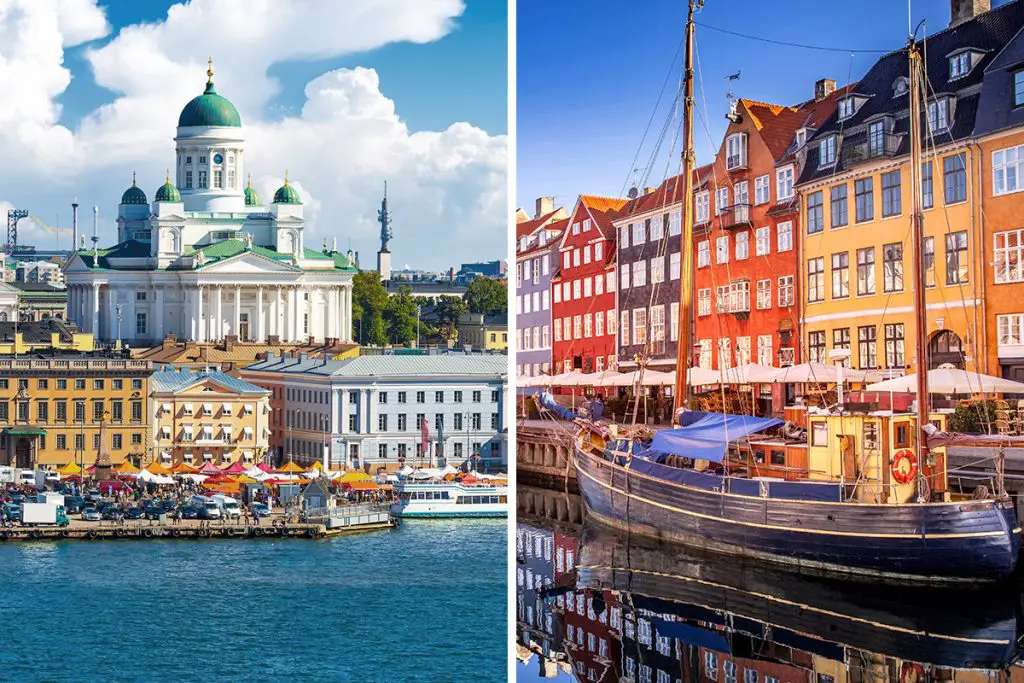
About | Contact | Privacy Policy
Copyright © Loco Media
het avontuurlijke leven van Antonette Spaan

Scandinavia trip planning: which country should you go to?
If you have been to We12travel before, you may know that nordic destinations are my favorite places to travel. The definition of nordic destinations is of course quite broad, but with ‘nordic’ I mean the outer ends of this planet. In other words, Scandinavia, Canada and Alaska, but also Patagonia and New Zealand, which are not located in the north, but resemble northern destinations in nature. I’m not necessarily interested in the mountains (because you also have those in the Alps and Nepal, for example), but it’s more about the feeling that you get while there. The relaxed atmosphere, the wooden houses, the roughness of the landscape and the mostly cool temperatures. People who recognize it probably know what I mean. Although the northern countries in Scandinavia may not be at the top of your bucket list, they are all definitely worth a visit. Each destination has its own charm and landscapes. In this article I list the countries of Scandinavia for you. If you are interested in going north, this article will certainly help you make your Scandinavia trip planning much easier and will hopefully tell which is the best Scandinavian country to visit for you!
Table of Contents | Inhoudsopgave
What are the Scandinavian countries?

Your first time in Scandinavia: what to expect

Travel in Norway

Norway highlights:
Below you’ll find some of the highlights of Norway. Very personal and certainly not complete, but useful if you are interested in a Norway trip: – Fjord Norway (in particular the Nærøyfjord and Geirangerfjord when there are no cruise ships) – The Hardangervidda plateau – City trip in Bergen (possibly with a visit to the fjords) – The northern islands of Lofoten, Vesterålen and possibly Senja Island – The glaciers of Jostedalsbreen National Park and Folgefonna National Park
Why Norway?
Stunning nature, delicious food, freedom camping (to a certain extent), whales and Northern Lights. Disappointments in Norway are the North Cape (very busy, I have heard of it because never bothered to go there) and the often rainy weather. I also found the Hardangerfjord less beautiful than expected. In addition, Norway really is the worst when it comes to high prices and is therefore not exactly a destination for budget travelers.
My Norwegian favorites:
– Salmon. Salmon. Salmon. And again salmon. – The thrillers by author Jo Nesbø – Het Every Man’s Right (with restrictions) – The fjords – The most beautiful glaciers in Europe accessible over land Want to read more? These are my favorite Norway blogs: – A summer vacation in Åkrafjorden, Norway – Biking in Norway: an amazing ride from fjord to fjell – The most amazing viewpoints in Fjord Norway Or read all my Norway blogs and articles here .
Book your Norway trip

Travel in Sweden

Sweden highlights
– Stockholm and Gothenburg – The Sånfjället and Fulufjället National Parks – Reindeer, moose and possibly bears – Arctic Sweden around Jokkmokk and Kvikkjokk – The islands off the coast near Stockholm and Gothenburg
Why Sweden?
Sweden is super relaxed. It certainly does not have as many tourists as Norway and Iceland. It’s less busy, there’s fewer rules and less densely populated areas. Whereas in Norway you’ll always see a (holiday) cottage on almost every square kilometer, you can really drive for miles in Sweden without encountering anything. In addition, Sweden is easily accessible by car, via the bridge between Copenhagen and Malmö. The places that disappointed me in Sweden were Skåne (too many meadows), Kiruna and the busy spots in Stockholm in recent years.
My Swedish favorites
– Swedish tv crime series (especially The Killing, Midnight Sun and Arne Dahl) – Swedish thrillers (especially Camilla Läckberg, Lars Kepler, Henning Mankell) – Daim chocolate – Cinnamon buns and fika (coffee with something tasty) – The Every Man’s Right – Drive on the E45 – the road to the north – A winter holiday in Sweden – Hiking the Kungsleden (King’s Trail) Want to read more? These are my favorite Sweden blogs: – Hiking the Kungsleden Trail: a true Nordic adventure – Hiking and camping in the Swedish wilderness – 5 Really cool outdoor things to do in Småland Or read all my Sweden articles here .
Book your Sweden trip

Travel in Finland

Finland highlights
– Finnish Lappland in winter – Huskies, snowmobiling, Northern Lights (Aurora Borealis) – Helsinki (and I liked Tampere too, by the way)
Why Finland?
As I said, I would really only recommend Finland as a winter destination. In the summer, for example, Sweden and Norway have much more to offer in terms of natural beauty. However, if you are crazy about forests, lakes and mosquitoes then Finland in the summer is really something for. You can also see bears in the far north, but they are usually attracted with food. Since I am really opposed to that, I would never opt for such an experience myself. Wildlife just has to stay wild and should not be fed. Santa Clause Village near Rovaniemi is also really terribly touristy and you’d better skip it!
My Finnish favorites
– Sauna’s – Helsinki – Huskies – Jari Litmanen (thinking back of my youth) – Finnish metal music – Sunset near one of the many lakes Want to read more? Go here to read all my Finland articles.
Book your Finland trip

Travel in Iceland

Iceland highlights
– The Snæfellsnes peninsula – The interior (only accessible with a 4WD) – Jökülsárlón and Fjallsárlón iceberg lakes – The Golden Circle – Hiking between the hot springs
Why Iceland?
You cannot compare Iceland to any other country. The quirky but very friendly Icelanders do everything to make you happy. You can see northern lights in the winter, whales all year round and cross the interior highlands with a 4WD in the summer. You can also make super amazing hikes, walk to an abandoned aircraft wreck and visit various volcanoes. The Blue Lagoon is a real tourist trap that is also super expensive. You better visit one of the (free) alternatives to the Blue Lagoon .
My favorites
– The Westman Islands – Jökülsárlón – Landmannalaugar – A glacier hike on the Sólheimajökul – Puffins – Eating a burger at Hamborgarafabrikkan – The clothing of 66 North and Cintamani Want to read more? These are my favorite Iceland blogs: – The best places to stay in Reykjavík for any budget – Fjallsárlón or Jökulsárlón: which glacier lagoon should you visit? – What to pack for Iceland in winter: a complete packing list – All you want to know about renting a car in Iceland Or read all my Iceland articles here .
Book your Iceland trip

Travel in Denmark
And last but not least there’s Denmark. To be honest, it is my least favorite country in Scandinavia. I have been there on a few occasions on holiday (in a house near Esbjerg) but I cannot remember that I found it very impressive as a nature lover. This does not change the fact that there is plenty to see and do, but a little less for nature lovers than the other Scandinavian countries. Because it has been years since I was on vacation, I don’t have any blogs about it.
Denmark highlights
– A citytrip Copenhagen – The rocks near Møns Klint – Walking along the endless coast line
Why Denmark?
I don’t have any children of my own, but I was told that Denmark is a great place to go with your family. There are numerous amusement parks, many holiday homes and everywhere there are good facilities for kids. In addition, it is not too far from the Netherlands. Copenhagen is perfect for a city trip, although it is a relatively expensive city compared to other Scandinavian cities.
– The Bridge (series and to drive across) – Walking along the windy coast – Legoland
Book your Denmark trip

Conclusion and disclaimer of Scandinavia trip planning
Hopefully you found this article about which Scandinavian country is the best to visit useful and will it help you make a choice for which country to choose when you first go north. Although I clearly have my favorite destinations, I have tried to stay as objective as possible. However, as a blogger, I see it as my job to also name less pleasant places / things (such as feeding bears and the Blue Lagoon) and to be honest about them when I know a destination less well. In this article about the best nordic country to visit you will find affiliate links. If you make a reservation or make a purchase through such a link, I may receive a modest commission, without extra costs for you.
Related posts..

Thank you for these tips! I’m just planning my winter trip to Finland and this has me so excited 🙂 Lots of sauna and sleddogs!!
Yaaay … have fun!
All these places call to me! I would love to explore (and hike) in Scandinavia. So far we have only been to Iceland, but I am soooo keen to visit the rest, especially Norway and Sweden.
Hope you can make it there one day!
Leave a Reply Cancel reply
Your email address will not be published. Required fields are marked *
Notify me of followup comments via e-mail. You can also subscribe without commenting.

Explore the Hidden Treasures of Northern Denmark and Southern Norway
Get to know the lesser-known heroes of two countries in one trip, taking in the dazzling scenery of southern norway’s coastal communities alongside the cultural gems of northern denmark..
- Copy Link copied

Aalborg’s harbor in Northern Denmark
Courtesy of Destination Nord
This 10-day tour of northern Denmark and southern Norway covers local culinary delights and off-the-beaten-track experiences that help you get under the skin of this beautiful part of Europe. Discover dramatic waterfalls and churches hidden under the sand, sail across fjords, and hike to the Trolltunga, a stunning rock formation that juts out over a lake in Norway. From jaw-dropping scenery and cozy fishing villages to world-class eats, these under-the-radar destinations are an ideal way to travel deeper in the Nordic countries. Turn to 50 Degrees North for even more travel advice.

Trip Highlight
Bolder lodges.

Trip Designer
The nordics.

The Alvar Aalto-designed Kunsten Museum of Modern Art
Day 1 Explore Architecture and Design in Aalborg

Skagen’s yellow houses
Day 2 Discover the Painter’s Colony of Skagen

The Rubjerg Knude Lighthouse
Photo by Daniel Villadsen
Day 3 Uncover the Secrets in the Sands of Råbjerg Mile

North Shore Surf
Courtesy of VisitNordvestkysten
Day 4 Explore the Beach Towns of Denmark’s West Coast

Fiskebrygga in Kristiansand
Photo by Victoria Nevland/Visit Sørlandet
Day 5 Welcome to Kristiansand, Norway

The Lindesnes Lighthouse, Southern Norway
Photo by Peder Austrud/Visit Sørlandet
Day 6 Explore Mandal and More Along Norway’s Southern Coast

Sogndalstrand, Southern Norway
Photo by Christine Baglo/Visit Norway
Day 7 Norway’s Otherworldly Scenery

Preikestolen in Stavanger (Pulpit Rock)
Photo by Casper Tybjerg/Visit Norway
Day 8 Stavanger and Beyond

Trolltunga, Southern Norway
Courtesy of @kaptenhall/Trolltunga Adventures
Day 9 Norwegian Nature

Tre Sverd, Stavanger
Photo by Brian Tallman Photography
Day 9 City Life in Stavanger

Thanks for visiting nordicvisitor.com! For the very best browsing experience on our website, we urge you to upgrade to the most recent version of your browser . Some of our site features may not function properly on older versions.
- Travel Update
- Search Suggested Results View All Results
- EUR (€)
- GBP (£)
- Self-Drive i
- Privately Guided i
- Guided Small Groups i
- Northern Lights i
- Honeymoon & Romance i
- Ice & Snow Hotels i
- Multi-Country Tours i
- All Travel Styles
- Show all tours
- Best Sellers
- Special Offers
- Scandinavia
- Switzerland
- United Kingdom
- Book With Confidence i
- Why book with us i
- Booking Terms i
- Sustainability Policy i
- Manage Booking
- Privacy policy
Iceland Bíldshöfði 20 110 Reykjavík +354 578 20 80 View Map
Sweden Scotland View Details
The Nordic Countries: Your Ultimate Travel Guide
Close your eyes and imagine pristine natural landscapes, crisp fresh air and the northern lights dancing across the night sky above you. Where in the world are you? Chances are you’re in one of the Nordic countries.
This group of nations is huddled together right at the top of the world. Some even cross the Arctic Circle. But what are the Nordic countries exactly? And why would you want to visit them?
The Nordic countries consist of Denmark , Finland , Iceland , Norway and Sweden . Take a look at a map and you’ll see all these nations form part of Northern Europe. The island territories of Greenland , the Faroe Islands and Åland also fall under the Nordic region.
- Browse top tours of Northern Europe
Ever wondered what exactly a fjord is? Where you can see the northern lights? Or whether the term “Scandinavia” included Finland?
Read on to get answers to these questions and more!
What’s the difference between the terms “Scandinavian” and “Nordic”?
How do the nordic countries work together, what do the nordic countries have in common, denmark: home of royalty and fairy tales, finland: forests and lakes as far as the eye can see, iceland: the land of fire and ice, norway: fantastic fjords, sweden: something for everyone, greenland: awe-inspiring nature and inuit culture, svalbard: norway’s final frontier.
You may be familiar with the term “Scandinavia” – this refers exclusively to the countries of Denmark, Norway and Sweden. These three nations on the Scandinavian peninsula have been inhabited by Norse and Sámi people for thousands of years.

The Scandinavian languages are Danish, Norwegian and Swedish. They all descend from Old Norse, the common language spoken in the region in Viking times. The Vikings famously used runes when carving inscriptions into stone, like in the image above.
The Icelandic and Faroese languages also come from Old Norse. Iceland and the Faroe Islands are not Scandinavian countries, but they are Nordic. What exactly does “Nordic” mean though?
- Interested in the Vikings? Check out these Norway culture and history tours
The term “Nordic countries” or “Nordic region” covers Scandinavia, Finland and the autonomous region of Åland. It also includes Iceland, Greenland and the Faroe Islands to the west. These 3 island nations are all in the North Atlantic Ocean.
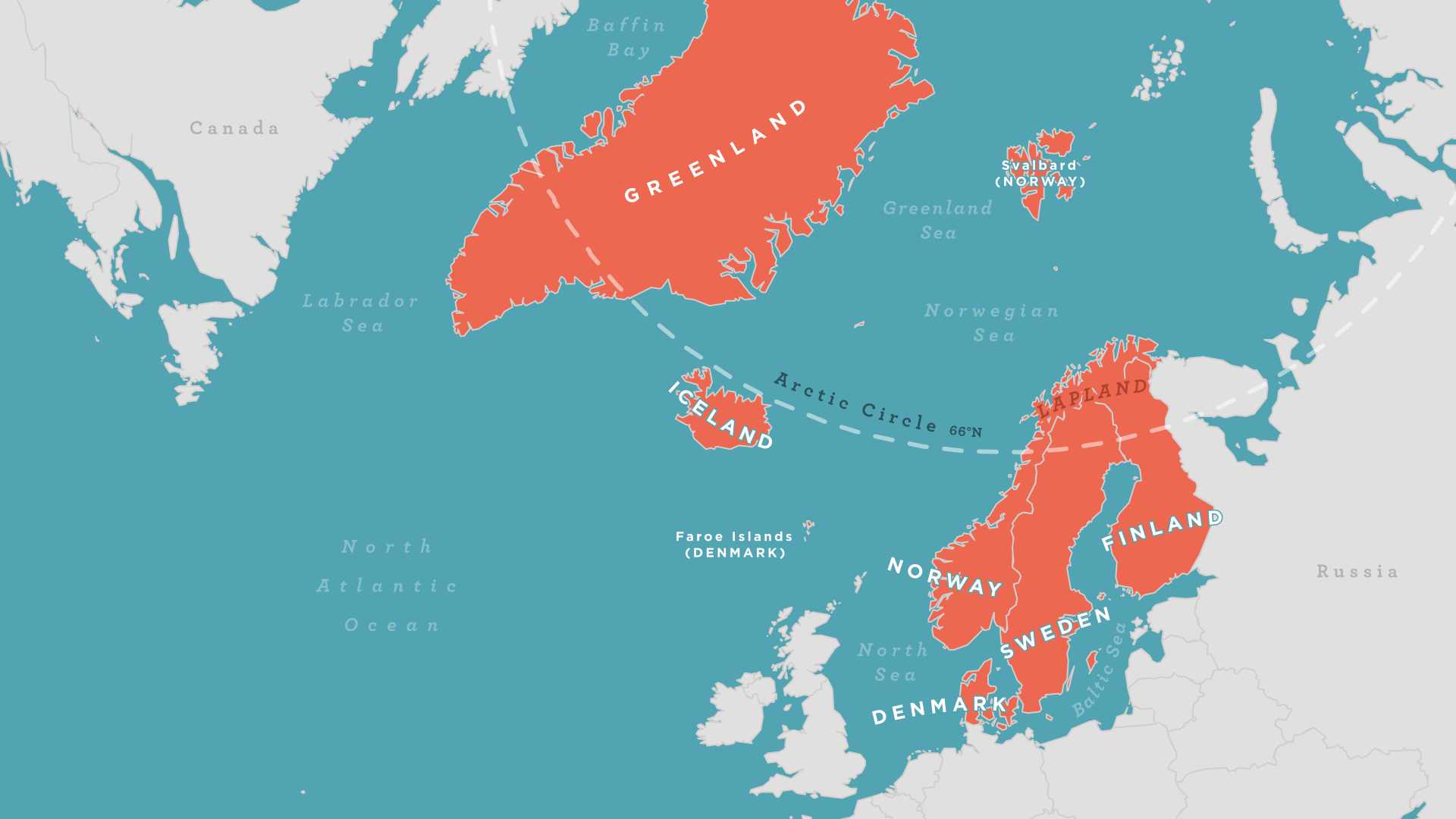
Finland lies at the eastern extreme of the region. There, Swedish is the first language of a minority, but Finnish is the main language. You can tell Finnish apart easily by its repeated sequences of double vowels. For example in Hyvää päivää , which means “good day”!
Finnish is not related to the other Nordic languages, but it is related to Estonian and the Sámi languages spoken in Lapland . “Lapland” or “Sápmi” refers to the Sámi territory that stretches across the far north of Norway, Sweden, Finland and parts of Russia.
Finally at the western extreme of the Nordic region is Greenland. The country has its own unique language, Greenlandic, which is related to the Inuit languages of North America.
If you’ve seen any Nordic noir TV dramas such as The Bridge or Thin Ice , you’ve probably noticed that the Nordic countries work pretty closely together.
This is clear not only from the number of government logos at the start of any Nordic TV or film production, but also how the characters work across borders to solve crimes.
- Have a cross-border adventure of your own, check out these Scandinavia tours
The Nordic countries collaborate formally with each other through the Nordic Council . The Council also aims to promote Nordic culture both within the Nordic region and further afield.
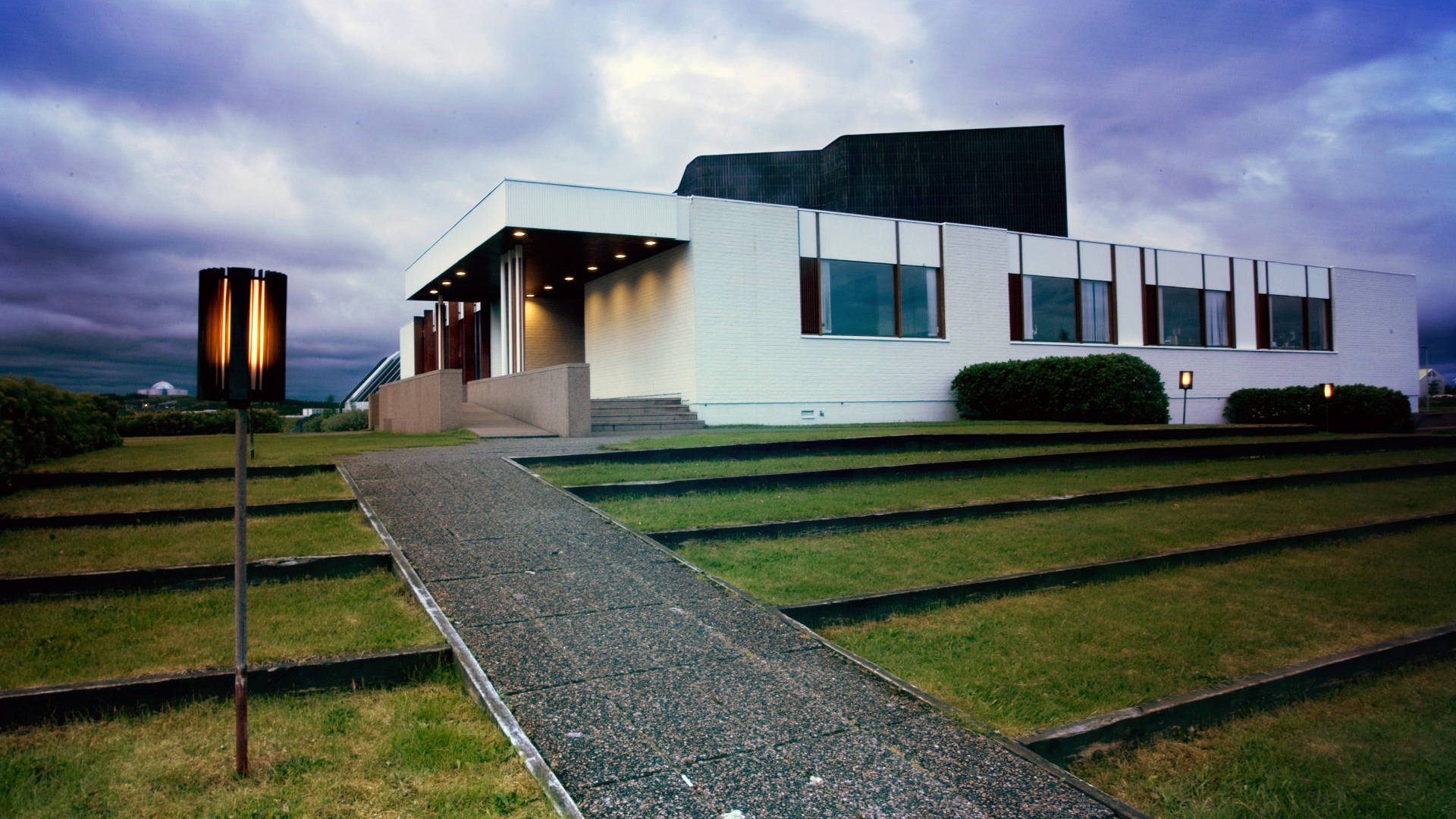
You can see this collaboration in action at the Nordic House in Reykjavík , which was designed by famous Finnish architect Alvar Aalto. Drop by and dine at the fantastic new-Nordic restaurant, visit the basement gallery and browse the library’s collection of Nordic literature.
Whilst the languages and cultures of the Nordic region are varied, you’ll find a number of things in common between the countries. First of all, they’re all relatively small population-wise. Sweden, the largest of the bunch, is home to just over 10 million people.
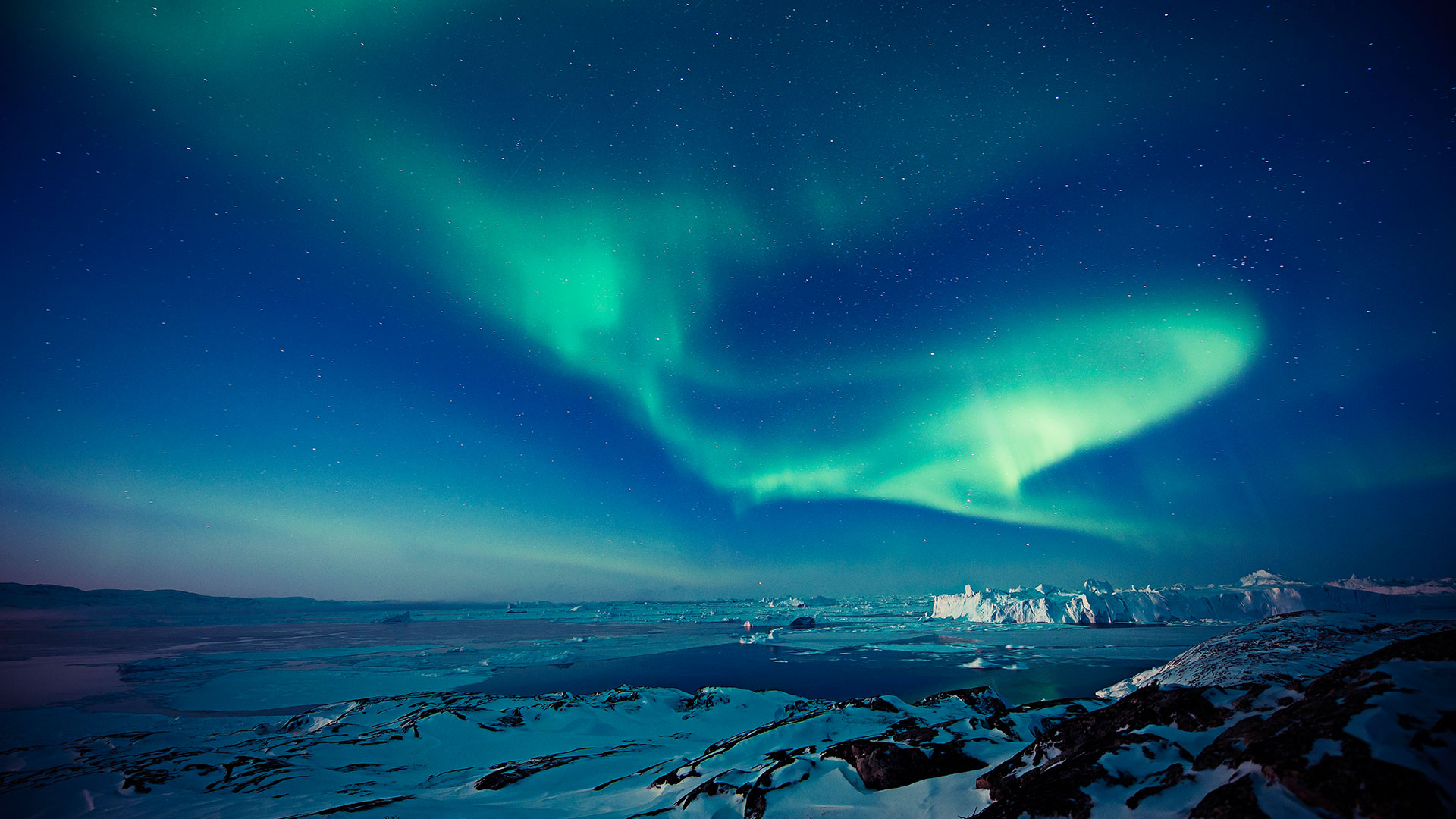
Then there’s the fact that Nordic societies are characterised by high levels of trust, openness and safety. People are direct and tell things as they are, because honesty and clarity are greatly valued.
That said, there are few places in the world where you’ll receive a warmer welcome than in the Nordic countries, despite the cold climate!
- Explore Denmark, Norway and Sweden with these Scandinavia Triangle tours
- Related: Best Lapland holidays for a winter getaway
What’s more, levels of economic equality in the Nordic region are amongst the highest in the world. This is partly due to the concept of the Nordic welfare state, which aims to give everyone the same opportunities regardless of their background.
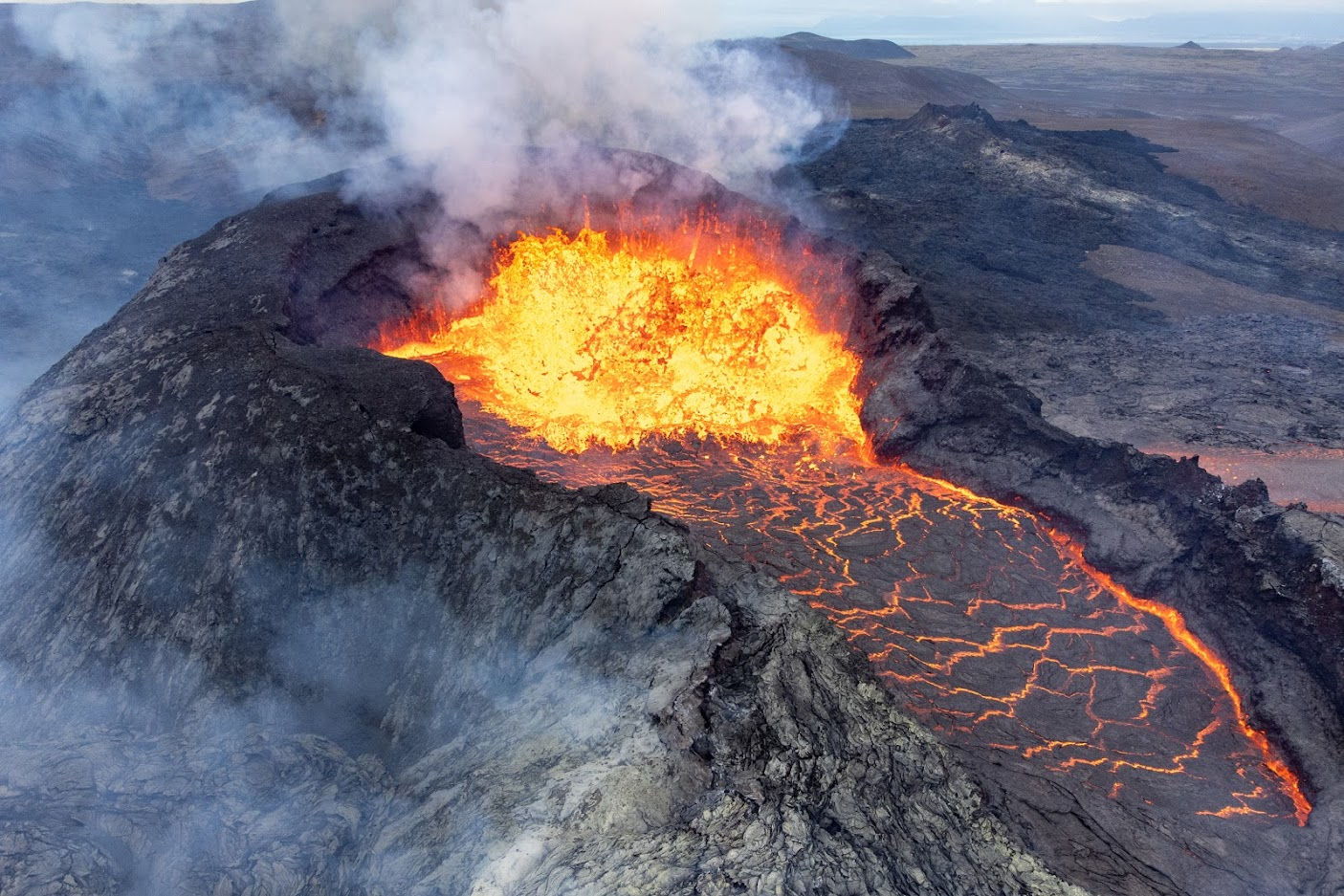
Finally, the Nordic countries are all home to pristine natural environments. Whilst the landscapes vary massively – from Denmark’s flat fields to Iceland’s glaciers and volcanoes ‒ there are a few common themes:
- Air and water is clean and crisp due to low levels of pollution
- National parks and protected areas are abundant
- Nature is accessible by everyone, thanks to the “right to roam”
The Nordic region, country by country
In this section, get the low-down on each of the Nordic region’s 5 fully independent countries.
Three of them – Denmark, Norway and Sweden – are kingdoms and boast royal charm. Although the other 2 – Iceland and Finland – are republics, they’re no less full of fairy-tale magic!
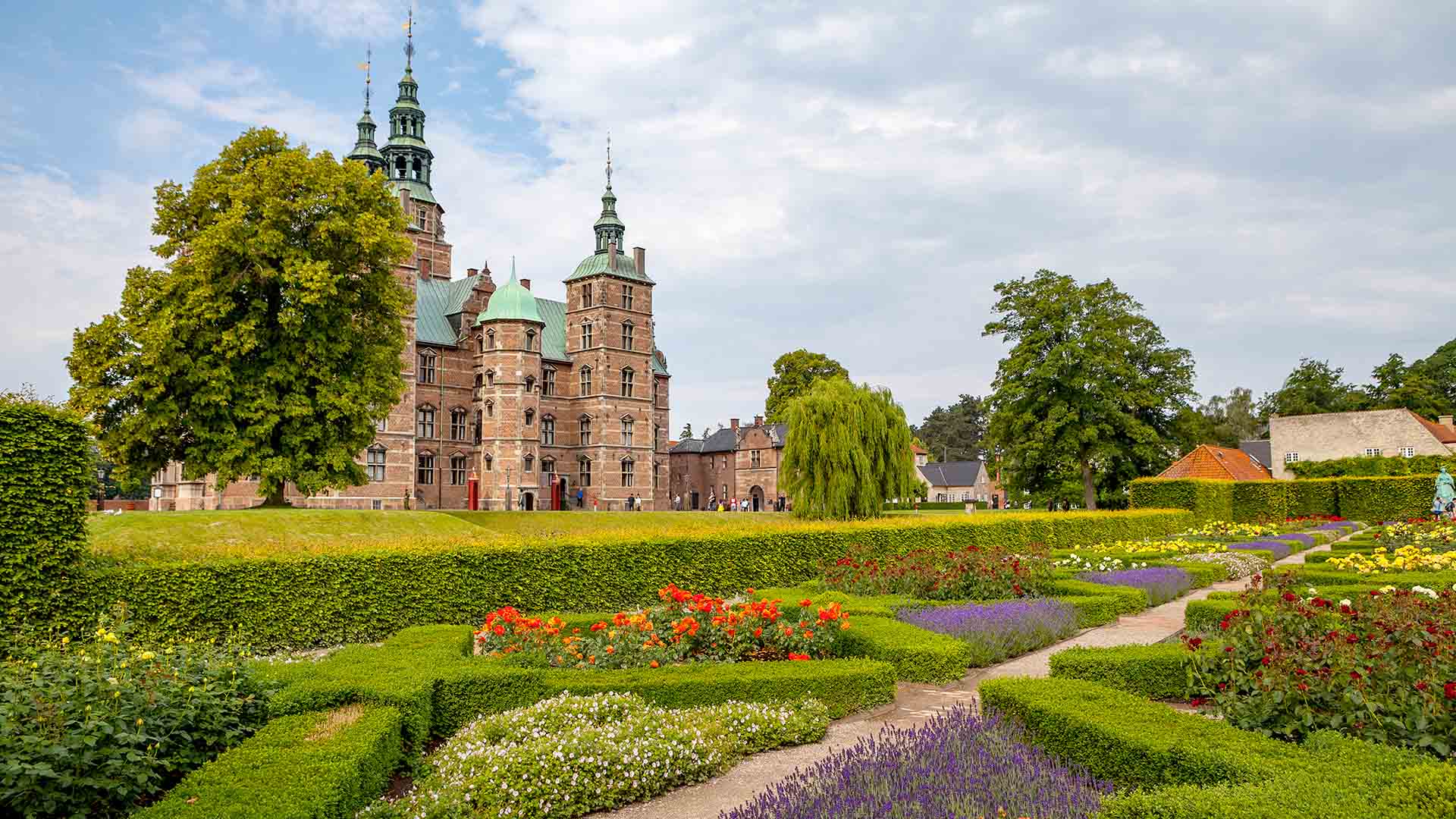
Denmark is the only Nordic country that is directly attached to the European mainland. Because of this, it has a different vibe from the rest of the Nordic region. The country is famously flat as a pancake, which is why Danes are in love with their bicycles.
Danish culture is rich and varied, and has a heritage stretching back thousands of years. The capital, Copenhagen, is the second-largest city in Scandinavia . Its breathtaking classical facades and Hanseatic architecture tell a story of a city built on merchant trade.
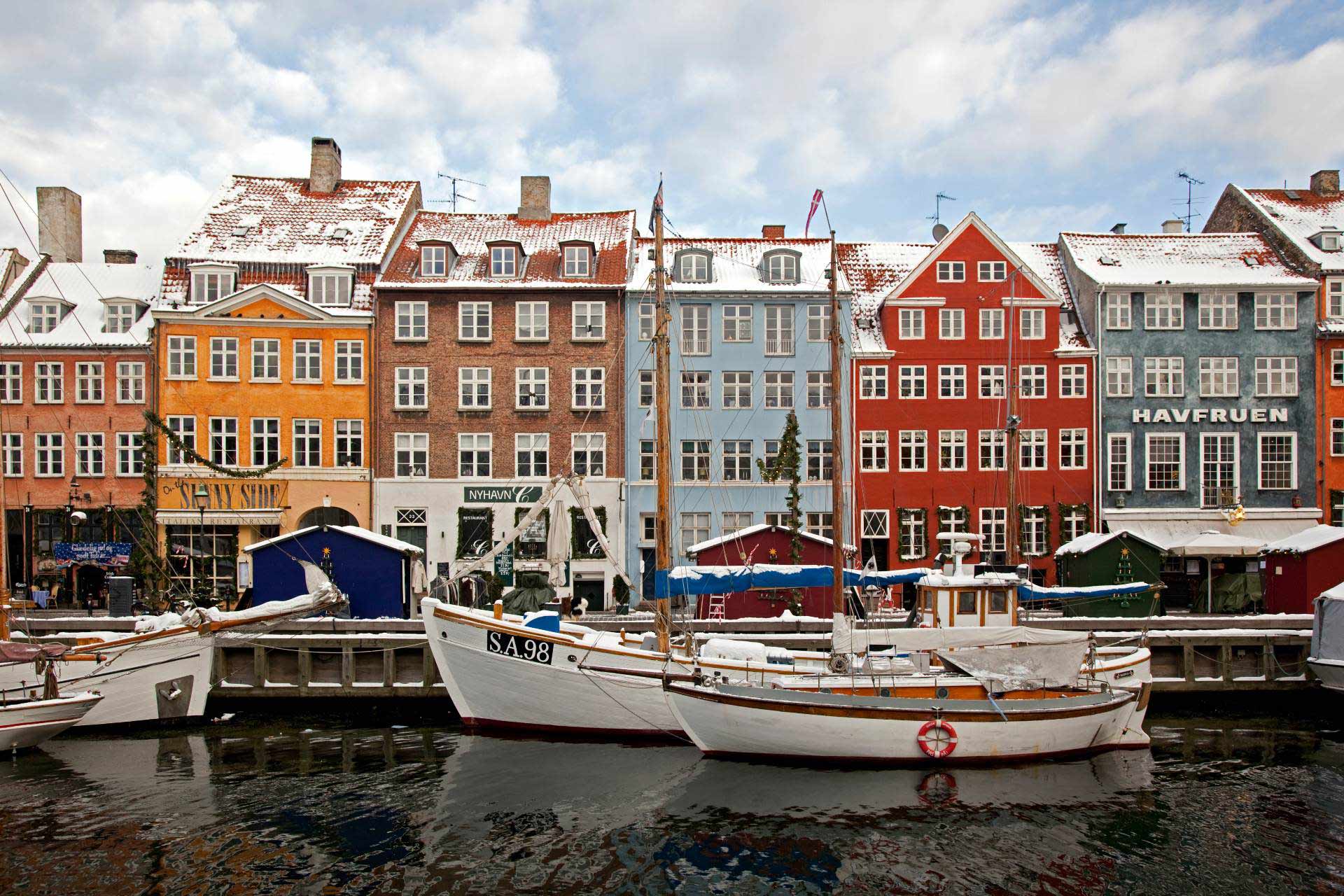
Check out the city’s royal palace and learn about Denmark’s military history at Skagen. And don’t forget to visit the original Little Mermaid statue commemorating Danish fairy-tale author Hans Christian Andersen.
- Be whisked away on a summer tour that includes Denmark
- Related: 10 Cool facts about Denmark
Today, cosmopolitan Copenhagen is home to stunning modern architecture, some of the world’s best restaurants and a vibrant cultural scene. LEGO fans won’t want to miss the flagship store on Strøget, the city’s main shopping street.
If you’re taking your family along, then a trip to Tivoli Gardens is also a must. Opened in 1843, this is one of the world’s oldest amusement parks and is said to have been Walt Disney’s inspiration for Disneyland.
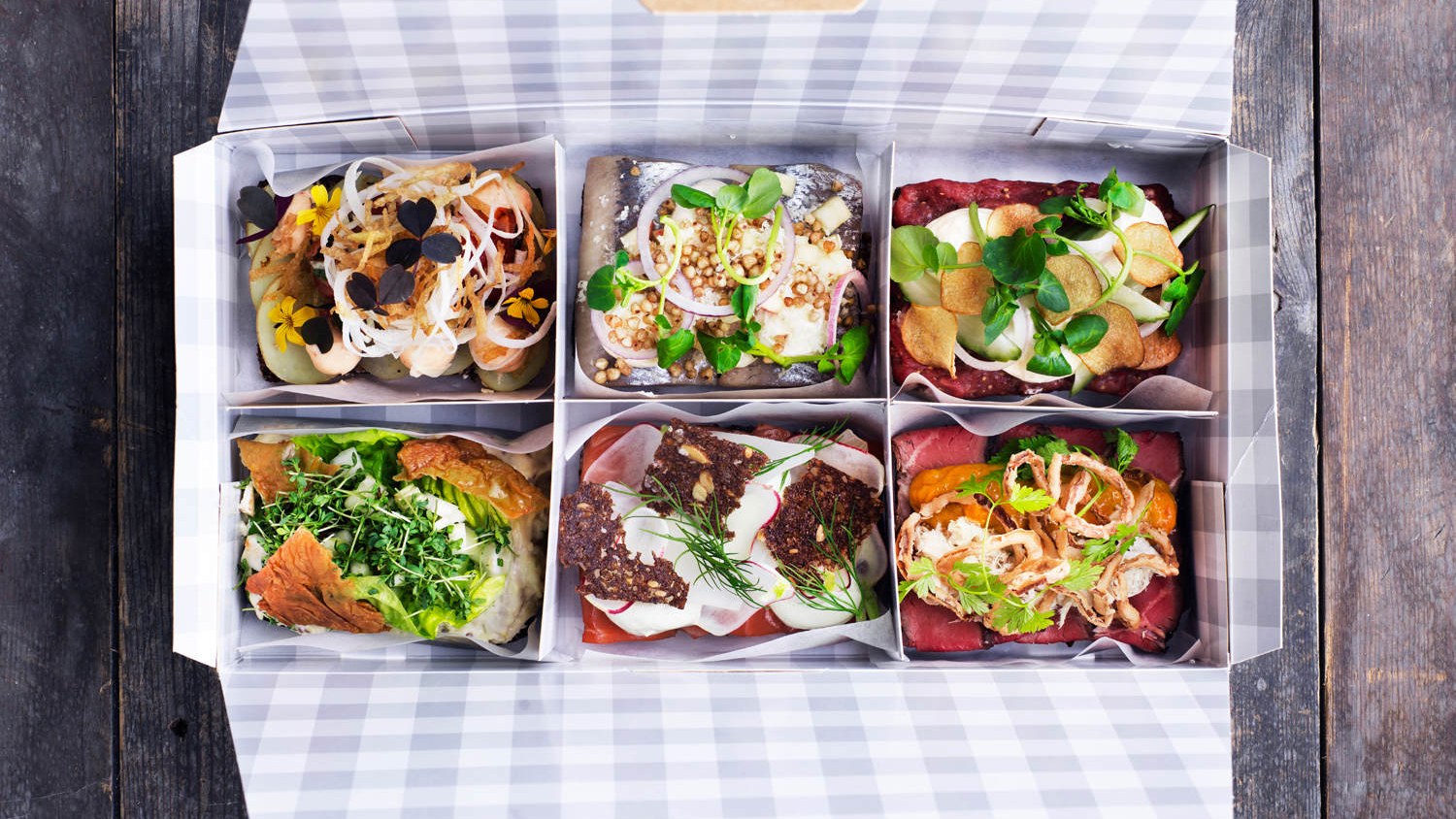
Food experiences you have to try in Denmark include:
- Smørrebrød – Delightfully delicate open-faced sandwiches
- Pølser – Danish hot dogs. Make sure to try the garnishes!
- Fantastic local pastries and breads
On the eastern extreme of the Nordic region, Finland is a sometimes-forgotten destination. Home to some of the largest forests in Europe and dotted with endless lakes, there’s absolutely no reason why you should skip past it!
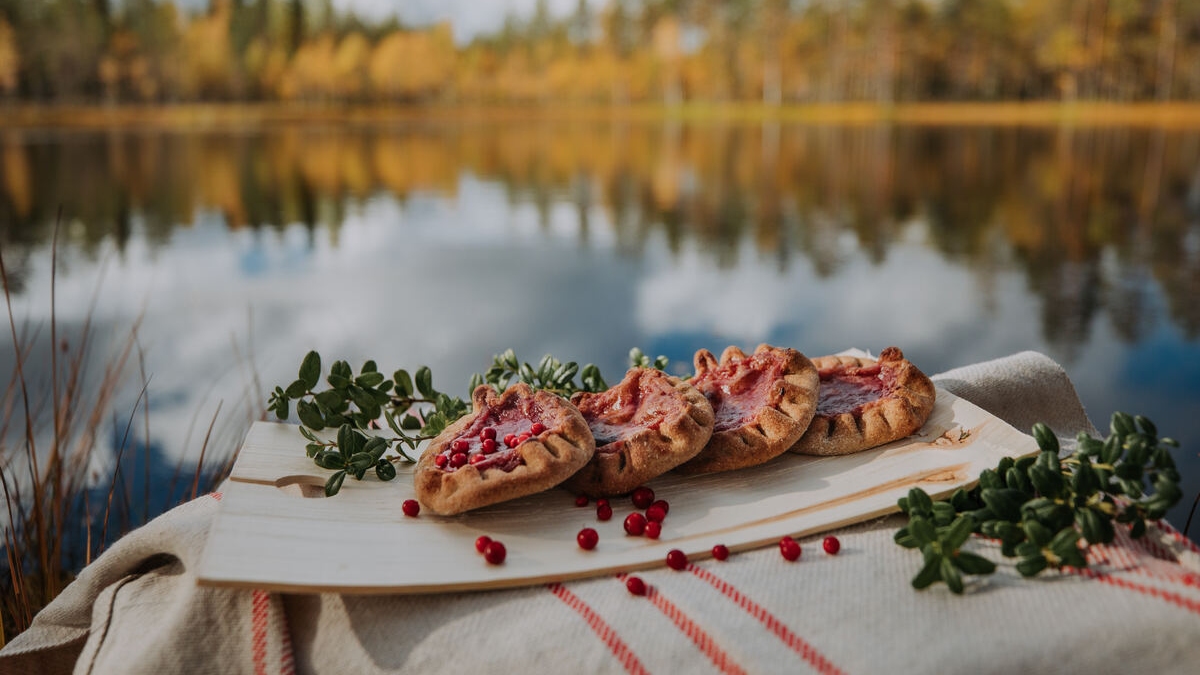
In the south, the nation’s capital, Helsinki, nestles on the Baltic Sea coast. Take a wander and try some of Finland’s many famous baked goods, including rye bread and Karjalanpiirakka or Karelian pasties (rye dough stuffed with rice pudding).
The capital is also a great place for you to soak up Finnish design culture. Finland is famous for its fashion and homeware brands such as Arabia, Iittala and Marimekko. Finnish designs often feature bright block colours and patterns based on nature. Check them out at Design District Helsinki .
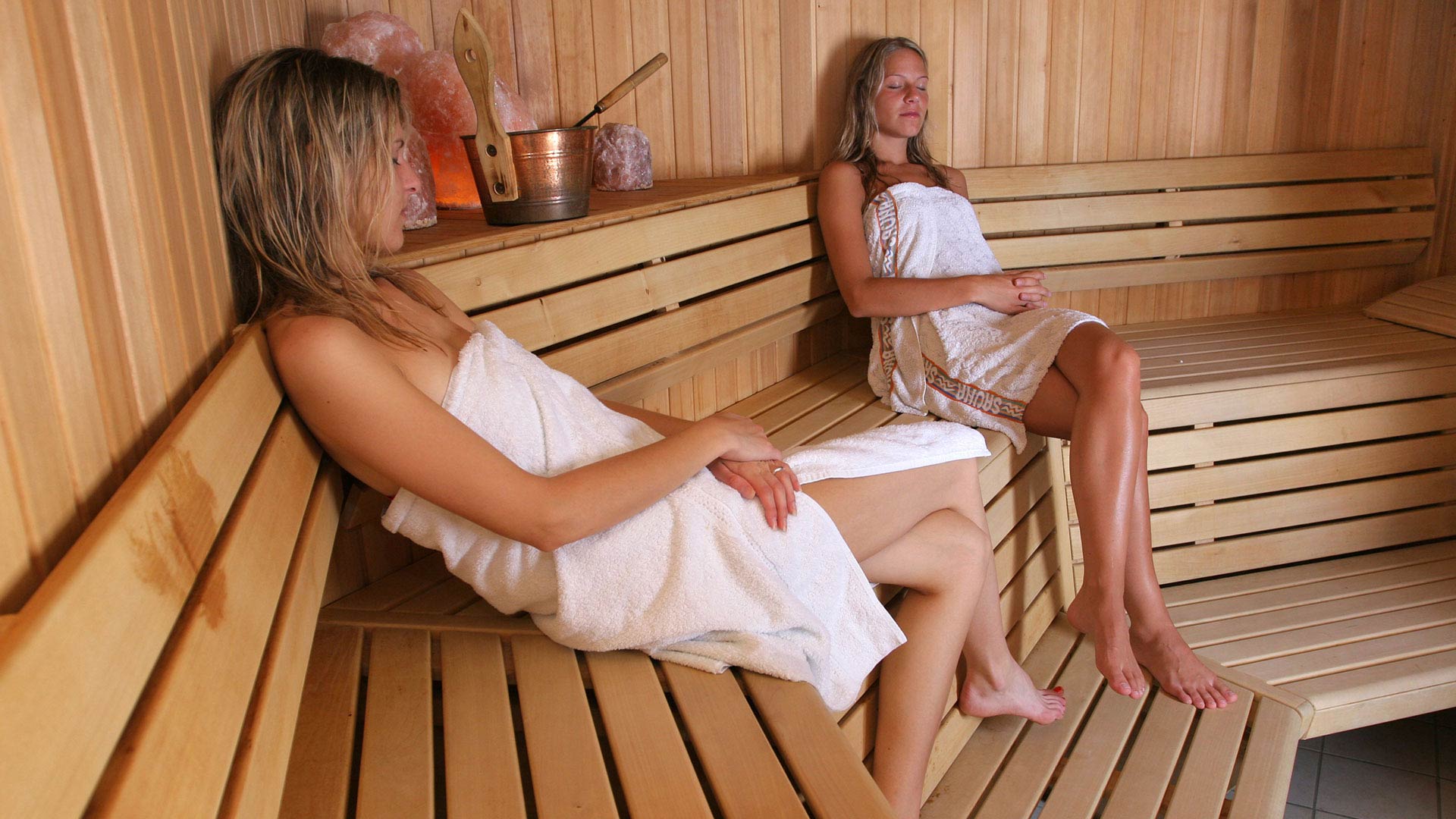
Of course, no trip to Finland would be complete without a visit to one of the country’s many saunas. In the wintertime, Finns love nothing more than stewing a while in their outdoor saunas before taking a refreshing dip in an ice-cold lake.
- Check out these tours including Finland
- Related: Nordic spa and wellness traditions
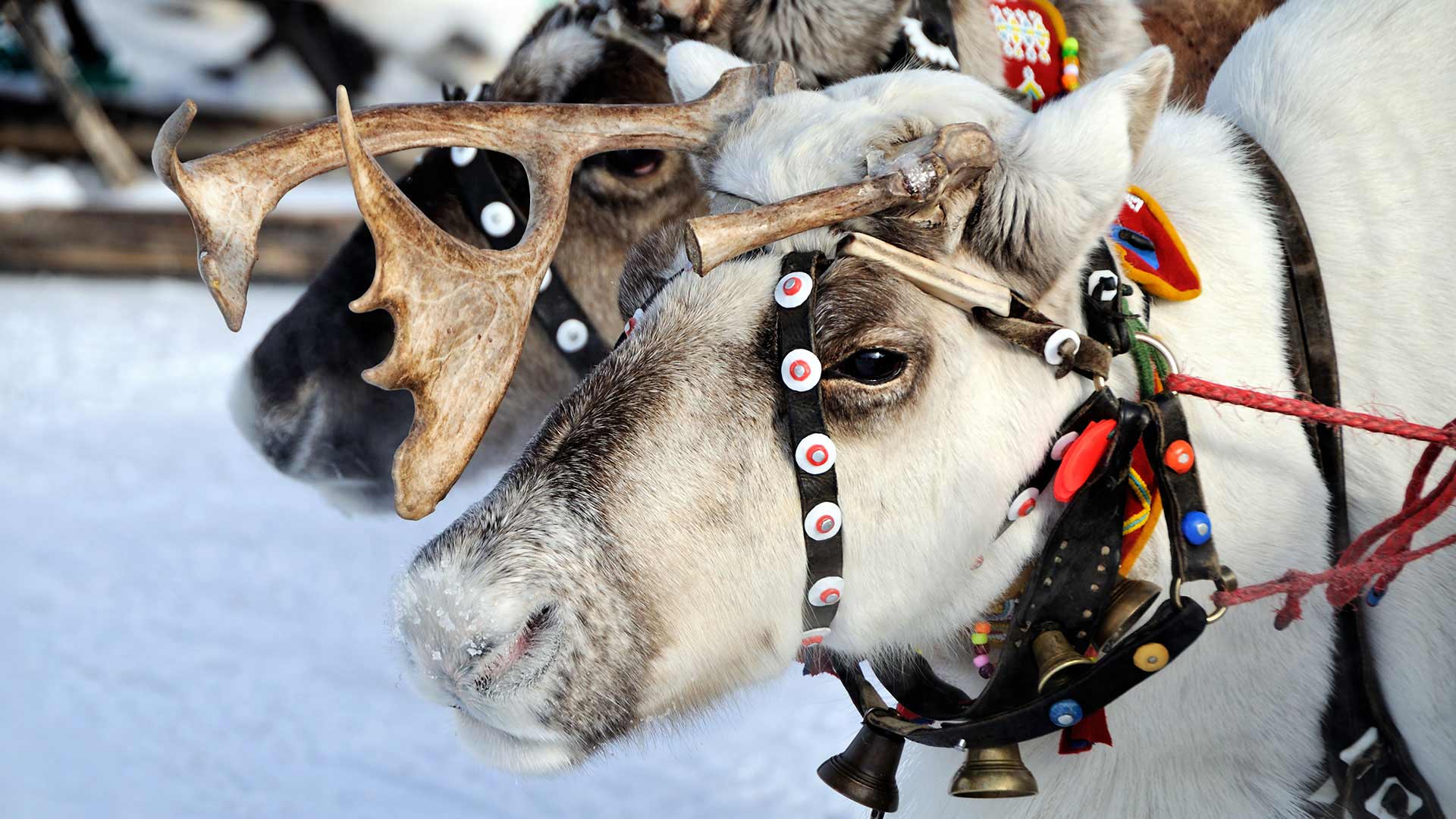
For families, Finland and Sweden combine to offer a winter experience like no other. Journey to Lapland in the far north and visit Santa Claus and his reindeer! If you’ve been extra nice this year, you might even catch a glimpse of the northern lights.
Iceland is impossible to sum up in one sentence, so it’s best that you experience everything this country has to offer for yourself.
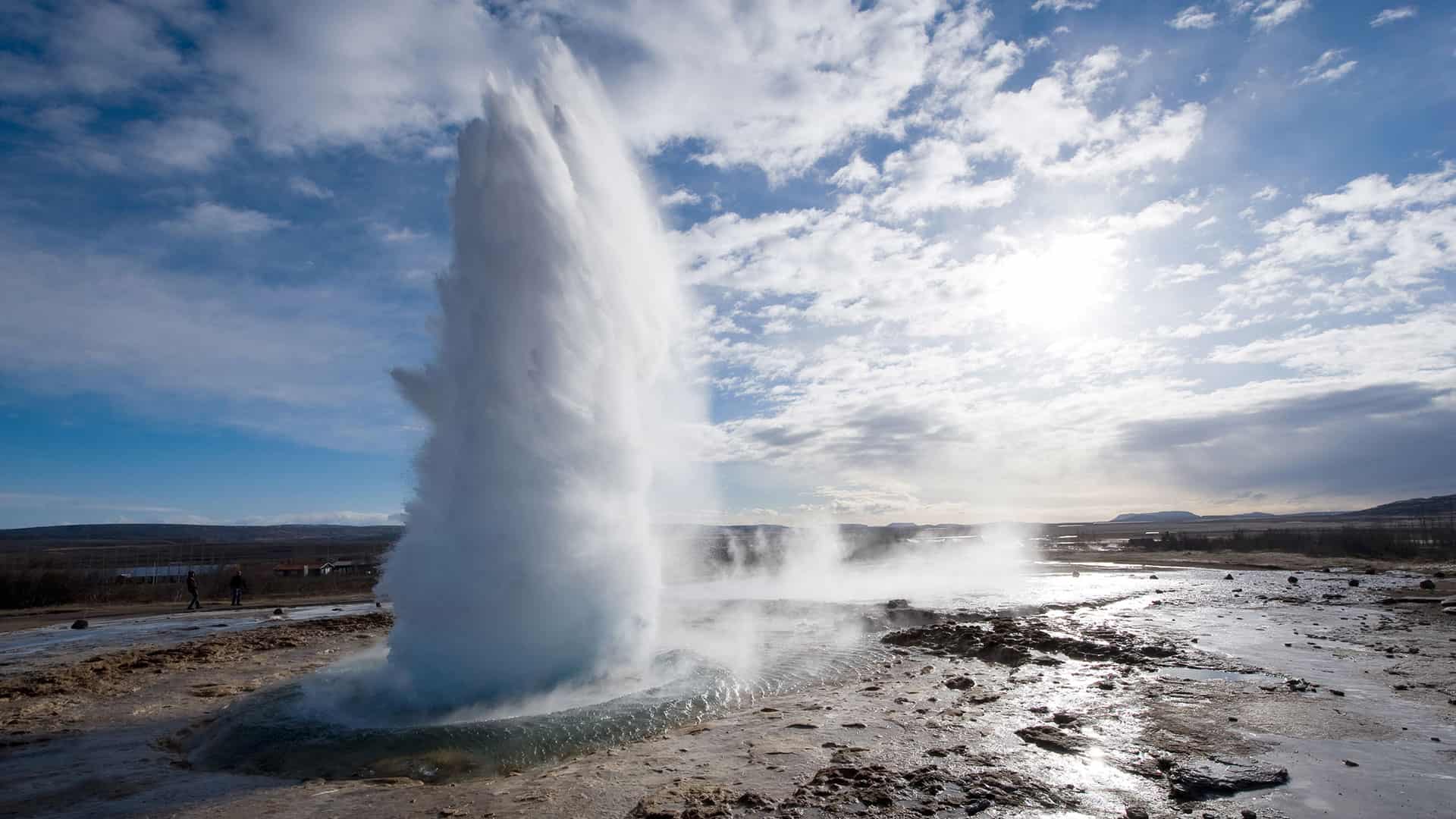
This geothermally active island halfway between Europe and North America is a land of many contrasts. Why not try the following on your Iceland trip:
- Visit some of Iceland’s many waterfalls, including Dettifoss , the highest in Europe
- See an active geyser and steam rise out of the ground at Geysir
- Go on a glacier tour or step inside one of the country’s ice caves
- Stop at the Jökulsárlón glacial lagoon and watch icebergs float by
- Bathe in the warm, soothing waters of the Blue Lagoon
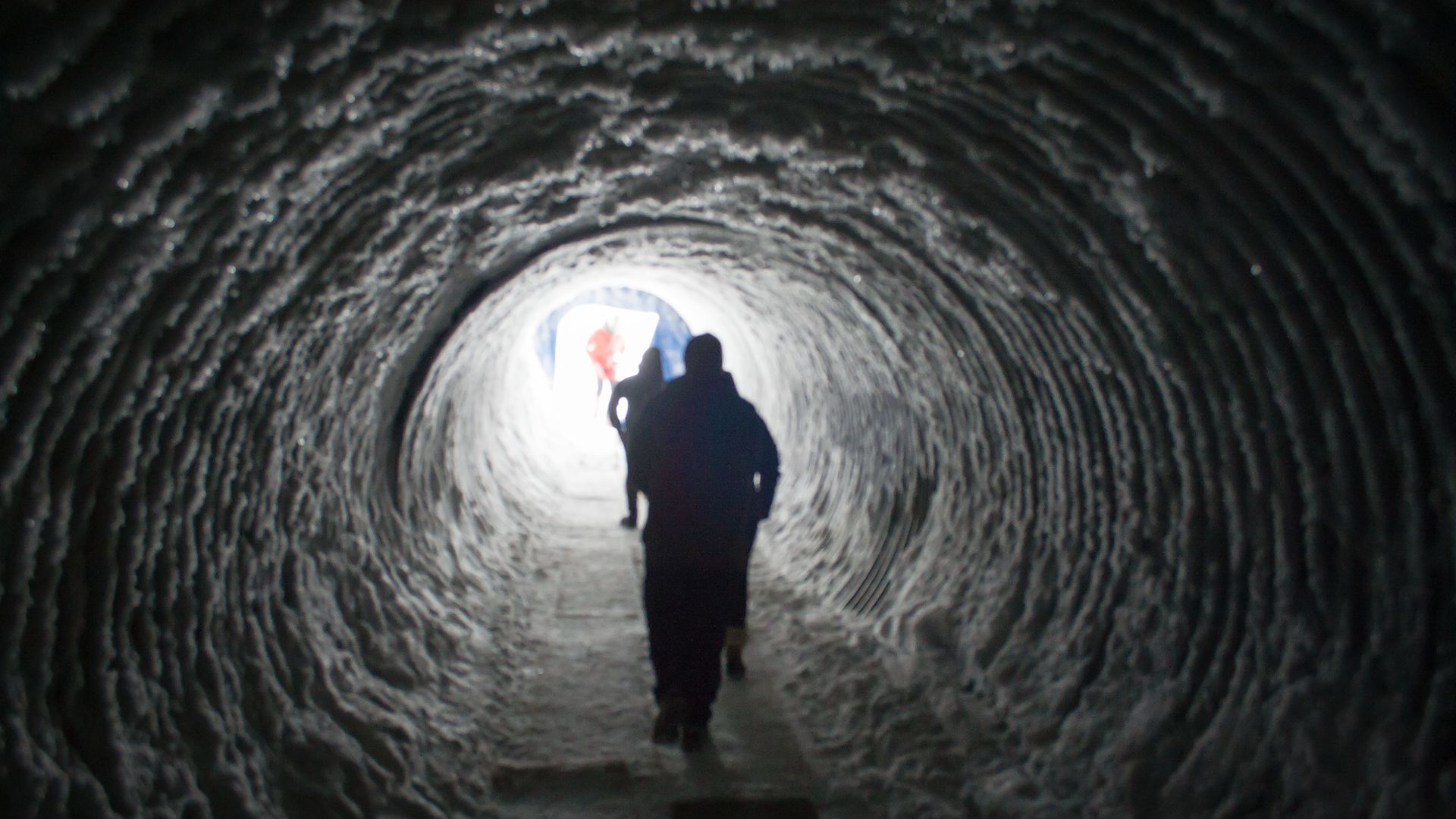
Iceland has something different to offer in every season too. In summer, you can experience the midnight sun and make the most of the long days. Whereas in the winter, you have the chance to chase the northern lights and see the country in its snowy costume.
- Explore these Iceland northern lights tours
- Prefer endless daylight? Browse these Iceland midnight sun tours
- Related: Top 5 northern lights hotels in Iceland
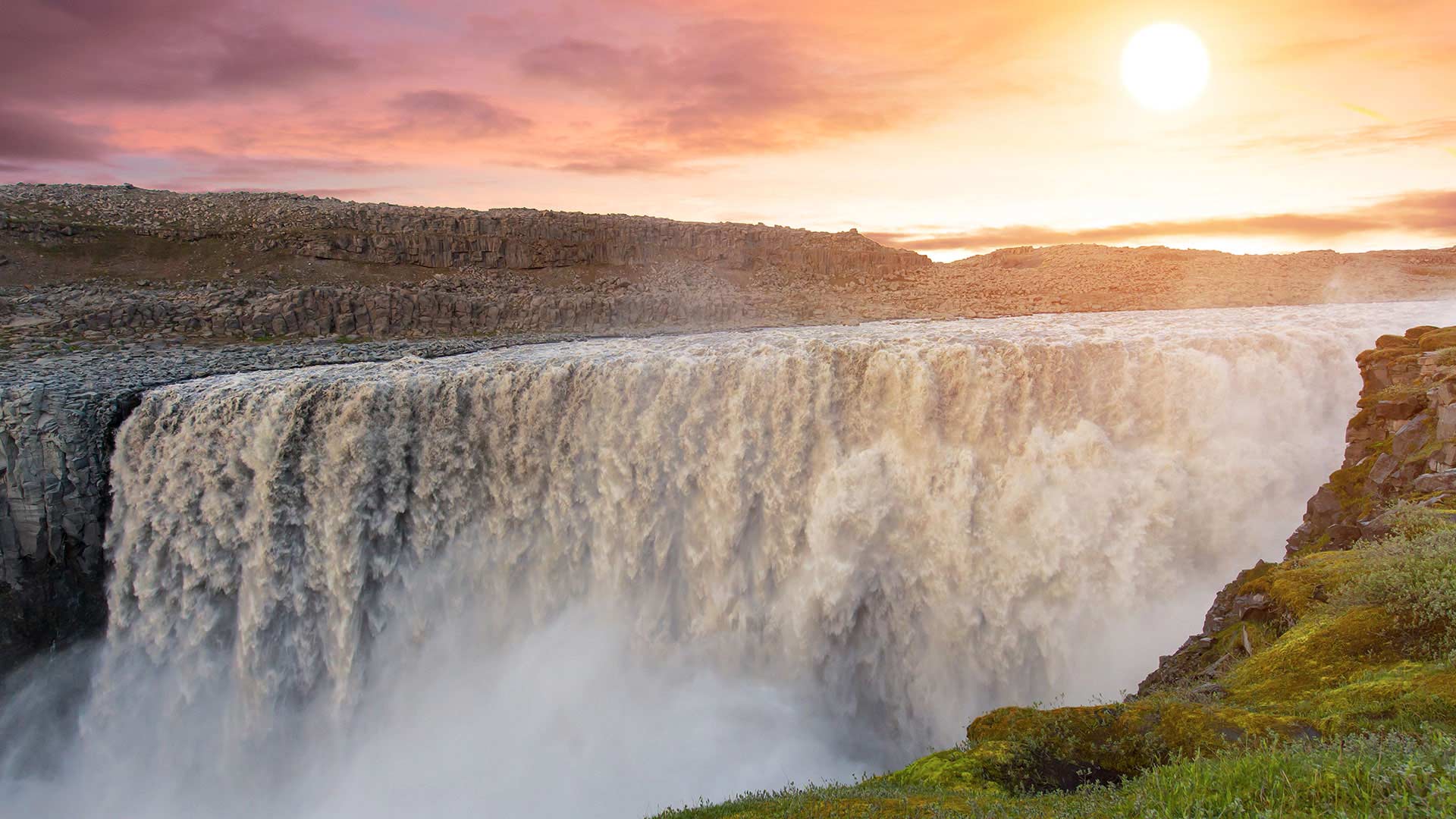
That said, Iceland isn’t just about nature. You’ll find that this nation of 350,000 people punches well above its weight. See an Icelandic band at Harpa , grab a bite at one of Reykjavík’s food halls or enjoy one of the country’s many cultural festivals .
Icelandic fish is incredibly pure and fresh and a must-try for any lover of seafood. Also worth sampling is skyr , a local soft cheese usually eaten like a yoghurt.
- Related: 5 food experiences not to miss in Iceland
If you’re feeling particularly adventurous, you may even wish to sample some of the more unusual local delicacies. These include hákarl (rotten shark), svið (cooked sheep’s head) and harðfiskur (air-dried cod).
Iceland is also known for its language. The Icelanders are revered by their Nordic neighbours for documenting ancient Norse culture in the Sagas of Icelanders. Thanks to these sagas, there is a record of the Vikings’ pagan beliefs and traditions.
When preparing for your trip, why not read one of these sagas in translation? Amongst the most famous and epic are Egils saga and Njáls saga .
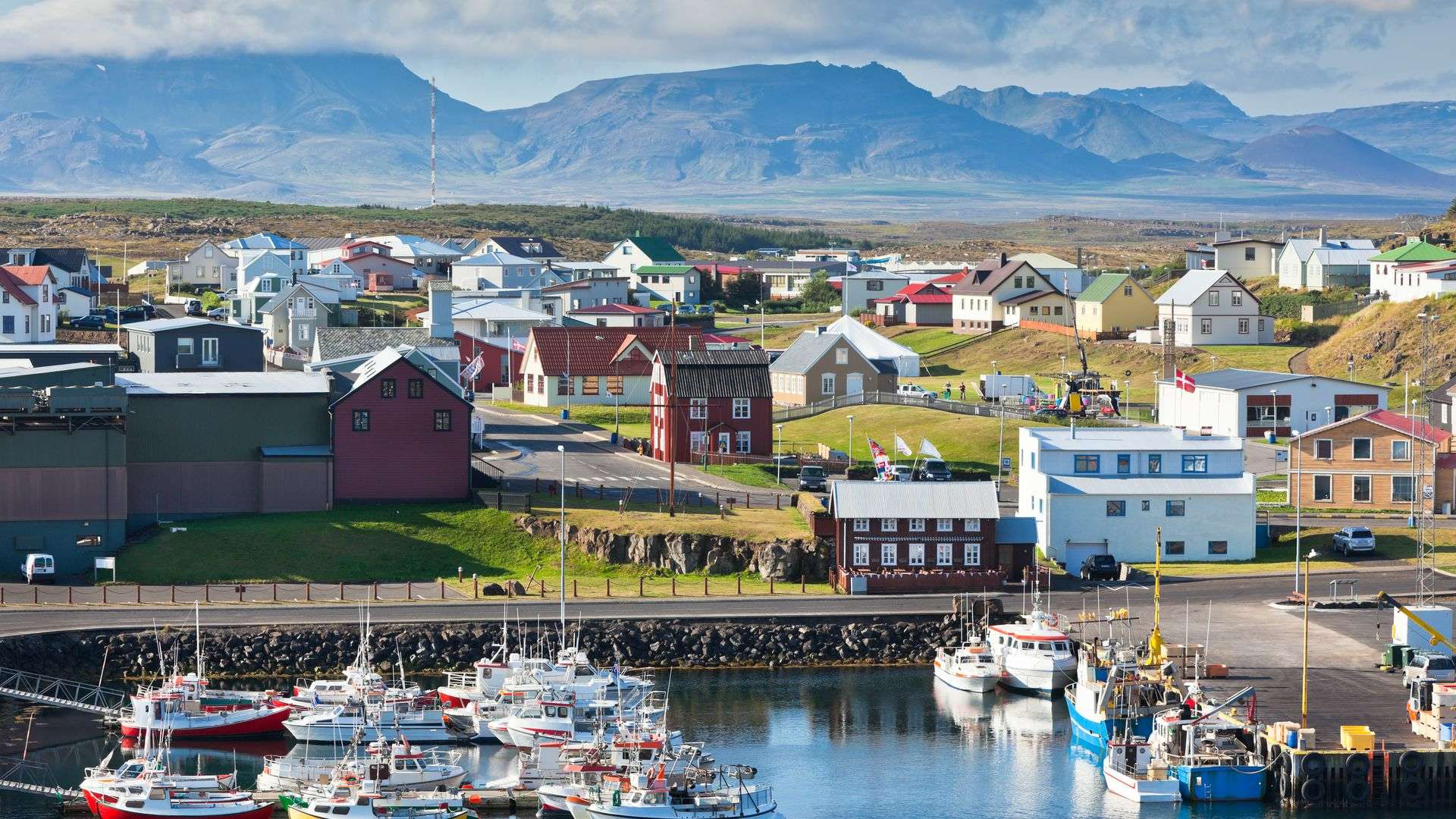
Walk in the shoes of the brave Norwegian settlers that arrived in Iceland in the Viking age. Retrace the steps of the characters featured in the Sagas of Icelanders. In Iceland, you’ll feel history come to life.
- Go on your own Viking adventure with one of these Iceland self-drive tours
Take in the stunning scenery, studded with majestic mountains, hidden caves and dramatic geothermal features. You’ll easily see why Iceland’s ancient settlers were firm believers in the supernatural.
It’s hard to talk about Norway without slipping into superlatives: everything seems to be the biggest, tallest, longest or deepest. Defined by its relationship with the sea, Norway has the longest coastline in Europe.
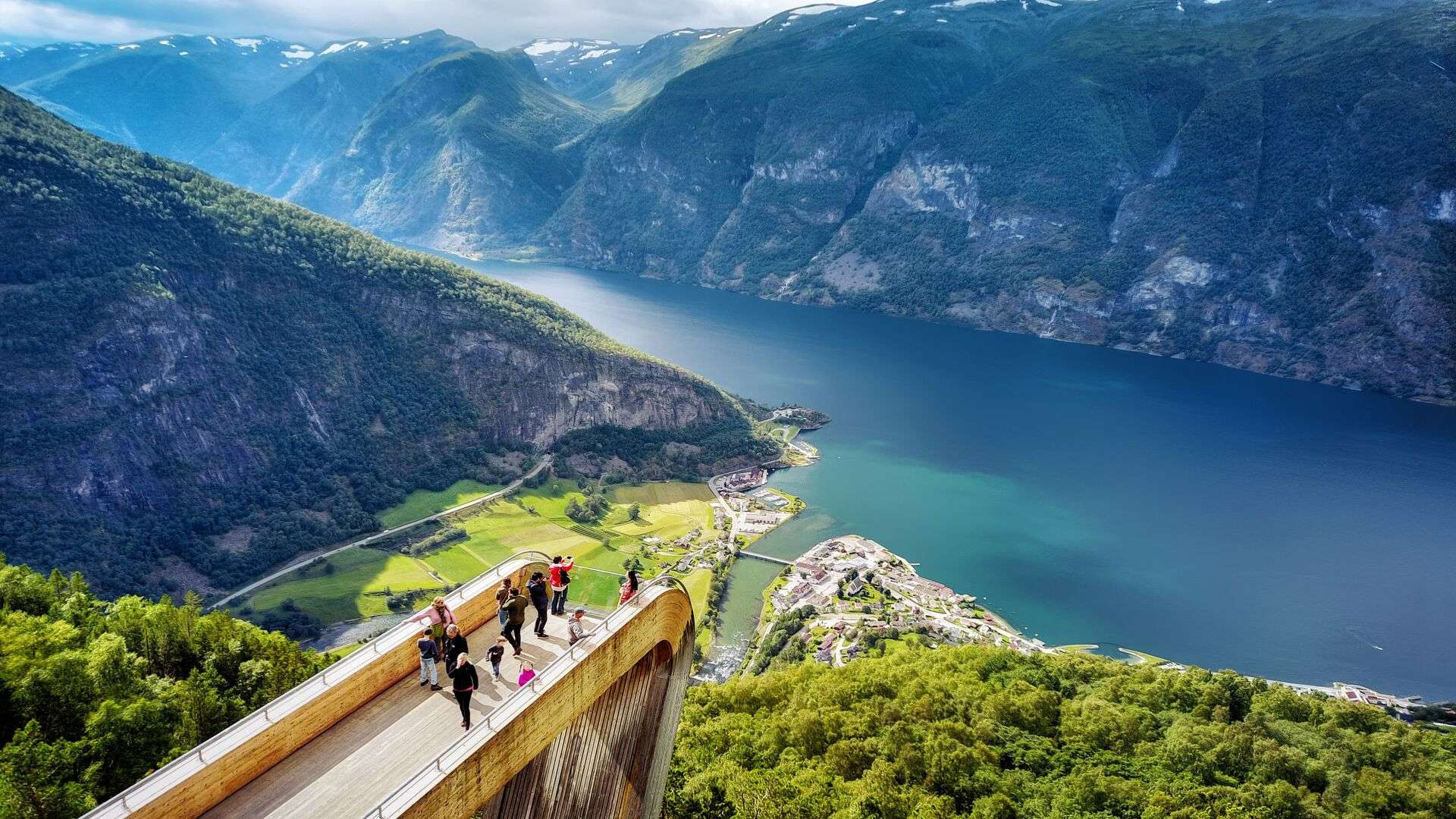
Norway is perhaps best known for its fjords. These deep valleys open to the sea are found all the way up the coast. You’d certainly be missing out if you passed up the opportunity to cruise along one of the country’s most famous fjords, such as the Aurlandsfjord (pictured above) or Geirangerfjord .
- Explore these Norway fjord tours
- Related: Why Bergen is called “the Gateway to Norway’s Fjords”
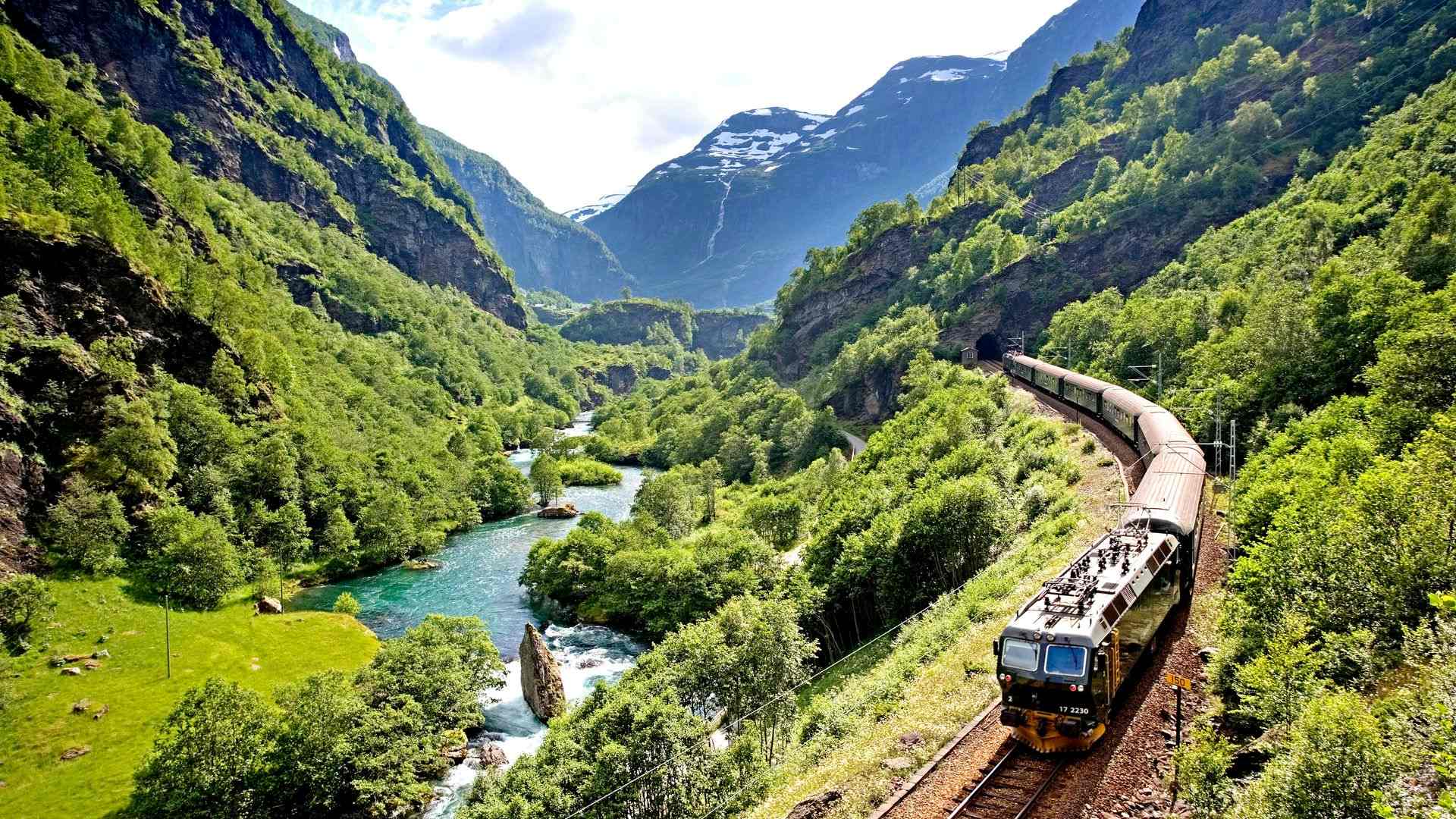
Come to Norway and experience its rich, mountainous landscape via one of the most spectacular railways in the world, Flåmsbana . Then cruise up the coast to the magnificent Lofoten islands , which are stunning in the midnight sun of summer.
- See these Norway cruise and train tours
You can even carry on up to Tromsø , Norway’s northernmost major city. Here you can experience deep winter darkness, northern lights and the indigenous Sámi culture.
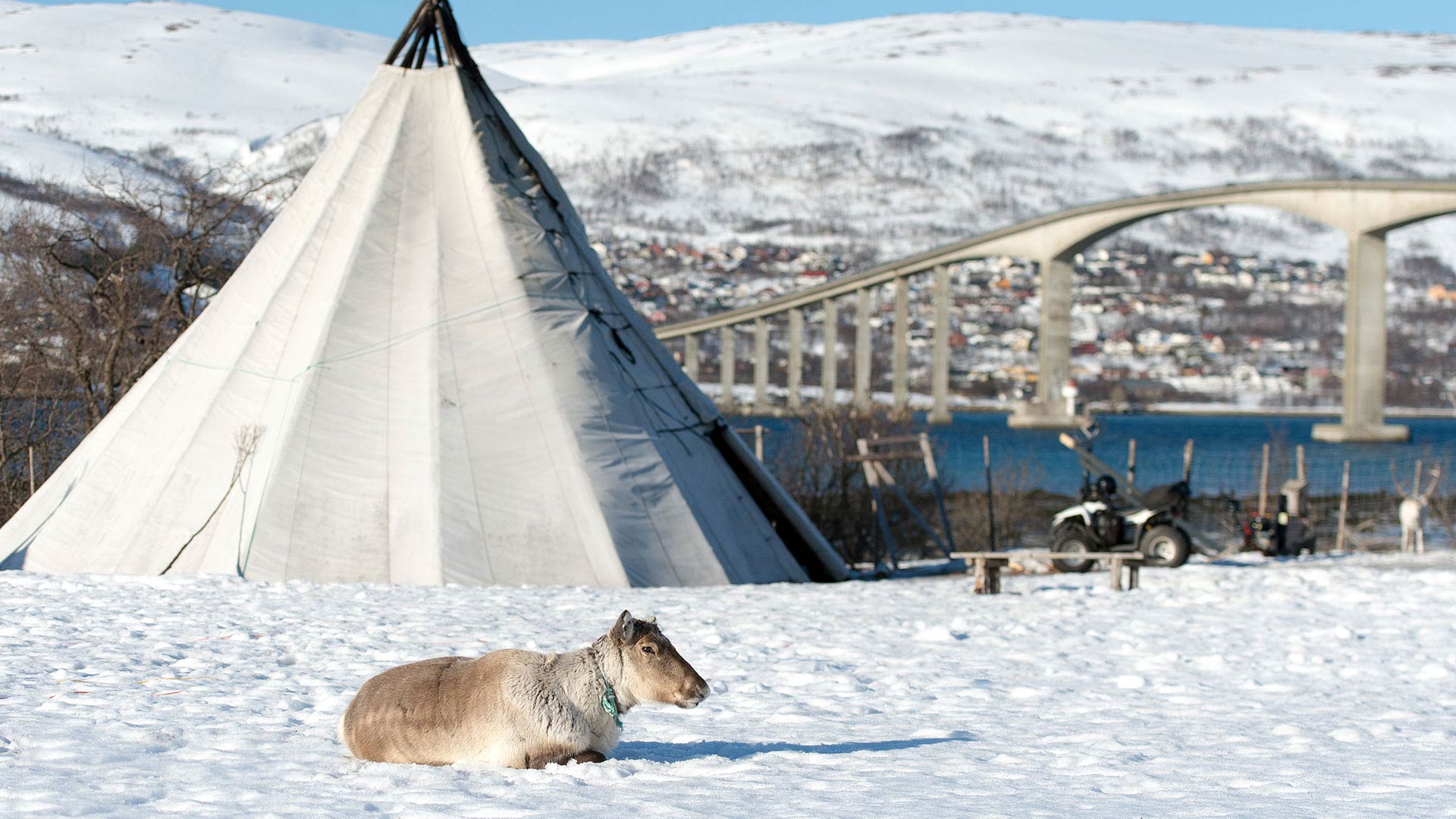
One of Norway’s most famous exports is skiing. In wintertime, you may well see the locals take to their skis as a quick way to dash around town. If you feel like it, why not join in?
Of course, if you’re a more seasoned skier, you can take to one of the country’s many purpose-made slopes. The area around the city of Lillehammer in the southeast offers the best pistes.
- Check out these holidays to Norway
Norway is studded with vibrant cities, from the capital Oslo in the southeast to Bergen and Trondheim further up the west coast. The country is still rural at heart, so even in the larger cities you’ll often feel like you’re in a quaint countryside town.
If you want to blend Nordic nature and cultural experiences, Sweden is an excellent place to visit. It’s home to rich and varied landscapes, including lush forests, incredible islands and Arctic tundra in the far north.
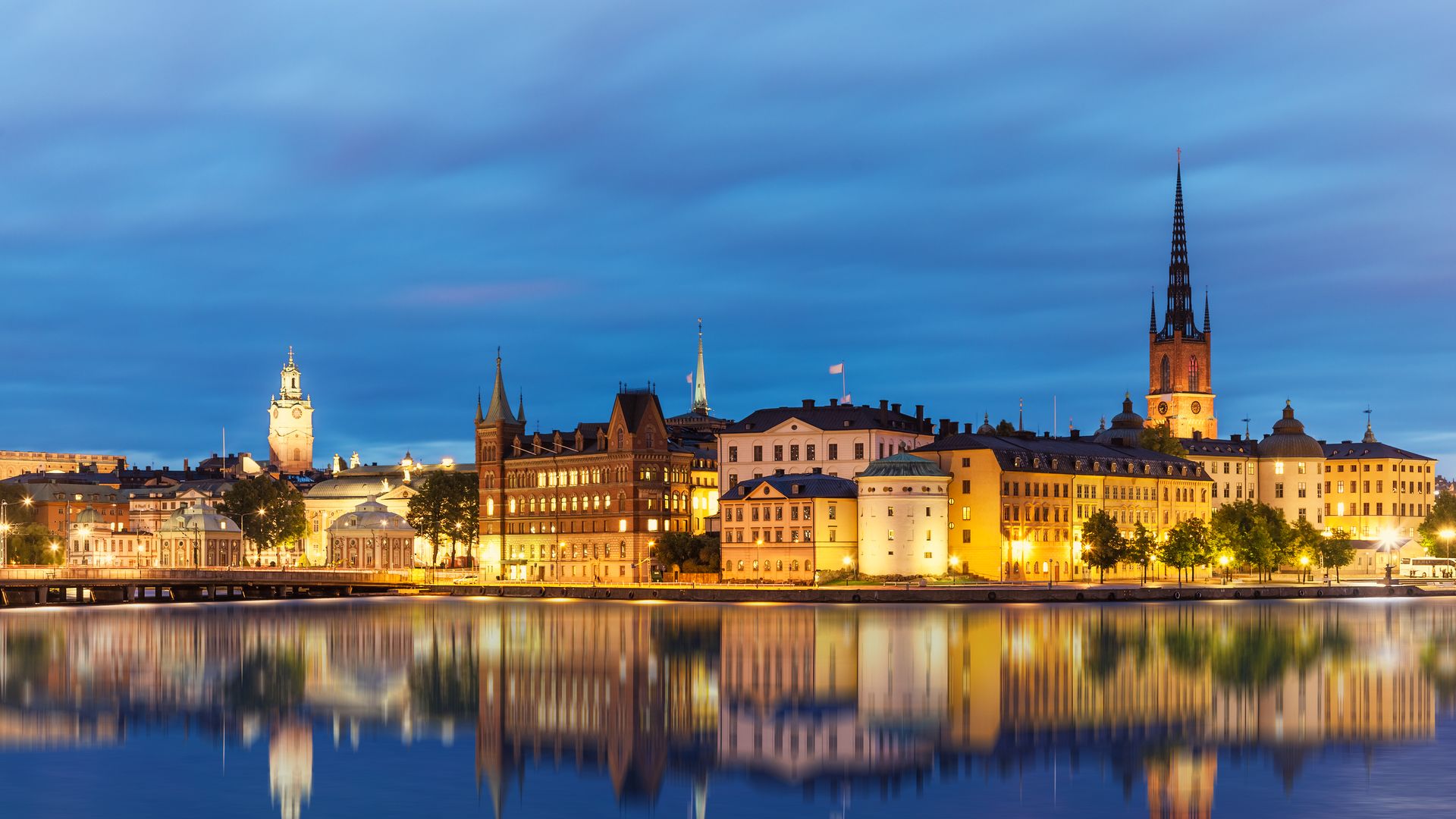
Sweden’s urban areas are also a major attraction. Stockholm is the Nordic countries’ largest city, calling itself “the capital of Scandinavia”. You’ll find plenty of things to see and do in Stockholm , including cool Nordic design, royal palaces and classical architecture in the Gamla Stan area.
Because of this diversity, Sweden is perfect for both laid-back summer holidays and winter escapes. Swedes themselves celebrate the passing seasons with various festivals.
- Delve into these Sweden summer holidays
- Related: Top 10 towns & cities in Sweden to visit
Midsummer Eve is celebrated on 25 June. Confusingly for June, Swedes raise the Maypole and make crowns with local wildflowers. Then they feast on smoked salmon and sip akvavit , the local spirit, singing long into the bright night! Why not join in?
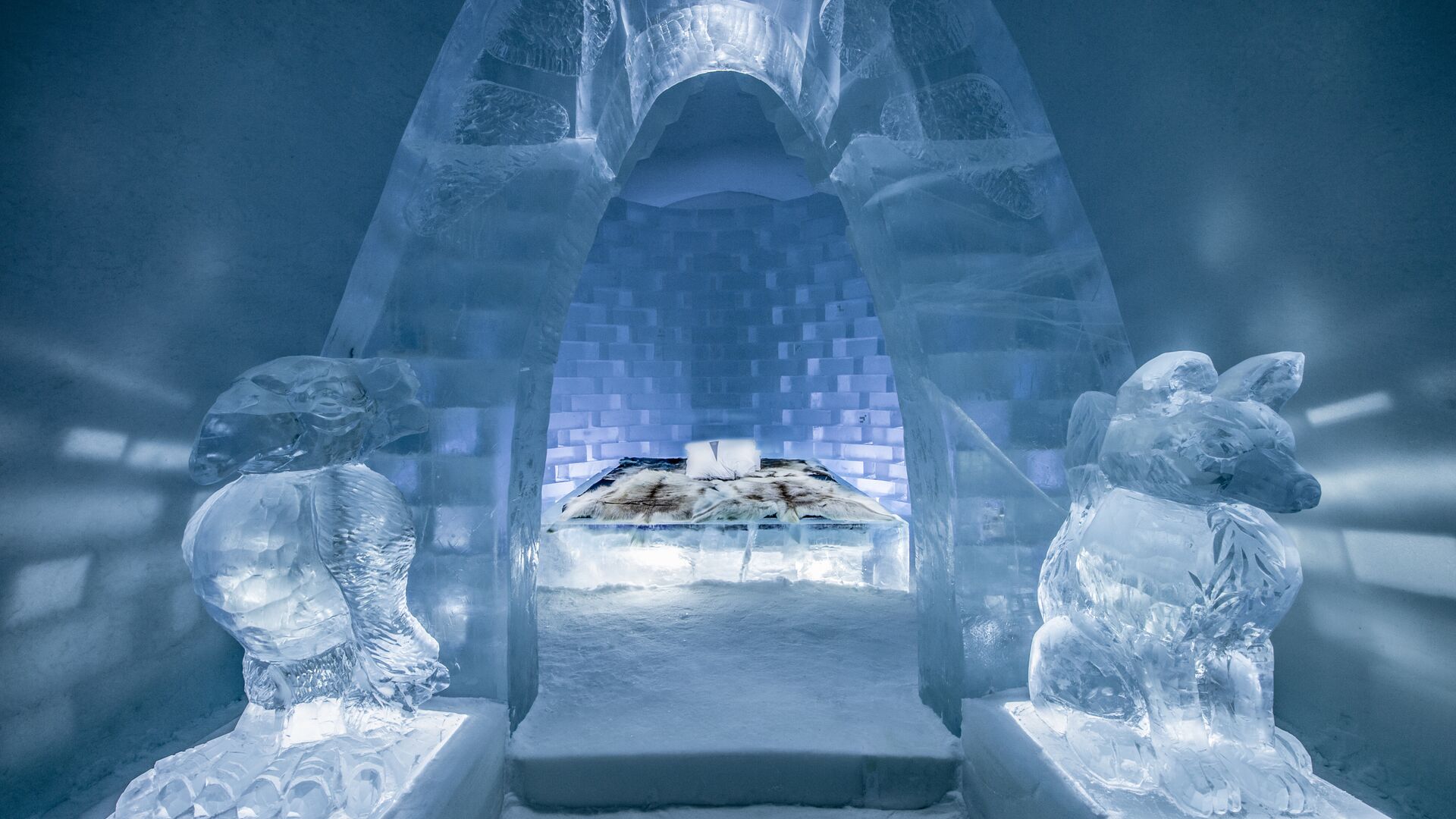
In winter, journey north of the Arctic Circle to Swedish Lapland and stay at the original ICEHOTEL . Here you can also experience indigenous Sámi culture, see reindeer and have the chance to chase the northern lights.
- Explore winter tours in Swedish Lapland
- Related: Christmas in Lapland – Your complete guide
Sweden is famous worldwide for its meatballs, known locally as köttbullar med gräddsås . Try the real thing – they’re definitely a step up from the ones at your local Swedish furniture shop!

Other must-try food experiences include fika , afternoon coffee with cakes or pastries. Sweden has perfected the art of baking irresistible sweet treats. Try the fantastic cinnamon buns (see above) or kladdkaka , a gorgeously gooey chocolate mud cake.
- Related: The Swedish art of fika
Sweden’s excellent transport infrastructure gives you more options for your trip. Be the master of your own journey on a Swedish self-drive tour , or skip the driving and relax on an independent train tour across Sweden .
Remote Nordic regions
The Nordic region is a place of extremes, both east to west and north to south. Find out about ice-covered Greenland, the westernmost Nordic nation. And if you’re a true adventurer, you’ll want to learn more about Svalbard.
Look at a map and you can’t help but notice the scale of Greenland, the world’s largest island. Whilst it’s not really the size of Africa (some maps distort the area of countries), it is a truly vast, unspoilt wilderness.
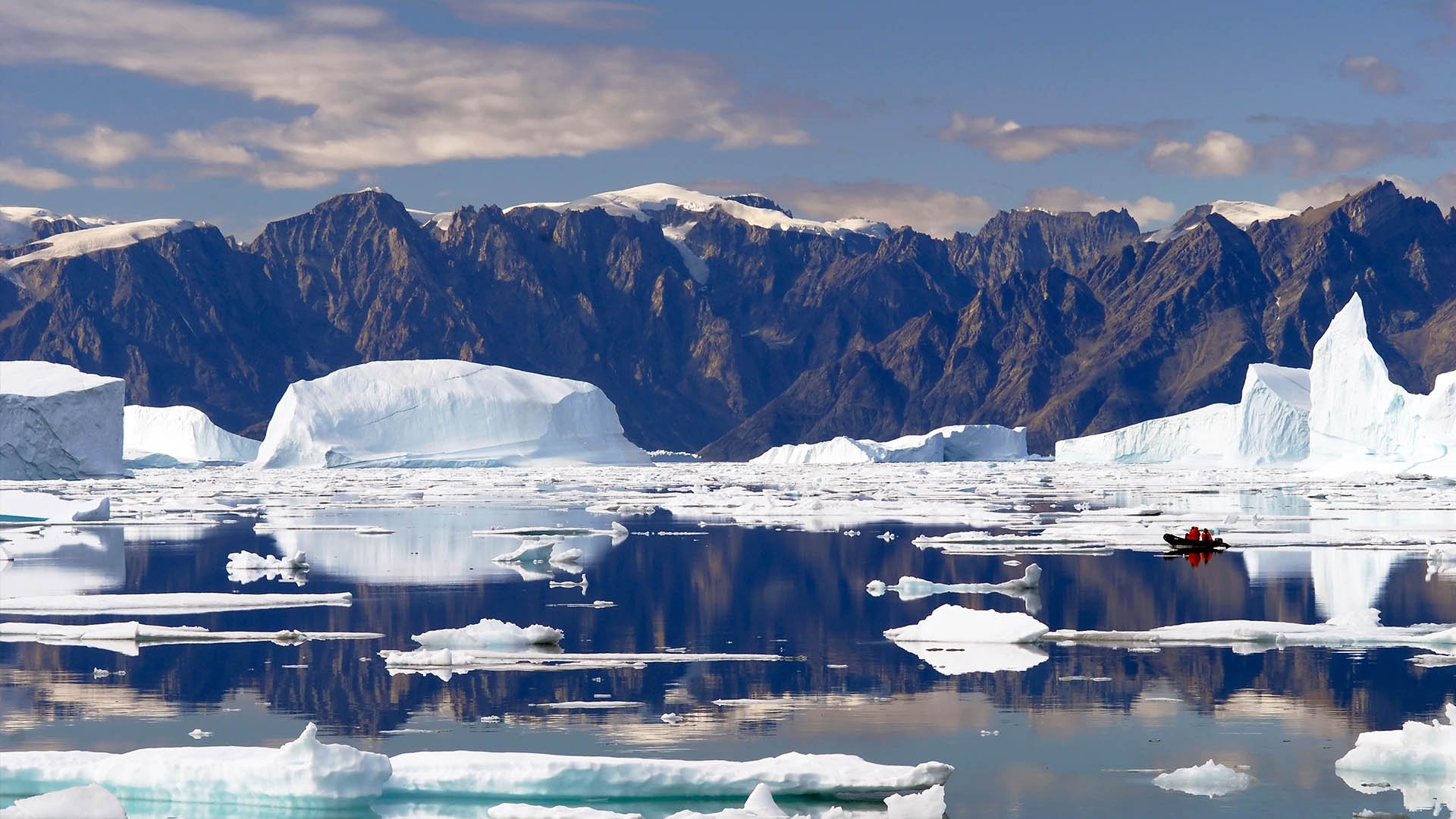
Erik the Red was the first European to discover Greenland in 986. He gave the country its somewhat misleading name, although the warmer medieval climate could explain his choice. He established a Norse settlement at Brattahlíð in the south of the country, which you can still see today.
Viking presence in Greenland lasted a few centuries, but as the climate grew colder once again, the colony failed. The entire island eventually came to be inhabited by Inuit peoples. Their way of life was more suited to the challenging climate.
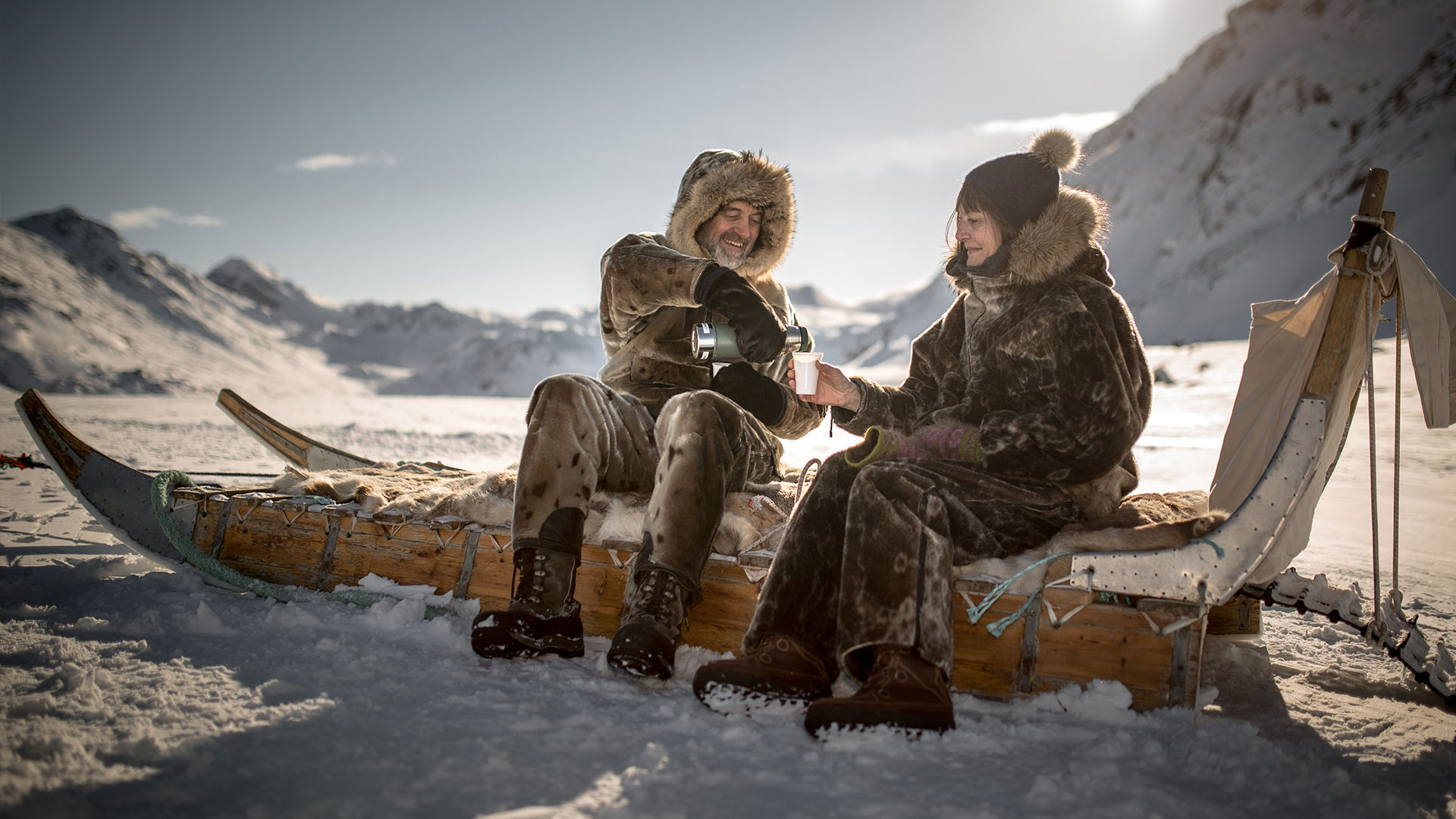
Today Inuit Greenlanders make up more than 90% of the population. Related to the other Inuit peoples of North America, they share a similar language and hunting traditions.
- Experience local life on these Inuit culture tours of Greenland
You might be wondering what there is to see in this boundless, never-ending landscape. The massive ice cap, pristine and white, is a sight to behold. Then there are gigantic glaciers, such as the Eqi glacier , that calve icebergs straight into the sea.
Greenland also offers you the chance to experience Inuit culture such as dog sledding. In the evening, sip on a spirit cooled not by an ice cube, but a chunk of pure iceberg.
- See these ice cap tours of Greenland
- Related: Top 10 things to do in Greenland
Amongst Greenland’s natural marvels are animals such as seals, whales and walruses. The best known icon of the country though is undoubtedly the polar bear. This majestic creature decorates the country’s royal coat of arms.
Greenland is a place that stays with you. Its endless Arctic landscape and local Inuit culture combine to offer a very different kind of travel experience.
Way above the Arctic Circle, this remote group of islands marks the northern limit of Norwegian territory. If you’re the adventurous type, a trip to Svalbard offers a plethora of Arctic experiences.
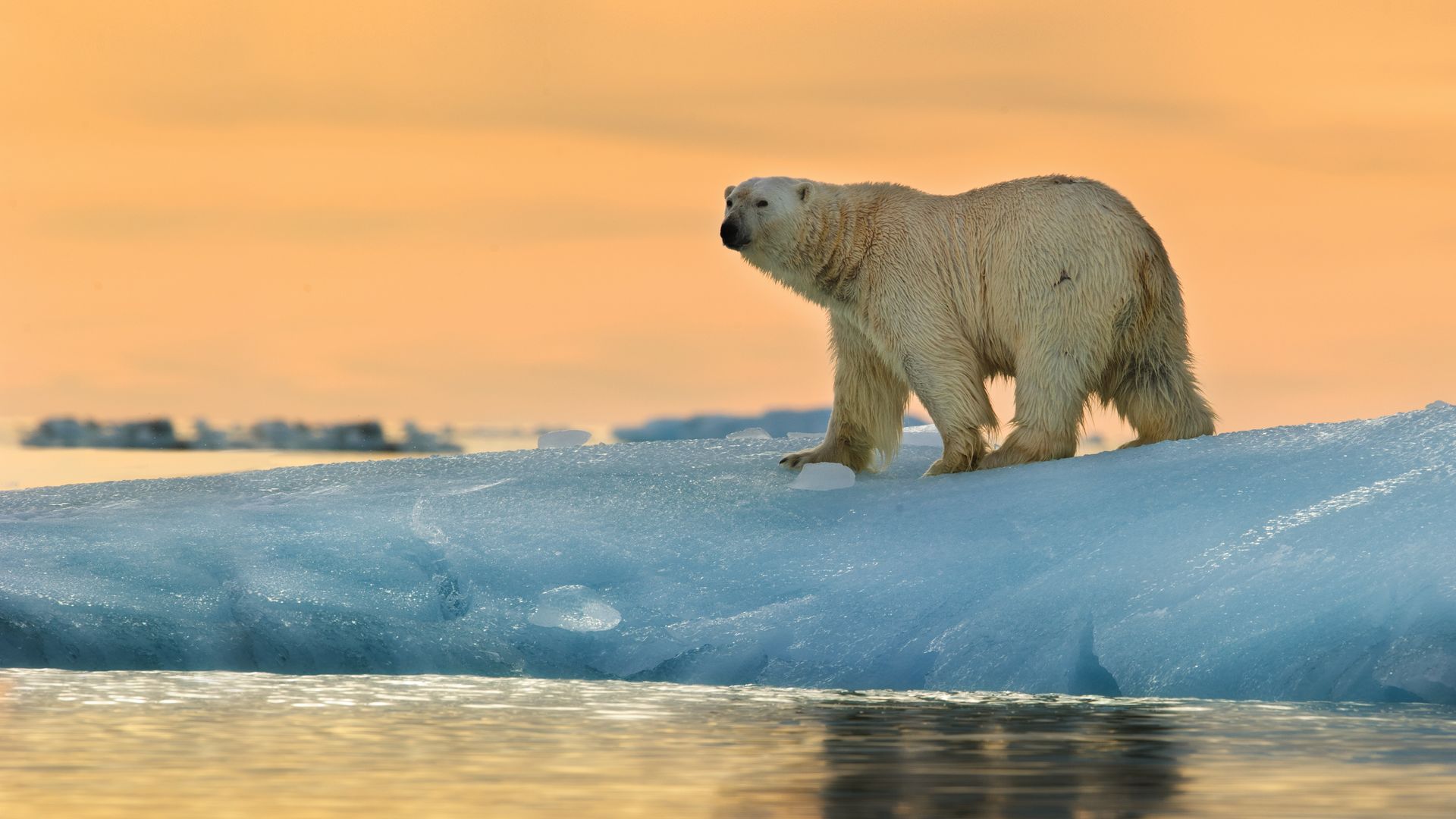
Svalbard’s landscape is dominated by frozen tundra and majestic snow-covered mountains. Seals, walruses, dolphins and whales all swim in the seas around the islands. Meanwhile on land, you have the chance to see 2 iconic local species: the Arctic fox and polar bear.
- Related: 7 Top things to do in Svalbard
The unusual history of Svalbard means it has a unique status. The islands were only officially made part of Norway in 1920. Since then, they have seen tradesmen and industrialists from all over the world set up shop thanks to the Svalbard Treaty.
You can still see signs of Svalbard’s Russian legacy – including a Russian Orthodox church and Lenin statue – in the town of Barentsburg. In Longyearbyen, the largest town and capital, Norwegian culture is predominant.
Longyearbyen is located on Spitsbergen , Svalbard’s largest island. The town is home to all of Svalbard’s main facilities and cultural attractions, including the Svalbard Museum and Huset restaurant.
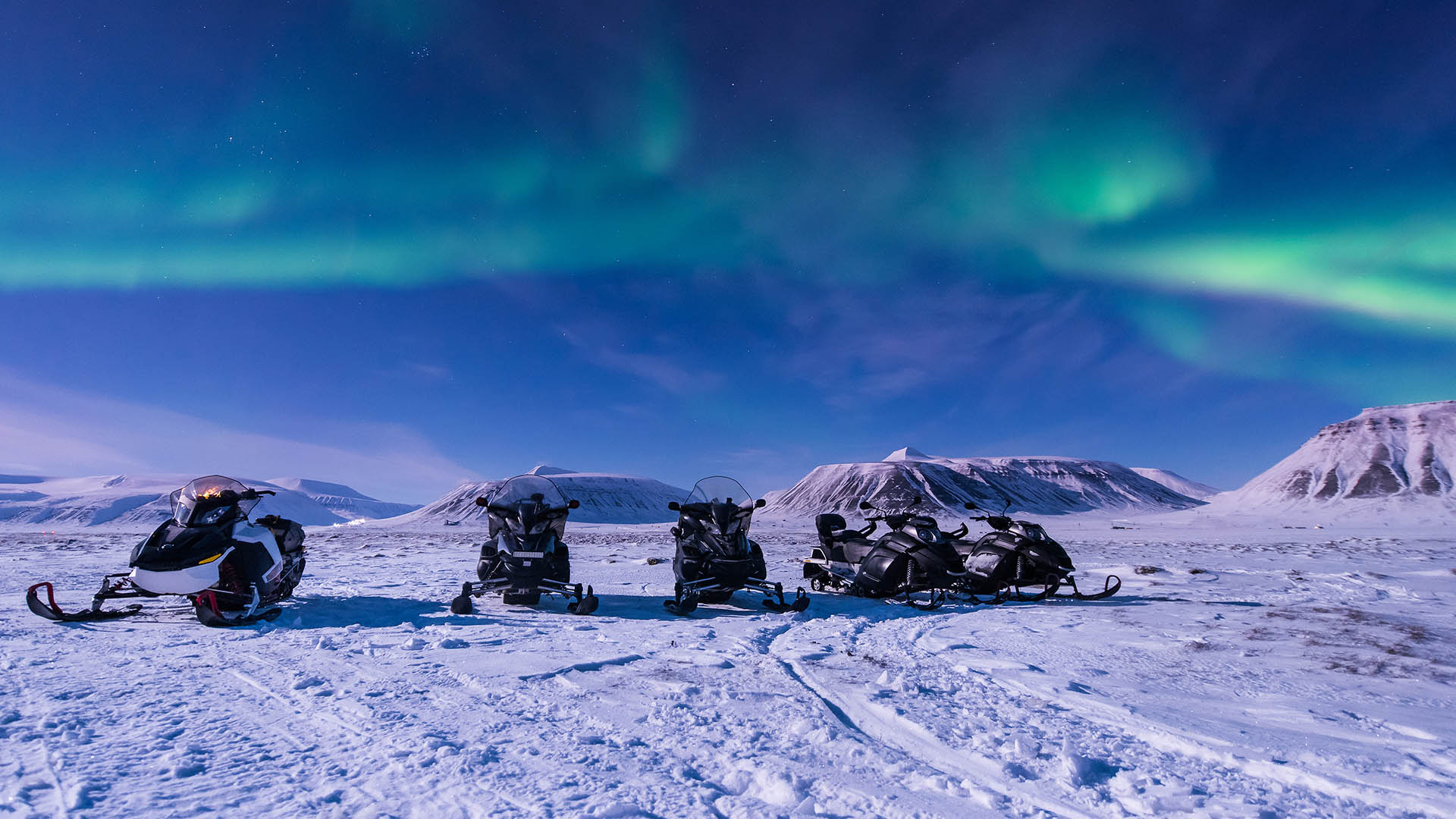
Once you’ve seen Longyearbyen, why not set off on a snowmobile adventure to Isfjord Radio ? After that, you can join a dog-sledding expedition and get right into the wilderness of Svalbard.
The Nordic countries are a remarkable group of nations to visit. Whether it’s unspoilt nature, fantastic food or interesting culture you’re after, you’re bound to find something to suit you.
What’s more, there are lots of different ways to travel around and discover the Nordic region. You can visit them one at a time, or combine them all into one trip. Explore our multi-destination tours to see your options.
This safe part of the world is perfect for road trips. A self-drive tour means you can go wherever you like, at your own pace. We can set up your itinerary, so all you need to do is choose your soundtrack and enjoy!
If you prefer to skip the driving, why not go by train and cruise ? Scandinavia offers some of the most awe-inspiring rail routes anywhere in the world. And a coastal cruise allows you to reach far above the Arctic Circle for a truly unique adventure.
Guided small group tours are a great option if you’d like to meet like-minded travellers and you don’t want to drive. Or if you prefer to travel in a group of your own, you can opt for an exclusive privately guided tour .
Nordic Visitor gives you the flexibility to travel in any of these ways. Browse our dozens of itineraries to find one that suits your tastes, or contact one of our travel consultants to tailor your trip.

After a stint studying and working in Iceland, Max made his nest in Scotland. Whilst he’s left Iceland, the country hasn’t quite left him. When he’s not writing about his favourite places or visiting them, you’ll find him in the kitchen, at the pool or on a skateboard.
Getting there
We'd love to give you the same amazing travel experiences as you read about in our blog! To visit the destinations and attractions mentioned in this post - and to discover a few new highlights along the way - check out these recommended Nordic Visitor tours.
BEST OF SCANDINAVIA - NORWAY CRUISE & ICELAND - WINTER
- USD ($)
- CAD ($)
- AUD ($)
SCANDINAVIAN ROAD TRIP
The nordic countries complete, from vikings to icebergs, related posts, 2 week road trips through scandinavia: your guide.
Blogs , Nordic , Iceland , Northern Lights , Scandinavia , Lapland , Sweden , Norway , Greenland , Svalbard , Finland , Denmark
Scandinavia in Winter: What to Do & Where to Go
Best times & places to see the northern lights in europe, best nordic countries & places to visit.
Check out the best seasons for the Nordic countries
Visit Rovaniemi / Rovaniemi Tourism & Marketing Ltd
When to visit the Nordic countries
This guide gives you the best tips when visiting Scandinavia and the Nordic countries and the best places to see.
There's plenty to discover and explore in the Nordic countries, which are stunning year-round.
Experience unique Nordic nature, beautiful sandy beaches , Norwegian fjords and waterfalls, the Northern Lights , modern cities and much more.
Best time for the Nordic countries
Scandinavia and all Nordic countries have four seasons, where you can participate in many activities, tours, and attractions. Outdoor activities are part of the Nordic lifestyle, and you find many different kinds of outdoor things in the Nordics.
- Nordic popular outdoor activities
- Scandinavia Travel Guide
Spring is lovely with blooming flowers, and Summer with long sunny days where you can swim and visit one of the many music festivals. Fall is also great for hiking trips, and in Winter, you can visit some of the many ski resorts, enjoy indoor “hygge” by the fire, and visit the Christmas markets in Copenhagen.
But the best time to visit depends on what you wish to see and do. In summer, the weather is warmer and more pleasant, and daylight lasts more than 16 hours.
Summer in the Nordic countries
Summer, June, July and August are great times to visit the Nordic countries and the high season in the Nordics. You have long days; in summer, the Sun comes up around 4:00 and sets around 22:30 in most Scandinavia.
In the Arctic region, the sun is above the horizon in the summer months, and you can experience the Midnight Sun where the sun never goes below the horizon.
For travellers, June, July, and August are the most popular months for visiting Nordic countries. Many tourists choose these months because of the pleasant temperatures and the sunny weather.
If you prefer milder weather and less crowded tourist attractions, May or September's shoulder seasons present an appealing alternative. You can get lucky to have good weather for several days in those months.
In spring, summer and fall, you can enjoy activities such as:
- City breaks in the main Nordic cities
- Visit the many Nordic castles and palaces
- Discover the fantastic fjords in Norway
- Visit one of the many Nordic attractions for kids
- Swimming at one of the most beautiful beaches in Denmark
See also: Weather in Scandinavia
When to visit Denmark
You can visit Denmark in any four seasons, but many tourists visit the country in the spring and the summer.
Especially in May, when the days are getting longer, the weather is getting warmer, and there are lots of outdoor activities to do, and all you'll need is a light jacket. If June isn't an option, July, August and September are good alternatives because the weather is still good and not so rainy.
There are lots of outdoor events in Denmark during those months. However, the summer months of July and August are also the time of year in Denmark when you experience the most tourist crowds. The country is also perfect for a biking holiday because of the temperatures and the infrastructure. If you want to go to Denmark to avoid the high travel season, May and September can be viable alternatives when to go to Denmark, and the weather is still mild enough for outdoor activities. Before May and after September is the lower travel time of the year in Denmark, and prices of flights to Denmark and local hotels are lower.
- Highlights in Denmark
When to Visit Sweden
Summer runs from June to August, and Spring from March to May.
Travelling to Sweden in June is an excellent idea to experience outdoor events like Midsummer's Eve and other activities. The weather is quite warm, and you have long hours of daylight. In the northern part of the Nordic region, you find a unique natural phenomenon called the Midnight Sun, and here the sun is not going down under the horizon.
Also, May and July are great alternatives. It can be rainy in May and June, but July is warmer and drier. July and August can also be slightly more expensive than the earlier summer months, so June is still your best bet for when to go to Sweden.
It is highly recommended in late August and September if you're a budget traveller trying to decide when to go to Sweden. The flights to Sweden will be cheaper than during the high season, along with local hotel prices, and during that time, the weather in Sweden is still mild enough for outdoor attractions, although some sights begin to close during September.
Sweden is a great country to visit in the winter if you want to go skiing and discover the Northern Lights in Swedish Lapland. See more:
- Top highlights in Sweden
When to visit Norway
Most travellers go to Norway in Spring and Summer, especially in June, July and August. That's the time of the Midnight Sun, so you'll get very long days in southern Norway or even sunshine around the clock in northern Norway , and there are many things to do and places to go in Norway. June and July are also the time for Norway's highest tourism levels, so while all sights and attractions will be open, you will see some tourist crowds. So when should you go to Norway to avoid the high travel season? May and September are lovely alternatives to go to Norway and get lower rates - and the weather in Norway will still be mild enough for outdoor activities and sightseeing. For travellers, the cheapest month in Norway is October. The summer is over, but the ski season hasn't started yet. October can be cold, and many outdoor attractions have begun to close.
Highlights in Norway
When to visit finland.
May through September offer the mildest weather and the highest travel volume. Especially early summer - May and June are pleasant in Finland . When you pick when to go to Finland, remember that the Finnish summer holidays are in July, which equals higher prices. After that, August and September have more annual rainfall. In June, the weather in Finland will be warm, outdoor activities and events are commonplace, and you can witness the Midnight Sun. At the other end of the spectrum are the winter travellers. Finland, in the winter months, offers many kinds of activities. If you want to see the Northern Lights, aim for December. It's a pricey time of year, but Christmas in Finland, with all the snow and the local events, is a great experience. Don't forget to visit Rovaniemi , the Santa Claus Village in Lapland . As a winter sports enthusiast, when to go to Finland is not an issue. You will find many flexible choices between January and March, Finland's coldest months. See more
- Highlights in Finland
When to visit Iceland
The warmest months, June, July, and August, are the best to visit Iceland.
The Spring has plenty of unpredictable weather, but spring can be a delightful time to visit Iceland. The country begins to bloom literally, and the emergence of the long winter and brighter, longer days puts locals in an upbeat mood.
Summer in Iceland is peak season. Use Reykjavík as the base for explorations or stay in one of many locations around the countryside. Summer is delightful; the sun barely sets, and enjoy the natural phenomenon of the Midnigh t Sun. You'll have the slightest chance of rain during June, and the weather in Iceland stays mild until late August. Come mid-September, though, almost all of the summer activities will be closed until May of the following year. The colder part of the year is also when flight prices to Iceland fall drastically, and suddenly, the local hotels cut their prices by more than half. Budget travellers wondering when to go to Iceland should aim for February or March. They have more daylight than in the earlier winter months. See more:
- Highlights in Iceland
When to visit Greenland
Greenland falls within the Arctic Circle . In winter, in the Polar darkness, the people there don’t see the sun for three months. This necessarily means no light reaches there in the Arctic region in Greenland . No one enjoys as much sunlight during the summer as Greenland. Even though the summer is precisely hot, per se, it’s enough to give you a good tan on your face. Greenland shares its season cycle with the Arctic.
There are two weather cycles in Greenland, and summer and winter are so different that your experience will vary greatly, in combination with the season when you visit Greenland. The travel season is spread over the summer, winter, and spring. Another important thing is to consider the purposes of your visit. Do you go to Greenland to see the Northern Lights and want to try dog-sledging - October-March is the time to go there.
The high season is between May and September because that’s when the winter ice starts to melt, which gives many exciting options like skiing, boating rides, trips to see the glacier, and some extraordinary polar wildlife like whale watching and experiencing the midnight sun . The amazing Midnight Sun can be explored during the Arctic summertime. Being part of a 24-hour Midnight Sun experience here in the most beautiful natural surroundings in the world is unforgettable.
- Highlights in Greenland
Visit the most beautiful natural sites in the Nordic countries
Top Nordic Experiences
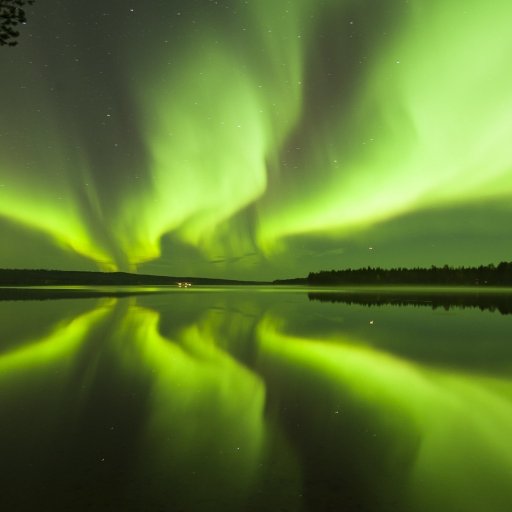

The Ultimate Northern Light Guide
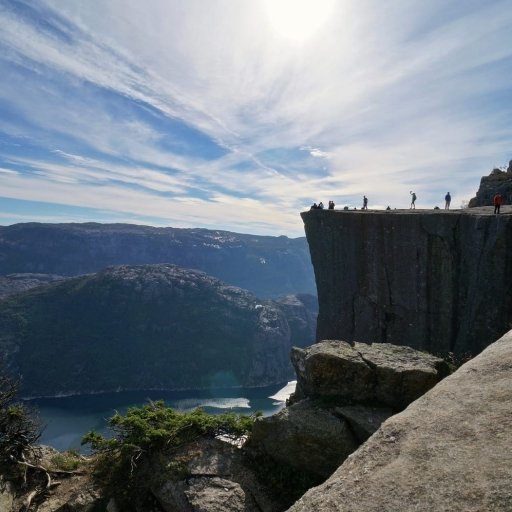
Norway Fjords
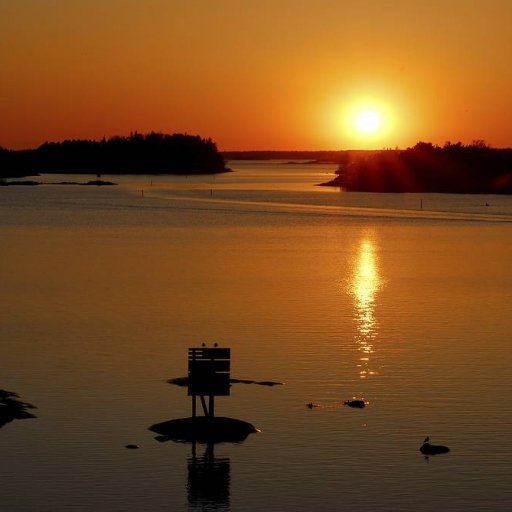
Midnight Sun in the Nordic Countries
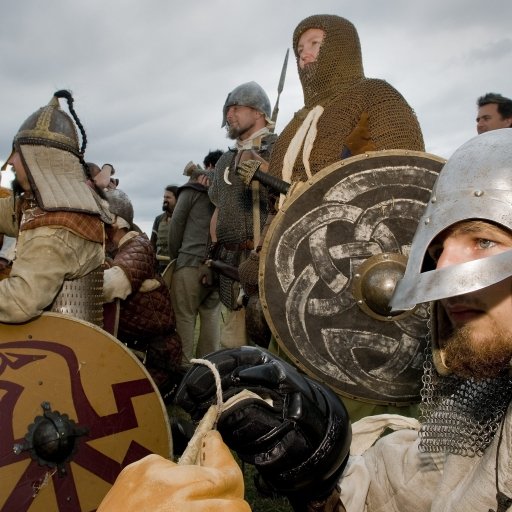
Scandinavian Vikings
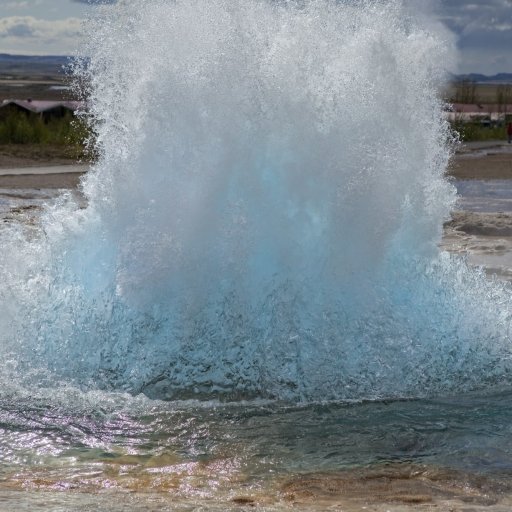
Geysir & Strokkur

New Nordic Cuisine
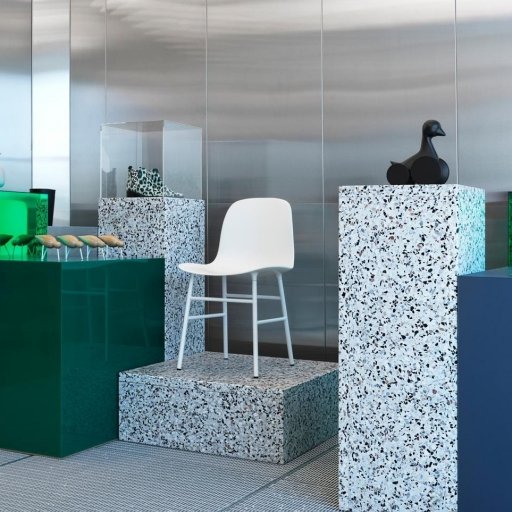
Nordic Design
Popular nordic activities.
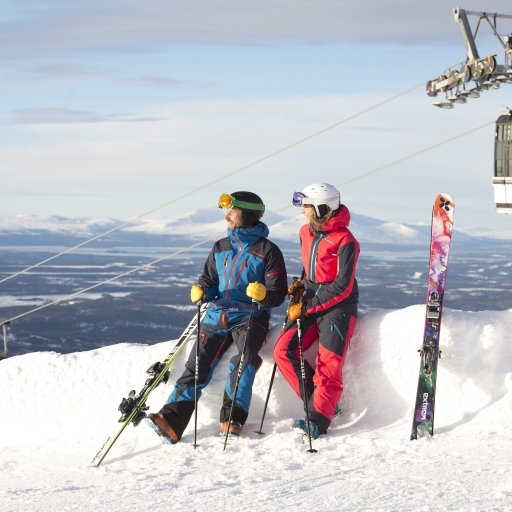
Popular Outdoor Activities in Sweden
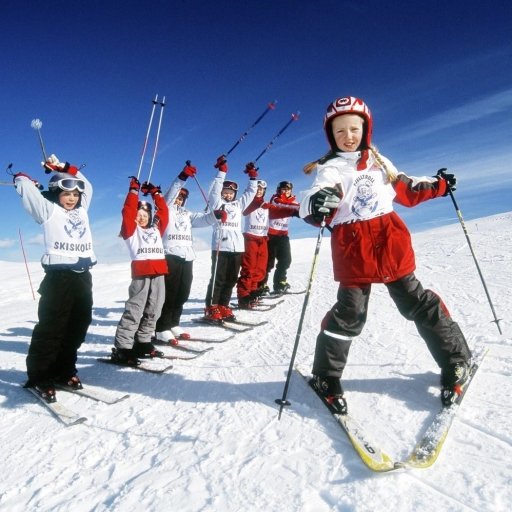
Popular Outdoor Activities in Norway
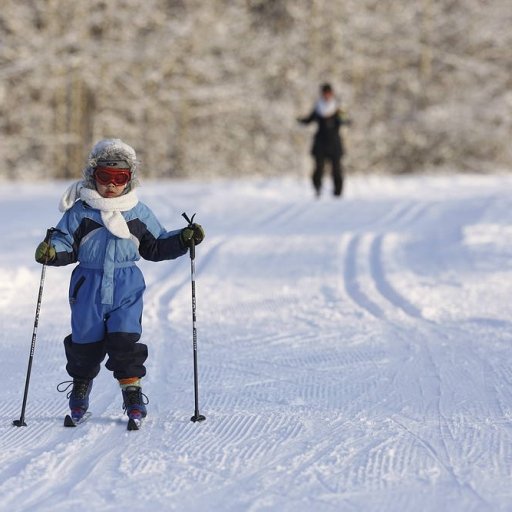
Popular Outdoor Activities in Finland
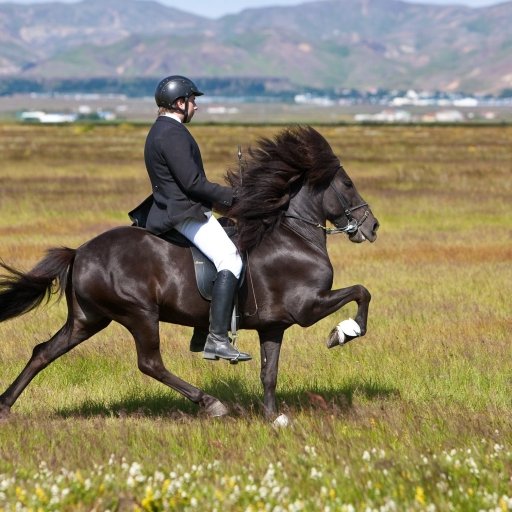
Popular Outdoor Activities in Iceland
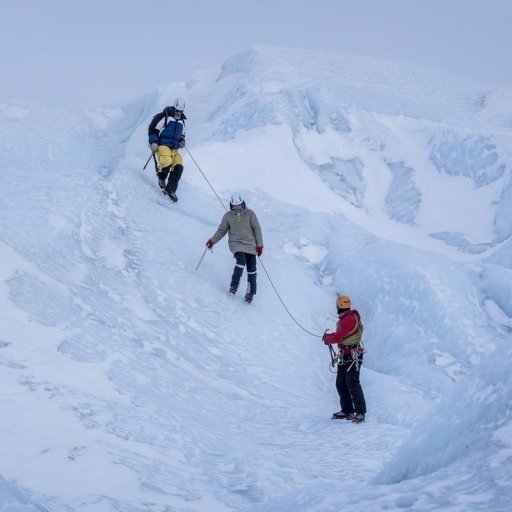
Outdoor Activities in Greenland
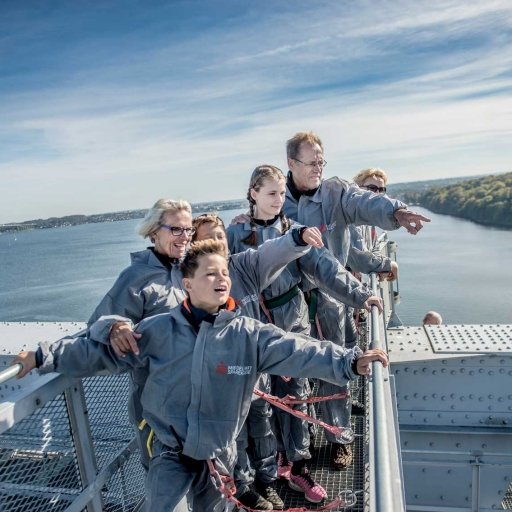
Outdoor Activities in Denmark
Nordic travel guide.
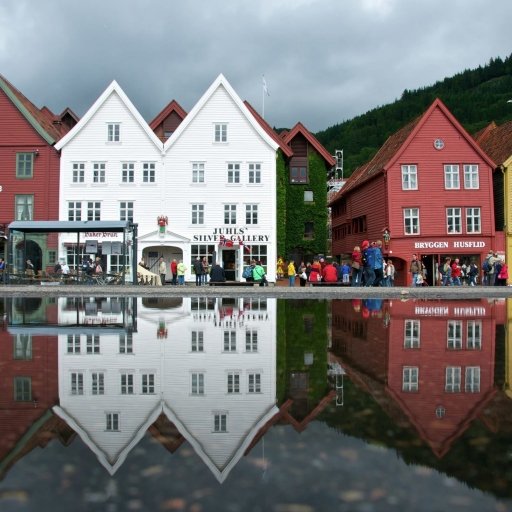
Reasons to Visit Norway
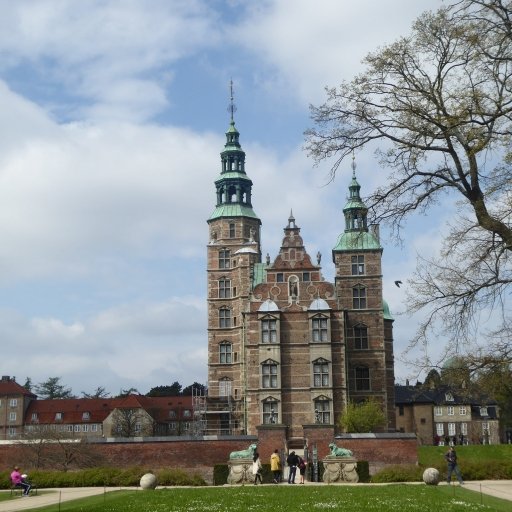
12 Reasons to Visit Denmark
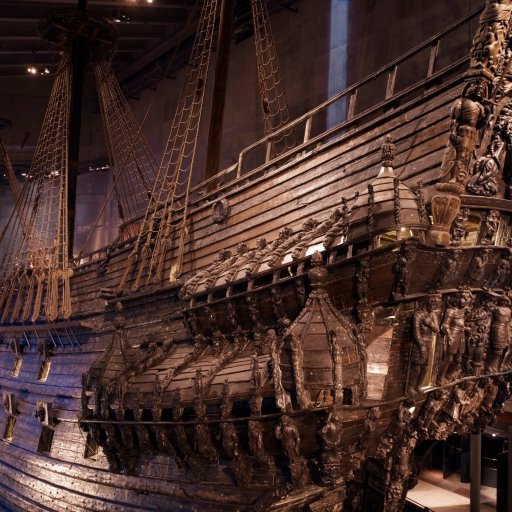
Reasons to Visit Sweden
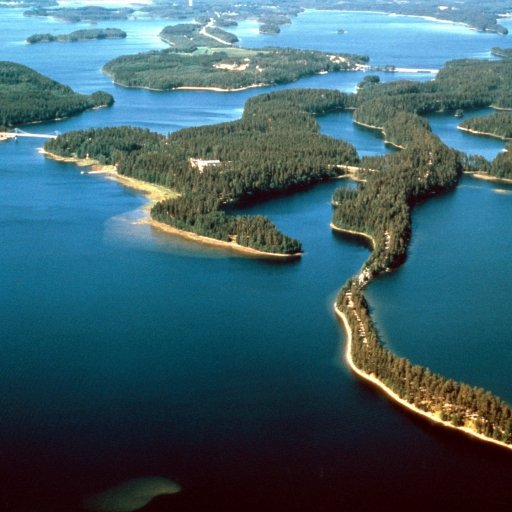
Reasons to Visit Finland
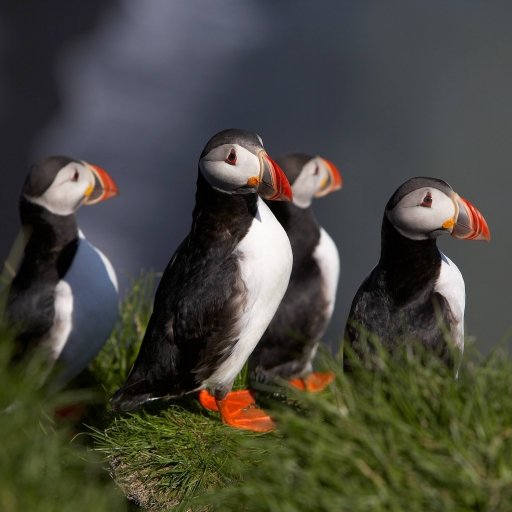
Reasons to Visit Iceland
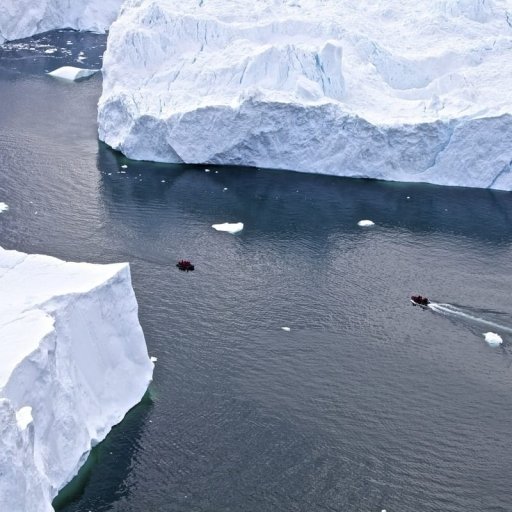
Reasons to Visit Greenland
Norway travel guide.
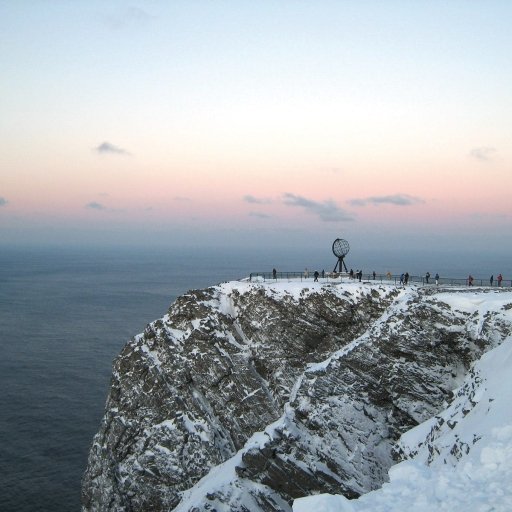
Most popular attractions in Norway
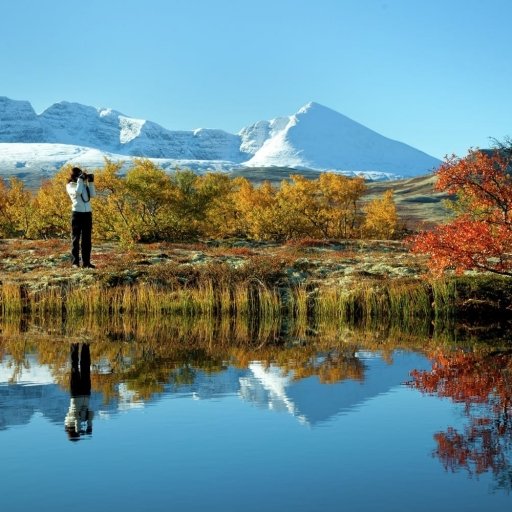
Highlights in Fjord Norway
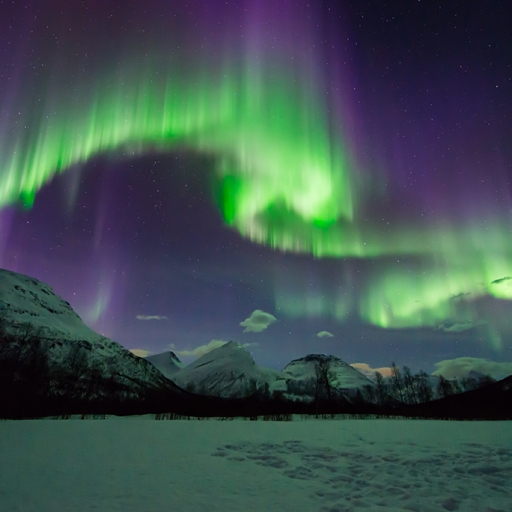
Top attractions in Northern Norway
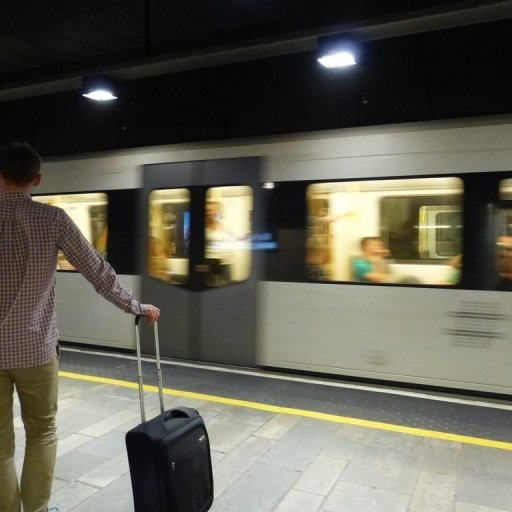
Getting around in Norway
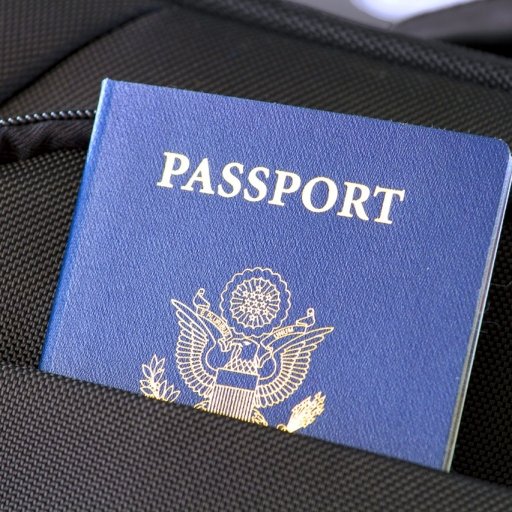
Visa to Norway
- Nordic Countries
- Inspiration
- Heritage & Culture
- Nature & Activities
- Design & Shopping
- Nordic Vikings
- Seasons & Weather
- Visitnordic
- Privacy Policy
- Terms of Use
- Become a Partner


- Pierre-Emile Højbjerg - 2'
- Christian Eriksen - 86'
- Alexander Isak - 9'
Eriksen stunner gives Denmark friendly win over Sweden
Christian Eriksen scored a stunning late winner to give Denmark a 2-1 victory over Sweden in a lively pre-Euro 2024 friendly at a sold-out Parken stadium on Wednesday, cementing his spot as the Danes' most potent creative force ahead of the tournament in Germany.
It took just over a minute for the home side to break the deadlock as Sweden's defence was caught napping at the game's first corner, and Eriksen found Pierre-Emile Højbjerg at the near post for an easy finish.
- Stream on ESPN+: LaLiga, Bundesliga, NWSL more (U.S.)
With the red-clad fans expecting that to be the beginning of an onslaught, the Swedes struck back quickly through Alexander Isak , who collected a blocked shot from Jens Cajuste and slammed it past Frederik Ronnow in the Danish goal seven minutes later.
The 32-year-old Eriksen, who collapsed due to a heart attack on the same pitch in Denmark's Euro 2020 opener against Finland, pulled the strings throughout, and his curling, dipping strike in the 86th minute gave the Danes a well-deserved win.
Sweden's Danish coach Jon Dahl Tomasson was inducted into the Danish football Hall Of Fame ahead of kickoff, and his side defended well but faltered in attack, with Isak and Dejan Kulusevski often crowded out by the Danish defence.
Denmark coach Kasper Hjulmand gave credit to Tomasson for his work so far with Sweden, who failed to qualify for the Euros under previous coach Janne Andersson, opening the door for the Dane to take over.
"[They play] an incredibly aggressive man-to-man game. I think in general we gave away too many turnovers in the first half, and they got chances they shouldn't have gotten," Hjulmand told broadcaster TV2.
"We should have scored a little more ... we must look at the opportunities Sweden got, because we must not give them chances," he added.
A delighted Eriksen was almost happier for the assist for the opening goal than he was for scoring the winner, having come in for some criticism for a string of poor set pieces in qualifying.
"It was nice, and it was good that we scored from a dead ball, I think it created a bit of calm in our team," he told broadcaster TV2.
Denmark round off their Euro 2024 preparations with a home game against Norway on Saturday before travelling to Germany, where they will face Slovenia , England and Serbia in Group C.
Game Information
- Kristoffer Hagenes
Men's International Friendly News
Belgium stick with 25-man selection for euro 2024, southgate on england omissions: other players have had stronger seasons, southgate confident of winning over england fans with new-look euros squad.
- Terms of Use
- Privacy Policy
- Your US State Privacy Rights
- Children's Online Privacy Policy
- Interest-Based Ads
- About Nielsen Measurement
- Do Not Sell or Share My Personal Information
- Disney Ad Sales Site
- Work for ESPN
- Corrections
Sweden vs Norway: which Scandinavian country beckons for you?

Jul 28, 2023 • 6 min read
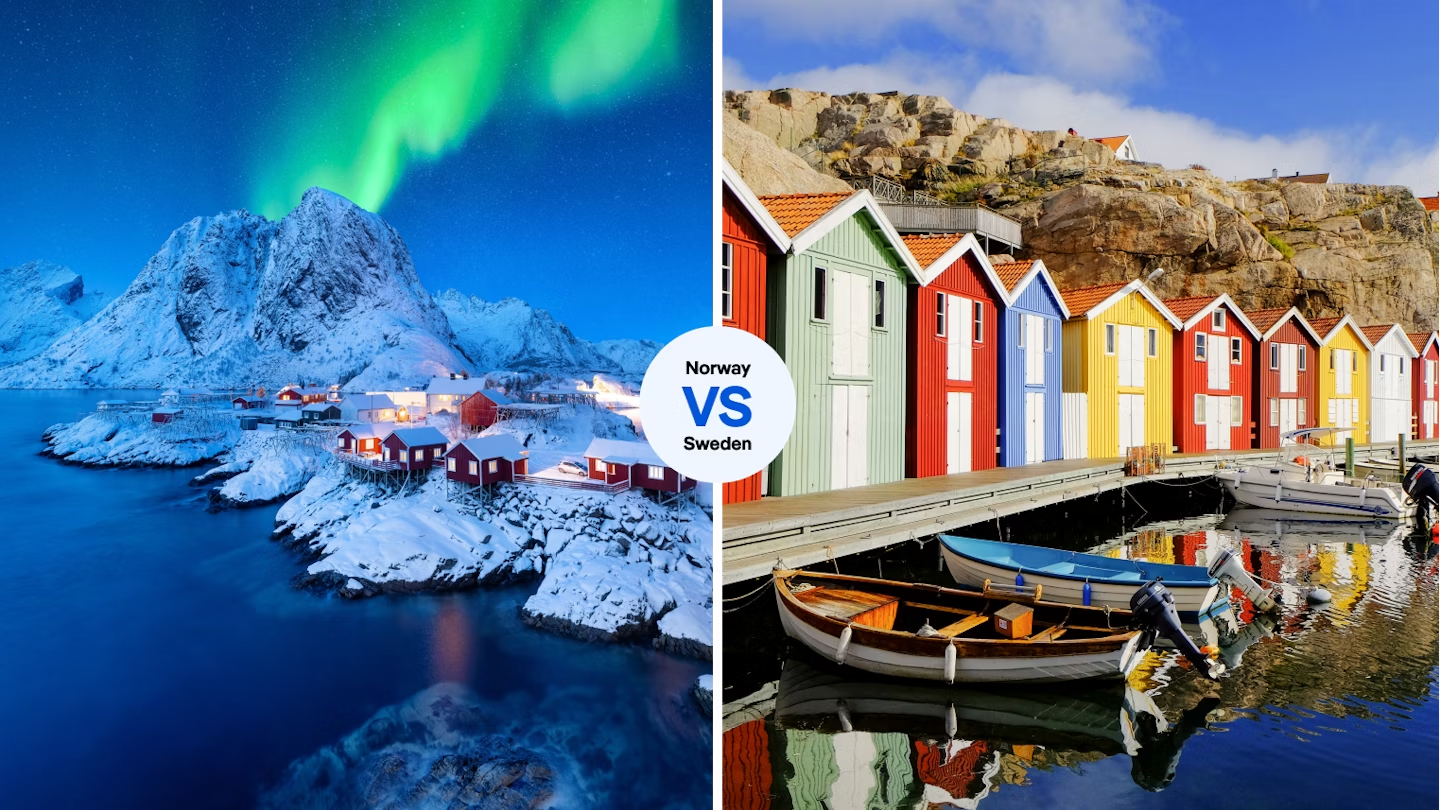
Go north of the Arctic Circle in Norway, or stick to the seaside in Sweden’s Bohuslän? © iStock
With their chic cities, dramatic landscapes and high quality of life, the countries of Scandinavia remain objects of worldwide fascination. Yet if you’re looking to dip your toe into Nordic waters, where do you begin?
To help you make up your mind, we asked two expert writers to expound on two of the region’s best-known countries, Sweden and Norway. Good luck as you consider your options up north.
Select sensational Sweden
Paula Hotti’s first trip abroad was a family holiday to Stockholm in her early teens. Later, she road-tripped around the country and lived for a year in Sweden’s second city, Gothenburg – only to fall in love with the charms of Sweden’s west coast.
Norway might have its Arctic archipelagos, meandering mountain roads and cascading waterfalls, true. But in Sweden , you can let your soul drift in seaside paradises, on epic hikes or under the magic of the aurora borealis.
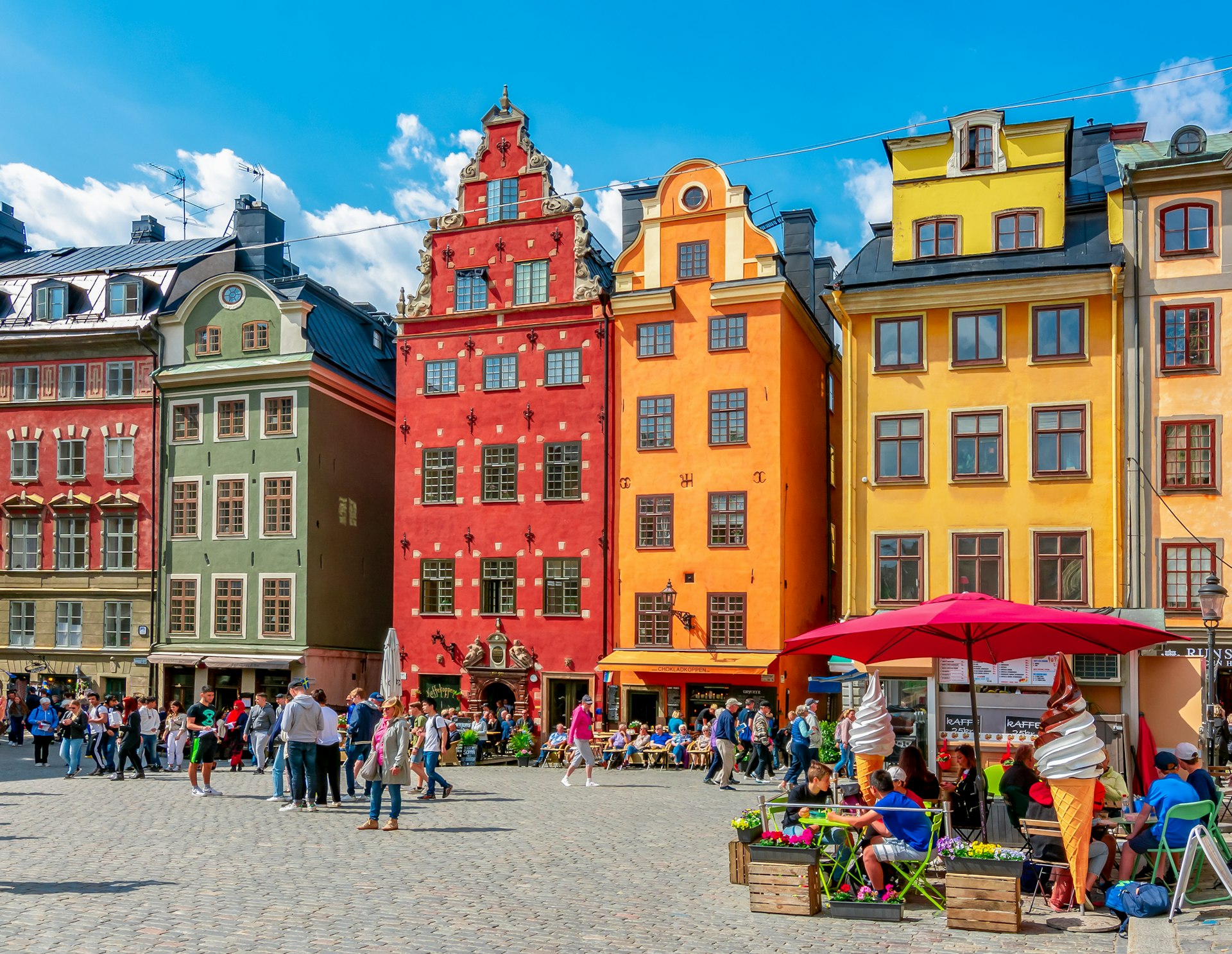
If you venture to Sweden for the first time, start in the capital, Stockholm . Built on 14 islands, the city’s oldest quarter is Gamla Stan (Old Town), its centerpiece the Royal Palace . While the area dates back to the 13th century, and the majority of its buildings from the 16th and 17th centuries, Gamla Stan isn’t covered with cobwebs: it’s a vibrant neighborhood whose cobbled streets brim with cafes and boutiques that beg to be explored.
From Stockholm, it’s easy to jump onto a ferry and head to the archipelago that radiates from the capital. In 20 minutes, you’ll glide from trendy city streets to a calmer place, its pace of life set by the ripples of the Baltic Sea.
Although I adore Stockholm, my heart belongs to Bohuslän on the west coast . Bohuslän lies between Gothenburg and the Norwegian border, and its thousands of islands and cute coastal towns like Smögen and Fjällbacka make the area a summer haven – think hiking, biking and eating all fresh seafood you can manage. In winter, a light dusting of snow blankets the coastal cliffs. As the sea freezes, the summer idyll turns into a serene winter wonderland, with lighthouses and red huts dotting the white seascape. This is a place to stare out at the horizon and let your mind rest.

For the adventurous, Swedish Lappland is unbeatable. Among an abundance of hiking treks to choose from, the Kungsleden, or King’s Path, reigns supreme. Running for about 450km (280 miles) from Hemavan to Abisko, the trail is easily divided into shorter stints. The most regal scenery and highest elevations are at the end and the beginning of the trail. Abisko is also reputedly the world’s finest spot to see the aurora borealis – and I believe it, as this is where I witnessed the celestial phenomenon for the first time in my life.
For cities, there’s no real competition between Sweden and Norway. Stockholm exudes unbeatable Scandi-cool vibes, and you cannot even speak of the second cities Gothenburg and Bergen in the same breath. (Unless you love rain, that is: Bergen gets an average of two to three times more rain than Gothenburg per month.)
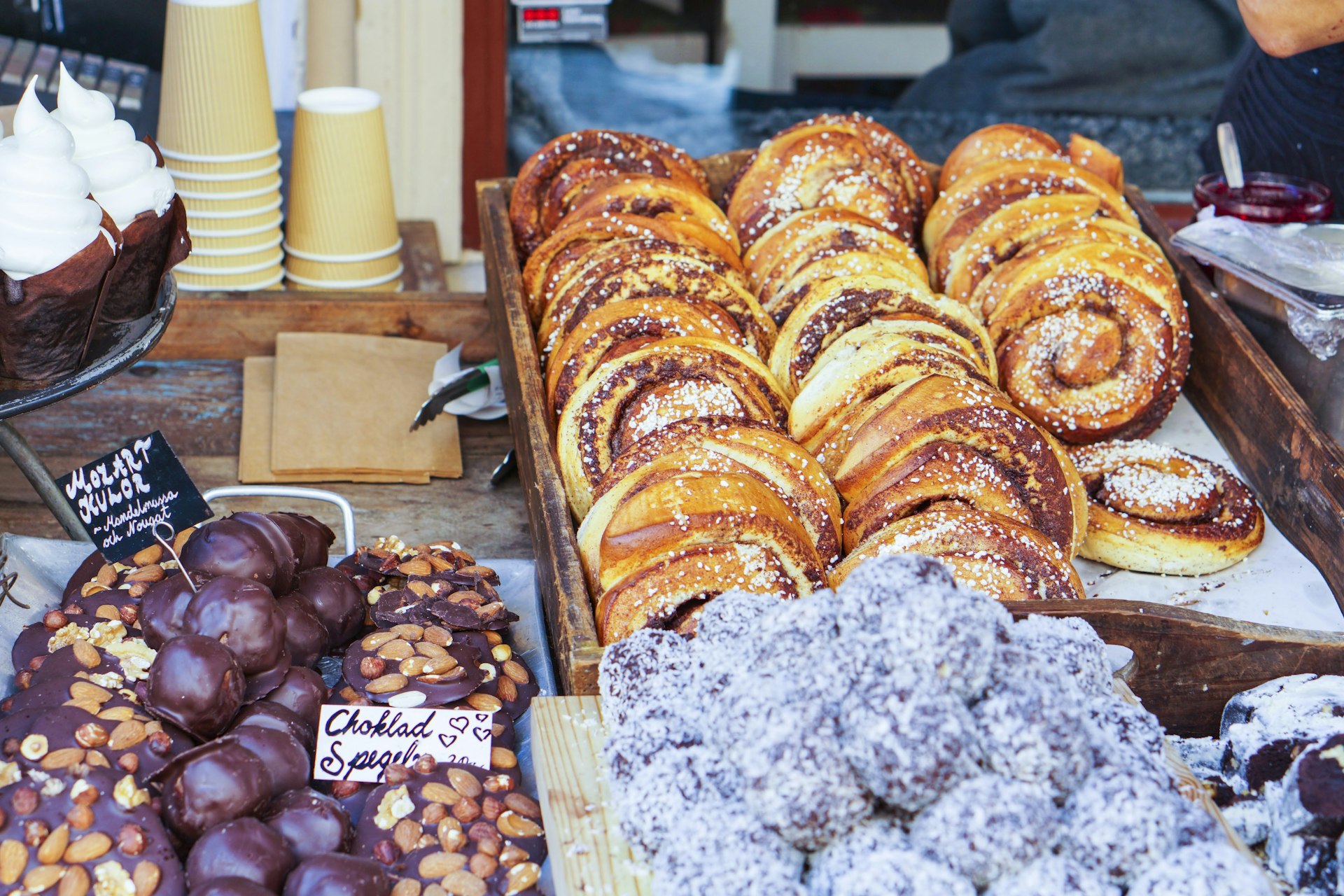
Designed by the Dutch in 1621, Gothenburg has canals, cuteness and character in spades. The city is also regularly hailed for its sustainability , only adding to its livable allure. In addition to its parks and leafy avenues, you will also find quaint neighborhoods tucked between Rosenlundskanalen (where a few restaurant boats moor) and the slow-flowing Göta River. Perhaps the most appealing is the formerly working-class suburb Haga , an epicenter of fabulous boutiques, restaurants and cafes, all in pastel-colored wooden houses.
Haga may be the best place in the country to enjoy fika , a dedicated time for coffee and cakes. There’s nothing cozier than snuggling up in one of Haga’s coffee shops, such as Café Husaren , which bakes Sweden’s arguably biggest cinnamon buns.
To sum it up, a sojourn in Sweden soothes your spirits. Life just tastes sweeter here.
Norway: nature in overdrive
A lover of cold, mountainous places, Lonely Planet author Kerry Walker was immediately smitten with Norway – and has made it her mission to travel the length and breadth of this ravishing country over the past decade.
My first visit to Norway threw me in at the Arctic deep end – and I’ve been obsessed with Scandinavia’s most gorgeous country ever since. What snow! What ethereal blues! What crazy witch hat–shaped mountains leaping out of jewel-like seas! Norway’s beauty is off the charts.
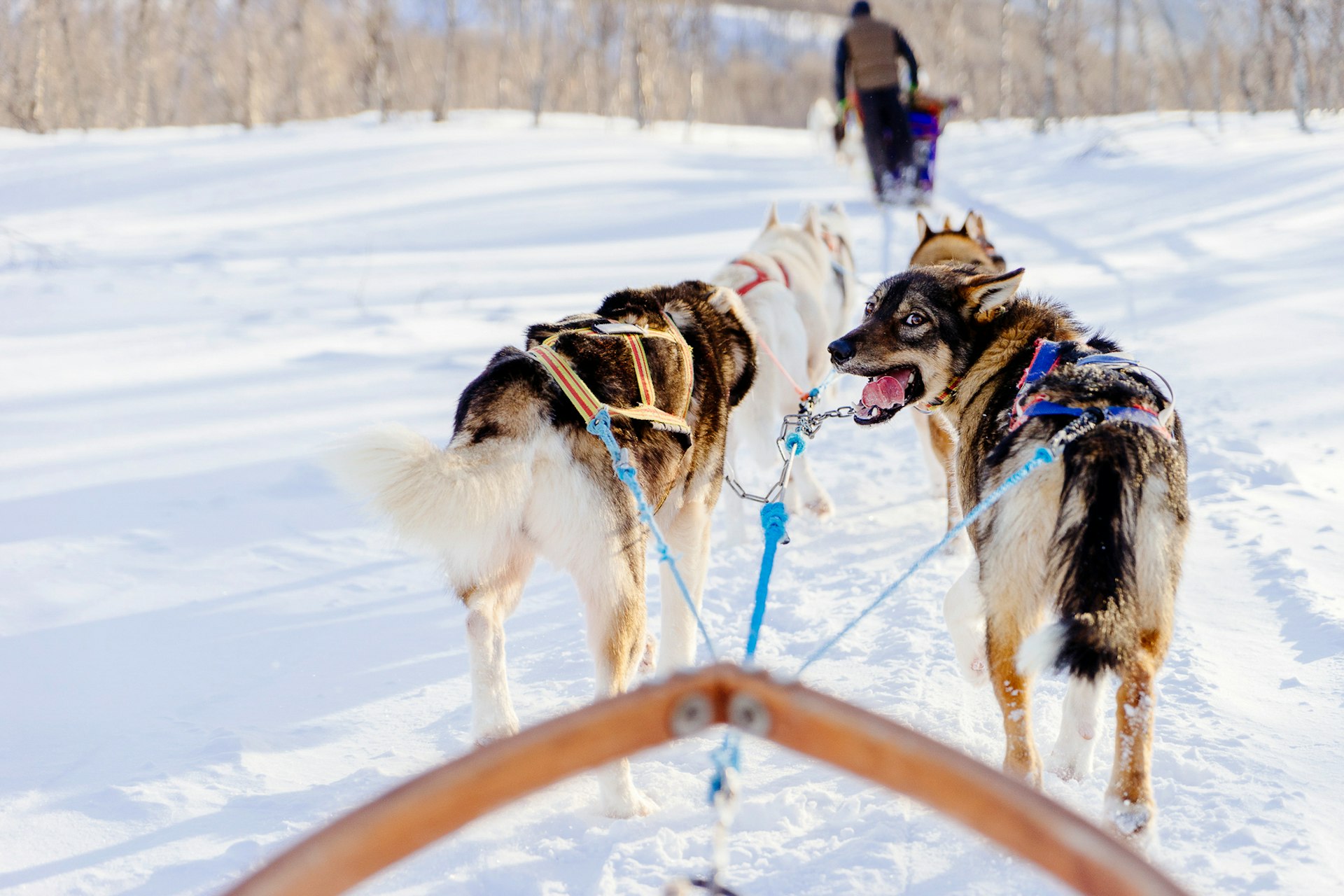
On that trip, I used Bodø as a springboard to explore the neverland of the high north. I crossed the Arctic Circle on foot in the frozen hush of night. I gazed up to the wizard-wand flashes of the northern lights. I heard the howl of huskies as I mushed over pearl-white slopes, feeling as if my sled would take flight any second. I hauled in skrei (Arctic cod) on an old clipper and cooked it over a campfire on a snowy beach. I huddled in a Sami lavvu tent, with reindeer gathered around outside. I bounced on a rigid inflatable boat past the whirlpools and rapids of Saltstraumen , the world’s most powerful maelstrom, as sea eagles screeched overhead. I will carry these memories with me forever.
Sweden is pretty, no doubt – but it can never match Norway for mind-blowing wilderness, with glaciers, thundering falls and pointy mountains that look like the figment of a child’s imagination. (It’s no wonder Norway inspired Disney’s Frozen .) This is an elfin fantasy land. A land touched by magic and sprinkled with fairy dust.

In a country that prizes friluftsliv (outdoor living) over all else, culture nods to nature here, too. In Oslo , you’ll be drawn to Edvard Munch’s paintings of swirling Nordic light and mysterious fjords (see his surreal work at the architecturally striking Munchmuseet , plus the view that inspired The Scream at Ekebergparken ). The sea-faring, battle-hungry Vikings left their mark on medieval stave churches, none lovelier than the Unesco World Heritage one in Urnes on the shores of Lustrafjorden. And up in the Arctic, Alta wows with prehistoric rock art depicting hunter-gatherer life at the Alta Museum and the aurora-framing Northern Lights Cathedral .
But what about the food? Surely Sweden wins there? Nope. Norway is riding high on the culinary front, with chefs putting creative riffs on brilliantly fresh ingredients plucked from fjord, forest, field and mountain. The country now has restaurants right up there on the podium with Europe’s best, from two-Michelin-starred Renaa in Stavanger, where the food sings joyously of the seasons and foraged finds, to the Valentine Warner–hosted Kitchen on the Edge of the World at Holmen on the thrillingly wild Lofoten Islands . And now everyone is raving about Michelin-starred Under in Lindesnes, a restaurant dropped deep into the sea on Norway’s storm-smashed south coast .
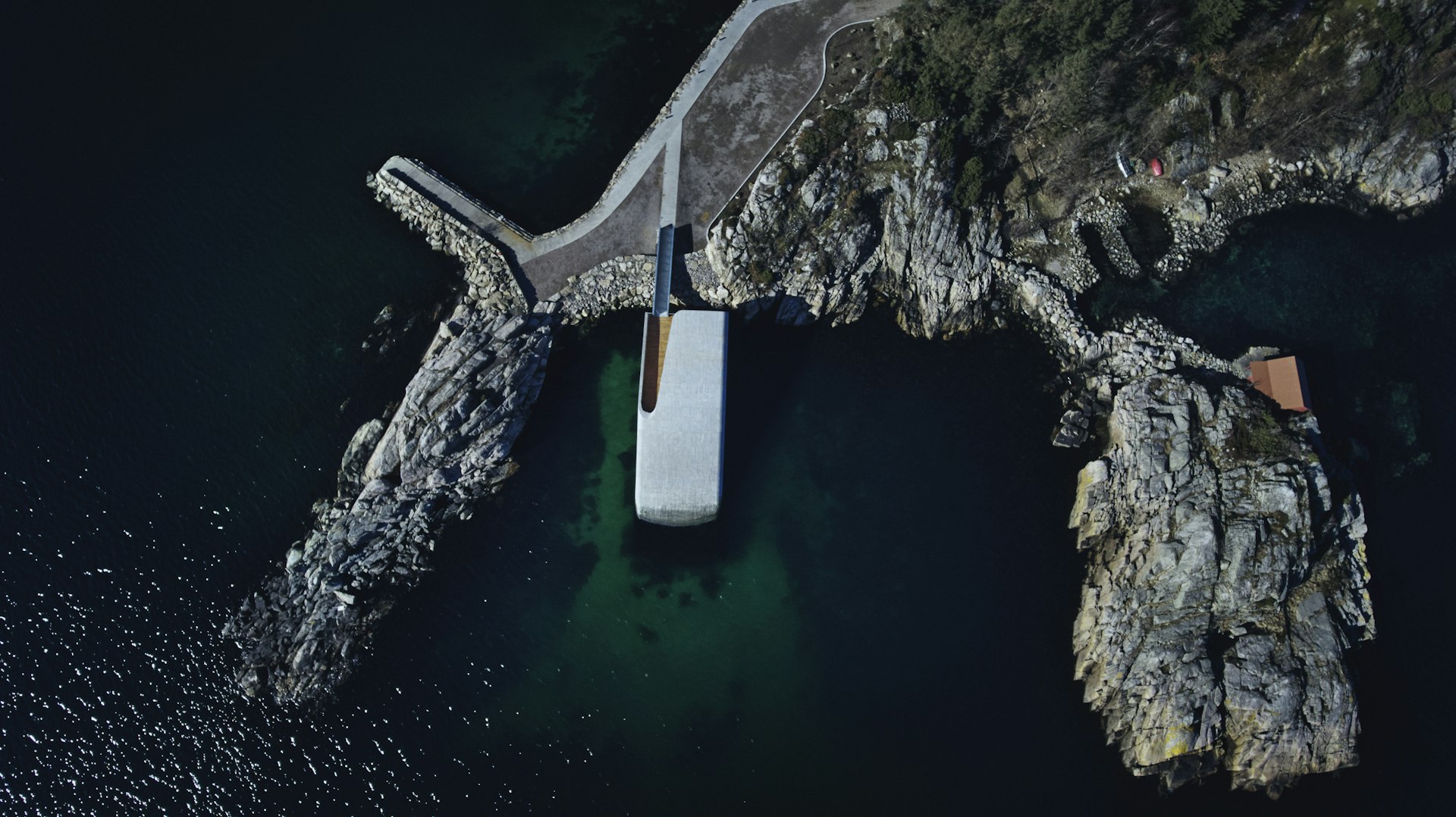
But more than anything it’s the outdoors that pulls me back. Here, you can give civilization the slip hiking in Jotunheimen (“Home of the Giants”), a glacier-topped, mountain-rippled treat of a national park. Here, you can kayak and cruise in wonder across fjords of turquoise and sapphire blue, gawping up at rainbow-kissed waterfalls nosediving over cliffs and great fang-like mountains. Here, you can go on a summer musk-ox safari in the bleakly beautiful highlands of Dovrefjell-Sunndalsfjella National Park and stomp past mainland Europe’s largest ice cap, the Jostedal Glacier, in Jostedalsbreen National Park . Here, you can strike out from the fjord-side city of Stavanger to literal rock stars like knife-edge Preikestolen (Pulpit Rock), Trolltunga (Troll’s Tongue) and Kjeragbolten , a mad boulder wedged between two heart-stoppingly sheer cliffs.
Wherever you go, there’s something exhilarating about knowing that no matter how many fjords you cruise, helter-skelter roads you drive and insanely steep mountains you climb, Norway has more to keep you coming back for a lifetime.
And you will, I promise you.
Explore related stories
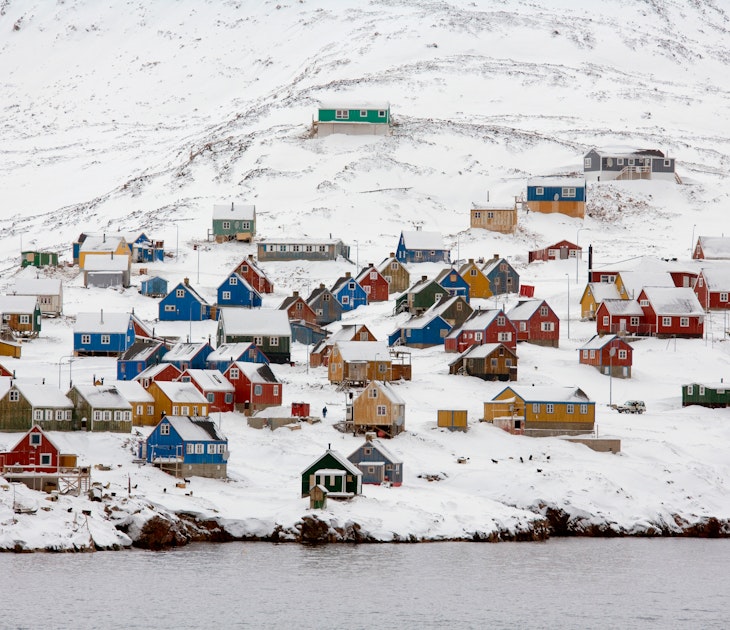
Wildlife & Nature
Dec 1, 2023 • 6 min read
How about chilling out – truly – on your next big trip? These are the coldest, most beautiful places to visit in the world.
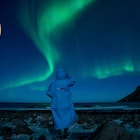
Oct 27, 2023 • 5 min read

Sep 5, 2023 • 7 min read
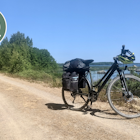
Aug 25, 2023 • 6 min read

Aug 3, 2023 • 7 min read

Jan 2, 2023 • 12 min read

Dec 10, 2022 • 7 min read
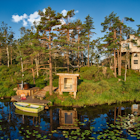
Apr 30, 2024 • 8 min read
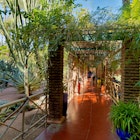
Apr 24, 2024 • 11 min read

Mar 30, 2024 • 4 min read
We've detected unusual activity from your computer network
To continue, please click the box below to let us know you're not a robot.
Why did this happen?
Please make sure your browser supports JavaScript and cookies and that you are not blocking them from loading. For more information you can review our Terms of Service and Cookie Policy .
For inquiries related to this message please contact our support team and provide the reference ID below.

Norway vs Sweden: Which Scandinavian country should you visit?
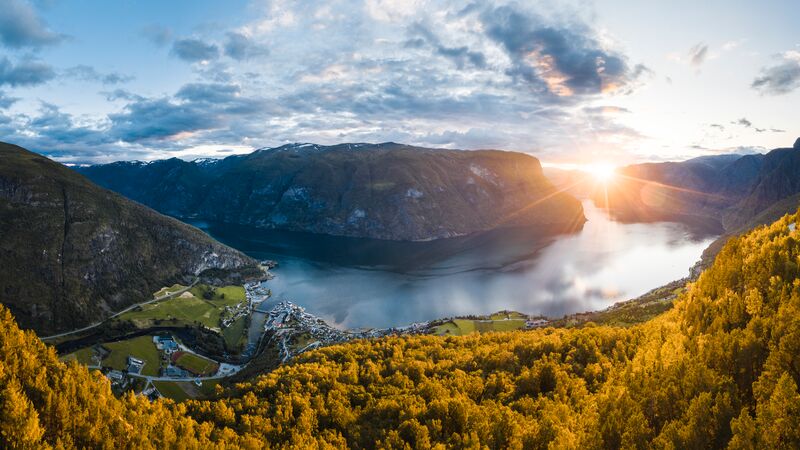
Dreaming of fjords and frolicking through forests?
When you want to go everywhere (*raises hand*), picking your next travel destination isn’t easy. Especially when it’s between Norway and Sweden . Both countries are ridiculously beautiful (like take-your-breath-away kinda beautiful) and are home to some of the world’s happiest people; this is even more impressive considering how long and dark Scandinavian winters are.
In an ideal world you’d jump on Intrepid’s Taste of Scandinavia trip to explore Norway, Sweden and Denmark. But if annual leave or budget allows for only one country, which will it be? We’ve broken down the top considerations to help you make the call.
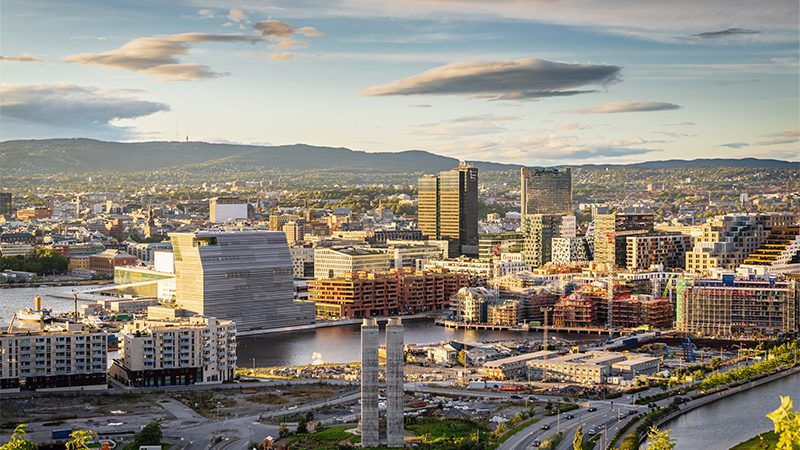
Oslo is smaller and more compact than Sweden’s capital, Stockholm, but it packs a punch. It boasts a happening waterfront, loads of quirky modern buildings, an eclectic collection of museums, and a burgeoning coffee and temporary art scene — including Vigeland Park, the world’s largest sculpture park.
Norwegians are all about friluftsliv (outdoor living). The city is built on the end of the Oslo Fjord so you’re never too far from rugged islands, hiking trails, lakes and mountains. In fact, you’ll often see locals carrying their cross-country skis on the metro in winter. You’d probably prefer Oslo if you’re an outdoor lover at heart.
But Oslo is just the start. There’s also Bergen with its rich history (including one of Europe ’s oldest harbours), thriving restaurant scene and incredible views. Not to mention the gorgeous city of Alesund with its vibrant Art Nouveau architecture and quaint waterways set against a backdrop of sea and mountains.
Related: Check out some tips to do Norway on a budget
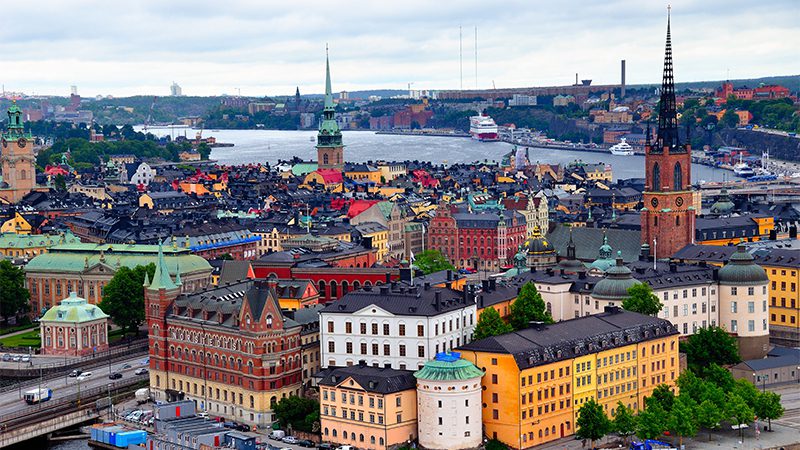
From the country that gave us ABBA and Spotify, it’s no surprise that its capital oozes cool kid energy. Stockholm is all about culture and cosmopolitan lifestyle, with restaurants, galleries, bars, shops and museums galore. Built on 14 islands (which are part of the vast Stockholm Archipelago), it’s a great city to walk or cycle around; it has even been dubbed the ‘Venice of the North’.
Stockholm has more rustic charm than Oslo, with a mix of sleek modern architecture and well-preserved historic buildings, some dating back to the 13th century. The most famous area is Gamla Stan (old town), an open-air museum where you can get lost in winding laneways, admire the colourful homes of the aristocracy and marvel at one of Europe’s largest palaces, AKA the Royal Palace of Stockholm. Oslo also has an old town, but Gamla Stan has more grandeur.
There’s also Gothenburg with its winding canals, flourishing art scene and lively waterfront. And we can’t forget about Malmo with its multicultural markets, fairytale-like castles and modern seaside promenade.
The term’ natural playground’ is thrown around a lot, but there’s no better way to describe Norway and Sweden. No, really, access to nature is a public right in Scandinavia, meaning you can hike, bike, pitch a tent or forage almost anywhere you want. And it’s just as well, because they’re frequently named among the most beautiful countries in the world.
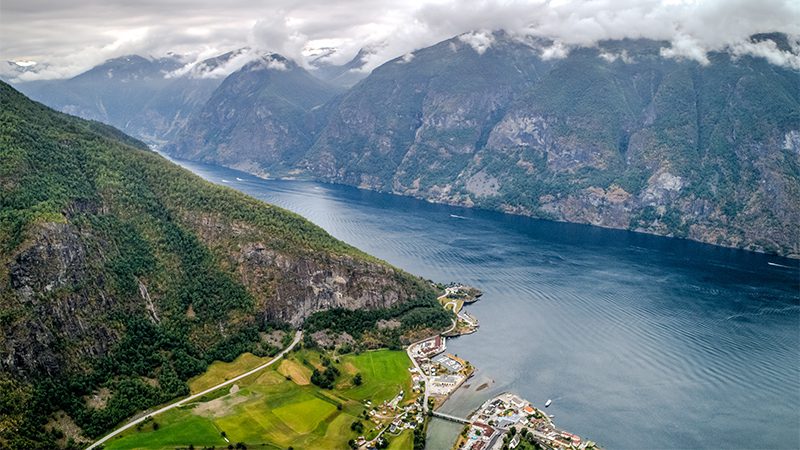
Norway’s landscapes are as wild and dramatic as it gets. It’s home to some of the world’s most impressive fjords, including the UNESCO-listed Geirangerfjord. Formed over millions of years by glaciers and ice sheets, these deep, narrow waterways give rise to soaring cliffs and provide a breathtaking backdrop for hiking and kayaking.
Norway’s mountainous interior is just as spectacular. Nestled between the peaks you’ll find vast plateaus and valleys where nature thrives. Norway also has 40 national parks and nature reserves, and arctic tundra in the far north.
Related: 15 photos so beautiful they’ll put Norway on your bucket list
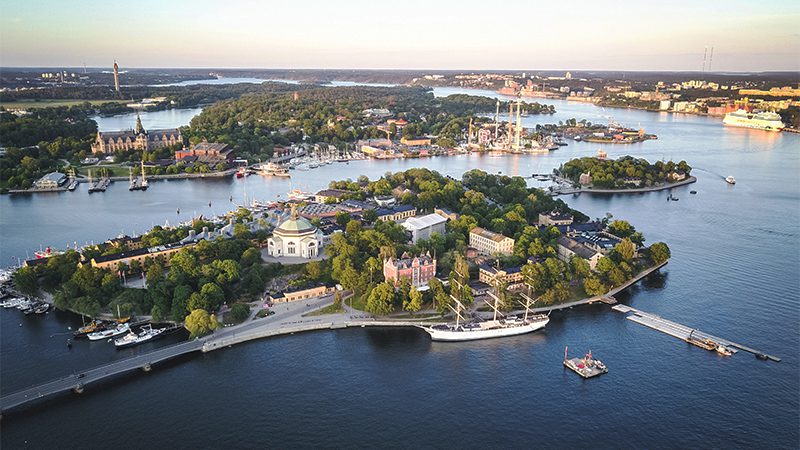
Sweden’s landscapes are more enchanting than dramatic. The southeastern regions are primarily flat with rolling hills, forests, farmland and lakes (all 97,000 of them!). The northwest is more rugged with the Scandinavian Mountains stretching from the north to the south, as well as some of the largest untouched wilderness areas in Europe.
Sweden also has over 3,000 kilometres of coastline and one of the world’s largest archipelagos (the Stockholm Archipelago), which comprises over 30,000 islands and islets. There are endless opportunities to explore.
Both countries have a lot to offer. Norway is the place to be if you’re into mountains, glaciers, and fjords. If forests, lakes and islands are more your jam, you may prefer Sweden.
Related: Why consider solo travel in Scandinavia
As neighbouring countries with strong historical ties, there are many similarities between Swedish and Norwegian cuisine. There’s a focus on hearty dishes made with root vegetables, oily fish and meat. They also share a tradition of preserving food using smoking, pickling and fermenting techniques; this was historically a way to ensure families had enough food to survive the harsh winters.
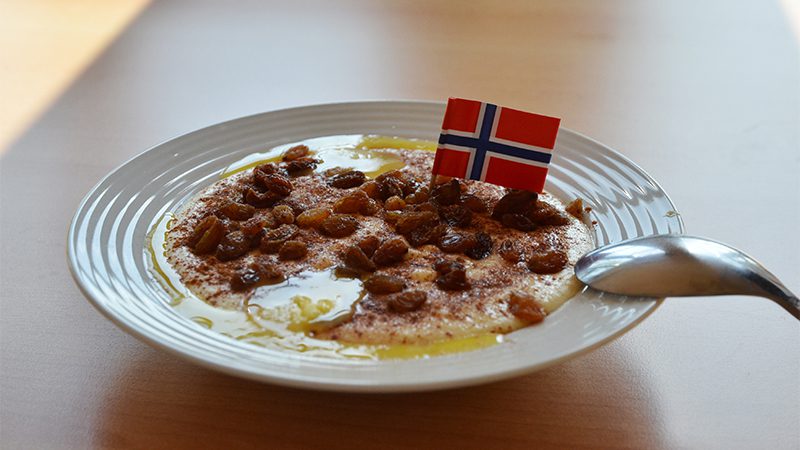
Norwegian cuisine is heavily influenced by the country’s abundant fjords and coastlines, so it’s more fish-focused. Must-try dishes include gravlax (cured salmon), sursild (pickled herring), torrfisk (dried cod) and Norwegian fish gratin. Other famous dishes include farikal (the national dish of mutton and cabbage), sour cream porridge with cured meat or cinnamon, and brunonst (brown cheese) eaten on a slice of bread or with waffles and jam. You could also try smalahove (sheep’s head) if you’re feeling adventurous.
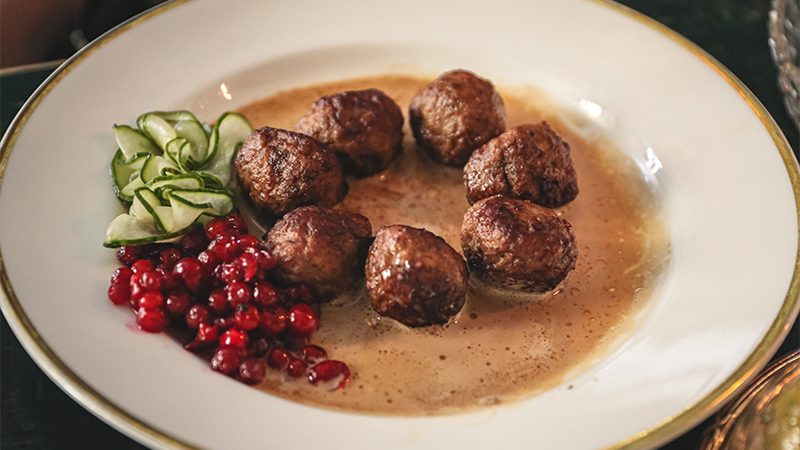
Swedish cuisine includes more pork, beef and game. It’s famous for meatballs (which you’ll know if you’ve ever been to IKEA), which are typically served with mashed potatoes, lingonberry jam and pickled cucumber.
Fish is also popular, particularly salmon, herring and crayfish. In fact, the Swedes even host summer crayfish parties complete with crayfish-themed table decor and hats. Other fish dishes include surstromming (fermented herring) which is known for its pungent smell, and raksmorgas (Swedish shrimp sandwich).
However, one of the best things about Swedish cuisine — and culture — is fika. Fika translates to “a coffee and cake break”, but it’s so much more than that. Fika can be a mini break from work, a way to catch up with a friend, a networking activity… in other words, it’s a social institution.
Some companies even add a clause in employment contracts to entitle staff to fika. A traditional fika spread comprises seven types of cake, cookies and pastries. Needless to say, Sweden’s patisserie game is strong; some would even argue it gives the French a run for their money.
When to visit
If you’re reading this blog, you’re probably not looking for guaranteed sun. Spoiler alert: you won’t get that in Scandinavia! Norway and Sweden share a similar climate with long, cold winters and short, mild summers. The best time to visit depends on what you want to do.
Unless you’re into winter sports, summertime (June to August) or the shoulder months of May and September are when these countries shine. The weather is warm, nature comes alive and there are extended daylight hours to explore. If you head north above the Arctic Circle between May and July, you may even experience a phenomenon known as the midnight sun, when the sun remains visible throughout the night.
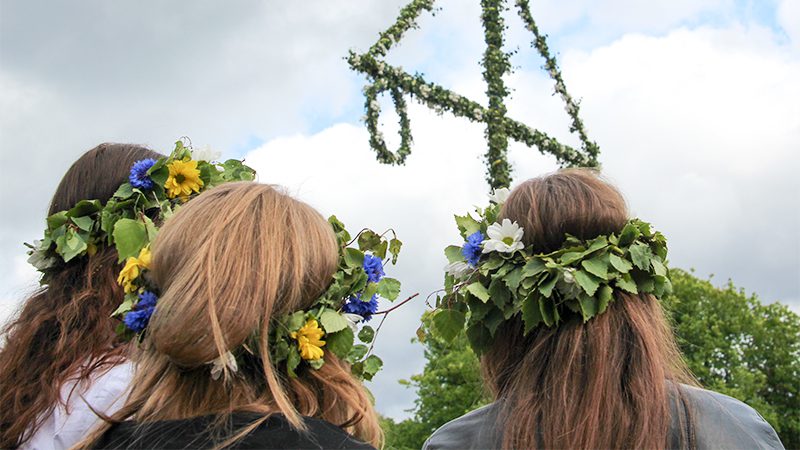
Summer in Scandinavia is a big deal. In fact, there’s a whole festival called Midsummer dedicated to it; it takes place on the solstice in June. But Sweden has one up on Norway here. Midsummer in Sweden is a national holiday and the celebrations are big. Locals gather to eat lunch in the garden, dance around maypoles wearing flower crowns, and sing folk songs over a glass (or two) of snaps. (Where do I sign up?)
If the Northern Lights are on your bucket list, you’ll be glad to know you can see them in both countries. They can be seen all over Norway and Sweden, but the further north you go (ideally above the Arctic Circle ), the better your chance. September to March is the best time to see this natural wonder when the night skies are very dark.
The verdict
Norway might be the better choice if you’re looking for epic landscapes and outdoor activities. But if you want a mix of city life and outdoor adventures, Sweden could be the way to go.
Keen for a Scandinavian adventure? Check out Intrepid’s range of trips in Sweden and Norway .
Feeling inspired?

Cliona Elliott
Originally from Jersey (the tiny island in the English Channel), Cliona now lives in Melbourne, Australia. When she's not writing about all things travel for Intrepid, you'll find her chasing flavours, getting lost in local markets or waking up at a ridiculous time to watch the sunrise from the top of a mountain.
You might also like
Tips and hacks for train travel in europe, why train travel is the one experience you..., everything you need to know about a night..., mind your manners: dining etiquette around the world, 5 places to escape the crowds in italy..., is australia safe everything you need to know, 10 fun facts you might not know about..., explore these 7 tea rituals from around the..., 12 facts you probably don’t know about guatemala, the 7 best places to go on a..., 5 reasons to visit sri lanka in the....
Ukraine-Russia war latest: Putin talking at International Economic Forum; Ukraine has right to strike targets in Russia - NATO boss
The Russian president has taken to the stage in St Petersburg to address the International Economic Forum. Meanwhile, Jens Stoltenberg, the NATO secretary general, has said that Ukraine has the right to strike "legitimate targets in Russia".
Friday 7 June 2024 13:43, UK
Please use Chrome browser for a more accessible video player
- Russia economically strong despite 'illegitimate sanctions'
- Ukraine has right to strike targets in Russia - NATO chief
- Russian vessels to make port in Cuba in 'hopes of invoking memory of missile crisis'
- Biden to discuss $225m package with Zelenskyy in France
- Ivor Bennett: Why is Lavrov in Africa?
- Big picture: Everything you need to know about the war right now
- Your questions answered: Are there any signs of an underground resistance in Russia?
- Live reporting by Andy Hayes and Ollie Cooper
The session begins with an address by the Russian president.
Vladimir Putin says there is a race among world powers to establish sovereignty.
He speaks of the need for countries to both establish partnerships and also to look internally to tackle challenges presented by the current global economic landscape.
Despite all the "obstacles and illegitimate sanctions", Russia remains one of the world's economic leaders, he says.
He adds that "friendly countries" - those that have not joined sanctions against Moscow - account for three quarters of Russia's mutual trade turnover, and praises them for that.
Countries including India and China have strengthened economic ties since Mr Putin launched his war in Ukraine.
Vladimir Putin has taken to the stage in St Petersburg to address the International Economic Forum there.
He's joined by Zimbabwean President Emmerson Mnangagwais and Bolivian President Luis Alberto Arce Catacora.
Chairing the session is Sergey Karaganov - a Russian political scientist.
We'll bring you any key lines here in this live blog.
A T-shirt is on sale at the St Petersburg International Economic Forum printed with a phrase attributed to Vladimir Putin, Sky News has discovered.
"If a fight is inevitable, throw the first punch," it says.
The Russian president reportedly said it in 2015.
He apparently explained that it was something he had learned while growing up on the streets of Leningrad - a former name of St Petersburg.
The Russian defence ministry has accused Ukraine of injuring 20 people, including children, in a missile attack on the Russian-controlled eastern Ukrainian city of Luhansk, using US-supplied ATACMS missiles.
Four of five missiles were shot down by air defence systems, the ministry said in a statement.
However, one of the missiles damaged two residential apartment blocks, it added, claiming it was deliberate.
Sky News is unable to verify the allegations.
There has been no immediate comment from Ukraine.
The European Commission supports starting EU accession talks with Ukraine, the country's prime minister has said.
Denys Shmyhal said the commission had confirmed in a report that Kyiv had fulfilled the remaining steps required to start negotiations.
"Now we expect our European partners to take the next step - to start negotiations on European Union membership this month," Mr Shmyhal said on Telegram.
Earlier (7.43am post) we reported that the commission was reportedly ready to recommend that accession talks get underway.
It is part of an attempt to signal support for Kyiv before Hungary takes over the rotating presidency of the EU next month, the Financial Times reported.
The EU announced earlier this year that it was sending an additional £42bn in aid to Ukraine - but only after weeks of resistance from Hungary , which reportedly has concerns about minority rights in Ukraine.
Vladimir Putin is likely to adopt a provocative tone as he addresses the Saint Petersburg International Economic Forum this afternoon, Ivor Bennett, Sky News's Moscow correspondent , has said.
In his speech, expected at midday UK time at the earliest, the Russian leader may stress there is an alternative view of world affairs to the one being put forward by the West, Bennett added.
"I think he will undoubtedly use some more provocative rhetoric," Bennett said - noting there has been more confrontation in the Russian leader's tone recently, "culminating in that threat on Wednesday night to potentially send weapons to other nations to hit Western targets".
Bennett added: "Whether or not he'll be drawn more on that, giving specific examples, I'm not so sure.
"But I think he could potentially talk more about nuclear weapons, reiterating Russia's readiness to use them.
"The Kremlin likes to say that it's not Russia making the escalations here - they're merely responding to Western provocations.
"Russia is merely defending itself."
Ukraine has the right to attack legitimate military targets in Russia, NATO Secretary General Jens Stoltenberg has said.
"Ukraine has the right to self defence," Mr Stoltenberg said during a news conference with Swedish Prime Minister Ulf Kristersson at a military base near Stockholm.
He added: "The right to self defence also includes the right to hit legitimate, military targets on the territory of the attacking party, the aggressor - in this case Russia."
Mr Stoltenberg continued: "This is a war of attack that Russia has begun against a peaceful, democratic neighbouring country - Ukraine - that at no point has been a threat to Russia.
"There is no question that Ukraine has the right to hit targets on Russian territory."
The United States recently gave Ukraine permission to use American weapons on Russian territory near Kharkiv.
Maria Zakharova, a spokeswoman for the Russian foreign ministry, has claimed that HIMARS rockets have been used since then on civilian targets (8.36 post).
Vladimir Putin has said he is considering arming the West's enemies in retaliation.
Volodymyr Zelenskyy has thanked France for its support as he addressed the country's National Assembly.
President Emmanuel Macron has said his country will send Mirage 2000 warplanes to Ukraine.
The Ukrainian president's speech was part of an official visit to France following the 80th anniversary commemorations of D-Day.
"I'm sure a day will come when Ukraine will see the same jets in our skies that we saw in Normandy skies yesterday," Mr Zelenskyy said.
"Your combat aviation [and] brilliant fighter jets under Ukrainian pilots' command will prove that Europe is stronger, stronger than [the] evil which dared to threaten it.
"Now, just like 80 years ago, we can prove it — the power of our unity, the power of our alliance, the power of our shared ideals."
He added: "Can Putin win the war? No, because we have no right to lose."
Kremlin spokesman Dmitry Peskov has accused Emmanuel Macron of fuelling tensions across Europe.
Yesterday, the French president said he was planning to send Mirage 2000 warplanes to Ukraine.
The Moscow spokesman claimed Mr Macron had declared his absolute support for Kyiv - and shown his readiness for direct French involvement in the Russia/Ukraine conflict.
The French president did not say how many Mirages France would provide.
Nor did he say when it would happen, and under what financial terms.
France has proposed that Ukrainian pilots be trained in France from this summer, Mr Macron said.
A detailed map showing the latest situation on the ground in Ukraine has been published by the UK's Ministry of Defence.
The area in light pink is territory taken by Russia since it invaded in February 2022.
Those areas in a darker shade of pink show territory - including Crimea - seized by Russia since 2014.
White, blue and red circles represent the grouping of forces while the red arrows show likely Russian attacks.
Despite the recent heavy bombardment of Kharkiv, Ukraine's second city, it is not in the seized sections.
However, a couple of small areas north of Kharkiv, on the Russian border, are shaded light pink.
Be the first to get Breaking News
Install the Sky News app for free


Sweden vs Norway, which one should you visit?
So you’re thinking of a trip to Scandinavia, but don’t know where to go. Sweden and Norway are both popular countries with plenty to appeal to visitors – stunning scenery, beautiful coastlines, islands galore, great skiing, pretty villages and some vibrant cities too.

So how do you decide which country to visit? We’ve done a handy comparison to help you decide – Norway vs Sweden: which one should you visit? Read our guide to find out.
Size and population
So first things first, which is bigger: Sweden or Norway? And which has the larger population?
Well, Sweden is the winner here, both in terms of size and population. At 450,000 square kilometres, it’s almost a third larger than its long, thin neighbour which covers 324,000 square kilometres.
And as for population, Sweden has almost twice as many inhabitants as Norway, with a population of just over 10 million, compared to Norway’s 5.5 million.
Obviously Swedes speak Swedish, and Norwegians speak Norwegian, but how similar are they, and do Swedes understand Norwegian and vice versa?
Well, both the Norwegian and Swedish languages originate from Old Norse and are closely connected, with similar grammar, structures and vocabulary.
However, they do sound obviously different with their own distinctive pronunciations.
But the truth is that they are quite similar, and native Swedes are able to understand and speak a certain amount of Norwegian and vice versa.
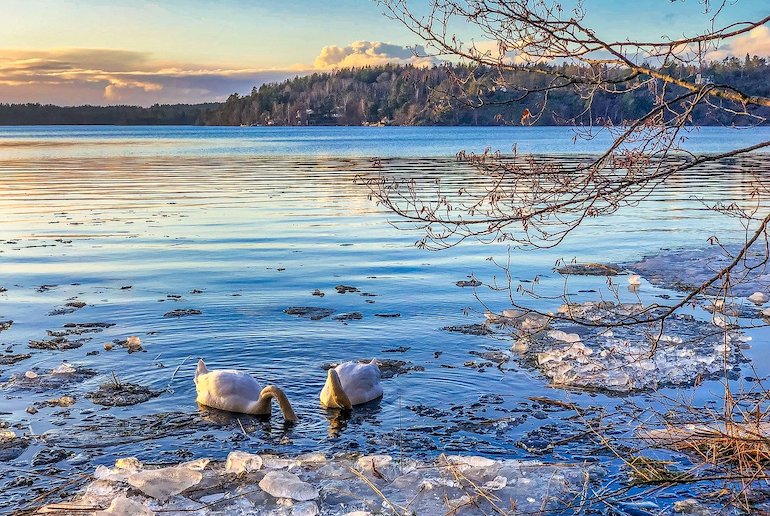
In the north of both countries, Sami is spoken by the indigenous people that live in Lapland.
Some 25,000–30,000 native Sami speak the language across the north of Norway, Sweden, Finland and Russia, though they will all speak their national language too – and probably some English as well.
The good thing for visitors is that English is widely spoken in both Norway and Sweden, and you should find no problem being understood in both countries.
Almost 90 percent of Swedes and Norwegians speak some English and many of those are fluent.
So, while both Swedes and Norwegians will appreciate you making the effort to learn a few phrases of their language, you should have no problem getting by in English.
Things to see and do: Sweden vs Norway
Both Sweden and Norway have an amazing variety of things to see and do, not least adventure sports, mountain villages, lively cities, unspoilt archipelagos and, of course, the famous fjords.
Scenery: Sweden vs Norway
Norway probably wins out for spectacular scenery, with its majestic and unique coastline indented with steep cliffs and deep blue fjords .
But visiting the fjords can be expensive and involve a lot of planning (check our our advice on how best to visit the fjords ), so Sweden’s lakeland and archipelagos , with their pretty waterfront villages and laidback lifestyle, can be a good alternative for a relaxing, chilled-out holiday.
If you’re visiting from a more densely populated country (like the UK, for example), then both Norway and Sweden both offer a slower pace and plenty of wild spaces to really get away from it all.
Cities: Norway vs Sweden
Both Oslo and Stockholm are fascinating cities to visit. Stockholm is the more picturesque city of the two, built on 14 islands and with a well-preserved old town and some world-class museums.
Oslo shouldn’t be ignored though – it has a lively waterfront with some great contemporary architecture and a vibrant restaurant and bar scene.
For sheer beauty, however, we think Stockholm wins the prize – it’s one of the most attractive cities in Europe, both in summer and winter, with an Insta-worthy view on almost every street corner.
Both countries have other cities that are well worth visiting too. Sweden’s second city, Gothenburg is a lively place and jumping-off point for visiting the beautiful islands of the Gothenburg archipelago .
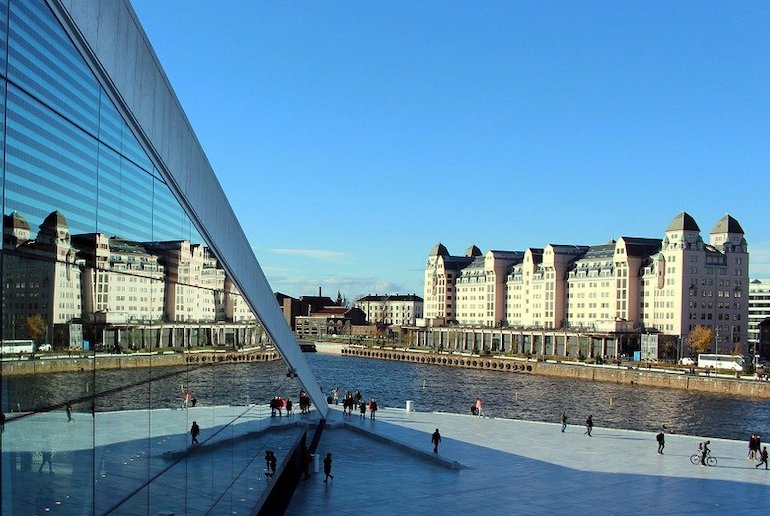
And Norway’s second city, Bergen is known as the capital of the fjords and is a great place for hiking in the mountains , kayak trips and exploring the breathtaking fjords .
Malmö in southern Sweden is Swedens’ third largest city, though it’s much closer to Copenhagen than the Swedish capital.
Host city of the 2024 Eurovision Song Contest, it’s an interesting, lively place, with plenty of museums, galleries, shops and nightlife to entertain.
Norway’s northernmost city, Tromsø is something of an year-round adventure centre, with loads of summer and winter activities including whale-watching tours , dog-sledding trips , kayaking and reindeer sleigh rides .
It also makes a great base for exploring the remote Lofoten islands .
Outdoor sports: Sweden vs Norway
Both countries have loads to offer adrenaline junkies, from para-gliding to glacier skiing and white-river rafting to ice-climbing.
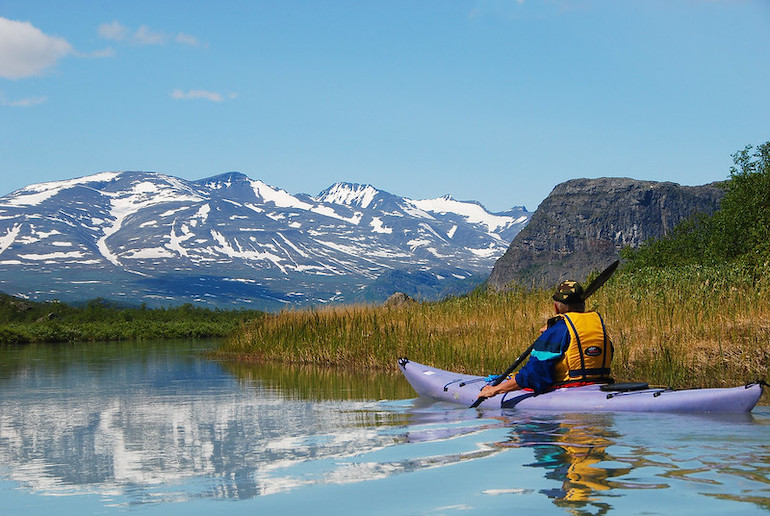
Norway is probably better for real extreme sports, simply because of its high mountains and dramatic scenery – check out some ideas here – though Sweden is better for lakeside camping and gentle paddling downriver in a kayak .
Hiking: Norway vs Sweden
Norway and Sweden both have some great hikes, so take your pick! Norway is good for steep hikes up high-drama peaks, where you can get your winning Insta pose – the trek up to Pulpit Rock is the classic example of this.
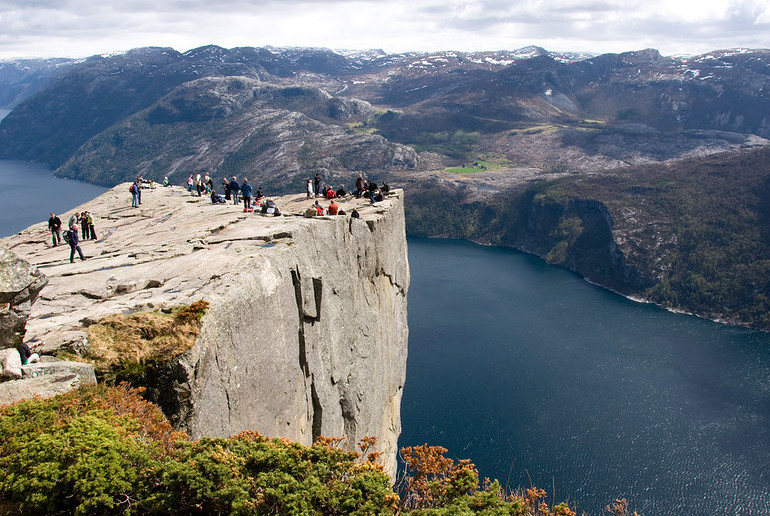
Sweden, meanwhile, has some amazing long-distance hikes, such as the Kingsleden , that wend their way through national parks, dramatic scenery and long stretches of wilderness. Check out our guides for more on hiking in Sweden and Norway .
The northern lights: Sweden or Norway?
Well, both Sweden and Norway have large parts of their landmass above the Arctic Circle, so both are pretty good places to view the amazing spectacle of the northern lights from late October to early March.
What you need for northern lights viewing is dark, clear skies, so Norway is good in terms of having wide swathes of uninhabited land with no light pollution.
Sweden meanwhile has a good infrastructure to get you to the wilderness and is probably a bit cheaper if you want to go on a guided tour.
Both countries run great guided tours to help you see the northern lights at their best, such as this one from Malören in Sweden and this one from Tromso in Norway .
For more on the best way to see the Northern lights, check out our comprehensive guides to watching them in Sweden and Norway .
Sweden vs Norway for skiing – which is best?
The short answer is both have fantastic skiing. Both countries have hosted the Winter Olympics – most recently Lillehammer in Norway in 1994 – both have some great ski resorts and both have miles and miles of pistes for cross-country and downhill skiing.
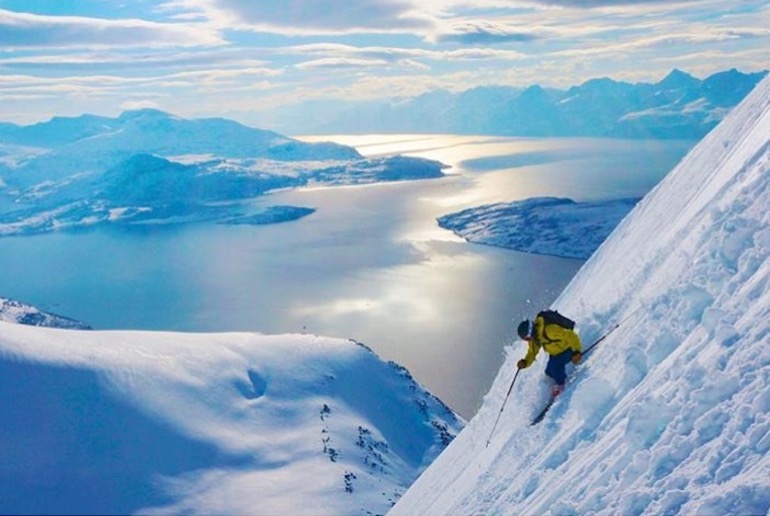
For more on skiing in Norway click here and for all the lowdown on skiing in Sweden click here and here .
Sweden vs Norway: activities
Which country is better for activities? Well, both countries offer a great range of winter and summer activities and tours.
So we’ve complied a table detailing what you can do in which country.
Sweden vs Norway: culture and traditions
Both counties have their own particular culture and traditions, but there are also several that they share.
Christmas, of course, is celebrated in both countries, with Swedes enjoying their julbord feasts and Norwegians eating ribbe (pork ribs) and lutefisk on Christmas Eve.
Both also share a strong Viking heritage. Sweden has plenty of Viking remains to see , while Norway is home to some beautifully preserved Viking longhouses .

Fika is a strong Swedish tradition of taking a break for a coffee and cinnamon with friends or alone. The practice is also common in Norway, though they don’t have a specific term for it.
Midsummer is celebrated in both countries , though it’s a bigger deal in Sweden, with dancing and drinking spreading over two days.
Norway’s National day is on May 17th and celebrates the country’s declaration of independence in 1817. It’s a public holiday with parades and partying taking place around the country.
Sweden’s National Day is on June 6th, and celebrates the date when Gustav Vasa was elected king in 1523, though it has only been a public holiday since 2005.
The main celebrations take place at Skansen , with the royal family attending for a day of parades, speeches, music and flag waving.
What about the prices?
Hotels, food, sightseeing… pretty much anything you’re likely to buy as a tourist will be cheaper in Sweden than in Norway.
And train travel in Norway is among the most expensive in Europe – second only to the UK – while fares in Sweden are more reasonable.
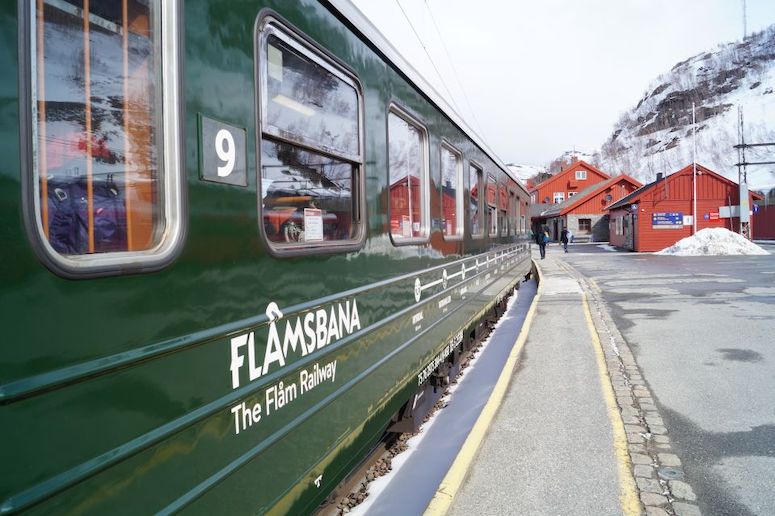
So while Norway trumps Sweden for certain things like natural beauty, wildlife tours and extreme sports , it can be an expensive place to explore properly.
Hey, even Norwegians have been known to hop over the border into Sweden for cut price booze and consumer goods!
In practice this means that, over the course of two-week vacation, visiting Norway could cost you hundreds of dollars more than an equivalent stay in Sweden.
That’s not to say that you shouldn’t visit Norway – it’s just that you should expect the prices to be higher.
You can compare the costs of everyday things like meals and transport in our guides to the cost of living in Norway and Sweden .
Which is safer: Sweden or Norway?
We’ve looked at the Norway vs Sweden crime rates, and the good news is both countries are pretty safe to travel around, with low crime rates and efficient, trustworthy police forces.
Norway comes out with lower crime rates overall, with a murder rate less than a third of its neighbour – ‘just’ 38 murders in the whole country in 2023 , compared to 116 in Sweden in 2022 (the latest figures available).
However, when you consider that Sweden’s population is almost double that of Norway, the difference doesn’t seem so marked.
So, despite all those Scandinavian crime dramas making it look like gory murders are around every corner, it’s actually a very safe place to live.
Is it better to live in Sweden or Norway?
And if you’re thinking of a long-term move to Scandinavia, it’s a big decision to make – where to live: Sweden or Norway?
So, we’ve checked out the pros and cons of living in Sweden vs Norway for you.
First of all, how much will you earn? What is the average salary in Sweden vs Norway?
The good news is that Norway and Sweden both have among the highest average salaries in the world.
Norwegians earn more at the equivalent of around $62,000 a year, while annual salaries in Sweden are the equivalent of around $46,000. However, Norway has a higher cost of living.
To find out more about what things cost, check out our guides on the cost of living in Sweden and Norway .
As for life expectancy, both countries rank in the world top 20 for long life.
Norway comes in at 14th with an average life expectancy of 82.3 years, while Sweden just pips it at 11th, with Swedes living an average of 82.7 years.
Is Sweden or Norway richer?
This is a tricky one because it depends how you measure it. In terms of GDP, Sweden is richer because its GDP in 2023 was the equivalent of $US577 billion as opposed to Norway’s, which was $US435 billion.
However, if you factor in the population, Sweden’s GDP was $US55,200 per capita, while Norway’s was $US99,000 per capita – making Norway richer per head of population.
So, is Sweden better than Norway?
Now we’ve given you all the facts and figures it’s up to you to decide!
Both countries have good points and bad points, but as far as we’re concerned they’re both pretty amazing places to visit, and whichever you chose we’re sure you won’t be disappointed.
So, our advice is to visit both!
See also: The best time to visit Sweden The best time to visit Norway 21 things you should know before visiting Norway

Scandinavian Christmas decor: the coolest decorations from the Nordic countries
You may also like.
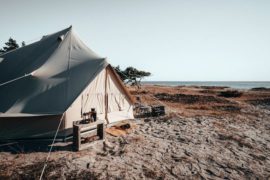
Glamping in Scandinavia – the best luxury campsites to try
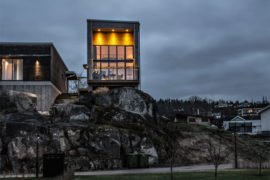
10 of the coolest, whackiest Airbnbs in Scandinavia
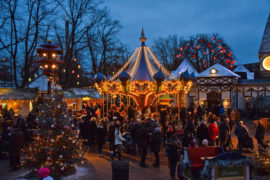
12 magical Christmas markets in Scandinavia (2023 update!)
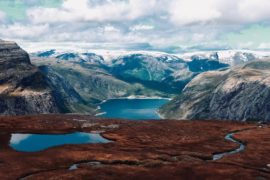
What is the Scandinavian Peninsula?
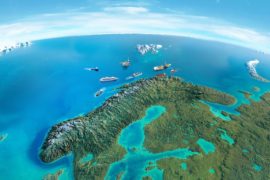
What is Fennoscandia, and where is it?
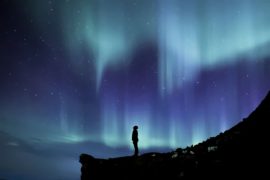
A quick guide to the Scandinavian countries
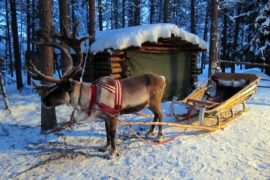
Christmas tours in Scandinavia
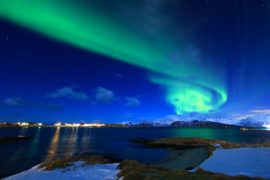
Where to see the northern lights in Scandinavia
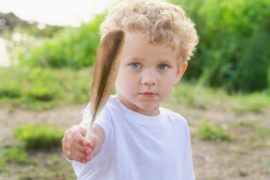
Fun, cute Scandinavian boy names
Get the Routes North newsletter delivered once a month. No spam.

Norway vs Iceland An Honest Comparison To Help You Choose
Planning a Nordic adventure? If so, you might find yourself hesitating about which country to visit. Iceland and Norway are two of the very best options, famed for their majestic natural landscapes, friendly people, unique cultures, and fantastic attractions. But which one is best to visit?
Well, that’s not an easy question to answer, and a lot will depend on your own personal tastes and preferences. Norway and Iceland may have some similarities, but they’re also surprisingly different locations in a lot of ways, especially in key aspects, like affordability, attractions, big city entertainment, and so on.
There’s also a massive difference in size, with Norway being significantly more expanse – and with a much larger population – than Iceland. And this may impact your experience, with Norway feeling like a busier and livelier place overall, and Iceland appealing to those who want nothing but peace and quiet, from the hustle and bustle of busier nations.
All in all, there are quite a lot of differences separating Norway and Iceland, and this guide will dig into some of the big ones. We’ll look at how the countries compare in a range of key areas, from their cities and activities to their hiking opportunities, average costs, weather conditions, and more. By the end, you’ll hopefully know all you need to know to make your choice.
A Quick Overview Of Norway vs Iceland
Which has the best weather, which is best for activities, which is best for cities, which is best for hiking and nature, which is best for nightlife, which is best for shopping, which is best for food, which is best for families, which is best for couples, which is best for backpackers.
- Which Is Cheapest?
Where To Stay According To Your Budget
Norway vs iceland: which is better.
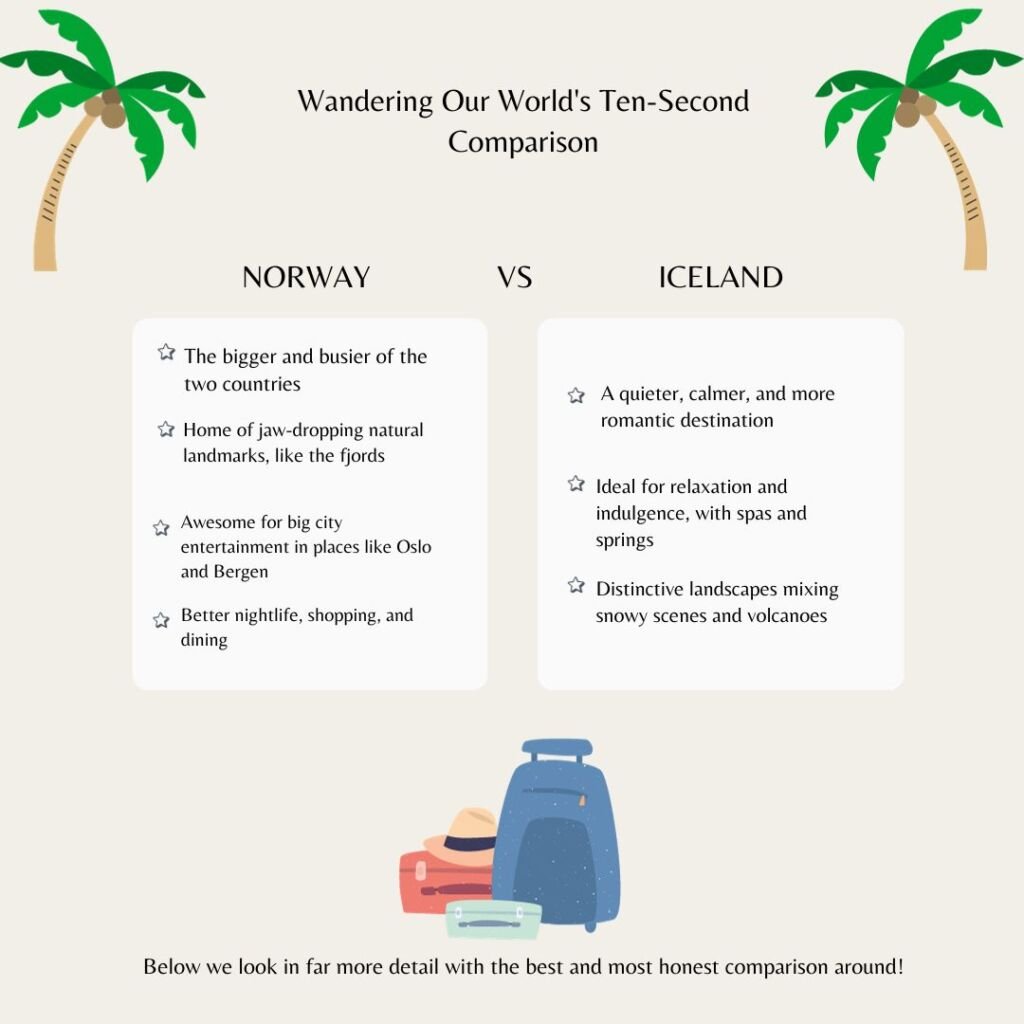
Norway: A Quick Overview
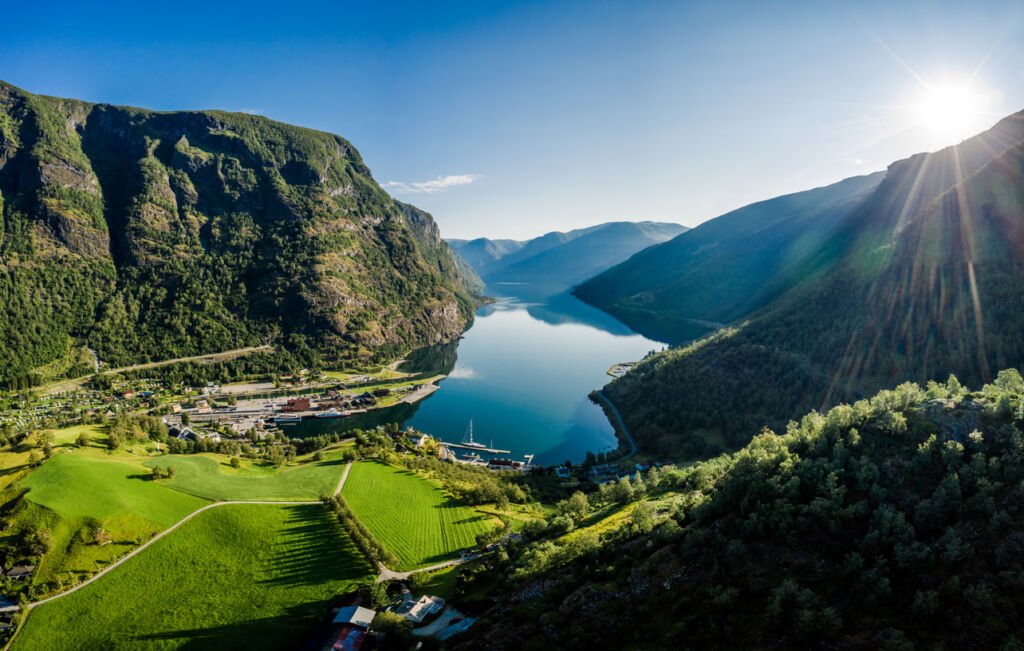
Norway is a Nordic country in Northern Europe, mostly situated on the Scandinavian Peninsula, with smaller sections on the archipelago of Svalbard and the little Arctic island of Jan Mayen . In total, Norway extends across 148,729 square miles, and it’s home to almost 5.5 million people. It has borders with Sweden, Finland, and Russia.
Norway as we know it today has existed for over 1,100 years. Before that, the land was controlled by a multitude of petty kingdoms, which decided to form one unified nation in 872. The country’s past is also strongly associated with the famous Vikings, and many people head to Norway to learn about Viking culture, with multiple interesting museums to explore .
Geographically, Norway is well-known for its striking fjords – long, narrow stretches of water that pass between steep cliffs, formed by glaciers long ago. The country also has approximately 400,000 lakes, and large parts of its landmass are covered in mountains. This makes it a prime destination for outdoor adventures, like hiking and climbing .
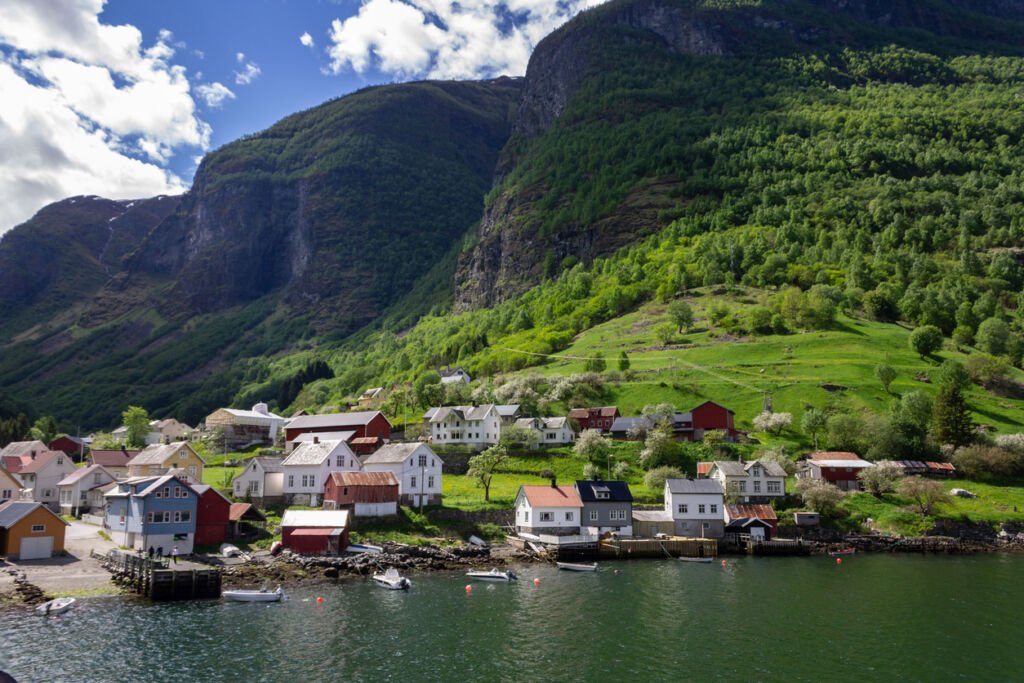
And, while many people flock to Norway to soak up its scenic landscapes and explore the mountains and fjords , there’s much more to uncover about this country, from its surprisingly diverse culinary scene to its rich cities, like Oslo and Bergen, which are fantastic places to shop, dine, and have fu n. All in all, Norway offers a terrific blend of natural and urban entertainment.
Iceland: A Quick Overview
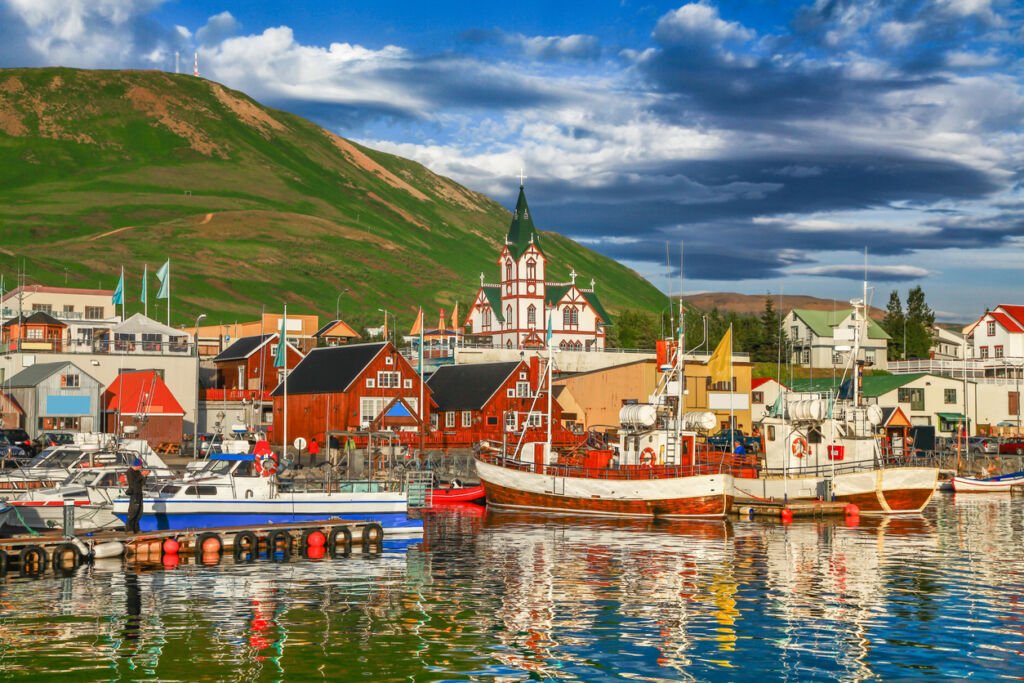
Iceland is an island country and part of the Nordic group of nations, situated between the North Atlantic and Arctic Ocean, just off the southeast coast of Greenland. It extends across 39,817 square miles of land and is home to around 380,000 people, with over a third of the country’s population living in the capital city of Reykjavik.
According to historic records and findings, it’s believed that Viking explorers came to Iceland in the 870s, with many Norwegians later settling on the island. It was an independent commonwealth for many years, later becoming united with Norway and other Scandinavian nations and finally gaining independence in the 20th century.
The second-biggest island in Europe, Iceland is made up mostly of tundra and is famed for its impressive volcanic landscape. Indeed, a vast volcanic plateau covers the island’s interior, with lava fields, mountains, black sands, and natural hot springs. Like Norway, Iceland also has a series of fjords along its more than 3,000 mile coastline.
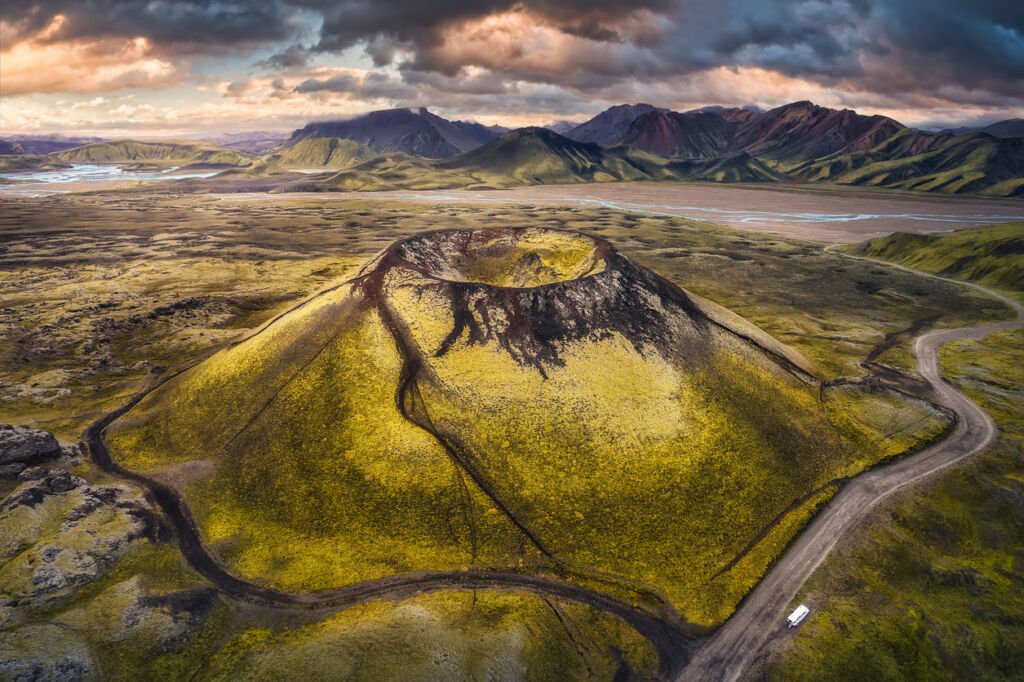
Thanks to its small size and sparse population, Iceland is a very unique destination, with a completely chilled-out vibe that many travelers enjoy. It feels far from the hustle and bustle of other destinations, and even its biggest city, Reykjavik, is a wonderfully tranquil and calming place, appealing to couples and off-the-beaten-path adventurers.
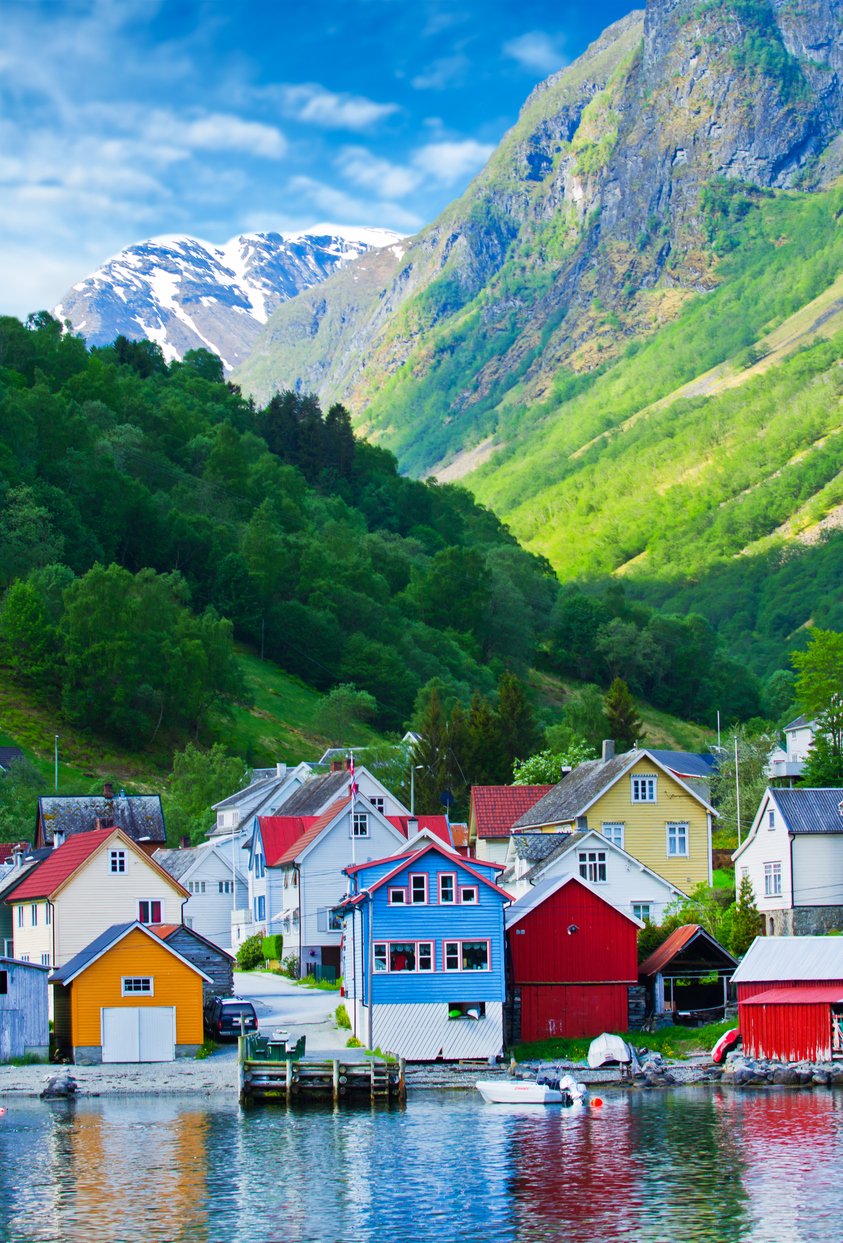
Since both Norway and Iceland are in the Nordic region, you shouldn’t head to either of these countries except warm temperatures and sunny days. They’re both quite cold places for large parts of the year, but there are some clear climate differences between the two.
In Iceland, expect to find cold temperatures and plenty of rain pretty much all year long. In Norway, however, while temperatures are also quite low for large parts of the year , many parts of the country, including the capital of Oslo, get to experience a real summer, with quite warm highs and pleasant conditions for spending time outside.
Overall, Norway has slightly better weather than Iceland in general, but it all depends on which part of the country you visit and what time of year you plan your trip.
One of the big selling points of Norway and Iceland – and the other Nordic nations – is the vast array of special activities you can enjoy in this part of the world. However, given their differing landscapes and conditions, these two countries each offer their own unique range of things to see and do.
Norway: The Activities
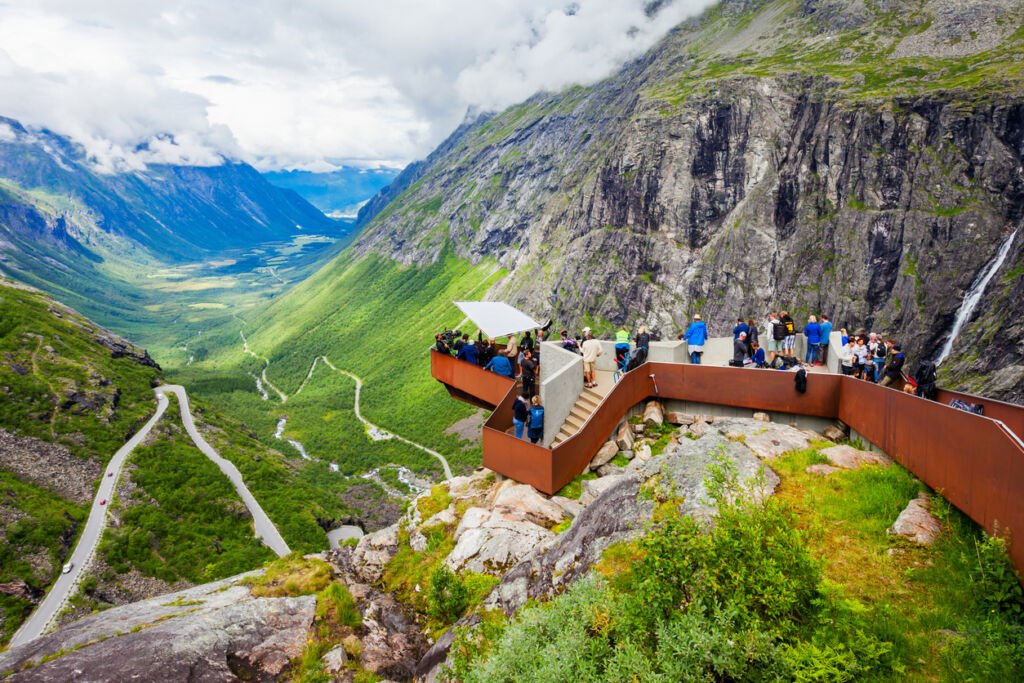
It’s impossible to talk about the best things to do in Norway without mentioning the iconic fjords, so let’s start there. Many visitors to this country will want to dedicate at least a day or two of their trips to seeing the fjords. You can hike around them, take a cruise, or ride a ferry – either way, you’re sure to be wowed by the intense beauty of these amazing natural spaces.
But there’s much more to Norway than its fjords. The mountains, too, are thrilling places to explore. If you love to hike, you’ll find countless named and signposted trails around, ranging from family-friendly national park paths to much trickier treks. Skiing is popular here, as well, or you could consider a road trip along Norway’s many scenic roads, like Trollstigen.
Want to learn more about Norway’s past, especially the Vikings and the rich heritage of the Norsemen? If so, Norway is replete with museums that can teach you all about that legendary seafaring civilization, with the Viking Ship Museum in Oslo being one of the best places to start. There are also plenty more museums in Oslo, Bergen, and other cities.
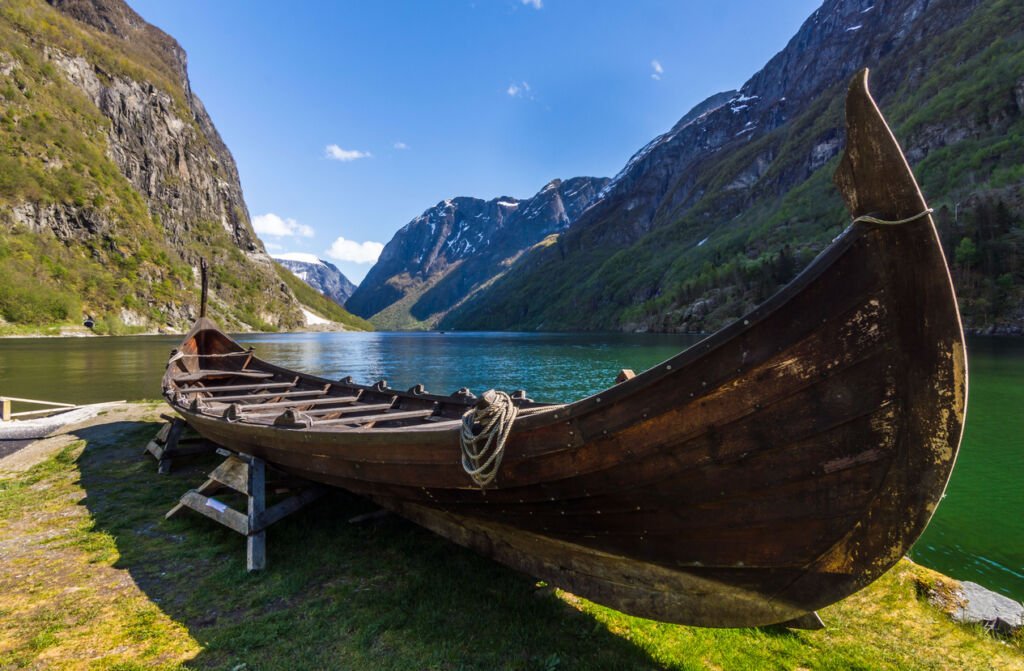
Speaking of cities and towns, Norway is also excellent for urban exploration. Oslo is the perfect place to embrace Norwegian lifestyles , but there are so many more places to see beyond the capital, and many of them are absolutely worth checking out, with pretty homes, friendly locals, great food, and unique attractions the whole family can enjoy.
Iceland: The Activities
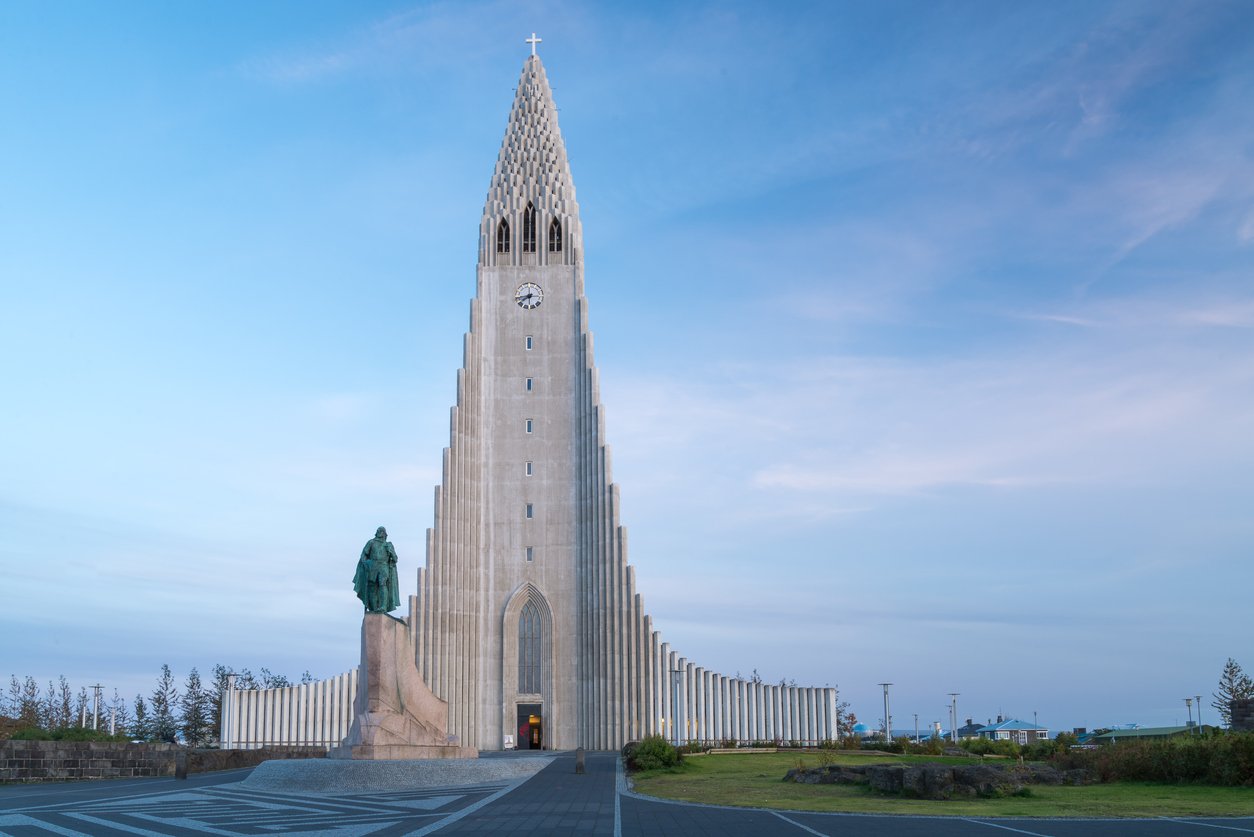
If you’re heading to Iceland, you’ll probably want to start off in the country’s biggest city, Reykjavik. That’s where you’ll be able to see some distinctive Icelandic landmarks, like the Hallgrimskirkja Church and Harpa Concert Hall. This is also home to Iceland’s best museums for those want to educate themselves on Icelandic culture and history.
However, Iceland is much more about natural landscapes than big cities. If you’re coming to this part of the world, you’ll most likely want to set off and see the majesty of Mother Nature firsthand. The iconic Golden Circle is a must-see – this is a 186-mile route that visits the country’s prettiest natural spots, like the Gullfoss Waterfall and Thingvellir National Park .
Iceland has many other great natural spaces to uncover. There’s Asbyrgi Canyon, which is so beautiful that it was said to have been forged by the gods , as well as Vatnajokull National Park, home of some of the country’s most diverse landscapes, like forests, glacial streams, and lava fields – it’s essentially a microcosm of everything that makes Iceland so unique.

Given that Iceland is so sparsely-populated, you can feel more or less entirely alone exploring the country’s natural spaces. It’s perfect for couples seeking romance or photographers looking for that perfect shot. It’s also a dream location for wildlife – you can seek out reindeer, go on a whale-watching trip, or even try spotting Arctic foxes and other creatures.
Overall, there’s plenty to enjoy in both of these countries. Norway certainly has more to offer, especially in terms of towns and cities, but Iceland is a dream-come-true for nature lovers or those seeking peace and escape from everyday life.

When it comes to cities, it’s almost unfair to compare Norway and Iceland. The former is so much bigger than the latter, and it has a lot more cities to choose from, thanks to its population, which is around 14 times larger than that of Iceland. However, even plucky little Iceland still has a couple of great cities that are absolutely worth visiting.
The most famous Icelandic city, and the one that most people will want to see, is the capital, Reykjavik. It’s by far the biggest city in the country, sitting on Iceland’s western coast, and it’s got quite a few interesting landmarks, like the Saga Museum and the beautiful Hallgrimskirkja church, as well as relaxing spas and an emerging dining scene .
Other towns and cities you might like to add to your Iceland travel itinerary include Akureyri and Selfoss. Akureyri is the capital of North Iceland and offers charming botanical gardens and its own awesome church, designed by the same architect behind the Hallgrimskirkja , while Selfoss almost feels like an open-air museum with its historic center and beautiful old buildings.
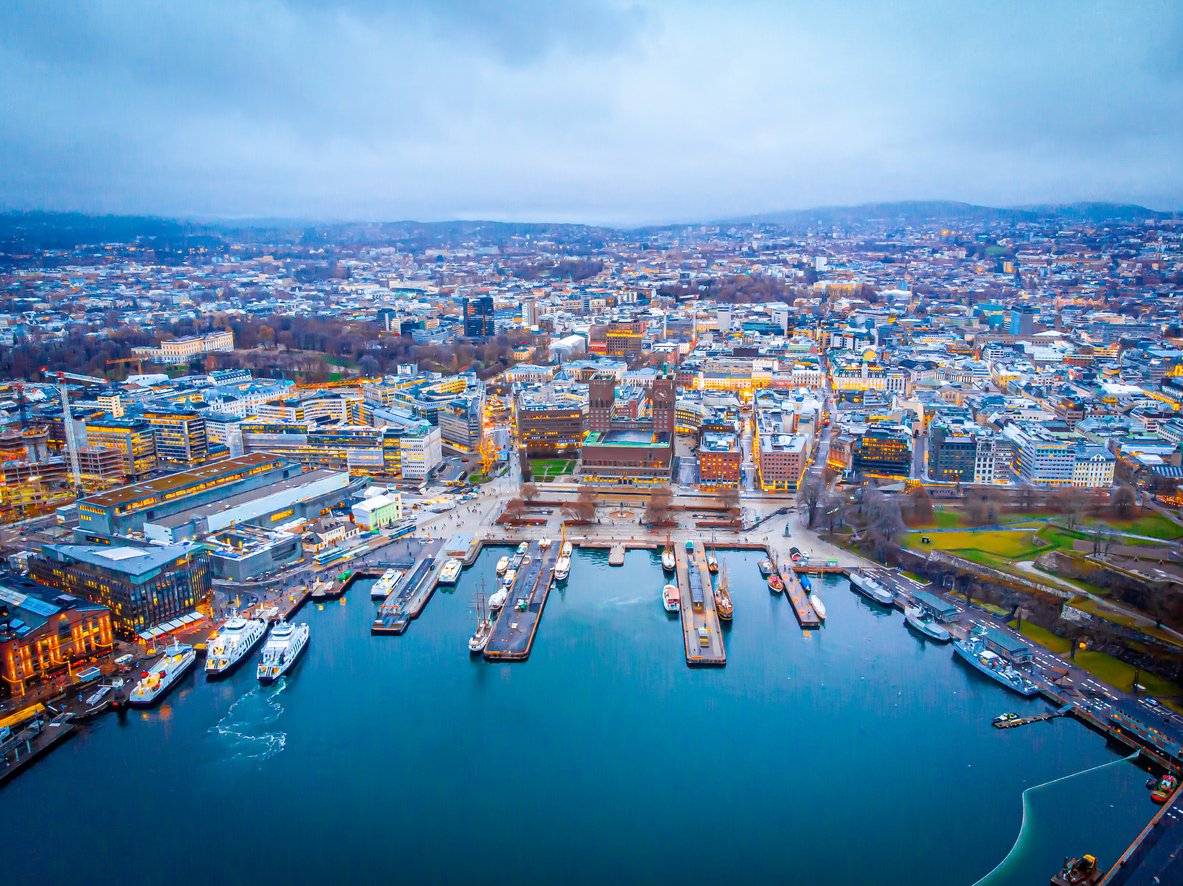
If you’re heading to Norway, you’ll find much bigger, busier, and livelier cities to explore, with a wider range of attractions to enjoy. The capital, Oslo, is the perfect place to embrace Norwegian culture, with awesome shopping and dining opportunities, as well as live entertainment and lots of cultural activities .
Bergen, the second-biggest Norwegain city, is also worth checking out for its cute, colorful homes and fairy-tale vibes , while Geiranger is an amazing mountain town, Flam is an adorable little village with jaw-dropping views, Alesund is filled with art nouveau architecture, and Tromso is the perfect place to see the Northern Lights.
Overall, when it comes to towns and cities, Norway is definitely the better option. It’s got lots more urban areas to explore, with plenty more to see and do compared to Iceland.

Thanks to their world-famous scenic landscapes, Norway and Iceland are often sought-out by outdoor adventurers, hikers, and nature lovers. Large parts of these countries are covered in pristine wilderness, and there are some spectacular natural places to see, like Norway’s iconic fjords and Iceland’s hot springs and geysers .
As the larger country, Norway has more to offer in terms of large natural spaces, and since so much of the land here is mountainous, it’s a hiker’s paradise. Wherever you go, you’re sure to find a trail to follow, with many of Norway’s paths being well-marked and signposted for accessibility . The fjords are also unmissable, and Norway has world-class ski resorts, too .
In Iceland, it’s a little trickier to find hiking trails, as they’re not as well-marked as those in Norway, but there are still plenty of paths to find and follow. Nicknamed the “Land of Ice and Fire,” Iceland also has really diverse scenery, with volcanic black-sand beaches and lava fields interspersed with cozy hot springs and icy expanses .
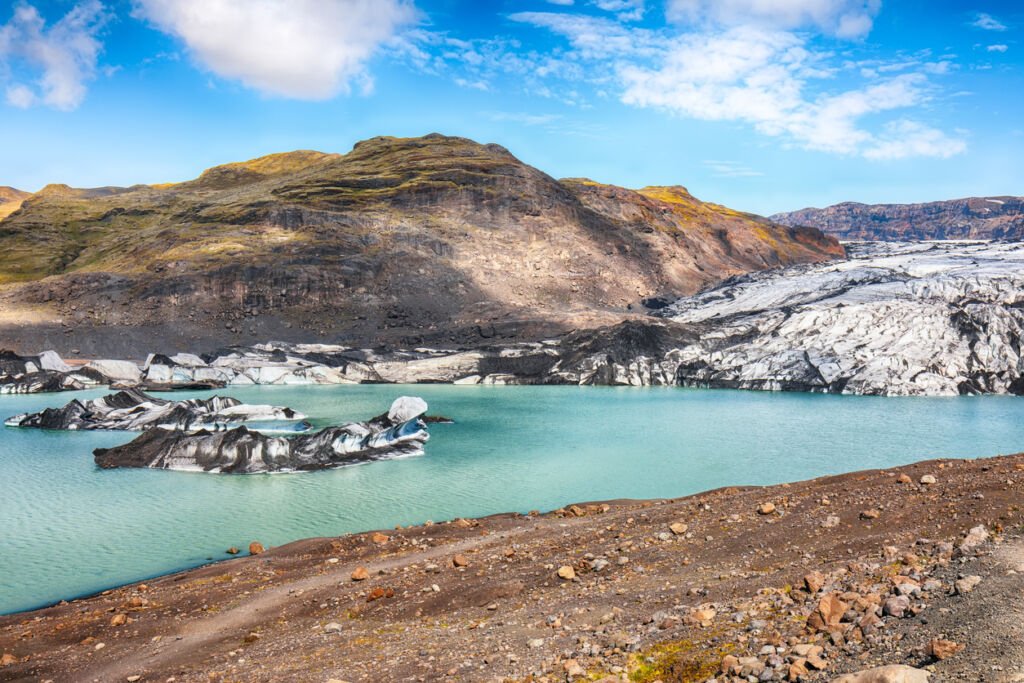
Overall, Norway is better for hiking and most other outdoor activities, and its fjords are pretty enough to rival anything Iceland can offer. With that said, Iceland still has a lot of visually impressive landscapes, with geysers, mud baths, and secret waterfalls to discover .
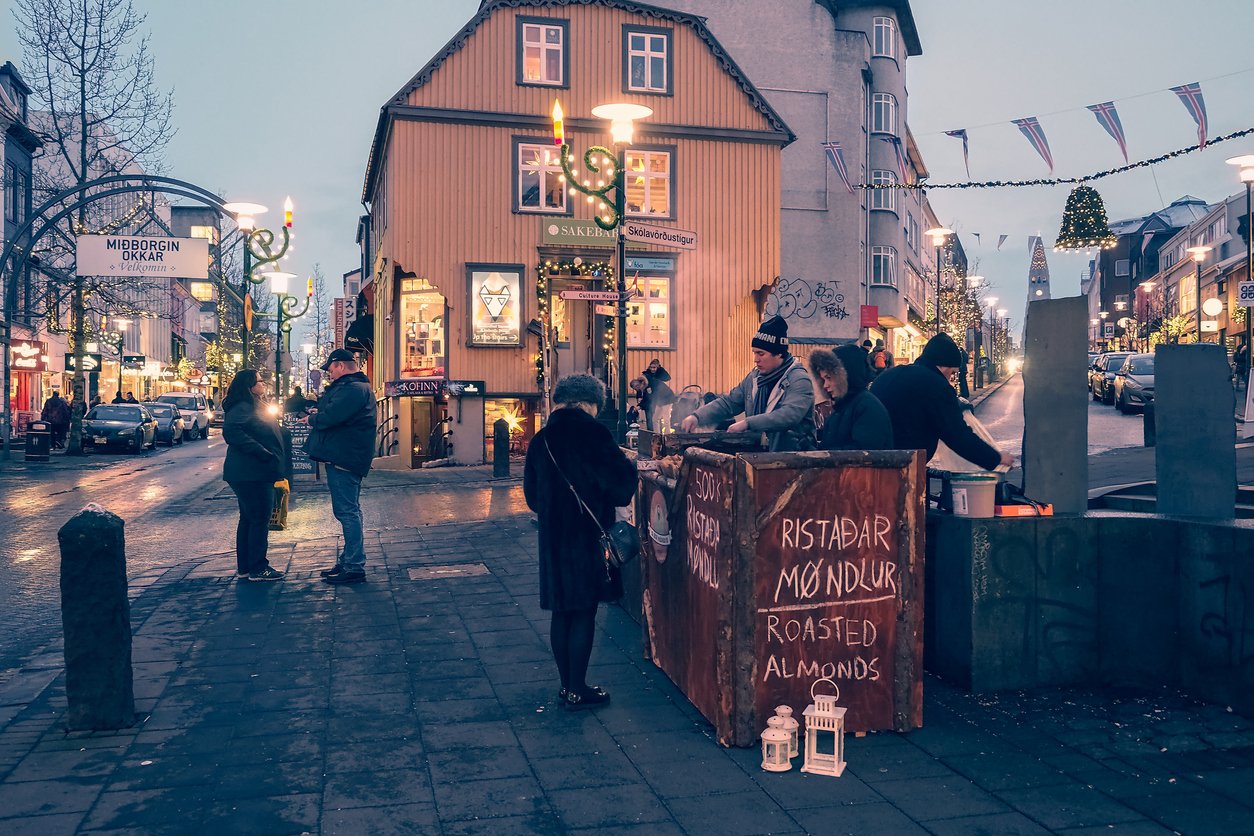
If you love staying out late, visiting clubs and bars to mingle with the locals or party into the early hours, Iceland, or more specifically Reykjavik, is a great place to go. The Icelandic capital has rapidly emerged in recent years as one of the top party cities of all the Nordic nations, with a growing lineup of thumping clubs and exciting dance spots staying open to the early hours.
Whether you’re looking for a cozy wine bar, a trendy craft pub, or a crazy dance club with live DJ performances, you can find it all here . Of course, it’s not quite as wild or raucous as some of Europe’s bigger cities, due to the relatively small population, but it’s still not a bad place to party. Unfortunately, outside of Reykjavik, Iceland doesn’t have any other notable nightlife cities.
Norway’s nightlife scene is busier and bigger, with a wider range of places to party, drink, dance, and have fun . As you might expect, Oslo is the top spot for evening excitement, with the busy Norwegian capital boasting a long list of cocktail bars, trendy pubs, and wild music venues to keep you entertained well into the night (or the early hours of the next day).
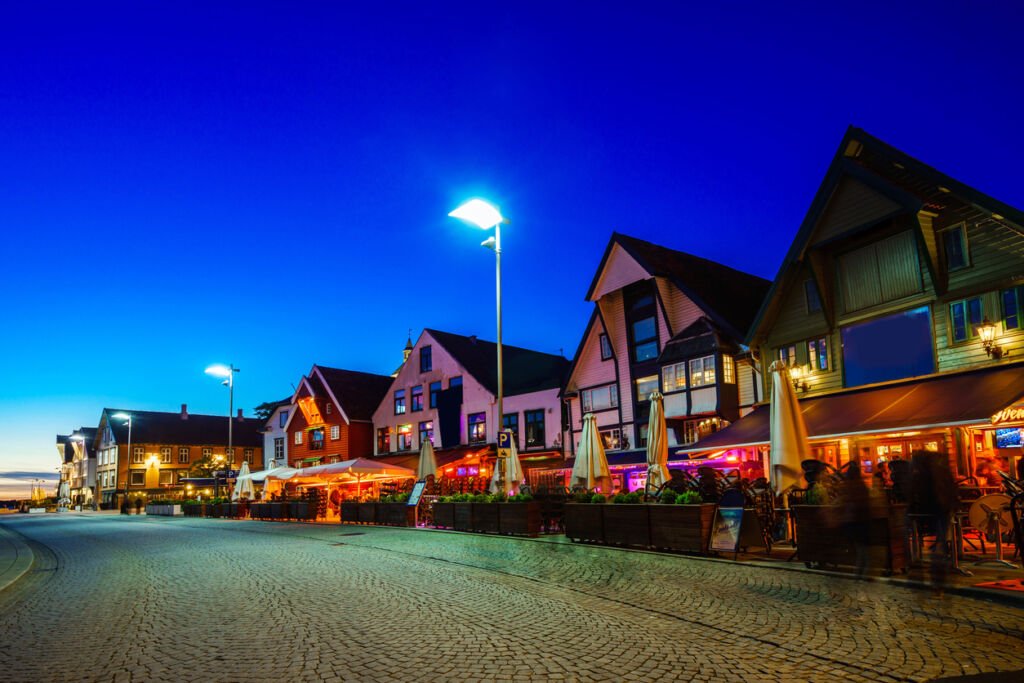
The big thing that makes Norway better for nightlife than Iceland is that it has other great places to party beyond the capital. Bergen, Trondheim, Stavanga, and Tromso can all claim to have impressive nightlife scenes, with dozens of pleasant bars and dynamic dance clubs for travelers of all ages.
Overall then, Norway is the nightlife king, but Iceland isn’t too bad if you don’t mind a much smaller and less hectic scene.
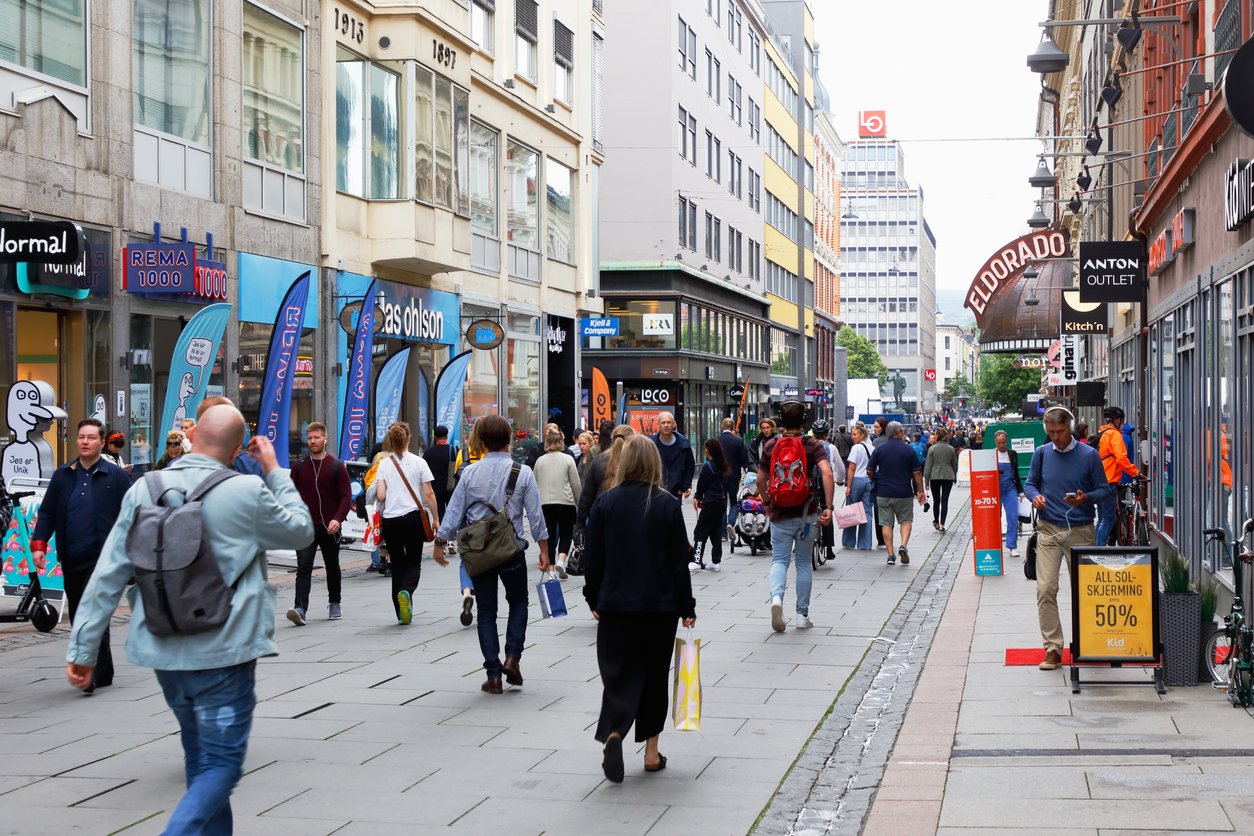
Shopping is another area in which the Norway vs Iceland comparison is quite easy to call. Since Norway has a much larger population and many more towns and cities, it’s got a far deeper shopping scene compared to Iceland. There are lots of places to shop here, and plenty of interesting products to buy, from high-end fashion to hand-crafted gifts .
Once again, Oslo is the main place to shop in Norway. The Norwegian capital has more than enough boutiques, malls, and markets to fill an entire week of shopping fun, like the vast Oslo City shopping center and eclectic Arkaden mall . Other cities, like Bergen and Stavanger, are also terrific for shopping, with lots of indie stores and ateliers.
In Iceland, Reykjavik is the primary shopping hub. And, despite being a relatively small city compared to Oslo, it’s packed full of stores to please all sorts of shoppers. From quirky bookshops to home décor galleries, cute kids’ shops, and traditional soouvenir stores, there’s lots to see here, and you shouldn’t have any trouble grabbing some mementos to take home .

Overall, Norway certainly has the superior shopping scene, with much bigger malls and centers to explore, but Iceland has the benefit of being much quieter and calmer , which can provide quite pleasant, relaxing experiences when you’re browsing the boutiques and roaming the streets of Reykjavik.

Food-wise, the clash between Norwegian and Icelandic cuisine is an intriguing one, and everyone will have their own opinion. Both countries offer a delicious selection of traditional dishes and delights to tantalize your taste buds , but you may prefer the flavors and menus of one country over the other.
In Iceland, the cuisine is built around easily accessible local ingredients, including fish, lamb, and dairy products. There are lots of cured meat and seafood dishes on the menu, and popular meals include “Humar”, or Icelandic lobster, and “Laufabraud”, which is a traditional festive flatbread.
Over in Norway, fish is the main element on most menus, and Norway is known as a global leader in smoked salmon. Lots of Norwegian dishes also revolve around game meats, like moose and reindeer, and Norway has many delicious meals like meatballs, stews, creamy seafood soups, and poached fish.

Overall, there’s more diversity on offer in Norway, and even if you’re not a fan of the traditional cuisine, Norway’s cities have plenty of other foods, from pizza and sushi to tacos and pasta, perfect for the varying tastes of travelers from around the world . Over in Iceland, while the traditional food is quite tasty, it’s harder to find other options.
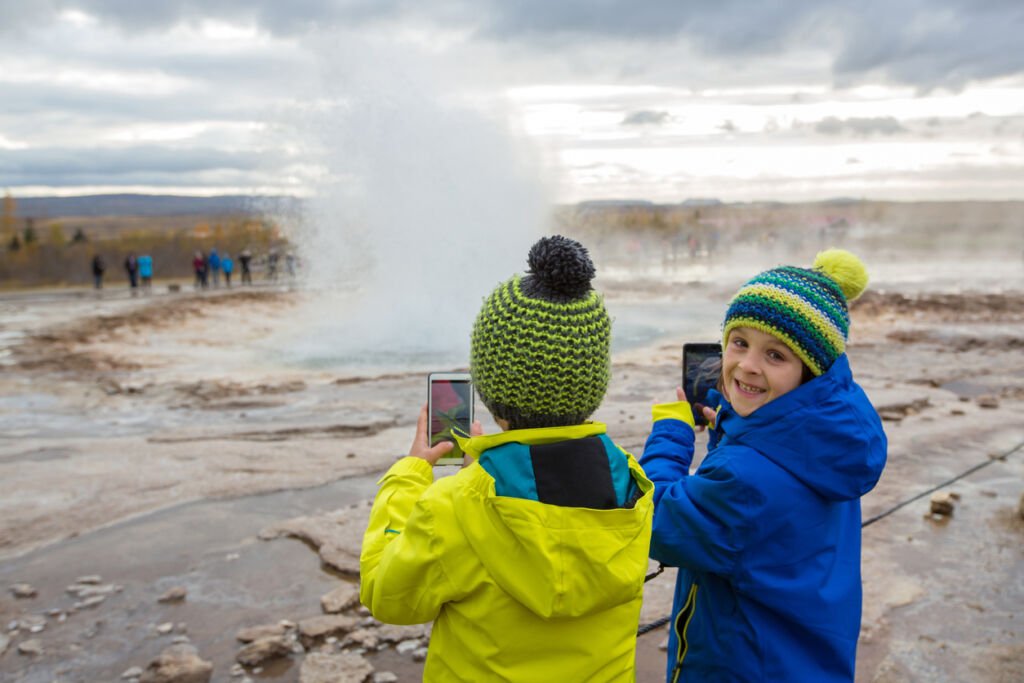
Iceland and Norway are both excellent destinations to consider for a family vacation, with both offering their own unique advantages for parents and kids alike.
Iceland has the big benefit of being smaller, which makes it easier and faster to get around and see the sights – that could be helpful if you’ve got little children who can quickly get bored on long journeys. There are also lots of family-friendly tours and activities in Iceland, like Golden Circle tours, hot spring dips, whale-watching, and horseriding.
Norway is a dream destination for families, with attractions and activities to suit kids of any age. Families can enjoy all sorts of fun here, from trips to the fjords to hikes in the mountains, steam railway rides, theme parks, canyoneering adventures, dog sledding in the snow, whale-watching, zoos, aquariums, and so on.

Overall, with its much wider range of activities, Norway is the superior country for most families. There’s lots here to keep kids happy, regardless of their age or interest . Iceland’s range of activities is a little narrower.
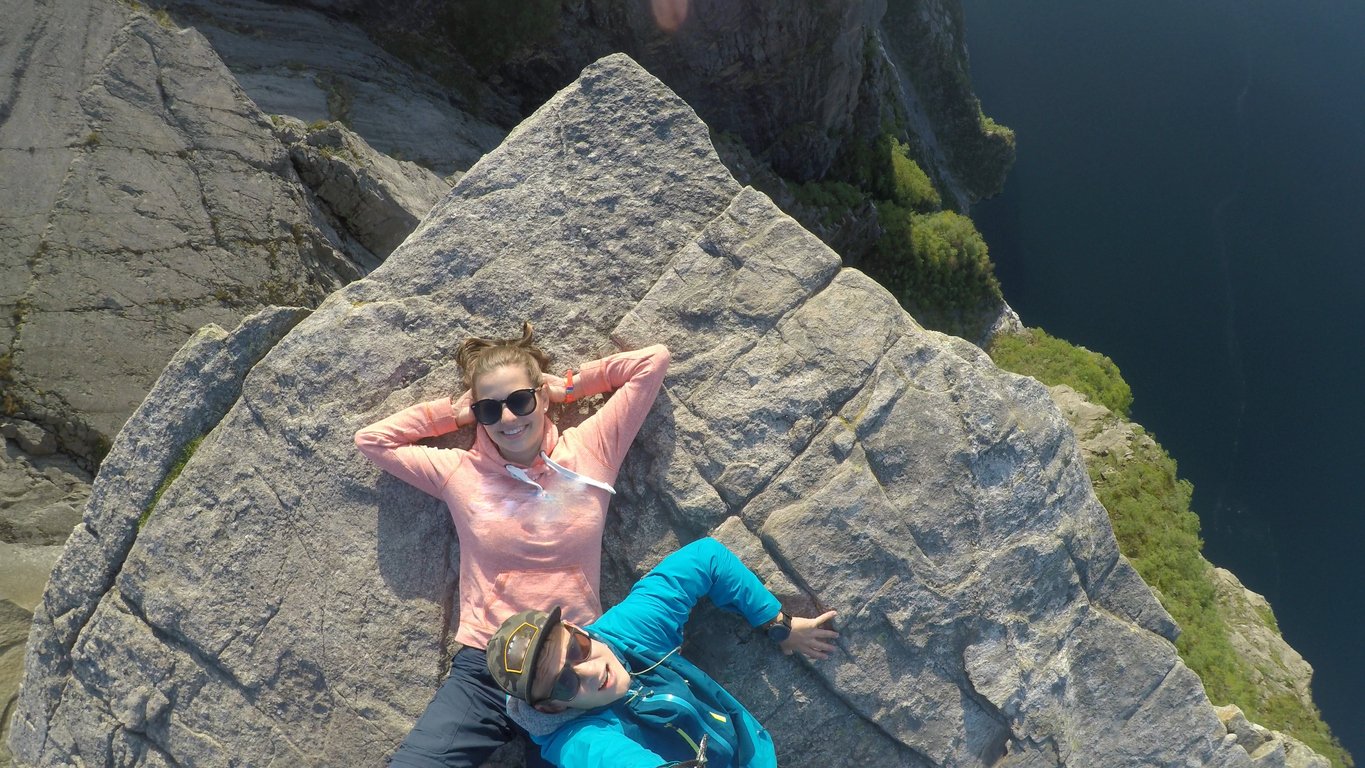
Planning a Nordic honeymoon or anniversary trip? Or perhaps you and your partner are looking for a special part of the world to escape to for just a few days? Either way, Norway and Iceland are fine spots to consider, especially for those who prefer cooler climates and natural adventures over the usual honeymoon beach resorts.
Norway’s fjords are some of the most romantic places on the planet, and there’s nothing quite like admiring those spectacular water and mountain views hand-in-hand with your partner. There are also lots more lovers’ activities to enjoy, from snow hotel nights to alpine skiing, river cruises, and lots of charming, quaint towns and villages .
In Iceland, couples can have a more relaxing time, indulging in the soothing spas, hot springs, and mud baths, or set out and explore the volcanic landscapes, touring lava fields and watching geysers in action. There’s not quite as much to do overall, but for shorter stays and more quiet, peaceful experiences, Iceland’s the place to be.
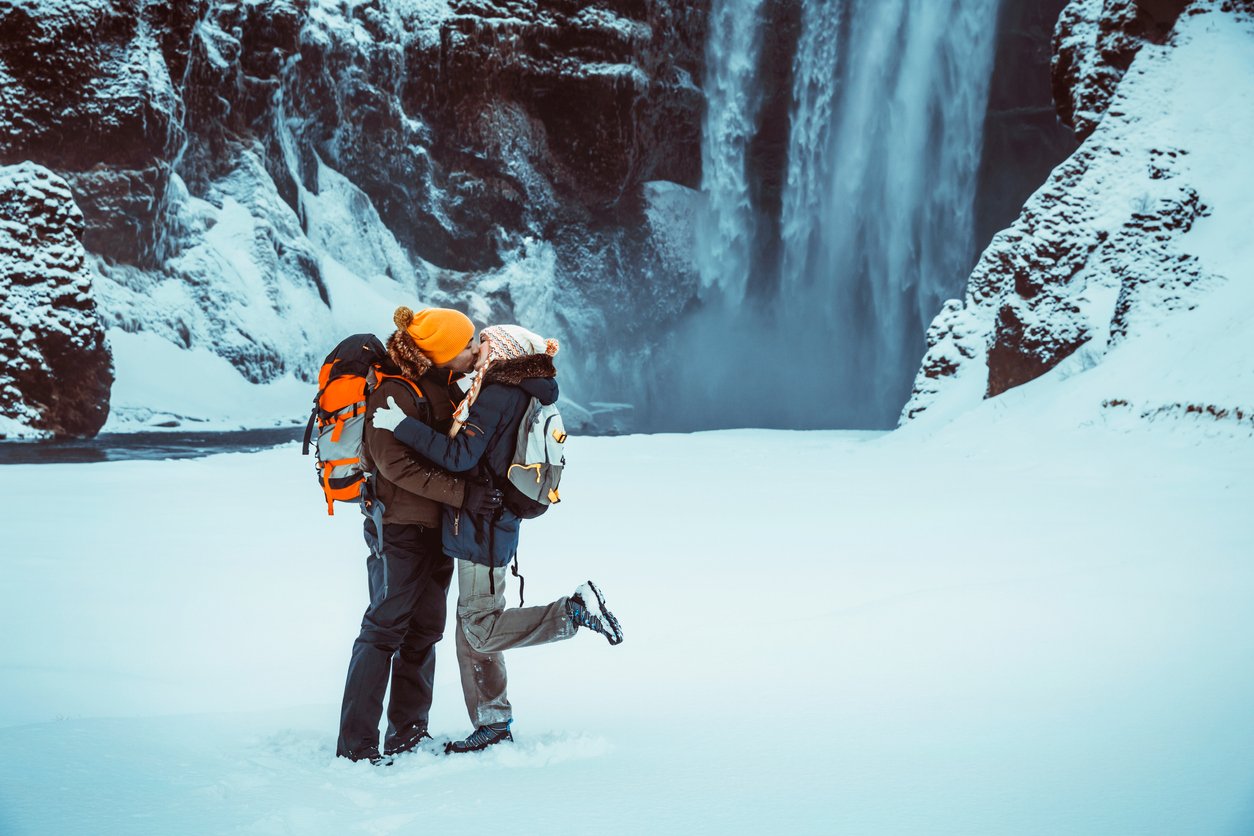
Overall, the best option for you will depend on tastes and interests. Norway is best for diversity, hiking, and action-packed trips with lots to see and enjoy. Iceland is better if you want a calming, laid-back escape.
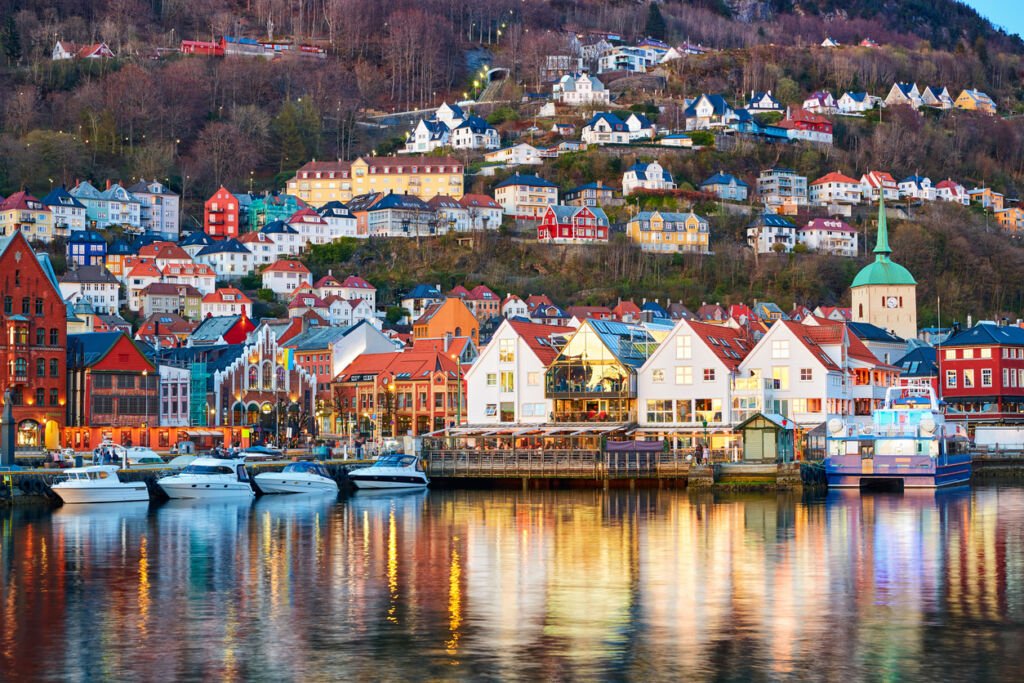
Backpackers can enjoy exciting adventures in Norway and Iceland, and both of these destinations rank among the best backpacking spots in all of Northern Europe.
Iceland has the benefit of being a little cheaper. It’s still not exactly an affordable destination, but if you’re on a tight budget, you should find it easier to plan a trip to Iceland without overspending. It’s also smaller and quieter, which may appeal to those seeking that laid-back, off-the-beaten-path vibe.
While Norway might be a little pricier, it’s got more to see and do. The cities are bigger and more engaging, with lots of museums and other cultural activities, and there are more natural spaces to enjoy, with hiking trails, lakes, mountains, and the famous fjords . So, if you want more of a fulfilling trip, with a mix of urban entertainment and natural delights, head to Norway.
Which Is Cheaper?
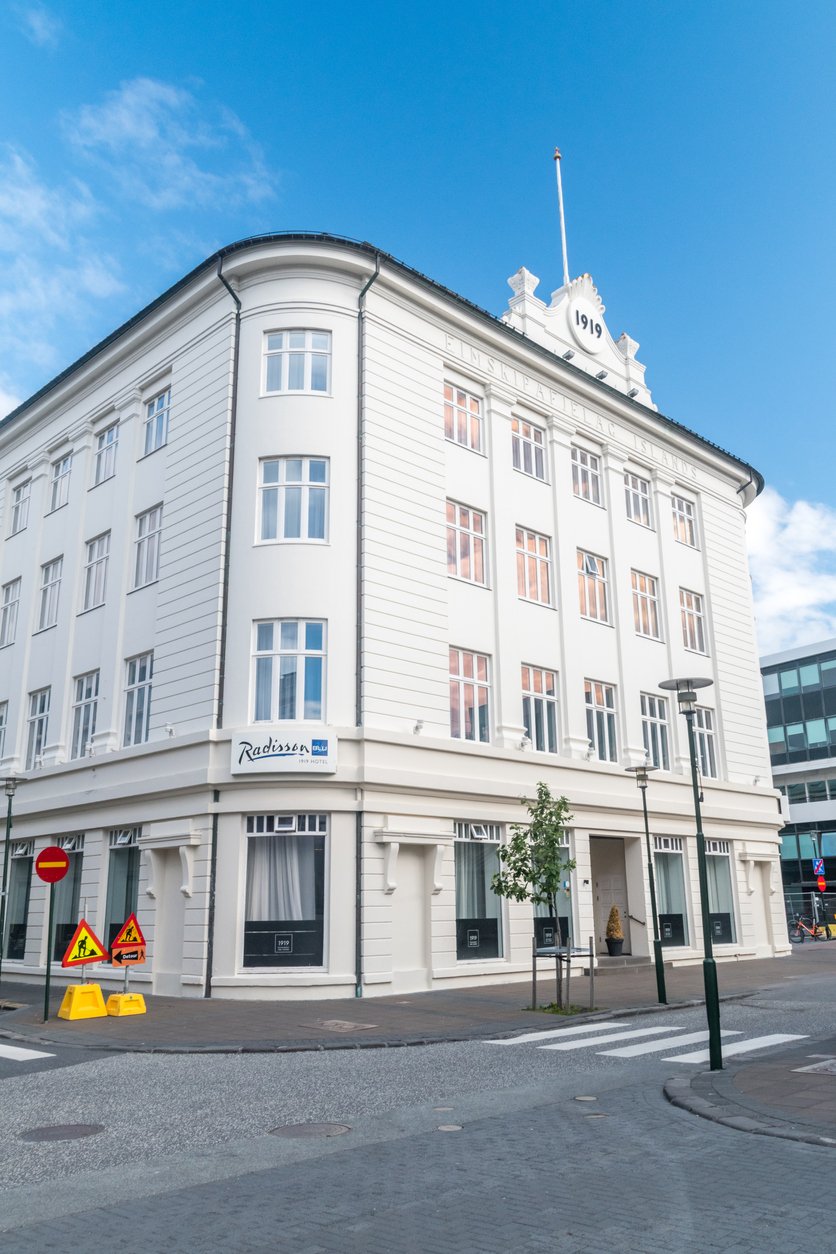
When it comes to cost, Norway and Iceland are both quite pricey compared to most other parts of Europe . Indeed, the entire Nordic region is relatively expensive to explore, with high prices for food, accommodation, and more. But, if you want to save cash, Iceland is a little cheaper overall, with more affordable hotels and food, for the most part.
Budget: Zander K Hotel in Norway is a beacon of modern elegance. With sleek architecture and expansive windows, it bathes interiors in natural light. The chic design seamlessly blends with Nordic aesthetics, creating a harmonious ambiance. A beautiful fusion of style and comfort, the hotel is a captivating retreat in the heart of Norway.
Luxury: Britannia Hotel in Norway is a true masterpiece of opulence. The historic grandeur of its architecture is adorned with intricate details, reflecting timeless elegance. Luxurious interiors boast sumptuous decor, creating an enchanting atmosphere. From regal chandeliers to plush furnishings, Britannia Hotel is a symphony of beauty and refined luxury.
Budget: Siglo Hotel by Keahotels in Iceland is a coastal gem. Nestled against the backdrop of majestic mountains, it exudes Nordic charm. Architectural elegance meets natural beauty, with large windows framing breathtaking views of the sea. Inside, chic design harmonizes with the surrounding landscape, creating an enchanting and serene retreat.
Luxury: The Retreat at Blue Lagoon , Iceland, is a haven of sublime luxury. Nestled in a lava field, the architecture seamlessly blends with the raw beauty of the surroundings. A tranquil lagoon, surrounded by moss-covered rocks, invites serenity. The interiors, marked by modern elegance, offer an immersive and captivating experience.
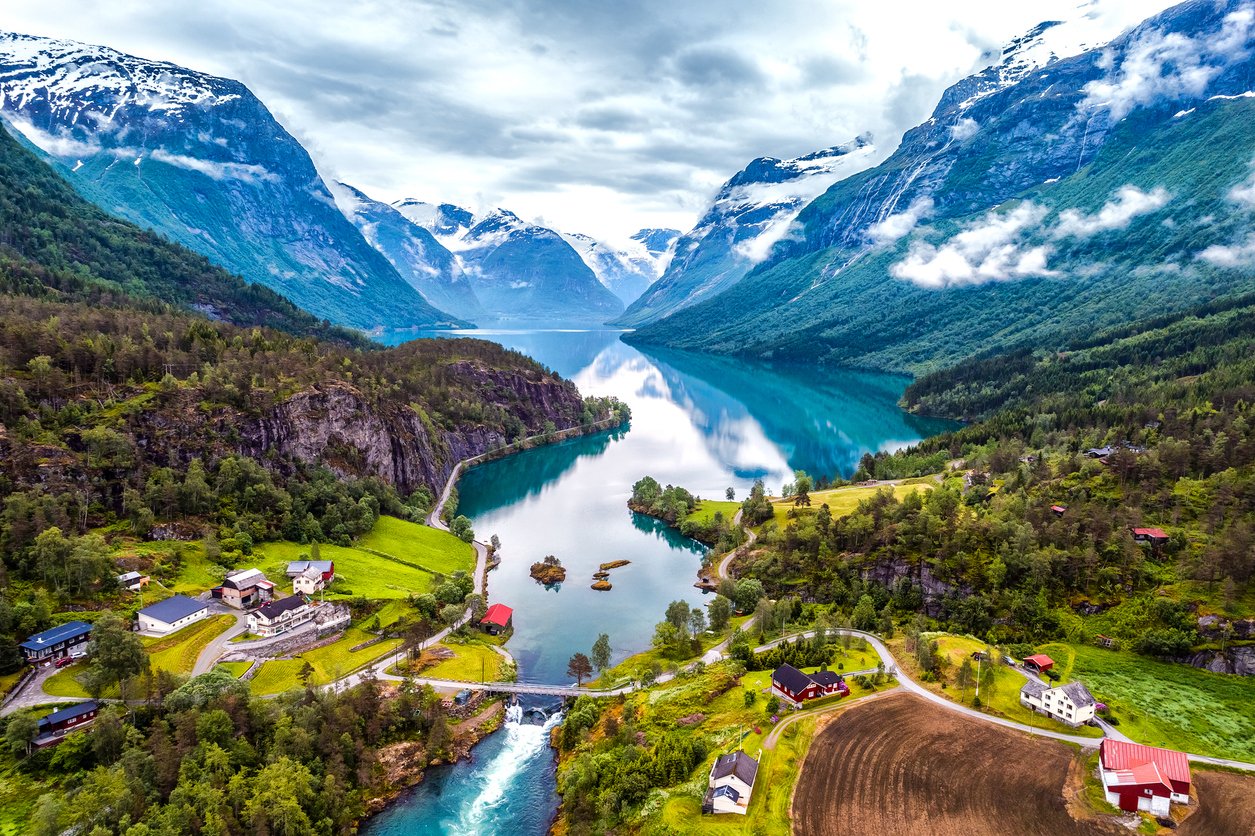
Overall, it’s impossible to say that one of these countries is simply better than the other. They’re both beautiful, wondrous places in more ways than one. And, if you have the time, budget, and ability to do so, it’s best to try to see both of them. But, if you’re only able to see one for the time being, Norway is probably the right choice.
Norway wins this contest simply for being a bigger, more diverse, and more engaging destination overall. With its wider range of landscapes and attractions, it can appeal to travelers of all tastes. You can learn about Viking history, admire the majestic fjords, explore quaint towns and cities, eat fantastic food, and so much more.
At the same time, while Iceland might not have won this battle, it’s still worth considering if you’re looking for a Nordic adventure. It’s got some of the most distinctive and impressive landscapes on earth, with that fascinating blend of icy glacial spaces and fiery volcanic lava fields providing a truly special allure that few other places can match .

Related Posts

Iceland or Greenland: Which One Is Better to Visit
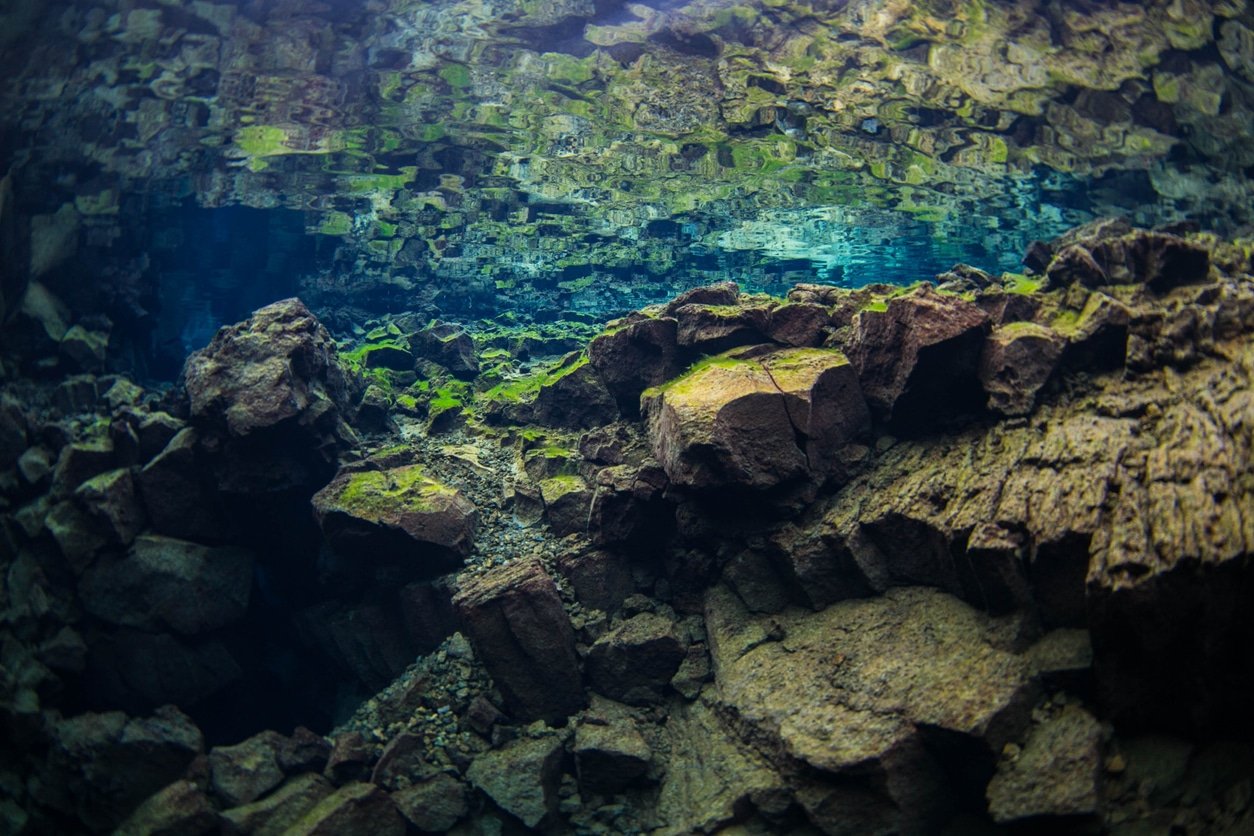
A Local’s Guide to Snorkeling in Iceland: Conditions, What to Expect & More!

Lorem ipsum dolor sit amet, consectetur adipisicing elit sed.
Follow us on
Compare key data on Denmark & Norway
- Country Info
- Denmark vs. Norway
Definitions
- Cost of living > Average monthly disposable salary > After tax : Average Monthly Disposable Salary (After Tax). Based on 0-50 contributions for Afghanistan, Aland Islands, Andorra and 81 more countries and 50-100 contributions for Albania, Algeria, Armenia and 19 more countries and over 100 contributions for Argentina, Australia, Austria and 82 more countries. The surveys were conducted by numbeo.com from May, 2011 to February, 2014. See this sample survey for the United States , respondents were asked "Average Monthly Disposable Salary (After Tax)". Prices in current USD.
- Crime > Crime levels : Level of crime. Based on 0-50 contributions for Afghanistan, Albania, Algeria and 82 more countries and 50-100 contributions for Argentina, Belgium, Bulgaria and 24 more countries and over 100 contributions for Australia, Brazil, Canada and 17 more countries. The surveys were conducted by numbeo.com from July, 2011 to February, 2014. See this sample survey for the United States , respondents were asked "How serious you feel the level of crime is?". The higher the value, the more survey respondents believe it is high in their country.
- Crime > Murder rate : Homicide rate per year per 100,000 inhabitants in various countries.
- Crime > Rape rate : Number of rape incidents per 100,000 citizens in different countries. Figures do not take into account rape incidents that go unreported to the police.
- Crime > Violent crime > Intentional homicide rate : Homicides per 100’000 residents. Homicide is the death of a person purposefully inflicted by another person (it excludes suicides) outside of a state of war. Homicide is a broader category than murder, as it also includes manslaughter. The exact legal definition varies across countries, some of which include infanticide, assisted suicide, euthanasia and deaths caused by dangerous driving.
- Crime > Violent crime > Murder rate : Intentional homicide, number and rate per 100,000 population.
- Crime > Violent crime > Murder rate per million people : Intentional homicide, number and rate per 100,000 population. Figures expressed per million people for the same year.
- Economy > GDP : GDP at purchaser's prices is the sum of gross value added by all resident producers in the economy plus any product taxes and minus any subsidies not included in the value of the products. It is calculated without making deductions for depreciation of fabricated assets or for depletion and degradation of natural resources. Data are in current U.S. dollars. Dollar figures for GDP are converted from domestic currencies using single year official exchange rates. For a few countries where the official exchange rate does not reflect the rate effectively applied to actual foreign exchange transactions, an alternative conversion factor is used.
- Economy > GDP per capita : GDP at purchaser's prices is the sum of gross value added by all resident producers in the economy plus any product taxes and minus any subsidies not included in the value of the products. It is calculated without making deductions for depreciation of fabricated assets or for depletion and degradation of natural resources. Data are in current U.S. dollars. Dollar figures for GDP are converted from domestic currencies using single year official exchange rates. For a few countries where the official exchange rate does not reflect the rate effectively applied to actual foreign exchange transactions, an alternative conversion factor is used. Figures expressed per capita for the same year.
- Economy > Gross National Income : GNI, Atlas method (current US$). GNI (formerly GNP) is the sum of value added by all resident producers plus any product taxes (less subsidies ) not included in the valuation of output plus net receipts of primary income (compensation of employees and prop).
- Geography > Land area > Square miles : Country land area.
- Government > Government type : A description of the basic form of government (e.g., republic, constitutional monarchy, federal republic, parliamentary democracy, military dictatorship).
- Government > Legal system : A brief description of the legal system's historical roots, role in government, and acceptance of International Court of Justice (ICJ) jurisdiction.
- Health > Physicians > Per 1,000 people : Physicians are defined as graduates of any facility or school of medicine who are working in the country in any medical field (practice, teaching, research).
- People > Population : Population, total refers to the total population.
- Military > Air force > Combat aircraft : Number of fighter aircrafts (fixed wing aircrafts with combat capability).
- People > Age distribution > Population aged 0-14 : Percentage of total population aged 0-14.
- Health > Births and maternity > Total fertility rate : Total fertility rate.
- Geography > Area > Comparative : The area of various small countries expressed in comparison to various areas within the United States of America.
- Crime > Violent crime > Gun crime > Guns per 100 residents : Number of privately owned small firearms per 100 residents.
- Crime > Age of criminal responsibility : The age at which a person is no longer excluded from criminal liability. The lowest age is indicated for countries where there isn’t a single age limit, for example where different states have different regulations (such as the USA) or there is different limits for boy and girls (such as in Iran). The spectrum is specifically wide for the USA and Mexico (both 6-12 years). Several US states do not stipulate any minimal age for criminal responsibility at all. For further qualifications, exceptions and other notes, please refer to notes .
- Economy > Budget surplus > + or deficit > - : This entry records the difference between national government revenues and expenditures, expressed as a percent of GDP. A positive (+) number indicates that revenues exceeded expenditures (a budget surplus), while a negative (-) number indicates the reverse (a budget deficit). Normalizing the data, by dividing the budget balance by GDP, enables easy comparisons across countries and indicates whether a national government saves or borrows money. Countries with high budget deficits (relative to their GDPs) generally have more difficulty raising funds to finance expenditures, than those with lower deficits.
- Geography > Climate : A brief description of typical weather regimes throughout the year.
- Crime > Suicide rates > Suicide rate (both sexes) : Suicides per 100’000 residents per year.
- Crime > Violent crime > Rapes per million people : The number of recorded rapes. Large numbers of rapes go unreported. South Africa is estimated to have 500,000 rapes per year, Egypt 200,000, China 32,000 and the UK with 85,000 rapes per year. Figures expressed per million people for the same year.
- Geography > Area > Land : Total land area in square kilometres
- Government > Legislative branch : This entry contains information on the structure (unicameral, bicameral, tricameral), formal name, number of seats, and term of office. Elections includes the nature of election process or accession to power, date of the last election, and date of the next election. Election results includes the percent of vote and/or number of seats held by each party in the last election.
- Geography > Geographic coordinates : This entry includes rounded latitude and longitude figures for the purpose of finding the approximate geographic center of an entity and is based on the Gazetteer of Conventional Names, Third Edition, August 1988, US Board on Geographic Names and on other sources.
- Religion > Religions : This entry includes a rank ordering of religions by adherents starting with the largest group and sometimes includes the percent of total population .
- Cost of living > Local purchasing power : Local Purchasing Power shows relative purchasing power in buying goods and services in a given city for the average wage in that city. If domestic purchasing power is 40, this means that the inhabitants of that city with the average salary can afford to buy 60% less typical goods and services than New York City residents with an average salary.
- People > Population > Population growth, past and future : Population growth rate (percentage).
- Military > Army > Main battle tanks : Number of main battle tanks.
- Cost of living > Prices at markets > Cigarettes > Pack of Marlboro : Based on 0-50 contributions for Afghanistan, Aland Islands, Andorra and 81 more countries and 50-100 contributions for Albania, Algeria, Armenia and 19 more countries and over 100 contributions for Argentina, Australia, Austria and 82 more countries. The surveys were conducted by numbeo.com from May, 2011 to February, 2014 ( sample survey for the United States) . Respondents were asked about the price of a Pack of Cigarettes (Marlboro). Prices in current USD.
- Environment > Marine fish catch : Total marine fish catch Units: Metric Tons
- Economy > Unemployment rate : This entry contains the percent of the labor force that is without jobs. Substantial underemployment might be noted.
- Health > Human height > Average female height : Average female height.
- People > Ethnic groups : This entry provides a rank ordering of ethnic groups starting with the largest and normally includes the percent of total population.
- Government > Suffrage : The age at enfranchisement and whether the right to vote is universal or restricted
- Geography > Area > Total : Total area in square kilometers
- People > Age distribution > Population aged 15-24 > Percent : Percentage of total population aged 15-24.
- Crime > Police officers : Number of police officers per 100,000 population.
- Government > Constitution : The dates of adoption, revisions, and major amendments to a nation's constitution
- Agriculture > Arable land > Hectares : Arable land (in hectares) includes land defined by the FAO as land under temporary crops (double-cropped areas are counted once), temporary meadows for mowing or for pasture, land under market or kitchen gardens, and land temporarily fallow. Land abandoned as a result of shifting cultivation is excluded.
- Crime > Total crimes : Note : Crime statistics are often better indicators of prevalence of law enforcement and willingness to report crime , than actual prevalence.
- Crime > Drugs > Annual cannabis use : Estimate of percentage of 15-64 year old population who use Cannabis.
No date was available from the Wikipedia article, so we used the date of retrieval.
- Crime > Violent crime > Rapes : The number of recorded rapes. Large numbers of rapes go unreported. South Africa is estimated to have 500,000 rapes per year, Egypt 200,000, China 32,000 and the UK with 85,000 rapes per year.
- Government > Judicial branch : The name(s) of the highest court(s) and a brief description of the selection process for members.
- Education > Children out of school, primary : Children out of school, primary. Out-of-school children of primary school age. Total is the total number of primary-school-age children who are not enrolled in either primary or secondary schools.
- Economy > GDP > Purchasing power parity per capita : This entry gives the gross domestic product (GDP) or value of all final goods and services produced within a nation in a given year. A nation's GDP at purchasing power parity (PPP) exchange rates is the sum value of all goods and services produced in the country valued at prices prevailing in the United States. This is the measure most economists prefer when looking at per-capita welfare and when comparing living conditions or use of resources across countries. The measure is difficult to compute, as a US dollar value has to be assigned to all goods and services in the country regardless of whether these goods and services have a direct equivalent in the United States (for example, the value of an ox-cart or non-US military equipment); as a result, PPP estimates for some countries are based on a small and sometimes different set of goods and services. In addition, many countries do not formally participate in the World Bank's PPP project that calculates these measures, so the resulting GDP estimates for these countries may lack precision. For many developing countries, PPP-based GDP measures are multiples of the official exchange rate (OER) measure. The difference between the OER- and PPP-denominated GDP values for most of the weathly industrialized countries are generally much smaller. Figures expressed per capita for the same year.
- Geography > Land area > Sq. km : Land area is a country's total area, excluding area under inland water bodies, national claims to continental shelf, and exclusive economic zones. In most cases the definition of inland water bodies includes major rivers and lakes."
- People > Birth rate : The average annual number of births during a year per 1,000 persons in the population at midyear; also known as crude birth rate. The birth rate is usually the dominant factor in determining the rate of population growth. It depends on both the level of fertility and the age structure of the population.
- Crime > Drugs > Opiates use : Annual prevalence.
- Crime > Total crimes per 1000 : Note : Crime statistics are often better indicators of prevalence of law enforcement and willingness to report crime , than actual prevalence. Figures expressed per thousand population for the same year.
- People > Population growth : Percentage by which country's population either has increased or is estimated to increase. Countries with a decrease in population are signified by a negative percentage. Future estimates are from the UN Population Division.
- Education > Pupil-teacher ratio, primary : Pupil-teacher ratio, primary. Pupil-teacher ratio. Primary is the number of pupils enrolled in primary school divided by the number of primary school teachers.
- Economy > Budget > Revenues : Revenues calculated on an exchange rate basis, i.e., not in purchasing power parity (PPP) terms
- People > Age distribution > Median age : The median age of the country's residents. This is the age most people are in the country.
- Economy > GDP > Per capita > PPP : This entry shows GDP on a purchasing power parity basis divided by population as of 1 July for the same year.
- Industry > Manufacturing output : Industry corresponds to ISIC divisions 10-45 and includes manufacturing (ISIC divisions 15-37). It comprises value added in mining, manufacturing (also reported as a separate subgroup), construction, electricity, water, and gas. Value added is the net output of a sector after adding up all outputs and subtracting intermediate inputs. It is calculated without making deductions for depreciation of fabricated assets or depletion and degradation of natural resources. The origin of value added is determined by the International Standard Industrial Classification (ISIC), revision 3. Data are in constant 2000 U.S. dollars."
- Crime > Justice system > Punishment > Capital punishment (last execution year) : Year of last use.
- Government > Political parties and leaders : Significant political organizations and their leaders.
- Energy > Commercial energy use : Commercial energy use ( kg of oil equivalent per capita). Commercial energy use refers to apparent consumption, which is equal to indigenous production plus imports and stock changes, minus exports and fuels supplied to ships and aircraft engaged in international transport.
- Health > Human height > Average male height : Average male height.
- Economy > Economy > Overview : This entry briefly describes the type of economy , including the degree of market orientation, the level of economic development, the most important natural resources , and the unique areas of specialization. It also characterizes major economic events and policy changes in the most recent 12 months and may include a statement about one or two key future macroeconomic trends.
- Crime > Violent crime > Murders per million people : Intentional homicide, number and rate per 100,000 population. Figures expressed per million people for the same year.
- Economy > Exports : This entry provides the total US dollar amount of merchandise exports on an f.o.b. (free on board) basis. These figures are calculated on an exchange rate basis, i.e., not in purchasing power parity (PPP) terms.
- Crime > Violent crime > Murders : Intentional homicide, number and rate per 100,000 population.
- Government > Executive branch > Cabinet : Cabinet includes the official name for any body of high-ranking advisers roughly comparable to a U.S. Cabinet. Also notes the method for selection of members.
- Health > Hospital beds > Per 1,000 people : Hospital beds include inpatient beds available in public, private, general, and specialized hospitals and rehabilitation centers. In most cases beds for both acute and chronic care are included.
- People > Marriage, divorce and children > Total divorces per thousand people : Total number of divorces in given year by country. Figures expressed per thousand people for the same year.
- Education > Compulsary education duration : Number of years students are required to be enrolled in school for all levels of education. For instance, compulsary education lasts for 12 years in the United States.
- People > Gender > Female population : Total female population.
- People > Age distribution > Population aged 0-14 > Total : Number of people aged 0-14.
- Education > Homeschooling legal status : Legal status of homeschooling.
- Military > Budget : Annual defense budget in billion USD.
- Economy > GDP > Per capita : This entry gives the gross domestic product (GDP) or value of all final goods and services produced within a nation in a given year. A nation's GDP at purchasing power parity (PPP) exchange rates is the sum value of all goods and services produced in the country valued at prices prevailing in the United States. This is the measure most economists prefer when looking at per-capita welfare and when comparing living conditions or use of resources across countries. The measure is difficult to compute, as a US dollar value has to be assigned to all goods and services in the country regardless of whether these goods and services have a direct equivalent in the United States (for example, the value of an ox-cart or non-US military equipment); as a result, PPP estimates for some countries are based on a small and sometimes different set of goods and services. In addition, many countries do not formally participate in the World Bank's PPP project that calculates these measures, so the resulting GDP estimates for these countries may lack precision. For many developing countries, PPP-based GDP measures are multiples of the official exchange rate (OER) measure. The difference between the OER- and PPP-denominated GDP values for most of the weathly industrialized countries are generally much smaller. Per capita figures expressed per 1 population.
- Agriculture > Rural population : Total population living in rural areas. Future estimates are from the UN Population Division.
- People > Mother's mean age at first birth : This entry provides the mean (average) age of mothers at the birth of their first child. It is a useful indicator for gauging the success of family planning programs aiming to reduce maternal mortality, increase contraceptive use – particularly among married and unmarried adolescents, delay age at first marriage, and improve the health of newborns.
- Energy > Electricity > Consumption > Per capita : Total electricity consumed annually plus imports and minus exports, expressed in kilowatt-hours. The discrepancy between the amount of electricity generated and/or imported and the amount consumed and/or exported is accounted for as loss in transmission and distribution. Per capita figures expressed per 1 population.
- People > Death rate : The average annual number of deaths during a year per 1,000 population at midyear; also known as crude death rate. The death rate, while only a rough indicator of the mortality situation in a country, accurately indicates the current mortality impact on population growth. This indicator is significantly affected by age distribution, and most countries will eventually show a rise in the overall death rate, in spite of continued decline in mortality at all ages, as declining fertility results in an aging population.
- Cost of living > Prices at markets > Water > 1.5 litre bottle : Based on 0-50 contributions for Afghanistan, Aland Islands, Andorra and 81 more countries and 50-100 contributions for Albania, Algeria, Armenia and 19 more countries and over 100 contributions for Argentina, Australia, Austria and 82 more countries. The surveys were conducted by numbeo.com from May, 2011 to February, 2014 ( sample survey for the United States) . Respondents were asked about the price of a bottle of water (1.5 liter). Prices in current USD.
- Environment > Ecological footprint : Ecological footprint per capita Units: Hectares per Person
- Geography > Average rainfall in depth > Mm per year : Average rainfall is the long-term average in depth (over space and time) of annual precipitation in the country. Precipitation is defined as any kind of water that falls from clouds as a liquid or a solid.
- Cost of living > Prices at markets > Loaf of bread > Fresh, white : Based on 0-50 contributions for Afghanistan, Aland Islands, Andorra and 81 more countries and 50-100 contributions for Albania, Algeria, Armenia and 19 more countries and over 100 contributions for Argentina, Australia, Austria and 82 more countries. The surveys were conducted by numbeo.com from May, 2011 to February, 2014 ( sample survey for the United States) . Respondents were asked about the price of a Loaf of Fresh White Bread (500g). Prices in current USD.
- Government > Political pressure groups and leaders : Organizations with leaders involved in politics, but not standing for legislative election.
- Geography > Natural resources : A country's mineral, petroleum, hydropower, and other resources of commercial importance.
- Industry > Manufacturing, value added > Current US$ per capita : Manufacturing, value added (current US$). Manufacturing refers to industries belonging to ISIC divisions 15-37. Value added is the net output of a sector after adding up all outputs and subtracting intermediate inputs. It is calculated without making deductions for depreciation of fabricated assets or depletion and degradation of natural resources. The origin of value added is determined by the International Standard Industrial Classification (ISIC), revision 3. Data are in current U.S. dollars. Figures expressed per capita for the same year.
- Crime > Burglaries : Number of burglaries recorded by police in that country per 100,000 population.
- Energy > Electricity > Consumption : Total electricity consumed annually plus imports and minus exports, expressed in kilowatt-hours. The discrepancy between the amount of electricity generated and/or imported and the amount consumed and/or exported is accounted for as loss in transmission and distribution.
- Crime > Rapes > Per capita : Number of sexual assaults recorded by police in that country per 100,000 population. Per capita figures expressed per 1,000 population.
- People > Age distribution > Total dependency ratio : Percentage of dependant persons out of total population aged 15-64. A dependant person is a person aged 0-14 and those over 65 years old.
- Crime > Murders > Per capita : Number of convictions for intentional homicides in the given year. Per capita figures expressed per 1 million population.
- Health > Probability of not reaching 60 : Probability at birth of not reaching the age of 40.
- Geography > Surface area > Sq. km : Surface area is a country's total area, including areas under inland bodies of water and some coastal waterways.
- People > Population growth rate : The average annual percent change in the population, resulting from a surplus (or deficit) of births over deaths and the balance of migrants entering and leaving a country. The rate may be positive or negative. The growth rate is a factor in determining how great a burden would be imposed on a country by the changing needs of its people for infrastructure (e.g., schools, hospitals, housing, roads), resources (e.g., food, water, electricity), and jobs. Rapid population growth can be seen as threatening by neighboring countries.
- Geography > Area > Land > Per capita : Total land area in square kilometres Per capita figures expressed per 1,000 population.
- Media > Telephones > Mobile cellular > Per capita : The total number of mobile cellular telephones in use. Per capita figures expressed per 1,000 population.
- Agriculture > Agricultural land > Sq. km : Agricultural land (sq. km). Agricultural land refers to the share of land area that is arable, under permanent crops, and under permanent pastures. Arable land includes land defined by the FAO as land under temporary crops (double-cropped areas are counted once), temporary meadows for mowing or for pasture, land under market or kitchen gardens, and land temporarily fallow. Land abandoned as a result of shifting cultivation is excluded. Land under permanent crops is land cultivated with crops that occupy the land for long periods and need not be replanted after each harvest, such as cocoa, coffee, and rubber. This category includes land under flowering shrubs, fruit trees, nut trees, and vines, but excludes land under trees grown for wood or timber. Permanent pasture is land used for five or more years for forage, including natural and cultivated crops.
- Education > Children out of school, primary per 1000 : Children out of school, primary. Out-of-school children of primary school age. Total is the total number of primary-school-age children who are not enrolled in either primary or secondary schools. Figures expressed per thousand population for the same year.
- Health > Life expectancy at birth, total > Years : Life expectancy at birth, total (years). Life expectancy at birth indicates the number of years a newborn infant would live if prevailing patterns of mortality at the time of its birth were to stay the same throughout its life.
- Crime > Robberies : Number of robberies recorded by police in that country per 100,000 population.
- Media > Internet > Internet users per thousand people : Internet users. Figures expressed per thousand people for the same year.
- Energy > Electric power consumption > KWh per capita : Electric power consumption (kWh per capita). Electric power consumption measures the production of power plants and combined heat and power plants less transmission, distribution, and transformation losses and own use by heat and power plants.
- Cost of living > Basic utilities > Garbage, water, heating, electricity for 85 sqm apartment : Basic (Electricity, Heating, Water, Garbage) for 85m2 Apartment. Based on 0-50 contributions for Afghanistan, Aland Islands, Andorra and 81 more countries and 50-100 contributions for Albania, Algeria, Armenia and 19 more countries and over 100 contributions for Argentina, Australia, Austria and 82 more countries. The surveys were conducted by numbeo.com from May, 2011 to February, 2014. See this sample survey for the United States , respondents were asked "Basic (Electricity, Heating, Water, Garbage) for 85m2 Apartment". Prices in current USD.
- Crime > Believes crime increasing in the past 3 years : Crime increasing in the past 3 years. Based on 0-50 contributions for Afghanistan, Albania, Algeria and 82 more countries and 50-100 contributions for Argentina, Belgium, Bulgaria and 24 more countries and over 100 contributions for Australia, Brazil, Canada and 17 more countries. The surveys were conducted by numbeo.com from July, 2011 to February, 2014. See this sample survey for the United States , respondents were asked "In the past three years would you say the level of crime in your community has increased, stayed about the same, or decreased?". The higher the value, the more survey respondents believe it is high in their country.
- Military > Personnel > Per capita : Armed forces personnel are active duty military personnel, including paramilitary forces if the training, organization, equipment, and control suggest they may be used to support or replace regular military forces. Per capita figures expressed per 1,000 population.
- Military > War deaths : Battle-related deaths are deaths in battle-related conflicts between warring parties in the conflict dyad (two conflict units that are parties to a conflict). Typically, battle-related deaths occur in warfare involving the armed forces of the warring parties. This includes traditional battlefield fighting, guerrilla activities, and all kinds of bombardments of military units, cities, and villages, etc. The targets are usually the military itself and its installations or state institutions and state representatives, but there is often substantial collateral damage in the form of civilians being killed in crossfire, in indiscriminate bombings, etc. All deaths--military as well as civilian--incurred in such situations, are counted as battle-related deaths."
- Agriculture > Arable land > Hectares per capita : Arable land (hectares per person). Arable land (hectares per person) includes land defined by the FAO as land under temporary crops (double-cropped areas are counted once), temporary meadows for mowing or for pasture, land under market or kitchen gardens, and land temporarily fallow. Land abandoned as a result of shifting cultivation is excluded.
- Agriculture > Agricultural growth : Index of agricultural production in 1996 - 98 (1989 - 91 = 100)
- Crime > Fear of crime > Violent hate crime : Worries being subject to a physical attack because of your skin colour, ethnic origin or religion. Based on 0-50 contributions for Afghanistan, Albania, Algeria and 82 more countries and 50-100 contributions for Argentina, Belgium, Bulgaria and 24 more countries and over 100 contributions for Australia, Brazil, Canada and 17 more countries. The surveys were conducted by numbeo.com from July, 2011 to February, 2014. See this sample survey for the United States , respondents were asked "(How worried are you about)......being subject to a physical attack because of your skin colour, ethnic origin or religion?". The higher the value, the more survey respondents believe it is high in their country.
- Economy > Public debt : This entry records the cumulatiive total of all government borrowings less repayments that are denominated in a country's home currency. Public debt should not be confused with external debt, which reflects the foreign currency liabilities of both the private and public sector and must be financed out of foreign exchange earnings.
- Economy > Inflation rate > Consumer prices : This entry furnishes the annual percent change in consumer prices compared with the previous year's consumer prices.
- Education > Pupil-teacher ratio, secondary : Pupil-teacher ratio, secondary. Pupil-teacher ratio. Secondary is the number of pupils enrolled in secondary school divided by the number of secondary school teachers.
- Crime > Fear of crime > Feels safe walking alone > At night : Safety walking alone during night. Based on 0-50 contributions for Afghanistan, Albania, Algeria and 82 more countries and 50-100 contributions for Argentina, Belgium, Bulgaria and 24 more countries and over 100 contributions for Australia, Brazil, Canada and 17 more countries. The surveys were conducted by numbeo.com from July, 2011 to February, 2014. See this sample survey for the United States , respondents were asked "How safe do you feel walking alone in this city during the night?". The higher the value, the more survey respondents believe it is high in their country.
- Education > Average years of schooling of adults : Average years of schooling of adults is the years of formal schooling received, on average, by adults over age 15. (Data Source: Barro-Lee Data Set www.worldbank.org/html/prdmg/grthweb/ddbarle2.htm )
- Industry > Manufacturing, value added > Current US$ : Manufacturing, value added (current US$). Manufacturing refers to industries belonging to ISIC divisions 15-37. Value added is the net output of a sector after adding up all outputs and subtracting intermediate inputs. It is calculated without making deductions for depreciation of fabricated assets or depletion and degradation of natural resources. The origin of value added is determined by the International Standard Industrial Classification (ISIC), revision 3. Data are in current U.S. dollars.
- Language > Languages : A rank ordering of languages starting with the largest and sometimes includes the percent of total population speaking that language.
- Transport > Road network length > Km : Length of road network in kilometers in European Union countries.
- Economy > GDP > Composition, by sector of origin > Services : This entry is derived from Economy > GDP > Composition, by sector of origin, which shows where production takes place in an economy. The distribution gives the percentage contribution of agriculture, industry , and services to total GDP, and will total 100 percent of GDP if the data are complete. Agriculture includes farming, fishing, and forestry. Industry includes mining, manufacturing, energy production, and construction. Services cover government activities, communications, transportation, finance, and all other private economic activities that do not produce material goods.
- People > Age distribution > Population aged 15-24 > Total : Number of people aged 15-24.
- Economy > Exports per capita : This entry provides the total US dollar amount of merchandise exports on an f.o.b. (free on board) basis. These figures are calculated on an exchange rate basis, i.e., not in purchasing power parity (PPP) terms. Figures expressed per capita for the same year.
- Media > Personal computers > Per capita : Personal computers are self-contained computers designed to be used by a single individual. Per capita figures expressed per 1,000 population.
- Geography > Average precipitation in depth > Mm per year : Average precipitation in depth (mm per year). Average precipitation is the long-term average in depth (over space and time) of annual precipitation in the country. Precipitation is defined as any kind of water that falls from clouds as a liquid or a solid.
- Cost of living > Prices at markets > Milk > 1 litre : Based on 0-50 contributions for Afghanistan, Aland Islands, Andorra and 81 more countries and 50-100 contributions for Albania, Algeria, Armenia and 19 more countries and over 100 contributions for Argentina, Australia, Austria and 82 more countries. The surveys were conducted by numbeo.com from May, 2011 to February, 2014 ( sample survey for the United States) . Respondents were asked about the price of 1 liter of regular Milk. Prices in current USD.
- Cost of living > Cinema ticket price > International release : Cinema, International Release, 1 Seat. Based on 0-50 contributions for Afghanistan, Aland Islands, Andorra and 81 more countries and 50-100 contributions for Albania, Algeria, Armenia and 19 more countries and over 100 contributions for Argentina, Australia, Austria and 82 more countries. The surveys were conducted by numbeo.com from May, 2011 to February, 2014. See this sample survey for the United States , respondents were asked "Cinema, International Release, 1 Seat". Prices in current USD.
- People > Age distribution > Population aged 60 or over > Percent : Percentage of total population aged 60 and older.
- Cost of living > Clothing and shoe prices > Shoes > Pair of Nikes : 1 Pair of Nike Shoes. Based on 0-50 contributions for Afghanistan, Aland Islands, Andorra and 81 more countries and 50-100 contributions for Albania, Algeria, Armenia and 19 more countries and over 100 contributions for Argentina, Australia, Austria and 82 more countries. The surveys were conducted by numbeo.com from May, 2011 to February, 2014. See this sample survey for the United States , respondents were asked "1 Pair of Nike Shoes". Prices in current USD.
- Government > Administrative divisions : This entry generally gives the numbers, designatory terms, and first-order administrative divisions as approved by the US Board on Geographic Names (BGN). Changes that have been reported but not yet acted on by BGN are noted.
- Cost of living > Real estate prices > Rent index : Rent Index is estimation of prices of renting apartments in the city compared to New York City. If Rent index is 80, Numbeo estimates that price for renting in that city is 80% of price in New York.
- People > Age distribution > Population aged 15-64 > Total : Number of people aged 15-64.
- Education > Literacy > Total population : This entry includes a definition of literacy and Census Bureau percentages for the total population, males, and females. There are no universal definitions and standards of literacy. Unless otherwise specified, all rates are based on the most common definition - the ability to read and write at a specified age. Detailing the standards that individual countries use to assess the ability to read and write is beyond the scope of our source. Information on literacy, while not a perfect measure of educational results, is probably the most easily available and valid for international comparisons.
- Health > Quality of health care system > Health care system index : Health Care Index is an estimation of the overall quality of the health care system, health care professionals, equipment, staff, doctors, cost, etc.
- People > Age distribution > Population aged 0-4 > Total : Number of people aged 0-4.
- Transport > Road density > Km of road per 100 sq. km of land area : Road density is the ratio of the length of the country's total road network to the country's land area. The road network includes all roads in the country: motorways, highways, main or national roads, secondary or regional roads, and other urban and rural roads."
- People > Obesity > Adult obesity rate : This entry gives the percent of a country's population considered to be obese. Obesity is defined as an adult having a Body Mass Index (BMI) greater to or equal to 30.0. BMI is calculated by taking a person's weight in kg and dividing it by the person's squared height in meters.
- Cost of living > Prices at markets > Egg > Dozen : Average prize of a dozen eggs. Based on 0-50 contributions for Afghanistan, Aland Islands, Andorra and 81 more countries and 50-100 contributions for Albania, Algeria, Armenia and 19 more countries and over 100 contributions for Argentina, Australia, Austria and 82 more countries. The surveys were conducted by numbeo.com from May, 2011 to February, 2014. See this sample survey for the United States , respondents were asked about the prize of a dozen eggs. Prices in current USD.
- Education > College and university > Gender parity index : Country's gender parity index for college and university enrollment. For countries with a rating of over 1, more females are enrolled while countries with a rating under 1 have more males enrolled.
- Cost of living > Real estate prices > Rent per month > 3 bedroom apartment > City centre : Apartment (3 bedrooms) in City Centre. Based on 0-50 contributions for Afghanistan, Aland Islands, Andorra and 81 more countries and 50-100 contributions for Albania, Algeria, Armenia and 19 more countries and over 100 contributions for Argentina, Australia, Austria and 82 more countries. The surveys were conducted by numbeo.com from May, 2011 to February, 2014. See this sample survey for the United States , respondents were asked "Apartment (3 bedrooms) in City Centre". Prices in current USD.
- Economy > Distribution of family income > Gini index : This index measures the degree of inequality in the distribution of family income in a country. The index is calculated from the Lorenz curve, in which cumulative family income is plotted against the number of families arranged from the poorest to the ric
- Religion > Religions > All : This entry includes a rank ordering of religions by adherents starting with the largest group and sometimes includes the percent of total population.
- Cost of living > Transport prices > New car > Volkswagen Golf 1.4 or similar : Volkswagen Golf 1.4 90 KW Trendline (Or Equivalent New Car). Based on 0-50 contributions for Afghanistan, Aland Islands, Andorra and 81 more countries and 50-100 contributions for Albania, Algeria, Armenia and 19 more countries and over 100 contributions for Argentina, Australia, Austria and 82 more countries. The surveys were conducted by numbeo.com from May, 2011 to February, 2014. See this sample survey for the United States , respondents were asked "Volkswagen Golf 1.4 90 KW Trendline (Or Equivalent New Car)". Prices in current USD.
- Education > Primary education, duration > Years : Primary education, duration (years). Duration of primary is the number of grades (years) in primary education.
- Military > Global Peace Index : The Global Peace Index is comprised of 22 indicators in the three categories ongoing domestic or international conflicts; societal safety; and security and militarization. A low index value indicates a peaceful and safe country.
- Education > Secondary education, duration > Years : Secondary education, duration (years). Duration of secondary education is the number of grades (years) in secondary education (ISCED 2 & 3).
- Energy > Electric power consumption > KWh : Electric power consumption (kWh). Electric power consumption measures the production of power plants and combined heat and power plants less transmission, distribution, and transformation losses and own use by heat and power plants.
- Media > Televisions per 1000 : The total number of televisions . Figures expressed per thousand population for the same year.
- Health > Births and maternity > Future births : Mid-range estimate for country's population increase due to births from five years prior to the given year. For example, from 2095 to 2100, India's population is expected to rise by 16,181 people due to births. Estimates are from the UN Population Division.
- Energy > Oil > Consumption > Per capita : This entry is the total oil consumed in barrels per day (bbl/day). The discrepancy between the amount of oil produced and/or imported and the amount consumed and/or exported is due to the omission of stock changes, refinery gains, and other complicating factors. Per capita figures expressed per 1,000 population.
- People > Age distribution > Population aged 15-59 : Percentage of total pouplation aged 15-59.
- Education > Children out of school, primary, female : Children out of school, primary, female. Out-of-school children of primary school age. Female is the total number of female primary-school-age children who are not enrolled in either primary or secondary schools.
- Agriculture > Cereal yield > Kg per hectare : Cereal yield, measured as kilograms per hectare of harvested land, includes wheat, rice, maize, barley, oats, rye, millet, sorghum, buckwheat, and mixed grains. Production data on cereals relate to crops harvested for dry grain only. Cereal crops harvested for hay or harvested green for food, feed, or silage and those used for grazing are excluded."
- People > Population in 2015 : (Thousands) Medium-variant projections.
- Health > Births and maternity > Average age of mother at childbirth : Average age of mother at first childbirth.
- Geography > Terrain : A brief description of the topography
- Education > High school enrolment rate : Progression to secondary school refers to the number of new entrants to the first grade of secondary school in a given year as a percentage of the number of students enrolled in the final grade of primary school in the previous year.
- Health > Life expectancy at birth > Total population : The average number of years to be lived by a group of people born in the same year, if mortality at each age remains constant in the future. Life expectancy at birth is also a measure of overall quality of life in a country and summarizes the mortality at all ages. It can also be thought of as indicating the potential return on investment in human capital and is necessary for the calculation of various actuarial measures.
- Transport > Road > Motorway length : Total network length of all motorways in km.
- Military > Service age and obligation : This entry gives the required ages for voluntary or conscript military service and the length of sevice obligation.
- Geography > Location : The country's regional location, neighboring countries, and adjacent bodies of water.
- Health > Quality of health care system > Cost : Cost to you. Based on 0-50 contributions for Albania, Argentina, Austria and 69 more countries and 50-100 contributions for Australia, Brazil, Germany and 7 more countries and over 100 contributions for Canada, India, United Kingdom and 1 more country. The surveys were conducted by numbeo.com from October, 2010 to February, 2014. See this sample survey for the United States , respondents were asked "Cost to you". The higher the value, the more survey respondents believe it is high in their country.
- People > Urban and rural > Population living in cities proper : Each city population by sex, city and city type.
- Lifestyle > Quality of life index : Quality of Life Index is an estimation of overall quality of life by using empirical formula (the formula is an our opinion and it's based on experiments). The actual formula might be changed. Currently, we put the highest weight to pollution - if the environment is polluted too much, the economy or safety cannot fulfill it. We put the second highest importance to safety, since it is more important to feel safe rather than wealthy, in our opinion. etc. The number 65 is added so that the numbers are in such range so it rarely goes under zero (65 is a range modifier).
- Education > Government spending on education > Proportion of GDP : Percentage of public funding for education out of country's total GDP.
- Labor > Labor force > By occupation : Component parts of the labor force by occupation.
- Economy > Human Development Index : The human development index values in this table were calculated using a consistent methodology and consistent data series. They are not strictly comparable with those in earlier Human Development Reports.
- Labor > Unemployment rate : The percent of the labor force that is without jobs. Substantial underemployment might be noted.
- Education > Primary education, teachers per 1000 : Primary education, teachers. Teaching staff in primary. Public and private. Full and part-time. All programmes. Total is the total number of teachers in public and private primary education institutions. Teachers are persons employed full time or part time in an official capacity to guide and direct the learning experience of pupils and students, irrespective of their qualifications or the delivery mechanism, i.e. face-to-face and/or at a distance. This definition excludes educational personnel who have no active teaching duties (e.g. headmasters, headmistresses or principals who do not teach) and persons who work occasionally or in a voluntary capacity in educational institutions. Figures expressed per thousand population for the same year.
- People > Death rate, crude > Per 1,000 people : Death rate, crude (per 1,000 people). Crude death rate indicates the number of deaths occurring during the year, per 1,000 population estimated at midyear. Subtracting the crude death rate from the crude birth rate provides the rate of natural increase, which is equal to the rate of population change in the absence of migration.
- Environment > Pollution perceptions > Air pollution : Air Pollution. Based on 0-50 contributions for Albania, Algeria, Argentina and 86 more countries and over 100 contributions for Australia, Canada, China and 9 more countries and 50-100 contributions for Brazil, Bulgaria, Greece and 12 more countries. The surveys were conducted by numbeo.com from January, 2011 to February, 2014. See this sample survey for the United States , respondents were asked "How satisfied are you with the quality of air in this city?". The higher the value, the more survey respondents believe it is high in their country.
- Economy > Tourist arrivals > Per capita : International inbound tourists (overnight visitors) are the number of tourists who travel to a country other than that in which they have their usual residence, but outside their usual environment, for a period not exceeding 12 months and whose main purpose in visiting is other than an activity remunerated from within the country visited. When data on number of tourists are not available, the number of visitors, which includes tourists, same-day visitors, cruise passengers, and crew members, is shown instead. Sources and collection methods for arrivals differ across countries. In some cases data are from border statistics (police, immigration, and the like) and supplemented by border surveys. In other cases data are from tourism accommodation establishments. For some countries number of arrivals is limited to arrivals by air and for others to arrivals staying in hotels. Some countries include arrivals of nationals residing abroad while others do not. Caution should thus be used in comparing arrivals across countries. The data on inbound tourists refer to the number of arrivals, not to the number of people traveling. Thus a person who makes several trips to a country during a given period is counted each time as a new arrival." Per capita figures expressed per 1,000 population.
- Media > Households with television : Households with television are the share of households with a television set. Some countries report only the number of households with a color television set, and therefore the true number may be higher than reported.
- Health > Birth rate > Crude > Per 1,000 people : Crude birth rate indicates the number of live births occurring during the year, per 1,000 population estimated at midyear. Subtracting the crude death rate from the crude birth rate provides the rate of natural increase, which is equal to the population growth rate in the absence of migration.
- Conflict > Terrorism > Global Terrorism Index : Score on Global Terrorism Index. A high value indicates that a country is affected by many terrorist incidents with a strong impact in terms of fatalities, injuries and damaged property.
- Culture > Happy Planet Index : The Happy Planet Index (HPI) is calculated from three components: Perceived well-being, life expectancy and ecological footprint. A higher value indicates a happier population.
- Government > Executive branch > Head of government : Head of government includes the name and title of the top administrative leader who is designated to manage the day-to-day activities of the government. For example, in the UK, the monarch is the chief of state, and the prime minister is the head of government. In the US, the president is both the chief of state and the head of government.
- Geography > Coastline : The total length of the boundary between the land area (including islands) and the sea.
- Labor > Labor force : The total labor force figure
- Health > Obesity : Percentage of total population who have a BMI (body mass index) greater than 30 Kg/sq.meters (Data for Australia, Austria and Portugal is from 2002. All other data is from 2003). Obesity rates are defined as the percentage of the population with a Body Mass Index (BMI) over 30. The BMI is a single number that evaluates an individual's weight status in relation to height (weight/height2, with weight in kilograms and height in metres). For Australia, the United Kingdom and the United States, figures are based on health examinations, rather than self-reported information. Obesity estimates derived from health examinations are generally higher and more reliable than those coming from self-reports, because they preclude any misreporting of people's height and weight. However, health examinations are only conducted regularly in a few countries (OECD).
- Environment > Current issues : This entry lists the most pressing and important environmental problems. The following terms and abbreviations are used throughout the entry:
- Energy > Oil > Consumption : This entry is the total oil consumed in barrels per day (bbl/day). The discrepancy between the amount of oil produced and/or imported and the amount consumed and/or exported is due to the omission of stock changes, refinery gains, and other complicating factors.
- Health > Life expectancy at birth, female > Years : Life expectancy at birth, female (years). Life expectancy at birth indicates the number of years a newborn infant would live if prevailing patterns of mortality at the time of its birth were to stay the same throughout its life.
- Education > College and university > Share of total education spending : Percentage of government education funding that goes to post-secondary education.
- Health > Life expectancy > Men : Life expectancy for men.
- Media > Television > List of TV stations : List of TV stations.
- Energy > Oil > Production > Per capita : This entry is the total oil produced in barrels per day (bbl/day). The discrepancy between the amount of oil produced and/or imported and the amount consumed and/or exported is due to the omission of stock changes, refinery gains, and other complicating factors. Per capita figures expressed per 1,000 population.
- People > Total fertility rate : The average number of children that would be born per woman if all women lived to the end of their child-bearing years and bore children according to a given fertility rate at each age. The total fertility rate is a more direct measure of the level of fertility than the crude birth rate, since it refers to births per woman. This indicator shows the potential for population growth in the country. High rates will also place some limits on the labor force participation rates for women. Large numbers of children born to women indicate large family sizes that might limit the ability of the families to feed and educate their children.
- Health > Life expectancy at birth, male > Years : Life expectancy at birth, male (years). Life expectancy at birth indicates the number of years a newborn infant would live if prevailing patterns of mortality at the time of its birth were to stay the same throughout its life.
- People > Age distribution > Population aged 65 or over > Percent : Percentage of total population aged 65 and older.
- Cost of living > Prices at markets > Rice > White, 1kg : Based on 0-50 contributions for Afghanistan, Aland Islands, Andorra and 81 more countries and 50-100 contributions for Albania, Algeria, Armenia and 19 more countries and over 100 contributions for Argentina, Australia, Austria and 82 more countries. The surveys were conducted by numbeo.com from May, 2011 to February, 2014 ( sample survey for the United States) . Respondents were asked about the price of 1 kg of White Rice. Prices in current USD.
- Media > Television receivers > Per capita : Per capita figures expressed per 1,000 population.
- Government > Executive branch > Chief of state : The name and title of any person or role roughly equivalent to a U.S. Chief of State. This means the titular leader of the country who represents the state at official and ceremonial functions but may not be involved with the day-to-day activities of the government
- Government > Diplomatic representation from the US > Mailing address : This entry includes the chief of mission , embassy address, mailing address , telephone number, FAX number, branch office locations, consulate general locations, and consulate locations.
- Media > Telecoms > Mobile cellular subscriptions > Per 100 people : Mobile cellular subscriptions (per 100 people). Mobile cellular telephone subscriptions are subscriptions to a public mobile telephone service using cellular technology, which provide access to the public switched telephone network. Post-paid and prepaid subscriptions are included.
- Economy > GDP > Purchasing power parity : This entry gives the gross domestic product (GDP) or value of all final goods and services produced within a nation in a given year. A nation's GDP at purchasing power parity (PPP) exchange rates is the sum value of all goods and services produced in the country valued at prices prevailing in the United States. This is the measure most economists prefer when looking at per-capita welfare and when comparing living conditions or use of resources across countries. The measure is difficult to compute, as a US dollar value has to be assigned to all goods and services in the country regardless of whether these goods and services have a direct equivalent in the United States (for example, the value of an ox-cart or non-US military equipment); as a result, PPP estimates for some countries are based on a small and sometimes different set of goods and services. In addition, many countries do not formally participate in the World Bank's PPP project that calculates these measures, so the resulting GDP estimates for these countries may lack precision. For many developing countries, PPP-based GDP measures are multiples of the official exchange rate (OER) measure. The difference between the OER- and PPP-denominated GDP values for most of the weathly industrialized countries are generally much smaller.
- Government > Capital city > Name : This entry gives the name of the seat of government, its geographic coordinates , the time difference relative to Coordinated Universal Time (UTC) and the time observed in Washington, DC, and, if applicable, information on daylight saving time (DST) . Where appropriate, a special note has been added to highlight those countries that have multiple time zones.
- Government > Capital city > Geographic coordinates : This entry gives the name of the seat of government, its geographic coordinates , the time difference relative to Coordinated Universal Time (UTC) and the time observed in Washington, DC, and, if applicable, information on daylight saving time (DST) . Where appropriate, a special note has been added to highlight those countries that have multiple time zones.
- Environment > Climate change > CO2 emissions from electricity and heat production, total > Million metric tons : CO2 emissions from electricity and heat production, total (million metric tons). CO2 emissions from electricity and heat production is the sum of three IEA categories of CO2 emissions: (1) Main Activity Producer Electricity and Heat which contains the sum of emissions from main activity producer electricity generation, combined heat and power generation and heat plants. Main activity producers (formerly known as public utilities) are defined as those undertakings whose primary activity is to supply the public. They may be publicly or privately owned. This corresponds to IPCC Source/Sink Category 1 A 1 a. For the CO2 emissions from fuel combustion (summary) file, emissions from own on-site use of fuel in power plants (EPOWERPLT) are also included. (2) Unallocated Autoproducers which contains the emissions from the generation of electricity and/or heat by autoproducers. Autoproducers are defined as undertakings that generate electricity and/or heat, wholly or partly for their own use as an activity which supports their primary activity. They may be privately or publicly owned. In the 1996 IPCC Guidelines, these emissions would normally be distributed between industry, transport and "other" sectors. (3) Other Energy Industries contains emissions from fuel combusted in petroleum refineries, for the manufacture of solid fuels, coal mining, oil and gas extraction and other energy-producing industries. This corresponds to the IPCC Source/Sink Categories 1 A 1 b and 1 A 1 c. According to the 1996 IPCC Guidelines, emissions from coke inputs to blast furnaces can either be counted here or in the Industrial Processes source/sink category. Within detailed sectoral calculations, certain non-energy processes can be distinguished. In the reduction of iron in a blast furnace through the combustion of coke, the primary purpose of the coke oxidation is to produce pig iron and the emissions can be considered as an industrial process. Care must be taken not to double count these emissions in both Energy and Industrial Processes. In the IEA estimations, these emissions have been included in this category.
- Government > International organization participation : This entry lists in alphabetical order by abbreviation those international organizations in which the subject country is a member or participates in some other way.
- Health > Blood types > O negative : Percentage of population in each county with O negative blood type.
- People > Age dependency ratio > Dependents to working-age population : Age dependency ratio is the ratio of dependents--people younger than 15 or older than 64--to the working-age population--those ages 15-64. For example, 0.7 means there are 7 dependents for every 10 working-age people.
- Crime > Prisoners : Total persons incarcerated
- Media > Internet > Users per 1000 : This entry gives the number of users within a country that access the Internet. Statistics vary from country to country and may include users who access the Internet at least several times a week to those who access it only once within a period of several months. Figures expressed per thousand population for the same year.
- Crime > Assaults : Number of assaults recorded by police in that country per 100,000 population.
- Religion > Major religion(s) : Country major religions.
- Health > Probability of reaching 65 > Male : Probability at birth of reaching the age of 65.
- Cost of living > Internet > Broadband 6Mpbs, uncapped data : Based on 0-50 contributions for Afghanistan, Aland Islands, Andorra and 81 more countries and 50-100 contributions for Albania, Algeria, Armenia and 19 more countries and over 100 contributions for Argentina, Australia, Austria and 82 more countries. The surveys were conducted by numbeo.com from May, 2011 to February, 2014 ( sample survey for the United States) . Respondents were asked abot the price of an Internet connection (6 Mbps, Unlimited Data, Cable/ADSL)". Prices in current USD.
- Geography > Area > Water : Total water area in square kilometers
- People > Age structure > 0-14 years : The distribution of the population according to age. Information is included by sex and age group (0-14 years, 15-64 years, 65 years and over). The age structure of a population affects a nation's key socioeconomic issues. Countries with young populations (high percentage under age 15) need to invest more in schools, while countries with older populations (high percentage ages 65 and over) need to invest more in the health sector. The age structure can also be used to help predict potential political issues. For example, the rapid growth of a young adult population unable to find employment can lead to unrest.
- Military > Military service age and obligation : This entry gives the required ages for voluntary or conscript military service and the length of service obligation.
- Environment > Municipal waste generation : Kilograms of municipal waste generated per year (2000).
- Transport > Airports : Total number of airports. Runways must be useable, but may be unpaved. May not have facilities for refuelling, maintenance, or air traffic control.
- Military > Navy > Aircraft carriers : Number of aircraft carriers.
- Geography > Area > Comparative to US places : This entry provides an area comparison based on total area equivalents. Most entities are compared with the entire US or one of the 50 states based on area measurements (1990 revised) provided by the US Bureau of the Census. The smaller entities are compared with Washington, DC (178 sq km, 69 sq mi) or The Mall in Washington, DC (0.59 sq km, 0.23 sq mi, 146 acres).
- Language > Major language(s) : Country major languages.
- Economy > Currency > PPP conversion factor to official exchange rate ratio : Purchasing power parity conversion factor is the number of units of a country's currency required to buy the same amount of goods and services in the domestic market as a U.S. dollar would buy in the United States. Official exchange rate refers to the exchange rate determined by national authorities or to the rate determined in the legally sanctioned exchange market. It is calculated as an annual average based on monthly averages (local currency units relative to the U.S. dollar). The ratio of the PPP conversion factor to the official exchange rate (also referred to as the national price level) makes it possible to compare the cost of the bundle of goods that make up gross domestic product (GDP) across countries. It tells how many dollars are needed to buy a dollar's worth of goods in the country as compared to the United States.
- People > Gender > Male population : Total male population.
- Energy > Electricity production > KWh : Electricity production (kWh). Electricity production is measured at the terminals of all alternator sets in a station. In addition to hydropower, coal, oil, gas, and nuclear power generation, it covers generation by geothermal, solar, wind, and tide and wave energy, as well as that from combustible renewables and waste. Production includes the output of electricity plants that are designed to produce electricity only as well as that of combined heat and power plants.
- People > Age distribution > Population aged 60 or over > Total : Number of people aged 60 and older.
- Industry > Gross value added by construction : Gross Value Added by Kind of Economic Activity at current prices - US dollars.
- Cost of living > Real estate prices > Apartment purchase price per sqm > City centre : Price per Square Meter to Buy Apartment in City Centre. Based on 0-50 contributions for Afghanistan, Aland Islands, Andorra and 81 more countries and 50-100 contributions for Albania, Algeria, Armenia and 19 more countries and over 100 contributions for Argentina, Australia, Austria and 82 more countries. The surveys were conducted by numbeo.com from May, 2011 to February, 2014. See this sample survey for the United States , respondents were asked "Price per Square Meter to Buy Apartment in City Centre". Prices in current USD.
- People > Age distribution > Population aged 15-64 : Percentage of total population aged 15-64.
- Economy > Fiscal year : The beginning and ending months for a country's accounting period of 12 months, which often is the calendar year but which may begin in any month. All yearly references are for the calendar year (CY) unless indicated as a noncalendar fiscal year (FY).
- Background > Overview : A geopolitical overview of every sovereign country in the world, briefly examining their recent history and place on the global stage. The texts are taken from the BBC News website.
- Crime > Auto theft : Number of motor vehicle thefts (car thefts) recorded by police in that country per 100,000 population.
- Energy > Energy use > Kg of oil equivalent per capita : Energy use (kg of oil equivalent per capita). Energy use refers to use of primary energy before transformation to other end-use fuels, which is equal to indigenous production plus imports and stock changes, minus exports and fuels supplied to ships and aircraft engaged in international transport.
- People > Age structure > 65 years and over : The distribution of the population according to age. Information is included by sex and age group (0-14 years, 15-64 years, 65 years and over). The age structure of a population affects a nation's key socioeconomic issues. Countries with young populations (high percentage under age 15) need to invest more in schools, while countries with older populations (high percentage ages 65 and over) need to invest more in the health sector. The age structure can also be used to help predict potential political issues. For example, the rapid growth of a young adult population unable to find employment can lead to unrest."
- Economy > GDP > Composition by sector > Industry : The gross domestic product (GDP) or value of all final goods produced by the industrial sector within a nation in a given year. GDP dollar estimates in the Factbook are derived from purchasing power parity (PPP) calculations. See the CIA World Factbook for more information.
- Crime > Perceived problems > Problem violent crimes including assault and armed robbery : Problem violent crimes such as assault and armed robbery. Based on 0-50 contributions for Afghanistan, Albania, Algeria and 82 more countries and 50-100 contributions for Argentina, Belgium, Bulgaria and 24 more countries and over 100 contributions for Australia, Brazil, Canada and 17 more countries. The surveys were conducted by numbeo.com from July, 2011 to February, 2014. See this sample survey for the United States , respondents were asked "(How much of a problem are...) violent crimes such as assault and armed robbery?". The higher the value, the more survey respondents believe it is high in their country.
- Geography > Population density > People per sq. km : Population density is midyear population divided by land area in square kilometers. Population is based on the de facto definition of population, which counts all residents regardless of legal status or citizenship--except for refugees not permanently settled in the country of asylum, who are generally considered part of the population of their country of origin. Land area is a country's total area, excluding area under inland water bodies, national claims to continental shelf, and exclusive economic zones. In most cases the definition of inland water bodies includes major rivers and lakes.
- Labor > Hours worked > Standard workweek : Standard workweek (hours).
- Media > Internet > Fixed broadband Internet subscribers per 1000 : Fixed broadband Internet subscribers. Fixed broadband Internet subscribers are the number of broadband subscribers with a digital subscriber line, cable modem, or other high-speed technology. Figures expressed per thousand population for the same year.
- Economy > Currency > Official exchange rate > LCU per US$, period average : Official exchange rate (LCU per US$, period average). Official exchange rate refers to the exchange rate determined by national authorities or to the rate determined in the legally sanctioned exchange market. It is calculated as an annual average based on monthly averages (local currency units relative to the U.S. dollar).
- Crime > Murders > WHO : Intentional homicide rate is the estimate of intentional homicides in a country as a result of domestic disputes that end in a killing, interpersonal violence, violent conflicts over land resources, inter-gang violence over turf or control, and predatory violence and killing by armed groups. The term, intentional homicide, is broad, but it does not include all intentional killing. In particular, deaths arising from armed conflict are usually considered separately. The difference is usually described by the organisation of the killing. Individuals or small groups usually commit homicide, whereas the killing in armed conflict is usually committed by more or less cohesive groups of up to several hundred members. Two main sources of data are presented: criminal justice (law enforcement) measures (this series), supplemented by data from national statistical agencies, and measures from public health sources (see other intentional homicide series). These various sources measure slightly different phenomena and are therefore unlikely to provide identical numbers."
- Industry > Patent applications > Residents > Per capita : Patent applications are applications filed with a national patent office for exclusive rights for an invention--a product or process that provides a new way of doing something or offers a new technical solution to a problem. A patent provides protection for the invention to the owner of the patent for a limited period, generally 20 years. Per capita figures expressed per 1 million population.
- Agriculture > Agriculture, value added > Current US$ : Agriculture, value added (current US$), including forestry, hunting, and fishing, as well as cultivation of crops and livestock production. Value added is the net output of a sector after adding up all outputs and subtracting intermediate inputs. It is calculated without making deductions for depreciation of fabricated assets or depletion and degradation of natural resources.
- People > Nationality > Noun : The noun which identifies citizens of the nation
- Health > Diseases > Cancer > Cancer death rate (per 100,000 population) : The number of people that will die from cancer out of 100,000 people the same age. The number is not an accurate telling of the country's cancer rate, but rather how fatal cancer is in each country.
- Economy > Inequality > GINI index : Gini index measures the extent to which the distribution of income (or, in some cases, consumption expenditure) among individuals or households within an economy deviates from a perfectly equal distribution. A Lorenz curve plots the cumulative percentages of total income received against the cumulative number of recipients, starting with the poorest individual or household. The Gini index measures the area between the Lorenz curve and a hypothetical line of absolute equality, expressed as a percentage of the maximum area under the line. Thus a Gini index of 0 represents perfect equality, while an index of 100 implies perfect inequality."
- Agriculture > Cultivable land > Hectares : Cultivable land (in hectares) includes land defined by the Food and Agriculture Organisation as land under temporary crops (double-cropped areas are counted once), temporary meadows for mowing or for pasture, land under market or kitchen gardens, and land temporarily fallow. Land abandoned as a result of shifting cultivation is excluded."
- Media > Radio > List of radio stations : List of radio stations.
- Culture > Food and drink > Beer consumption : Total national beer consumption (litres).
- Crime > Fear of crime > Feels safe walking alone > During the day : Safety walking alone during daylight. Based on 0-50 contributions for Afghanistan, Albania, Algeria and 82 more countries and 50-100 contributions for Argentina, Belgium, Bulgaria and 24 more countries and over 100 contributions for Australia, Brazil, Canada and 17 more countries. The surveys were conducted by numbeo.com from July, 2011 to February, 2014. See this sample survey for the United States , respondents were asked "How safe do you feel walking alone in this city during the daylight?". The higher the value, the more survey respondents believe it is high in their country.
- Economy > Imports per capita : This entry provides the total US dollar amount of merchandise imports on a c.i.f. (cost, insurance, and freight) or f.o.b. (free on board) basis. These figures are calculated on an exchange rate basis, i.e., not in purchasing power parity (PPP) terms. Figures expressed per capita for the same year.
- Transport > Waterways : The total length and individual names of navigable rivers, canals, and other inland bodies of water.
- Economy > Gross National Income per capita : GNI, Atlas method (current US$). GNI (formerly GNP) is the sum of value added by all resident producers plus any product taxes (less subsidies ) not included in the valuation of output plus net receipts of primary income (compensation of employees and prop). Figures expressed per capita for the same year.
- Military > Armed forces personnel : Total armed forces (2000)
- Education > Literacy > Female : This entry includes a definition of literacy and Census Bureau percentages for the total population, males, and females. There are no universal definitions and standards of literacy. Unless otherwise specified, all rates are based on the most common definition - the ability to read and write at a specified age. Detailing the standards that individual countries use to assess the ability to read and write is beyond the scope of our source. Information on literacy, while not a perfect measure of educational results, is probably the most easily available and valid for international comparisons.
- Labor > Labor force > By occupation > Industry : This entry lists the percentage distribution of the labor force by occupation. The distribution will total less than 100 percent if the data are incomplete.
- Labor > Labor force, total : Labor force, total. Total labor force comprises people ages 15 and older who meet the International Labour Organization definition of the economically active population: all people who supply labor for the production of goods and services during a specified period. It includes both the employed and the unemployed. While national practices vary in the treatment of such groups as the armed forces and seasonal or part-time workers, in general the labor force includes the armed forces, the unemployed, and first-time job-seekers, but excludes homemakers and other unpaid caregivers and workers in the informal sector.
- Agriculture > Farm workers : Agricultural employment shows the number of agricultural workers in the agricultural sector.
- Economy > Tax > Highest marginal tax rate > Individual rate : Highest marginal tax rate (individual rate) is the highest rate shown on the schedule of tax rates applied to the taxable income of individuals.
- Health > Infant mortality rate > Total : This entry gives the number of deaths of infants under one year old in a given year per 1,000 live births in the same year; included is the total death rate, and deaths by sex, male and female . This rate is often used as an indicator of the level of health in a country.
- Military > Air force > Combat aircraft per million people : Number of fighter aircrafts (fixed wing aircrafts with combat capability). Figures expressed per million people for the same year.
- Cost of living > Clothing and shoe prices > Jeans > 1 pair of Levi 501s or equivalent : 1 Pair of Jeans (Levis 501 Or Similar). Based on 0-50 contributions for Afghanistan, Aland Islands, Andorra and 81 more countries and 50-100 contributions for Albania, Algeria, Armenia and 19 more countries and over 100 contributions for Argentina, Australia, Austria and 82 more countries. The surveys were conducted by numbeo.com from May, 2011 to February, 2014. See this sample survey for the United States , respondents were asked "1 Pair of Jeans (Levis 501 Or Similar)". Prices in current USD.
- People > Age distribution > Elderly dependency ratio : Percentage of dependant adults out of total population aged 15-64. A dependant adult is an adult aged 65 and older.
- Transport > Commute > Distance : Distance. Based on 0-50 contributions for Argentina, Armenia, Austria and 63 more countries and 50-100 contributions for Australia, Brazil, Germany and 5 more countries and over 100 contributions for Canada, India, and United States. The surveys were conducted by numbeo.com from January, 2011 to February, 2014. See this sample survey for the United States , respondents were asked "Distance".
- Geography > Elevation extremes > Highest point : Highest point above sea level
- Economy > Technology index : The technology index denotes the country's technological readiness. This index is created with such indicators as companies spending on R&D, the creativity of its scientific community, personal computer and internet penetration rates.
- Agriculture > Agricultural growth per capita : Net per capita agricultural production, expressed in International Dollars. Net means after deduction of feed and seed. International Dollars are calculated using the Geary-Khamis formula, which is designed to neutralize irrelevant exchange rate movements (more information on http://faostat3.fao.org/faostat-gateway/go/to/mes/glossary/*/E )
- Transport > Motor vehicles : Motor vehicles per 1,000 people
- Military > Military expenditures : This entry gives spending on defense programs for the most recent year available as a percent of gross domestic product (GDP); the GDP is calculated on an exchange rate basis, i.e., not in terms of purchasing power parity (PPP). For countries with no military forces, this figure can include expenditures on public security and police.
- Agriculture > Products : Major agricultural crops and products
- Cost of living > Consumer price index > Plus rent : Consumer Price Plus Rent Index is an estimation of consumer goods prices including rent in the city comparing to New York City. If a city has a an index of 120, it means Numbeo estimates it is 20% more expensive than New York (excluding rent).
- Media > Internet > Internet users > Per 100 people : Internet users (per 100 people). Internet users are people with access to the worldwide network.
- Cost of living > Restaurant prices > McDonalds meal : Combo Meal at McDonalds or Similar. Based on 0-50 contributions for Afghanistan, Aland Islands, Andorra and 81 more countries and 50-100 contributions for Albania, Algeria, Armenia and 19 more countries and over 100 contributions for Argentina, Australia, Austria and 82 more countries. The surveys were conducted by numbeo.com from May, 2011 to February, 2014. See this sample survey for the United States , respondents were asked "Combo Meal at McDonalds or Similar". Prices in current USD.
- Environment > Pollution perceptions > Water pollution : Water Pollution. Based on 0-50 contributions for Albania, Algeria, Argentina and 86 more countries and over 100 contributions for Australia, Canada, China and 9 more countries and 50-100 contributions for Brazil, Bulgaria, Greece and 12 more countries. The surveys were conducted by numbeo.com from January, 2011 to February, 2014. See this sample survey for the United States , respondents were asked "Are you concerned with the water pollution in this city?". The higher the value, the more survey respondents believe it is high in their country.
- Economy > Development > Human Development Index : Human Development Index trends, 1980-2012.
- Education > Children out of school, primary, female per 1000 : Children out of school, primary, female. Out-of-school children of primary school age. Female is the total number of female primary-school-age children who are not enrolled in either primary or secondary schools. Figures expressed per thousand population for the same year.
- People > Age distribution > Population aged 0-4 > Percent : Percentage of total population aged 0-4.
- People > Physicians density : This entry gives the number of medical doctors (physicians), including generalist and specialist medical practitioners, per 1,000 of the population. Medical doctors are defined as doctors that study, diagnose, treat, and prevent illness, disease, injury, and other physical and mental impairments in humans through the application of modern medicine. They also plan, supervise, and evaluate care and treatment plans by other health care providers. The World Health Organization estimates that fewer than 2.3 health workers (physicians, nurses, and midwives only) per 1,000 would be insufficient to achieve coverage of primary healthcare needs.
- Crime > Drugs > Lifetime cannabis use : Adult lifetime cannabis use.
- Cost of living > Prices at markets > Chicken breasts > Skinless, boneless : Based on 0-50 contributions for Afghanistan, Aland Islands, Andorra and 81 more countries and 50-100 contributions for Albania, Algeria, Armenia and 19 more countries and over 100 contributions for Argentina, Australia, Austria and 82 more countries. The surveys were conducted by numbeo.com from May, 2011 to February, 2014 ( sample survey for the United States) . Respondents were asked about the price of 1 kg of Chicken Breasts (Boneless, Skinless). Prices in current USD.
- Economy > Big Mac Index : Price of a McDonald's Big Mac in US Dollars at current exchange rates. January 12th, 2006.
- Agriculture > Arable land > Hectares per 1000 : Arable land (in hectares) includes land defined by the FAO as land under temporary crops (double-cropped areas are counted once), temporary meadows for mowing or for pasture, land under market or kitchen gardens, and land temporarily fallow. Land abandoned as a result of shifting cultivation is excluded. Figures expressed per thousand population for the same year.
- Military > Military branches : This entry lists the service branches subordinate to defense ministries or the equivalent (typically ground, naval, air, and marine forces).
- People > Marriage, divorce and children > Total divorces : Total number of divorces in given year by country.
- Economy > GDP > Per capita > PPP per thousand people : This entry shows GDP on a purchasing power parity basis divided by population as of 1 July for the same year. Figures expressed per thousand people for the same year.
- Energy > Electricity > Installed generating capacity per thousand people : This entry is the total capacity of currently installed generators, expressed in kilowatts (kW), to produce electricity. A 10-kilowatt (kW) generator will produce 10 kilowatt hours (kWh) of electricity, if it runs continuously for one hour. Figures expressed per thousand people for the same year.
- People > Age distribution > Population aged 65 or over > Total : Number of people 65 years old and older.
- Education > College and university > Gender ratio : Ratio of female to male tertiary enrollment is the percentage of men to women enrolled at tertiary level in public and private schools.
- Economy > Exports > Commodities : This entry provides a listing of the highest-valued exported products; it sometimes includes the percent of total dollar value.
- Energy > Electricity > Consumption per capita : Total electricity consumed annually plus imports and minus exports, expressed in kilowatt-hours. The discrepancy between the amount of electricity generated and/or imported and the amount consumed and/or exported is accounted for as loss in transmission and distribution. Figures expressed per capita for the same year.
- Energy > Gasoline > Pump price for gasoline > US$ per liter : Pump price for gasoline (US$ per liter). Fuel prices refer to the pump prices of the most widely sold grade of gasoline. Prices have been converted from the local currency to U.S. dollars.
- Religion > Christianity > Percent Christian : Percentage of population that is Christian.
- Agriculture > Produce > Crop > Production index : Crop production index shows agricultural production for each year relative to the base period 1999-2001. It includes all crops except fodder crops. Regional and income group aggregates for the FAO's production indexes are calculated from the underlying values in international dollars, normalized to the base period 1999-2001.
- People > Age distribution > Population aged 15-59 > Total : Number of people aged 15-59.
- Industry > Gross value added by manufacturing : Gross Value Added by Kind of Economic Activity at current prices - US dollars.
- Crime > Prisoners > Per capita : Data for 2003. Number of prisoners held per 100,000 population .
- Cost of living > Prices at markets > Groceries index : Groceries Index is an estimation of grocery prices in a given location compared to New York City. To calculate this section, Numbeo uses the "Markets" section of each city.
- Geography > Total area > Sq. km : Surface area is a country's total area, including areas under inland bodies of water and some coastal waterways."
- Labor > Labor force > By occupation > Agriculture : This entry lists the percentage distribution of the labor force by occupation. The distribution will total less than 100 percent if the data are incomplete.
- Religion > Seventh-day Adventist Membership : This entry lists Seventh-day Adventist membership worldwide as of 2004. Membership is defined as baptised and active.
- Economy > Poverty and inequality > Richest quintile to poorest quintile ratio : The ratio of average income of the richest 20% of the population to the average income of the poorest 20% of the population.
- Cost of living > Real estate prices > Rent per month > 1 bedroom apartment > City centre : Apartment (1 bedroom) in City Centre. Based on 0-50 contributions for Afghanistan, Aland Islands, Andorra and 81 more countries and 50-100 contributions for Albania, Algeria, Armenia and 19 more countries and over 100 contributions for Argentina, Australia, Austria and 82 more countries. The surveys were conducted by numbeo.com from May, 2011 to February, 2014. See this sample survey for the United States , respondents were asked "Apartment (1 bedroom) in City Centre". Prices in current USD.
- Cost of living > Prices at markets > Apple > 1kg : Based on 0-50 contributions for Afghanistan, Aland Islands, Andorra and 81 more countries and 50-100 contributions for Albania, Algeria, Armenia and 19 more countries and over 100 contributions for Argentina, Australia, Austria and 82 more countries. The surveys were conducted by numbeo.com from May, 2011 to February, 2014 ( sample survey for the United States) . Respondents were asked about the price of 1 kg of apples. Prices in current USD.
- Energy > Electricity > Production : The annual electricity generated expressed in kilowatt-hours. The discrepancy between the amount of electricity generated and/or imported and the amount consumed and/or exported is accounted for as loss in transmission and distribution.
- Government > Country name > Conventional long form : This entry is derived from Government > Country name, which includes all forms of the country's name approved by the US Board on Geographic Names (Italy is used as an example): conventional long form (Italian Republic), conventional short form (Italy), local long form (Repubblica Italiana), local short form (Italia), former (Kingdom of Italy), as well as the abbreviation . Also see the Terminology note.
- Crime > Murders : Number of convictions for intentional homicides in the given year.
- Media > Personal computers per 1000 : Personal computers are self-contained computers designed to be used by a single individual. Figures expressed per thousand population for the same year.
- Transport > Highways > Total > Per capita : total length of the highway system Per capita figures expressed per 1,000 population.
- People > Age distribution > Population aged 80 or over > Total : Number of people aged 80 years and older.
- Transport > Vehicles > Per km of road : Vehicles per kilometer of road include cars, buses, and freight vehicles but do not include two-wheelers. Roads refer to motorways, highways, main or national roads, secondary or regional roads, and other roads. A motorway is a road specially designed and built for motor traffic that separates the traffic flowing in opposite directions."
- Industry > Biotechnology firms : Number of independent dedicated biotechnology firms in major European countries, as of December 2001.
- People > Cities > Urban population : Total population living in urban areas. The defition of an urban area differs for each country. Future estimates are from the UN Population Division.
- Geography > Land use > Arable land : The percentage of used land that is arable. Arable land is land cultivated for crops that are replanted after each harvest like wheat, maize, and rice
- Industry > CO2 emissions from manufacturing industries and construction > Million metric tons : CO2 emissions from manufacturing industries and construction (million metric tons). CO2 emissions from manufacturing industries and construction contains the emissions from combustion of fuels in industry. The IPCC Source/Sink Category 1 A 2 includes these emissions. However, in the 1996 IPCC Guidelines, the IPCC category also includes emissions from industry autoproducers that generate electricity and/or heat. The IEA data are not collected in a way that allows the energy consumption to be split by specific end-use and therefore, autoproducers are shown as a separate item (Unallocated Autoproducers). Manufacturing industries and construction also includes emissions from coke inputs into blast furnaces, which may be reported either in the transformation sector, the industry sector or the separate IPCC Source/Sink Category 2, Industrial Processes.
- Religion > Secularism and atheism > Population considering religion unimportant : Percentage of population who says religion is not important in their daily lives. The survey was carried out within the Gallup Poll.
- Transport > Motor vehicles > Per 1,000 people : Motor vehicles include cars, buses, and freight vehicles but do not include two-wheelers. Population refers to midyear population in the year for which data are available."
- Industry > Manufacturing growth : Annual growth rate for manufacturing value added based on constant local currency. Aggregates are based on constant 2000 U.S. dollars. Manufacturing refers to industries belonging to ISIC divisions 15-37. Value added is the net output of a sector after adding up all outputs and subtracting intermediate inputs. It is calculated without making deductions for depreciation of fabricated assets or depletion and degradation of natural resources. The origin of value added is determined by the International Standard Industrial Classification (ISIC), revision 3."
- Crime > Fear of crime > Worries about being attacked : Worries attacked. Based on 0-50 contributions for Afghanistan, Albania, Algeria and 82 more countries and 50-100 contributions for Argentina, Belgium, Bulgaria and 24 more countries and over 100 contributions for Australia, Brazil, Canada and 17 more countries. The surveys were conducted by numbeo.com from July, 2011 to February, 2014. See this sample survey for the United States , respondents were asked "(How worried are you about)......being physically attacked by strangers?". The higher the value, the more survey respondents believe it is high in their country.
- Labor > Labor force > By occupation > Services : This entry lists the percentage distribution of the labor force by occupation. The distribution will total less than 100 percent if the data are incomplete.
- People > Abortion > Abortion rate : Abortions per 1000 women.
- Religion > Buddhism > By Country > Buddhism > Buddhist total : Population of Buddhists by country.
- Geography > Land boundaries > Border countries : Length of land boundaries by border country
- Transport > Passenger cars > Per 1,000 people : Passenger cars refer to road motor vehicles, other than two-wheelers, intended for the carriage of passengers and designed to seat no more than nine people (including the driver)."
- Economy > Imports : This entry provides the total US dollar amount of merchandise imports on a c.i.f. (cost, insurance, and freight) or f.o.b. (free on board) basis. These figures are calculated on an exchange rate basis, i.e., not in purchasing power parity (PPP) terms.
- People > Nationality > Adjective : This entry is derived from People > Nationality, which provides the identifying terms for citizens - noun and adjective .
- Agriculture > Produce > Food > Production index : Food production index covers food crops that are considered edible and that contain nutrients. Coffee and tea are excluded because, although edible, they have no nutritive value.
- Media > Radio broadcast stations : The total number of AM, FM, and shortwave broadcast stations.
- Health > Deaths > Percent deaths registered : Civil registration coverage of deaths (%).
- People > Sex ratio > Total population : The number of males for each female one of five age groups - at birth, under 15 years, 15-64 years, 65 years and over, and for the total population. Sex ratio at birth has recently emerged as an indicator of certain kinds of sex discrimination in some countries. For instance, high sex ratios at birth in some Asian countries are now attributed to sex-selective abortion and infanticide due to a strong preference for sons. This will affect future marriage patterns and fertility patterns. Eventually it could cause unrest among young adult males who are unable to find partners.
- People > Age distribution > Population aged 5-14 > Percent : Percentage of total population aged 5-14.
- Environment > Pollution perceptions > Air quality : Air quality. Based on 0-50 contributions for Albania, Algeria, Argentina and 86 more countries and over 100 contributions for Australia, Canada, China and 9 more countries and 50-100 contributions for Brazil, Bulgaria, Greece and 12 more countries. The surveys were conducted by numbeo.com from January, 2011 to February, 2014. See this sample survey for the United States , respondents were asked "How satisfied are you with the quality of air in this city?". The higher the value, the more survey respondents believe it is high in their country.
- Health > Fertility rate > Total > Births per woman : Total fertility rate represents the number of children that would be born to a woman if she were to live to the end of her childbearing years and bear children in accordance with current age-specific fertility rates.
- Industry > Growth : Annual growth rate for industrial value added based on constant local currency. Aggregates are based on constant 2000 U.S. dollars. Industry corresponds to ISIC divisions 10-45 and includes manufacturing (ISIC divisions 15-37). It comprises value added in mining, manufacturing (also reported as a separate subgroup), construction, electricity, water, and gas. Value added is the net output of a sector after adding up all outputs and subtracting intermediate inputs. It is calculated without making deductions for depreciation of fabricated assets or depletion and degradation of natural resources. The origin of value added is determined by the International Standard Industrial Classification (ISIC), revision 3."
- Lifestyle > Happiness level > Very happy : Proportion of people who answered the survey question: "Taking all things together, would you say you are: very happy, quite happy, not very happy, or not at all happy?" by stating that they were "Very happy".
- Sports > Chess > GrandMasters : Number of GrandMaster chess champions, by country. A GrandMaster is the highest level of recognition in chess.
- Labor > Trade union membership : Union members as % of all employees. Figures are for 2000.
- Government > Executive branch > Elections : Elections includes the nature of election process or accession to power, date of the last election, and date of the next election
- Crime > Software piracy rate : The piracy rate is the total number of units of pirated software deployed in 2007 divided by the total units of software installed.
- Health > Infant mortality rate : The number of deaths of infants under one year old in a given year per 1,000 live births in the same year. This rate is often used as an indicator of the level of health in a country
- Religion > Christian > Mormon > Congregations : Total Congregations.
- Military > Expenditures > Percent of GDP : Current military expenditures as an estimated percent of gross domestic product ( GDP ).
- Economy > Budget > Expenditures : Expenditures calculated on an exchange rate basis, i.e., not in purchasing power parity (PPP) terms
- People > Sex ratio > At birth : The number of males for each female one of five age groups - at birth, under 15 years, 15-64 years, 65 years and over, and for the total population. Sex ratio at birth has recently emerged as an indicator of certain kinds of sex discrimination in some countries. For instance, high sex ratios at birth in some Asian countries are now attributed to sex-selective abortion and infanticide due to a strong preference for sons. This will affect future marriage patterns and fertility patterns. Eventually it could cause unrest among young adult males who are unable to find partners.
- Environment > Adjusted net national income > Constant 2000 US$ : Adjusted net national income (constant 2000 US$). Adjusted net national income is GNI minus consumption of fixed capital and natural resources depletion.
- Health > HIV AIDS > People living with HIV AIDS > Per capita : An estimate of all people (adults and children) alive at yearend with HIV infection, whether or not they have developed symptoms of AIDS. Per capita figures expressed per 1,000 population.
- Energy > Crude oil > Production : This entry is the total amount of crude oil produced, in barrels per day (bbl/day).
- Lifestyle > Happiness net : This statistic is compiled from responses to the survey question: "Taking all things together, would you say you are: very happy, quite happy, not very happy, or not at all happy?". The "Happiness (net)" statistic was obtained via the following formula: the percentage of people who rated themselves as either "quite happy" or "very happy" minus the percentage of people who rated themselves as either "not very happy" or "not at all happy".
- Economy > GINI index : Gini index measures the extent to which the distribution of income (or, in some cases, consumption expenditure) among individuals or households within an economy deviates from a perfectly equal distribution. A Lorenz curve plots the cumulative percentages of total income received against the cumulative number of recipients, starting with the poorest individual or household. The Gini index measures the area between the Lorenz curve and a hypothetical line of absolute equality, expressed as a percentage of the maximum area under the line. Thus a Gini index of 0 represents perfect equality, while an index of 100 implies perfect inequality.
- Media > Daily newspapers > Per 1,000 people : Daily newspapers refer to those published at least four times a week and calculated as average circulation (or copies printed) per 1,000 people."
- Cost of living > Restaurant prices > Restaurant index : Restaurants Index is a comparison of prices of meals and drinks in restaurants and bars compared to NYC.
- Economy > Reserves of foreign exchange and gold per capita : This entry gives the dollar value for the stock of all financial assets that are available to the central monetary authority for use in meeting a country's balance of payments needs as of the end-date of the period specified. This category includes not only foreign currency and gold, but also a country's holdings of Special Drawing Rights in the International Monetary Fund, and its reserve position in the Fund. Figures expressed per capita for the same year.
- Economy > Debt > Net foreign assets > Current LCU : Net foreign assets (current LCU). Net foreign assets are the sum of foreign assets held by monetary authorities and deposit money banks, less their foreign liabilities. Data are in current local currency.
- Military > Army > Main battle tanks per million people : Number of main battle tanks. Figures expressed per million people for the same year.
- People > Marriage, divorce and children > Marriages : Marriages by urban/rural residence.
- Economy > Tourist arrivals : International inbound tourists (overnight visitors) are the number of tourists who travel to a country other than that in which they have their usual residence, but outside their usual environment, for a period not exceeding 12 months and whose main purpose in visiting is other than an activity remunerated from within the country visited. When data on number of tourists are not available, the number of visitors, which includes tourists, same-day visitors, cruise passengers, and crew members, is shown instead. Sources and collection methods for arrivals differ across countries. In some cases data are from border statistics (police, immigration, and the like) and supplemented by border surveys. In other cases data are from tourism accommodation establishments. For some countries number of arrivals is limited to arrivals by air and for others to arrivals staying in hotels. Some countries include arrivals of nationals residing abroad while others do not. Caution should thus be used in comparing arrivals across countries. The data on inbound tourists refer to the number of arrivals, not to the number of people traveling. Thus a person who makes several trips to a country during a given period is counted each time as a new arrival."
- Crime > Perceived problems > Property crimes including vandalism and theft : Problem property crimes such as vandalism and theft. Based on 0-50 contributions for Afghanistan, Albania, Algeria and 82 more countries and 50-100 contributions for Argentina, Belgium, Bulgaria and 24 more countries and over 100 contributions for Australia, Brazil, Canada and 17 more countries. The surveys were conducted by numbeo.com from July, 2011 to February, 2014. See this sample survey for the United States , respondents were asked "(How much of a problem are...) property crimes such as vandalism and theft?". The higher the value, the more survey respondents believe it is high in their country.
- Economy > Budget > Revenues > Per capita : Revenues calculated on an exchange rate basis, i.e., not in purchasing power parity (PPP) terms Per capita figures expressed per 1 population.
- Transport > Rail > Railway length : Railway length in kilometers.
- Environment > Transport CO2 emission index : CO2 Emission Index is an estimation of CO2 consumption due to traffic time. Measurement unit is grams for the return trip. To calculate an average estimation of emission in grams for one way commute to work, divide this value with 2.
- Cost of living > Sports > Tennis court hire > 1 hour, weekend : Tennis Court Rent (1 Hour on Weekend). Based on 0-50 contributions for Afghanistan, Aland Islands, Andorra and 81 more countries and 50-100 contributions for Albania, Algeria, Armenia and 19 more countries and over 100 contributions for Argentina, Australia, Austria and 82 more countries. The surveys were conducted by numbeo.com from May, 2011 to February, 2014. See this sample survey for the United States , respondents were asked "Tennis Court Rent (1 Hour on Weekend)". Prices in current USD.
- Industry > Industry, value added > Current US$ : Industry, value added (current US$). Industry corresponds to ISIC divisions 10-45 and includes manufacturing (ISIC divisions 15-37). It comprises value added in mining, manufacturing (also reported as a separate subgroup), construction, electricity, water, and gas. Value added is the net output of a sector after adding up all outputs and subtracting intermediate inputs. It is calculated without making deductions for depreciation of fabricated assets or depletion and degradation of natural resources. The origin of value added is determined by the International Standard Industrial Classification (ISIC), revision 3. Data are in current U.S. dollars.
- Cost of living > Prices at markets > Potatoes > 1kg : Based on 0-50 contributions for Afghanistan, Aland Islands, Andorra and 81 more countries and 50-100 contributions for Albania, Algeria, Armenia and 19 more countries and over 100 contributions for Argentina, Australia, Austria and 82 more countries. The surveys were conducted by numbeo.com from May, 2011 to February, 2014 ( sample survey for the United States) . Respondents were asked about the price of 1 kg of potatoes. Prices in current USD.
- Cost of living > Real estate prices > Apartment purchase price per sqm > Outside city centre : Price per Square Meter to Buy Apartment Outside of Centre. Based on 0-50 contributions for Afghanistan, Aland Islands, Andorra and 81 more countries and 50-100 contributions for Albania, Algeria, Armenia and 19 more countries and over 100 contributions for Argentina, Australia, Austria and 82 more countries. The surveys were conducted by numbeo.com from May, 2011 to February, 2014. See this sample survey for the United States , respondents were asked "Price per Square Meter to Buy Apartment Outside of Centre". Prices in current USD.
- People > Age distribution > Population aged 80 or over > Percent : Percentage of total population aged 80 and older.
- Health > Heart disease deaths : Heart disease deaths per 100000 population (1995-1998)
- Education > Child care (preschool) > Duration : Number of years students study at the pre-primary (preschool) level. It should be noted that not all countries require pre-primary education.
- Economy > Inbound tourism income > Current US$ : International tourism receipts are expenditures by international inbound visitors, including payments to national carriers for international transport. These receipts include any other prepayment made for goods or services received in the destination country. They also may include receipts from same-day visitors, except when these are important enough to justify separate classification. For some countries they do not include receipts for passenger transport items. Data are in current U.S. dollars."
- Culture > Food and drink > Fast food > McDonalds > First outlet notes : Facts and peculiarities regarding the opening of a McDonald's in each country.
- Environment > CO2 Emissions per 1000 : CO2: Total Emissions (excluding land-use) Units: thousand metric tonnes of carbon dioxide. Figures expressed per thousand population for the same year.
- Media > Fixed line and mobile phone subscribers > Per 1,000 people : Fixed lines are telephone mainlines connecting a customer's equipment to the public switched telephone network. Mobile phone subscribers refer to users of portable telephones subscribing to an automatic public mobile telephone service using cellular technology that provides access to the public switched telephone network.
- Energy > Electricity > Consumption by households per capita : . Figures expressed per capita for the same year.
- Economy > Tax > Tax rates : Revenue is cash receipts from taxes, social contributions, and other revenues such as fines, fees, rent, and income from property or sales. Grants are also considered as revenue but are excluded here."
- Government > National symbol(s) : A national symbol is a faunal, floral, or other abstract representation - or some distinctive object - that over time has come to be closely identified with a country or entity. Not all countries have national symbols; a few countries have more than one.
- Industry > Gross value added by construction per capita : Gross Value Added by Kind of Economic Activity at current prices - US dollars. Figures expressed per capita for the same year.
- Religion > Muslim > Muslim percentage of total population : Muslim percentage (%) of total population 2014 Pew Report.
- Geography > Irrigated land : The number of square kilometers of land area that is artificially supplied with water.
- Transport > Gross value added by transport, storage and communication : Gross Value Added by Kind of Economic Activity at current prices - US dollars.
- Labor > GNI > Current US$ : GNI (current US$). GNI (formerly GNP) is the sum of value added by all resident producers plus any product taxes (less subsidies) not included in the valuation of output plus net receipts of primary income (compensation of employees and property income) from abroad. Data are in current U.S. dollars.
- Crime > Drug offences : Drug offence cases per 100,000 population (2000).
- Military > Armed forces personnel > Total : Armed forces personnel are active duty military personnel, including paramilitary forces if the training, organisation, equipment, and control suggest they may be used to support or replace regular military forces."
- Cost of living > IPad Index : Price of an Apple iPad Air 16 GB WIFI, in USD.
- Media > Internet > Users > Per capita : This entry gives the number of users within a country that access the Internet. Statistics vary from country to country and may include users who access the Internet at least several times a week to those who access it only once within a period of several months. Per capita figures expressed per 1,000 population.
- Economy > GDP per person : GDP per capita is gross domestic product divided by midyear population. GDP is the sum of gross value added by all resident producers in the economy plus any product taxes and minus any subsidies not included in the value of the products. It is calculated without making deductions for depreciation of fabricated assets or for depletion and degradation of natural resources. Data are in current U.S. dollars.
- Education > Secondary education > Teachers > Per capita : Secondary education teachers includes full-time and part-time teachers. Per capita figures expressed per 1,000 population.
- Energy > Electricity production from renewable sources > KWh : Electricity production from renewable sources (kWh). Electricity production from renewable sources includes hydropower, geothermal, solar, tides, wind, biomass, and biofuels.
- Education > Duration of compulsory education : Duration of compulsory education is the number of grades (or years) that a child must legally be enrolled in school.
- Religion > Islam > Percentage Muslim : Percent of Muslims in each country.
- Health > Births and maternity > Infant mortality rate : How many infants, out of 1000, who will die before attaining one year of age.
- Environment > Pollution perceptions > Drinking water pollution : Drinking Water Pollution and Inaccessibility. Based on 0-50 contributions for Albania, Algeria, Argentina and 86 more countries and over 100 contributions for Australia, Canada, China and 9 more countries and 50-100 contributions for Brazil, Bulgaria, Greece and 12 more countries. The surveys were conducted by numbeo.com from January, 2011 to February, 2014. See this sample survey for the United States , respondents were asked "How do you find quality and the accessibility of drinking water?". The higher the value, the more survey respondents believe it is high in their country.
- People > Marriage rate : Number of marriages per 1,000 people per year
- Cost of living > Restaurant prices > 3 course meal for 2 : Meal for 2, Mid-range Restaurant, Three-course. Based on 0-50 contributions for Afghanistan, Aland Islands, Andorra and 81 more countries and 50-100 contributions for Albania, Algeria, Armenia and 19 more countries and over 100 contributions for Argentina, Australia, Austria and 82 more countries. The surveys were conducted by numbeo.com from May, 2011 to February, 2014. See this sample survey for the United States , respondents were asked "Meal for 2, Mid-range Restaurant, Three-course". Prices in current USD.
- Culture > Smoking > Cigarettes per adult per year : This list compares the average annual consumption of cigarettes per adult in countries around the world. Ten european countries top the list, all located at the East of the continent, with the exception of Greece. Developed asian countries like China, South Korea and Japan also register high cigarette consumption, while Africa hosts the countries with less consumption.
- Environment > Proportion of land area under protection : Terrestrial areas protected to total surface area, percentage.
- Media > Telecoms > Telephone lines per 1000 : Telephone lines. Telephone lines are fixed telephone lines that connect a subscriber's terminal equipment to the public switched telephone network and that have a port on a telephone exchange. Integrated services digital network channels ands fixed wireless subscribers are included. Figures expressed per thousand population for the same year.
- Health > Life expectancy > Women : Life expectancy for women.
- Economy > Exports > Main exports : Country main exports.
- Geography > Natural hazards : Potential natural disasters.
- Labor > Employment rate > Adults : Employment to population ratio is the proportion of a country's population that is employed. Ages 15 and older are generally considered the working-age population.
- Industry > Manufacturing > Value added > Constant 2000 US$ : Manufacturing refers to industries belonging to ISIC divisions 15-37. Value added is the net output of a sector after adding up all outputs and subtracting intermediate inputs. It is calculated without making deductions for depreciation of fabricated assets or depletion and degradation of natural resources. The origin of value added is determined by the International Standard Industrial Classification (ISIC), revision 3. Data are expressed constant 2000 U.S. dollars.
- Government > Flag description : A written flag description produced from actual flags or the best information available at the time the entry was written. The flags of independent states are used by their dependencies unless there is an officially recognized local flag. Some disputed and other areas do not have flags.
- Culture > Food and drink > Fast food > McDonalds > First outlet date : The date when the first McDonald's outlet opened in each country.
- Economy > Budget > Revenues per capita : Revenues calculated on an exchange rate basis, i.e., not in purchasing power parity (PPP) terms. Figures expressed per capita for the same year.
- Geography > Rural population density > Rural population per sq. km of arable land : Rural population density is the rural population divided by the arable land area. Rural population is calculated as the difference between the total population and the urban population. Arable land includes land defined by the FAO as land under temporary crops (double-cropped areas are counted once), temporary meadows for mowing or for pasture, land under market or kitchen gardens, and land temporarily fallow. Land abandoned as a result of shifting cultivation is excluded.
- Geography > Maritime claims > Territorial sea : territorial sea - the sovereignty of a coastal State extends beyond its land territory and internal waters to an adjacent belt of sea, described as the territorial sea in the LOS Convention (Part II); this sovereignty extends to the air space over the territorial sea as well as its underlying seabed and subsoil; every State has the right to establish the breadth of its territorial sea up to a limit not exceeding 12 nautical miles. A full and definitive definition can be found in the Law of the Sea (LOS) Convention.
- Labor > Expense > Current LCU : Expense (current LCU). Expense is cash payments for operating activities of the government in providing goods and services. It includes compensation of employees (such as wages and salaries), interest and subsidies, grants, social benefits, and other expenses such as rent and dividends.
- Environment > Pollution perceptions > Clean water : Water Quality. Based on 0-50 contributions for Albania, Algeria, Argentina and 86 more countries and over 100 contributions for Australia, Canada, China and 9 more countries and 50-100 contributions for Brazil, Bulgaria, Greece and 12 more countries. The surveys were conducted by numbeo.com from January, 2011 to February, 2014. See this sample survey for the United States , respondents were asked "Are you concerned with the water pollution in this city?". The higher the value, the more survey respondents believe it is high in their country.
- Economy > Debt > External : Total public and private debt owed to non-residents repayable in foreign currency , goods, or services.
- Cost of living > Real estate prices > Rent per month > 1 bedroom apartment > Outside city centre : Apartment (1 bedroom) Outside of Centre. Based on 0-50 contributions for Afghanistan, Aland Islands, Andorra and 81 more countries and 50-100 contributions for Albania, Algeria, Armenia and 19 more countries and over 100 contributions for Argentina, Australia, Austria and 82 more countries. The surveys were conducted by numbeo.com from May, 2011 to February, 2014. See this sample survey for the United States , respondents were asked "Apartment (1 bedroom) Outside of Centre". Prices in current USD.
- Economy > Gross domestic savings > Current US$ per capita : Gross domestic savings are calculated as GDP less final consumption expenditure (total consumption). Data are in current U.S. dollars. Figures expressed per capita for the same year.
- Crime > Perceived problems > Illegal drugs : Problem people using or dealing drugs. Based on 0-50 contributions for Afghanistan, Albania, Algeria and 82 more countries and 50-100 contributions for Argentina, Belgium, Bulgaria and 24 more countries and over 100 contributions for Australia, Brazil, Canada and 17 more countries. The surveys were conducted by numbeo.com from July, 2011 to February, 2014. See this sample survey for the United States , respondents were asked "(How much of a problem are...) people using or dealing drugs?". The higher the value, the more survey respondents believe it is high in their country.
- Media > Televisions : The total number of televisions
- Agriculture > Agricultural machinery > Tractors > Per capita : Agricultural machinery refers to the number of wheel and crawler tractors (excluding garden tractors) in use in agriculture at the end of the calendar year specified or during the first quarter of the following year. Per capita figures expressed per 1,000 population.
- Education > Secondary education, pupils : Secondary education, pupils. Enrolment in total secondary. Public and private. All programmes. Total is the total number of students enrolled at public and private secondary education institutions.
- Media > Telephones > Main lines in use > Per capita : The total number of main telephone lines in use. Per capita figures expressed per 1,000 population.
- Health > Blood types > AB negative : Percentage of each country's population with AB negative blood type.
- Education > College and university > Private school share : Percentage of post-secondary students who attend a private school, college, or university.
- Education > School life expectancy > Total : School life expectancy and transition from primary to secondary for school years 1998/99 and 1999/00, published in http://www.uis.unesco.org accessed on Sept. 2002 and Women's Indicators and Statistics Database (Wistat), Version 4, CD-ROM (United Nations publication, Sales No. E.00.XVII.4) based on data provided by UNESCO in 1999.
- Language > Linguistic diversity index : LDI.
- Economy > Debt > External > Per capita : Total public and private debt owed to non-residents repayable in foreign currency , goods, or services. Per capita figures expressed per 1 population.
- Lifestyle > Food and drink > Coffee > Consumption : Kilograms of coffee consumed per person per year, 2002.
- Crime > Perceived problems > Problem corruption and bribery : Problem corruption and bribery. Based on 0-50 contributions for Afghanistan, Albania, Algeria and 82 more countries and 50-100 contributions for Argentina, Belgium, Bulgaria and 24 more countries and over 100 contributions for Australia, Brazil, Canada and 17 more countries. The surveys were conducted by numbeo.com from July, 2011 to February, 2014. See this sample survey for the United States , respondents were asked "(How much of a problem are...) corruption and bribery?". The higher the value, the more survey respondents believe it is high in their country.
- People > Marriage, divorce and children > Marriages per thousand people : Marriages by urban/rural residence. Figures expressed per thousand people for the same year.
- Economy > GDP > Composition by sector > Services : The gross domestic product (GDP) or value of all final services produced within a nation in a given year. GDP dollar estimates in the Factbook are derived from purchasing power parity (PPP) calculations. See the CIA World Factbook for more information.
- Media > Internet users > Per 100 people : Internet users are people with access to the worldwide network.
- Energy > Electricity > Production > Per capita : The annual electricity generated expressed in kilowatt-hours. The discrepancy between the amount of electricity generated and/or imported and the amount consumed and/or exported is accounted for as loss in transmission and distribution. Per capita figures expressed per 1 population.
- Transport > Road > Motorway density : Meters of motorway per square kilometer.
- Geography > Area > Land per 1000 : Total land area in square kilometres. Figures expressed per thousand population for the same year.
- Agriculture > Pesticide use : Average pesticide use ( kg per ha of cropland 2000). Pesticide use , kilograms per hectare, is calculated by WRI by dividing the total pesticide consumption, measured in kilograms of active ingredients, by the total hectares of arable and permanent cropland

SOURCES: Numbeo.com. Cost of living. ; crime ; UN Crime Stats ; Wikipedia: List of countries by intentional homicide rate by decade ; United Nations Office on Drugs and Crime . Source tables ; United Nations Office on Drugs and Crime . Source tables . Population figures from World Bank : (1) United Nations Population Division. World Population Prospects, (2) United Nations Statistical Division. Population and Vital Statistics Report (various years), (3) Census reports and other statistical publications from national statistical offices, (4) Eurostat: Demographic Statistics, (5) Secretariat of the Pacific Community: Statistics and Demography Programme, and (6) U.S. Census Bureau: International Database.; World Bank national accounts data, and OECD National Accounts data files.; World Bank national accounts data, and OECD National Accounts data files. Population figures from World Bank : (1) United Nations Population Division. World Population Prospects, (2) United Nations Statistical Division. Population and Vital Statistics Report (various years), (3) Census reports and other statistical publications from national statistical offices, (4) Eurostat: Demographic Statistics, (5) Secretariat of the Pacific Community: Statistics and Demography Programme, and (6) U.S. Census Bureau: International Database.; British Broadcasting Corporation 2014; CIA World Factbooks 18 December 2003 to 28 March 2011; World Development Indicators database ; World Bank : (1) United Nations Population Division. World Population Prospects, (2) United Nations Statistical Division. Population and Vital Statistics Report (various years), (3) Census reports and other statistical publications from national statistical offices, (4) Eurostat: Demographic Statistics, (5) Secretariat of the Pacific Community: Statistics and Demography Programme, and (6) U.S. Census Bureau: International Database.; Wikipedia: List of countries by level of military equipment (List) ; United Nations Population Division . Source tables ; United Nations Population Division . Source tables ; Annexe I of the Small Arms Survey 2007 ; Wikipedia: Defense of infancy (Ages of criminal responsibility by country) ; CIA World Factbooks 2010 , 2011 , 2012 , 2013 ; Wikipedia: List of countries by suicide rate (Suicide rates per 100,000 by country, year and sex (Table) ) ; Statistics : Crime : Sexual Violence (UNODC) and Crime Statistics : Sexual Violence Against Children and Rape , United Nations Office on Drugs and Crime. Population figures from World Bank : (1) United Nations Population Division. World Population Prospects, (2) United Nations Statistical Division. Population and Vital Statistics Report (various years), (3) Census reports and other statistical publications from national statistical offices, (4) Eurostat: Demographic Statistics, (5) Secretariat of the Pacific Community: Statistics and Demography Programme, and (6) U.S. Census Bureau: International Database.; All CIA World Factbooks 18 December 2003 to 18 December 2008; http://www.numbeo.com/cost-of-living/ ; United Nations Population Division ; Numbeo.com. Cost of living. ; FAOSTAT on-line database ; Wikipedia: Human height (Average height around the world) ; CIA World Factbooks 18 December 2003 to 28 March 2011; United Nations Population Division . Source tables ; European Institute for Crime Prevention and Control International Statistics on Crime and Justice , 2011; The Eighth United Nations Survey on Crime Trends and the Operations of Criminal Justice Systems (2002) (United Nations Office on Drugs and Crime, Centre for International Crime Prevention); https://www.unodc.org/documents/data-and-analysis/WDR2011/World_Drug_Report_2011_ebook.pdf, World Drug Report 2011, United Nations Office on Drugs and Crime (UNODC), 2011, p. 217.; Wikipedia: List of minimum wages by country (Countries) ; Statistics : Crime : Sexual Violence (UNODC) and Crime Statistics : Sexual Violence Against Children and Rape , United Nations Office on Drugs and Crime; UNESCO Institute for Statistics; Wikipedia: List of countries by vehicles per capita ; CIA World Factbooks 18 December 2003 to 28 March 2011. Population figures from World Bank : (1) United Nations Population Division. World Population Prospects, (2) United Nations Statistical Division. Population and Vital Statistics Report (various years), (3) Census reports and other statistical publications from national statistical offices, (4) Eurostat: Demographic Statistics, (5) Secretariat of the Pacific Community: Statistics and Demography Programme, and (6) U.S. Census Bureau: International Database.; Food and Agriculture Organisation, electronic files and web site.; Wikipedia: List of countries by prevalence of opiates use ("World Drug Report 2011" . United Nations Office on Drugs and Crime. 2011. "World Drug Report 2006" . United Nations Office on Drugs and Crime. 2006. http://www.unodc.org/documents/wdr/WDR_2009/WDR2009_eng_web.pdf); The Eighth United Nations Survey on Crime Trends and the Operations of Criminal Justice Systems (2002) (United Nations Office on Drugs and Crime, Centre for International Crime Prevention). Population figures from World Bank : (1) United Nations Population Division. World Population Prospects, (2) United Nations Statistical Division. Population and Vital Statistics Report (various years), (3) Census reports and other statistical publications from national statistical offices, (4) Eurostat: Demographic Statistics, (5) Secretariat of the Pacific Community: Statistics and Demography Programme, and (6) U.S. Census Bureau: International Database.; United Nations Population Division . Source tables ; United Nations Population Division . Source tables ; CIA World Factbook 2010 , 2011 , 2012 , 2013 ; World Bank national accounts data, and OECD National Accounts data files.; Wikipedia: Capital punishment in Europe (Abolition) ; United Nations Statistics Division . Source tables . Population figures from World Bank : (1) United Nations Population Division. World Population Prospects, (2) United Nations Statistical Division. Population and Vital Statistics Report (various years), (3) Census reports and other statistical publications from national statistical offices, (4) Eurostat: Demographic Statistics, (5) Secretariat of the Pacific Community: Statistics and Demography Programme, and (6) U.S. Census Bureau: International Database.; UNESCO Institute for Statistics . Source tables ; United Nations Population Division . Source tables ; United Nations Population Division . Source tables ; http://en.wikipedia.org/wiki/Homeschooling_international_status_and_statistics; United Nations Population Division . Source tables ; World Wide Fund for Nature (WWF), Living Planet Report 2000, Gland, Switzerland: 2000, and Redefining Progress .; World Bank national accounts data . Population figures from World Bank : (1) United Nations Population Division. World Population Prospects, (2) United Nations Statistical Division. Population and Vital Statistics Report (various years), (3) Census reports and other statistical publications from national statistical offices, (4) Eurostat: Demographic Statistics, (5) Secretariat of the Pacific Community: Statistics and Demography Programme, and (6) U.S. Census Bureau: International Database.; European Institute for Crime Prevention and Control International Statistics on Crime and Justice , 2011; United Nations Population Division . Source tables ; calculated on the basis of survival data from UN (United Nations). 2001. World Population Prospects 1950-2050: The 2000 Revision. Database. Department of Economic and Social Affairs, Population Division. New York; Food and Agriculture Organization ; UNESCO Institute for Statistics. Population figures from World Bank : (1) United Nations Population Division. World Population Prospects, (2) United Nations Statistical Division. Population and Vital Statistics Report (various years), (3) Census reports and other statistical publications from national statistical offices, (4) Eurostat: Demographic Statistics, (5) Secretariat of the Pacific Community: Statistics and Demography Programme, and (6) U.S. Census Bureau: International Database.; Derived from male and female life expectancy at birth from sources such as: (1) United Nations Population Division. World Population Prospects, (2) United Nations Statistical Division. Population and Vital Statistics Report (various years), (3) Census reports and other statistical publications from national statistical offices, (4) Eurostat: Demographic Statistics, (5) Secretariat of the Pacific Community: Statistics and Demography Programme, and (6) U.S. Census Bureau: International Database.; Wikipedia: List of countries by number of Internet users ( Calculated using penetration rate and population data from "Countries and Areas Ranked by Population: 2012" , Population data, International Programs, U.S. Census Bureau, retrieved 26 June 2013 ). Population figures from World Bank : (1) United Nations Population Division. World Population Prospects, (2) United Nations Statistical Division. Population and Vital Statistics Report (various years), (3) Census reports and other statistical publications from national statistical offices, (4) Eurostat: Demographic Statistics, (5) Secretariat of the Pacific Community: Statistics and Demography Programme, and (6) U.S. Census Bureau: International Database.; International Energy Agency ; Numbeo.com ; Uppsala Conflict Data Program, http://www.pcr.uu.se/research/ucdp/.; Food and Agriculture Organization ; Food and Agriculture Organization of the United Nations, 2001; Wikipedia: List of countries by public debt (List) ( Public debt , The World Factbook , United States Central Intelligence Agency , accessed on March 21, 2013. ); Internet World Stats , June 30, 2010; UNESCO; World Bank national accounts data ; United Nations Population Division . Source tables ; CIA World Factbooks 2010 , 2011 , 2012 , 2013 . Population figures from World Bank : (1) United Nations Population Division. World Population Prospects, (2) United Nations Statistical Division. Population and Vital Statistics Report (various years), (3) Census reports and other statistical publications from national statistical offices, (4) Eurostat: Demographic Statistics, (5) Secretariat of the Pacific Community: Statistics and Demography Programme, and (6) U.S. Census Bureau: International Database.; United Nations Population Division . Source tables ; cost of living ; United Nations Population Division . Source tables ; health care ; United Nations Population Division . Source tables ; International Road Federation, World Road Statistics and electronic files, except where noted.; United Nations Statistics Division . Source tables ; CIA World Factbook , 22 August 2006; http://www.visionofhumanity.org/#/page/indexes/global-peace-index , Global Rankings. Vision of Humanity.; CIA World Factbook, December 2003. Population figures from World Bank : (1) United Nations Population Division. World Population Prospects, (2) United Nations Statistical Division. Population and Vital Statistics Report (various years), (3) Census reports and other statistical publications from national statistical offices, (4) Eurostat: Demographic Statistics, (5) Secretariat of the Pacific Community: Statistics and Demography Programme, and (6) U.S. Census Bureau: International Database.; United Nations Population Division . Source tables ; United Nations Population Division . Source tables ; Population Division of the Department of Economic and Social Affairs of the United Nations Secretariat, World Population Prospects: The 2004 Revision and World Urbanization Prospects: http://esa.un.org/unpp; United Nations Population Division . Source tables ; United Nations Educational, Scientific, and Cultural Organisation (UNESCO) Institute for Statistics.; https://www.cia.gov/library/publications/the-world-factbook/fields/2085.html , Roadways.; Wikipedia: List of countries by number of military and paramilitary personnel (The list) ; United Nations Statistics Division . Source tables ; quality of life ; UNESCO Institute for Statistics . Source tables ; Human Development Report 2006, United Nations Development Programme; UNESCO Institute for Statistics. Population figures from World Bank : (1) United Nations Population Division. World Population Prospects, (2) United Nations Statistical Division. Population and Vital Statistics Report (various years), (3) Census reports and other statistical publications from national statistical offices, (4) Eurostat: Demographic Statistics, (5) Secretariat of the Pacific Community: Statistics and Demography Programme, and (6) U.S. Census Bureau: International Database.; (1) United Nations Population Division. World Population Prospects, (2) United Nations Statistical Division. Population and Vital Statistics Report (various years), (3) Census reports and other statistical publications from national statistical offices, (4) Eurostat: Demographic Statistics, (5) Secretariat of the Pacific Community: Statistics and Demography Programme, and (6) U.S. Census Bureau: International Database.; pollution ; World Tourism Organisation, Yearbook of Tourism Statistics, Compendium of Tourism Statistics and data files.; http://www.visionofhumanity.org/sites/default/files/2012_Global_Terrorism_Index_Report.pdf , Institute for Economics and Peace, p. 4 f.; http://www.happyplanetindex.org/data/; OECD Health Data 2005 ; UNESCO Institute for Statistics . Source tables ; United Nations Population Division . Source tables ; Source: UNESCO UIS Data | UNESCO Institute for Statistics ; International Telecommunication Union, World Telecommunication/ICT Development Report and database, and World Bank estimates.; Wikipedia: LGBT rights by country or territory (Central Asia) ; Wikipedia: Blood type distribution by country (ABO and Rh blood type distribution by country (population averages)) ; Wikipedia: List of weather records (Highest temperatures ever recorded) ; All CIA World Factbooks 18 December 2003 to 18 December 2008. Population figures from World Bank : (1) United Nations Population Division. World Population Prospects, (2) United Nations Statistical Division. Population and Vital Statistics Report (various years), (3) Census reports and other statistical publications from national statistical offices, (4) Eurostat: Demographic Statistics, (5) Secretariat of the Pacific Community: Statistics and Demography Programme, and (6) U.S. Census Bureau: International Database.; UN (United Nations). 2001. World Population Prospects 1950-2050: The 2000 Revision. Database. Department of Economic and Social Affairs, Population Division. New York; CIA World Factbook , 28 July 2005; OECD Environmental Data Compendium: 2002; Wikipedia: Life imprisonment (Summary by country) ; United Nations Population Division . Source tables ; United Nations Population Division . Source tables ; United Nations Statistics Division ; United Nations Population Division . Source tables ; Wikipedia: List of minimum wages by country (Countries) ( "Country Reports on Human Rights Practices for 2013" . State.gov . Retrieved 2014-03-04 . ); International Telecommunication Union, World Telecommunication/ICT Development Report and database. Population figures from World Bank : (1) United Nations Population Division. World Population Prospects, (2) United Nations Statistical Division. Population and Vital Statistics Report (various years), (3) Census reports and other statistical publications from national statistical offices, (4) Eurostat: Demographic Statistics, (5) Secretariat of the Pacific Community: Statistics and Demography Programme, and (6) U.S. Census Bureau: International Database.; International Monetary Fund, International Financial Statistics. World Bank World Development Indicators .; World Health Organisation.; World Bank national accounts data United Nations Statistics Division ; World Health Organization . Source tables ; World Bank, Development Research Group. Data are based on primary household survey data obtained from government statistical agencies and World Bank country departments. Data for high-income economies are from the Luxembourg Income Study database. For more information and methodology, please see PovcalNet (http://iresearch.worldbank.org/PovcalNet/jsp/index.jsp).; Per Capita Beer Consumption by Country in 2012 , Kirin Holdings Company. Table 3.; . Population figures from World Bank : (1) United Nations Population Division. World Population Prospects, (2) United Nations Statistical Division. Population and Vital Statistics Report (various years), (3) Census reports and other statistical publications from national statistical offices, (4) Eurostat: Demographic Statistics, (5) Secretariat of the Pacific Community: Statistics and Demography Programme, and (6) U.S. Census Bureau: International Database.; IISS (International Institute for Strategic Studies). 2001. The Military Balance 2001-2002. Oxford: Oxford University Press; International Labour Organization, Key Indicators of the Labour Market database.; Food and Agriculture Organisation, Production Yearbook and data files.; KPMG's Individual Income Tax and Social Security Rate Survey 2009 (www.kpmg.com), and PricewaterhouseCoopers's Worldwide Tax Summaries Online (www.pwc.com).; Wikipedia: List of United States extradition treaties ; Angus Maddison ; Wikipedia: List of countries by level of military equipment (List) . Population figures from World Bank : (1) United Nations Population Division. World Population Prospects, (2) United Nations Statistical Division. Population and Vital Statistics Report (various years), (3) Census reports and other statistical publications from national statistical offices, (4) Eurostat: Demographic Statistics, (5) Secretariat of the Pacific Community: Statistics and Demography Programme, and (6) U.S. Census Bureau: International Database.; United Nations Population Division . Source tables ; traffic ; World economic forum - Global Competitiveness Report 2004-2005 ; http://data.un.org/Data.aspx?d=FAO&f=itemCode%3a2051 , Agriculture (PIN) +; Wikipedia: List of countries by road network size ; Wikipedia: Years of potential life lost (By country) ; United Nations World Statistics Pocketbook and Statistical Yearbook ; All CIA World Factbooks 18 December 2003 to 25 March 2010.; United Nations Development Programme . Source tables ; United Nations Population Division . Source tables ; Mostly Table GPS-8 Part (i) ''Lifetime prevalence of drug use among all adults (aged 15 to 64 years old) in nationwide surveys among the general population'' EMCDDA (European Monitoring Centre for Drugs and Drug Addiction) unless otherwise referred on Wikipedia: Adult lifetime cannabis use by country ; The Economist .; World Development Indicators database . Population figures from World Bank : (1) United Nations Population Division. World Population Prospects, (2) United Nations Statistical Division. Population and Vital Statistics Report (various years), (3) Census reports and other statistical publications from national statistical offices, (4) Eurostat: Demographic Statistics, (5) Secretariat of the Pacific Community: Statistics and Demography Programme, and (6) U.S. Census Bureau: International Database.; United Nations Statistics Division . Source tables ; CIA World Factbook 2010 , 2011 , 2012 , 2013 . Population figures from World Bank : (1) United Nations Population Division. World Population Prospects, (2) United Nations Statistical Division. Population and Vital Statistics Report (various years), (3) Census reports and other statistical publications from national statistical offices, (4) Eurostat: Demographic Statistics, (5) Secretariat of the Pacific Community: Statistics and Demography Programme, and (6) U.S. Census Bureau: International Database.; United Nations Population Division . Source tables ; German Agency for International Cooperation (GIZ).; http://en.wikipedia.org/wiki/Christianity_by_country#Sovereign_states; United Nations Population Division . Source tables ; International Centre for Prison Studies - World Prison Brief; http://www.numbeo.com/cost-of-living/prices_by_city.jsp?displayCurrency=USD ; adventiststatistics.org 2004 Annual Report 31 December 2004; http://hdr.undp.org/sites/default/files/reports/14/hdr2013_en_complete.pdf , United Nations Development Programme, 2013. Table 3, p. 152 ff.; United Nations Population Division . Source tables ; International Road Federation, World Road Statistics and data files.; Pammolli and Riccaboni, 2001, based on BID, University of Siena; United Nations Population Division . Source tables ; Wikipedia: Importance of religion by country (Countries) ; Wikipedia: List of national legal systems (Civil law) ; http://data.un.org/Data.aspx?d=GenderStat&f=inID%3a12 , Abortion rate; Wikipedia: Table of World Heritage Sites by country (Table of World Heritage Sites) ; Wikipedia: Buddhism by country ; World Health Organization . Source tables ; United Nations Population Division . Source tables ; World Values Survey 2005 ; World Chess Federation , 2006; Figures are from the OECD. The figures are from EIRO for France, Ireland and Italy; Fifth Annual BSA and IDC Global Software Piracy Study ; Wikipedia: The Church of Jesus Christ of Latter-day Saints in France (Membership Statistics) ; The Changing Wealth of Nations: Measuring Sustainable Development in the New Millennium ; International Monetary Fund, International Financial Statistics and data files. World Bank World Development Indicators .; United Nations Statistics Division . Source tables ; Wikipedia: List of countries by rail transport network size (Long List) ; United Nations Population Division . Source tables ; World Health Organization ; UNESCO Institute for Statistics . Source tables ; Wikipedia: List of countries with McDonald's restaurants (Countries and territories with a McDonald's outlet) ; World Resources Institute. 2003. Carbon Emissions from energy use and cement manufacturing, 1850 to 2000. Available on-line through the Climate Analysis Indicators Tool (CAIT) at Washington, DC: World Resources Institute. Population figures from World Bank : (1) United Nations Population Division. World Population Prospects, (2) United Nations Statistical Division. Population and Vital Statistics Report (various years), (3) Census reports and other statistical publications from national statistical offices, (4) Eurostat: Demographic Statistics, (5) Secretariat of the Pacific Community: Statistics and Demography Programme, and (6) U.S. Census Bureau: International Database.; Source: Energy Statistics Database | United Nations Statistics Division . Population figures from World Bank : (1) United Nations Population Division. World Population Prospects, (2) United Nations Statistical Division. Population and Vital Statistics Report (various years), (3) Census reports and other statistical publications from national statistical offices, (4) Eurostat: Demographic Statistics, (5) Secretariat of the Pacific Community: Statistics and Demography Programme, and (6) U.S. Census Bureau: International Database.; International Monetary Fund, Government Finance Statistics Yearbook and data files, and World Bank and OECD GDP estimates.; United Nations Statistics Division . Population figures from World Bank : (1) United Nations Population Division. World Population Prospects, (2) United Nations Statistical Division. Population and Vital Statistics Report (various years), (3) Census reports and other statistical publications from national statistical offices, (4) Eurostat: Demographic Statistics, (5) Secretariat of the Pacific Community: Statistics and Demography Programme, and (6) U.S. Census Bureau: International Database.; Wikipedia: Islam by country (Table) ( "Muslim Population by Country" . The Future of the Global Muslim Population . Pew Research Center . Retrieved 22 December 2011 . ); International Institute for Strategic Studies, The Military Balance.; https://content.markitcdn.com/CommSec/Api/Document/B64ENCeyJkayI6IjIyMDMtMTAzMDM1Mi0xIiwiZmlkIjpudWxsLCJkdCI6bnVsbH0%3D.pdf , April 2014. p. 1.; IEA ; International Religious Freedom Report 2004 , U.S. State Department; United Nations Statistics Division . Source tables ; United Nations, Monthly Bulletin of Statistics, April 2001; Wikipedia: List of countries by cigarette consumption per capita (List) ; United Nations Statistics Division . Source tables ; International Telecommunication Union, World Telecommunication/ICT Development Report and database, and World Bank estimates. Population figures from World Bank : (1) United Nations Population Division. World Population Prospects, (2) United Nations Statistical Division. Population and Vital Statistics Report (various years), (3) Census reports and other statistical publications from national statistical offices, (4) Eurostat: Demographic Statistics, (5) Secretariat of the Pacific Community: Statistics and Demography Programme, and (6) U.S. Census Bureau: International Database.; International Labour Organisation, Key Indicators of the Labour Market database.; Wikipedia: Protestantism by country (Top sixty countries by number and percentage of Protestants) ; International Monetary Fund, Government Finance Statistics Yearbook and data files. World Bank World Development Indicators .; CIA World Factbook, December 2003; UNESCO Institute for Statistics . Source tables ; Wikipedia: Linguistic diversity index (Rankings by country) ( UNESCO World Report – Investing in Cultural Diversity and Intercultural Dialogue ); Global Market Information Database , published by Euromonitor; United Nations Statistics Division . Source tables . Population figures from World Bank : (1) United Nations Population Division. World Population Prospects, (2) United Nations Statistical Division. Population and Vital Statistics Report (various years), (3) Census reports and other statistical publications from national statistical offices, (4) Eurostat: Demographic Statistics, (5) Secretariat of the Pacific Community: Statistics and Demography Programme, and (6) U.S. Census Bureau: International Database.; World Resources Institute
APA MLA MHRA CSE AMA Chicago Bluebook Bluebook/JOLT Citation
Compare denmark and norway in, country profiles, embed content.
Add NationMaster content to your website. Copy code below and paste it into your website.
Adblocker detected! Please consider reading this notice.
We've detected that you are using AdBlock Plus or some other adblocking software which is preventing the page from fully loading.
We don't have any banner, Flash, animation, obnoxious sound, or popup ad. We do not implement these annoying types of ads!
We need money to operate the site, and almost all of it comes from our online advertising.
Please add www.nationmaster.com to your ad blocking whitelist or disable your adblocking software.
Finland Vs. Sweden Vs. Norway: Nordic Wonderland
Finland, Sweden, and Norway are three beautiful Nordic countries. They all have stunning nature, rich economies, and some of the happiest people on the planet. But is one country better than the others?
Probably not, but let’s compare them and see! In this detailed comparison of Finland, Sweden, and Norway, I’ll try to cover all the important things and help you decide which of these countries is the best fit for you. I’ll talk about the cost of living, culture, language, fabulous nature, and all the other things that make these three Nordic countries so irresistible to travelers!
Norway Has Fjords & Mountains
Norway is known as the land of fjords, mountains, and trolls. The landscape of this country is exceptionally beautiful even without colorful lights dancing in the night sky. But they certainly help enhance it.
Such a diverse landscape invites people to explore it, so Norway is known as the land of hikers and outdoor lovers. It’s also a reason why Scandinavian architecture boasts such large windows – the outdoors are just too pretty to look at.
Sweden Has Forests
Sweden is known as the land of endless forests. And IKEA! The country is 57% forest, so really is anyone surprised that they came up with IKEA? It’s also one of the richest economies in the world, and a lot of people perceive it as a modern utopia.
Swedes love to hike, build their own furniture, and take coffee breaks. They love their coffee breaks so much they have a special word for it – fika. So, if you ever get invited to one of those, don’t miss out!
Finland Has Lakes
Finland is known as the land of the thousand lakes, which is probably the biggest understatement in the world. There are about 188,000 lakes in Finland, so you see why that statement is not exactly appropriate. But so many lakes and so much forest makes for great hiking , that’s for sure!
It’s also one of the coldest countries in the world, so it’s no surprise that Finns are huge coffee drinkers. They’re number one in the world actually, with an average consumption of 10kg per capita. The cold is also the reason why they’re so into saunas – the country has more than 2 million saunas for its 5 million people!
Language/Culture
The Nordic languages all sound the same to outsiders, but there are many differences between them. There are two distinct groups of Nordic languages – North Germanic and Finno-Ugric. The North Germanic category includes Swedish, Norwegian, Danish, and Icelandic, while the Finno-Ugric category includes only the Finnish language.
In practice, this means that Swedes and Norwegians can understand a little bit of each other’s languages even if they don’t necessarily speak it, but they won’t understand a word of Finnish – that’s how different the language is.
In some companies in Sweden and Norway, the jobs require you to speak just one of the two languages, regardless of the country you’re in. English is also widely spoken throughout Nordic countries, with as many as 90% of the population speaking it in Sweden.
It’s estimated that around 70% and 80% of people speak English in Finland and Norway, respectively. And most of those are fluent speakers, so it’ll be very easy to make friends. On top of that, various dialects are also spoken throughout Sweden, Norway, and Finland, and they’re different from standardized languages.
When it comes to culture, these three countries share more similarities than differences. Sure, there are certain traditions and norms that are unique to each country, but they’re generally more similar to each other than to other European countries.
Norwegians have their brown cheese, Swedes have their fika (coffee break), and Finns have their saunas, which are just some of the things that are staple for each country.
Something that most Nordic people share is a love for the outdoors. Who can blame them – all three countries are so incredibly beautiful that it’s a shame to waste time indoors, even if it’s extremely cold outside.
Most people who live in Sweden, Norway, and Finland are good at winter sports, especially skiing. And that makes sense, considering that all three countries have parts that are covered with snow throughout the year.
And it’s not just skiing that Nordic people like to do in the winter. They’re a crazy bunch – they like to go surfing in the winter because that’s when they get the highest waves. This is especially common in Norway, so in case you’re also crazy and you want to surf in ice-cold water while it’s freezing outside, you will fit in perfectly!
The love Nordic people have for the outdoors results in a very high percentage of environmentally conscious people in all three countries. It’s ingrained in them from the start, and recycling, eco-friendliness, and sustainability are all extremely important in Norway, Sweden, and Finland.
Another thing that is ever-present in all three countries is a great work/personal life balance. One could argue that is the exact reason why people are so happy to live there, and why the living standards are so high in all three countries.
And it’s not just the balance, it’s the entire work culture – there’s just much less stress and rush. It’s common for businesses to close down for the entire month of July because that’s when the weather is the nicest and it’s the best time for a vacation.
Finally, you should get used to boats. Sweden, Norway, and Finland are the top three countries (respectively) by the number of islands they have. Sweden has more than 267,000 islands, and a measly 984 of those are inhabited. Hundreds of islands are without road connections, so a lot of people just use boats to get around. Ferries are also common, especially in Norway.
Cost Of Living
All three countries have very high living standards so they’re all expensive. It’s expensive to visit them, and unless you’re making serious money, you shouldn’t even consider moving to one of these countries permanently.
I mean you can consider it, but it’s unlikely you’ll actually get citizenship. Norway, Sweden, and Finland all accept a lot of asylum seekers, and they’ve had some trouble with immigrants in the past few years. It was difficult to get a work visa before, and it’s almost impossible now unless you already got a job or are making enough money to sustain yourself.
It’s worth noting that the exact cost of living heavily depends on the city/village you’re living in. Naturally, it costs a lot less money to live in a quaint seaside village than in the capital city, but you’ll have fewer things to do. Consider living in the big cities if you enjoy going out to bars and restaurants, walking around museums, and just being in the center of all action.
On the other hand, if you prefer to live in a more peaceful setting with as few neighbors as possible, you could benefit from staying in a small town or a village. Especially if you love being outdoors, hiking, trekking, mountain biking, and everything else that comes with it.
Also, if you were to move to one of these countries, you would eventually need to get a car, preferably an all-terrain vehicle. They’re very common in Nordic countries because they’re pretty much the only way to get around when the winter comes.
Cost Of Travel
What about the cost of travel? The Nordic countries are extremely expensive for tourists, but they’re worth every single penny. Norway is the most expensive for travelers with high accommodation prices and tourist experiences. Also, the country’s diverse landscape and rugged coast make it extremely difficult (and expensive) to get around the country.
It’s worth noting that AirBnBs are much more affordable than hotels, so consider staying in one if you’d rather not blow your entire budget on accommodation.
If you’re trying to travel north from Oslo, the cheapest option is to fly there. Trains aren’t that popular in Norway, buses can get you to some places but not to all, and driving is common but very expensive.
Norwegians have tolls for driving inside cities, they have toll roads and bridges, and gas prices are some of the highest in the world. Car rental is also expensive with outrageous fees if you want to pick up the car in one town and leave it in another.
Sweden and Finland are not as expensive as Norway, but they’re still very expensive. Naturally, the exact amount of money you need to visit one of these countries depends on what you want to do.
If you just want to rent an Airbnb in the mountains and spend your time exploring the outdoors, you’ll need a lot less money than if you want to stay in the center of Stockholm or Helsinki and go out every night. It’s generally cheaper to stay in places that are not as frequented by tourists, so small towns and villages.
It’s worth noting that Sweden (Stockholm in particular) has one of the best public transportation systems in Europe. It’s fairly easy to get around the country, and even driving is easier than in Norway.
Buses are the most common form of public transport in Finland, especially for connections between smaller cities. Trains also run between major towns in the south, but the railway network in the northern parts of Finland is pretty much non-existent.
On the other hand, even some of the smaller towns can have extortionate prices if they’re close to popular tourist locations. If you’re considering renting an apartment outside of a big city and then traveling to that big city every day, don’t do it. You’ll spend so much money on transportation costs that you might as well pay for the expensive big city apartment.
It’s also worth noting that the prices depend on the season. The southern parts of all three countries see more tourists in the summer when the weather is warm enough that swimming in the sea is an option. As a result, the prices of accommodation and tourist packages are higher during this period, and even some transportation options see an increase in prices.
The northern parts of all three countries and Lapland in particular get more tourists in the winter. The places above the Arctic Circle are ideal for Northern Lights viewings, and hordes of people flock to Sweden, Finland, and Norway to chase the Aurora. Again, the increased influx of tourists results in higher prices of accommodation and tourist packages.
Exploring the Nordic countries on a budget means visiting in the off-season. Spend the summer in Tromso and see the Midnight Sun instead of the aurora, and head to Helsinki in the winter and learn to love the saunas.
The Nordic countries are generally perceived as cold, but that’s not entirely true. Sure, all three countries have very cold winters, but the exact temperatures and conditions depend a lot on your exact location. All three countries also have different climates in different regions, with the coldest climates in the north and warmest in the south.
Sweden reaches south the furthest – all the way to Denmark – and it’s the warmest out of these three Nordic countries. It also helps that Norway shields it from the Atlantic Ocean and its cold winds.
Sweden can be divided into three regions with distinct climates. Central and southern Sweden is the first region, with cold but short winters and mild summers similar to those of southern England. The crucial difference is that Sweden gets a lot more hours of daylight, which actually makes those summers much more enjoyable.
Northeast Sweden has much colder winters, but the summers are still surprisingly mild. The far north of the country has the most extreme winters, with sub-zero temperatures in the double digits. Summers in this part of the country are short and the weather changes a lot, but temperatures often reach a comfortable 20 degrees Celsius.
Norway extends furthest to the north out of these three countries, and it’s actually home to the northernmost point in Europe that is accessible by car – the North Cape. The climate in Norway is very similar to the climate in Sweden, but there are a few differences to note. For one, Norway doesn’t extend as far south, so it’s going to have a slightly colder climate even in its southernmost parts.
Also, Norway has a much larger coast than Sweden, and these parts of the country generally enjoy a milder climate than the inland areas. I’m talking about the western coast – the far northern coast of Norway boasts a cold climate with extremely cold winters and barely existent summers.
Finland is the coldest of the three countries, with a predominantly subarctic climate. The southern coast has a mild continental climate with enjoyable summers and temperatures that are between 20 and 30 degrees Celsius in the summer. However, in the north of the country, the night temperature frequently drops below 10 degrees Celsius even during the warmest months.
The Finnish Lapland is particularly cold, with temperatures that often drop below -20 degrees Celsius in the winter. The proximity to Russia is one of the reasons for such a cold climate since the weather in Finland is heavily influenced by cold air masses from Russia. Because of that, the northern and eastern parts of the country that border with Russia are the coldest areas of Finland.
Things To Do/Going Out
When it comes to the prices of meals, drinks, movie tickets, and more, all three of these countries are very expensive when compared to the rest of Europe. A meal for two at a mid-range restaurant will set you back 80-100 Euros, a glass of beer is anywhere from 6-10 Euros, and a cappuccino is between 3-5 Euros in most cafes.
It’s worth noting that these are the average prices in Oslo, Helsinki, and Stockholm – going out in smaller towns is certainly going to be cheaper. I’m sure you can find cheaper restaurants even in the capital cities, but I can’t speak to the quality of service you’ll get in those locales.
You can save hundreds, if not thousands of Euros a month if you just cook at home instead of eating out, no matter which of these countries we’re talking about. Finland and Sweden have similar prices of groceries, and Norway is about 20% more expensive than both.
Another thing worth mentioning here is that all three countries offer countless ways to entertain yourself that are entirely free of charge. I’m talking about hiking trails, mountain peaks, lakes, and all the other amazing nature waiting to be discovered.
You don’t have to spend a dime – just put on your best hiking boots and find the nearest trailhead. It’s a great way to explore more of the country you’re in, you get to enjoy some magnificent views, and you’re discovering new things as you go.
I haven’t even mentioned the most entertaining thing about all three countries, which would be the Aurora Borealis. It’s pricey to chase the aurora for visitors, but if you’re living in Scandinavia and you own a car, it costs nothing (except for gas) to go and chase the dancing lights on your own.
Millions of people visit these countries each winter just to catch a glimpse of the Northern Lights, just imagine how awesome it would be to live in a country where you can literally wake up to that sight.
Winter sports are also very popular in all three countries and you really should get some skiing lessons if you decide to move permanently.
Best Country To Visit?
You should visit all three countries if you can – they are all incredibly beautiful in their own way, and each has something special to offer to visitors. But if you can only visit one of them, it really should be Norway.
The fjords, the Northern Lights , and the spectacular mountains are just something you need to see with your eyes. Norway boasts a more diverse and attractive landscape than the other two countries, which is what makes it the perfect destination for people who enjoy spending time outdoors.
If you’re into camping, hiking, swimming, mountain biking, and pretty much anything that takes place outside, you should go to Norway.
Also, Norway has some of the best places in the world to see the Northern Lights, so it’s easily the top option if that’s the type of trip you are planning. Tromso in particular is widely regarded as a great place to chase the Aurora thanks to its location above the Arctic Circle.
And they have their fair share of stunning architecture, interesting museums, and unique attractions. Visit an old Viking longhouse, spend the night in a hotel built out of ice, and go on a reindeer sleigh ride to see what it feels like to be Santa for an evening!
Best Country To Live In?
Finland is the best country to live in and for one crucial reason – it was rated as the happiest country in the world for four years in a row, which beats living expenses, scenic landscapes, and popular landmarks by a mile. If you’re going to pack your bags and move to a Nordic country where it’s always cold, you might as well live among happy people.
It’s worth noting that all the Nordic countries are in the top ten of the World Happiness Report 2021 . It’s related to the unique balance of work and private life that people have in these countries, which isn’t that present in the rest of Europe.
Great welfare, paid leave, and shorter workdays are just some of the reasons, but they’re obviously impactful enough to make people living in these countries some of the happiest in the world.
Sweden is a close second, and it should be the first choice for families and couples who want to have children. Their education system is amazing, both parents get up to 16 months of parental leave, and they have an excellent healthcare system that’s mostly funded by taxpayers.
Sweden is one of the best countries in the world for women because they take equal pay and gender equality in general seriously.
RELATED POST: OSLO VS STOCKHOLM
About the Author Anna Timbrook
Anna is the co-owner of expert world travel and can't wait to share her travel experience with the world. With over 54 countries under her belt she has a lot to write about! Including those insane encounters with black bears in Canada.
Leave a Comment:
Save my name, email, and website in this browser for the next time I comment.
- Overview Guide
- 1 Week Itinerary
- Train Journeys
- Epic Drives
- Stunning Lakes
- Historic Castles
- Lauterbrunnen
- Grindelwald
- Chocolate Tours
- Swiss National Park
- Majestic Mountains
- Spectacular Waterfalls
- Famous Things
- Tasty Fondue
- 10 Day Itinerary
- Cherry Blossoms
- Tokyo Shrines
- Dos and Don’ts
- Osaka Guide
- Osaka Itinerary
- Osaka or Kyoto
- Kyoto Day Trips
- Matsumoto Castle
- Tokyo Luxury Hotels
- Island Hopping
- Best Campsites
- Driving Tips
- Beaune, France
- Barcelona Itinerary
- Spain Itinerary
- Greece Itinerary
- Italy Road Trips
- Berlin Day Trips
- Norway Northern Lights
- Netherlands National Parks
- Mostar, Bosnia
- Best Airlines
- Midwest Ski Resorts
- Florida RV Parks
- Washington RV Parks
- Oregon RV Parks
- Utah Camping
- Texas Camping
- Chicago National Parks
- East Coast National Parks
- Colorado National Parks
- Joshua Tree
- Yellowstone
- Alberta Hikes
- Flashlights
- Water Filters
- Sleeping Pads
- Solar Lanterns
- Tent Brands
- 4-Person Tents
- 4 Seasons Tents
- Backpacking Tents
- Beach Tents
- Cabin Tents
- Multi-room Tents
- Pop-up Tents
- Truck Bed Tents
- Underwear (Men)
- Backpacks Under $100
- Microspikes
- Boonie Hats
- In The World
- New Zealand
- Hardisde Luggage
- Lightweight Luggage
- Luggage Sets
- Spinner Luggage
- Durable Suitcases
- Duffel Bags
- Kids Luggage
- Teen Luggage
- Space Saving Luggage
- Business Carry-Ons
- Garment Carry-Ons
- Suitcases Under $50
- Travel Briefcase
- Zipperless Suitcases
- Rolling Briefcase
- Luggage Straps
- Luxury Brands
- American Tourister
- AmazonBasics
- Delsey Chatelet
- Anti-Theft Backpacks
- Backpacks Under $50
- Baby Carrier Backpacks
- Cooler Backpacks
- Backpacking Backpacks
- Climbing Backpacks
- Backpacks for Back Pain
- Beach Backpacks
- Hiking Backpacks
- Business Travel Backpacks
- Laptop Backpacks
- Backpacks for Tablets
- Commuter Backpacks
- Travel Backpacks (Men)
- Travel Backpacks (Women)
- Waterproof Backpacks
- Wheeled Backpacks
- Down Jackets
- Down Parkas
- Fleece Jackets
- Hardshell Jackets
- Rain Jackets
- Softshell Jackets
- Eco Friendly Jackets
- Gore Tex Alternatives
- Heated Jackets
- Lightweight Jackets
- 3-in-1 Waterproof Jackets
- Parajumper Jackets
- Rain Poncho
- Ski Jackets
- Travel Hoodies
- Travel Jackets
- Winter Coats
- Helly Hansen
- Mammut Jackets
- Patagonia Nanopuff
- Survival Jackets
- Flower Captions
- Waterfall Captions
- Tree Captions
- Sunset Captions
- Sunflower Captions
- Rainbow Captions
- Paddle Boarding Captions
- Hot Air Balloon Captions
- Kayaking Captions
- Airplane Captions For Instagram
- Forest Captions

COMMENTS
Pay a 31% lower rate for the highest tax category. Be 26.3% more likely to get a job in the field you want to explore. If you found a home in Denmark rather than Norway, you would: Live in a more diverse climate with nice summers. Be 17.3% less likely to be obese, due to healthier living.
When comparing these same components for a vacation in Norway you're looking at things being a little cheaper. The average cost of a seven-day trip to Norway for a solo traveler will cost you around $500 dollars cheaper than in Denmark. For a couple, the average cost is roughly $300 dollars cheaper than in Denmark, which works out at $1,673.00.
Sweden, Norway, Iceland, Finland and Denmark are the five principal countries of the Nordic region. The Nordic countries are known around the world for their unique history and culture. From a ...
Here is how to enjoy the best of Scandinavia in just 10 days: Day 1: Arrive in Copenhagen, Denmark, tour Copenhagen. Day 2: See more of Copenhagen; fly to Stavanger, Norway. Day 3: Tour Stavanger and hike Pulpit Rock. Day 4: Travel to Bergen; tour Bergen. Day 5: Tour Norway fjords; ride the Flåm Railway.
Like Denmark, many airlines fly to Norway from international destinations. Getting around in Norway is best done by public transport. Trains, buses, and ferries connect different parts of the country. For city travel, Oslo has trams and buses. To conclude, both Denmark and Norway are easy to reach and navigate.
Use of nature. Compared to Norway, Denmark is as flat as a pancake. Norway has mountains and big national parks and so many opportunities for hiking and skiing. Norwegians are way better than Danes to use nature all year around. They are more outdoorsy and used to unpredictable weather and wild nature.
Norway, together with Iceland, is probably the country that appeals most to those who wish to travel to Scandinavia. Fjords, waterfalls, trolls and vikings are typical Norwegian things you will encounter on your trip. From a landscape point of view, Norway is one of the most diverse countries I have ever been to.
Itinerary. Day 1 Explore Architecture and Design in Aalborg. Day 2 Discover the Painter's Colony of Skagen. Day 3 Uncover the Secrets in the Sands of Råbjerg Mile. Day 4 Explore the Beach Towns of Denmark's West Coast. Day 5 Welcome to Kristiansand, Norway. Day 6 Explore Mandal and More Along Norway's Southern Coast.
The Nordic countries consist of Denmark, Finland, Iceland, Norway and Sweden. Take a look at a map and you'll see all these nations form part of Northern Europe. The island territories of Greenland, the Faroe Islands and Åland also fall under the Nordic region. Browse top tours of Northern Europe.
6 SEP 2011. Norway. 1. 1. Denmark. 26 MAR 2011. Follow live text commentary, score updates and match stats from Denmark vs Norway in the Friendlies.
In New York, airport transport is a hassle; however you slice it, but here you have the efficient train that runs every 10 minutes and drops you at Copenhagen Central Station. Right across the ...
The Differences Between Denmark and Norway.SUBSCRIBE: http://bit.ly/SubscribeFtdFactsBECOME A CHANNEL MEMBER: https://www.youtube.com/channel/UC2vcjazcVurVmp...
Summer in the Nordic countries. Summer, June, July and August are great times to visit the Nordic countries and the high season in the Nordics. You have long days; in summer, the Sun comes up around 4:00 and sets around 22:30 in most Scandinavia. In the Arctic region, the sun is above the horizon in the summer months, and you can experience the ...
Denmark has been a top 10 destination for us for along time. Copenhagen has always struck us as a beautiful city. Norway has for both of us probable always been one of our top 3 destinations. The Fjords the nature and scery, as well as viking history and other history the culture and lore is a big draw. Stave churches.
Denmark round off their Euro 2024 preparations with a home game against Norway on Saturday before travelling to Germany, where they will face Slovenia, England and Serbia in Group C. Game ...
WSJ gets a look inside. Photo: Nvidia. Nvidia NVDA -0.78% delivered a record quarter and signaled that the AI boom is still going strong, driving its already meteoric stock up above $1,000 a share ...
Norway might have its Arctic archipelagos, meandering mountain roads and cascading waterfalls, true. But in Sweden, you can let your soul drift in seaside paradises, on epic hikes or under the magic of the aurora borealis. If you venture to Sweden for the first time, start in the capital, Stockholm. Built on 14 islands, the city's oldest ...
Denmark vs Norway Prediction. Denmark have been in impressive form over the past year and will be intent on making the most of this fixture. The Danes are dark horses at Euro 2024 and will look to ...
Bloomberg Daybreak. Nvidia Sparks Tech Rally. 16:25. Nvidia's postmarket gain sent the stock above $1,000 for the first time. If the advance holds on Thursday, the chipmaker is set to add more ...
Sweden also has over 3,000 kilometres of coastline and one of the world's largest archipelagos (the Stockholm Archipelago), which comprises over 30,000 islands and islets. There are endless opportunities to explore. Both countries have a lot to offer. Norway is the place to be if you're into mountains, glaciers, and fjords.
The Kremlin is attempting to invoke historical memories of the Cuban missile crisis by announcing a naval visit to Havana, a leading thinktank has said. This comes after Vladimir Putin warned he ...
The spectacular fjord landscape that defines so much of Norway. Whichever country you pick, you are guaranteed breathtaking scenery. For volcanic and otherworldly landscapes, Iceland is your best ...
We've looked at the Norway vs Sweden crime rates, and the good news is both countries are pretty safe to travel around, with low crime rates and efficient, trustworthy police forces. Norway comes out with lower crime rates overall, with a murder rate less than a third of its neighbour - 'just' 38 murders in the whole country in 2023 ...
Joyful kisses punctuate their extreme yet romantic holiday, creating a magical winter fairy tale. Overall, the best option for you will depend on tastes and interests. Norway is best for diversity, hiking, and action-packed trips with lots to see and enjoy. Iceland is better if you want a calming, laid-back escape.
Norway haven't qualified for any major international tournament since Euro 2000 but should still provide Denmark with a tough test following their 3-0 win over Kosovo on Wednesday night which saw Erling Haaland score a hat trick. The Danes were also in action on that same night beating neighbours Sweden 2-1 at Venue Parken thanks to goals from ...
Denmark vs. Norway; ... International inbound tourists (overnight visitors) are the number of tourists who travel to a country other than that in which they have their usual residence, but outside their usual environment, for a period not exceeding 12 months and whose main purpose in visiting is other than an activity remunerated from within ...
For pubs, laid back attitudes and all around good vibes, choose Denmark. Copenhagen is really the only city worth visiting on such a short trip, unless you want to immerse yourself in Danish rural life. For rich history and a cosmopolitan feel, Choose Sweden and Stockholm, which is the biggest of the three capitals.
Hi to all travelers with advice on the Nordic countries. Myself and my partner (both Canadian) are hoping to visit in mid august. We have a fixed timing in Oslo, but then would like to spend the rest of the nearly 2 weeks touring through Norway, Sweden, Finland and hopefully Denmark.
Sweden, Norway, and Finland are the top three countries (respectively) by the number of islands they have. Sweden has more than 267,000 islands, and a measly 984 of those are inhabited. Hundreds of islands are without road connections, so a lot of people just use boats to get around. Ferries are also common, especially in Norway.
Denmark, Norway and Sweden share the most with each other. Iceland shares a lot with Norway, Denmark has Faroe Islands and Greenland. Sweden's culture has certainly influenced Finnish one to great extent but yet Finnish stands on it's own. Trait we share with each other is the small inconvinient assholery between people mostly because history ...